- +84 829 098 686
- [email protected]
- Mon - Fri: 8:00 - 18:00

North Vietnam Tours
Tours in the Central
Tours in the South
- Ha Giang Tours
- Mu Cang Chai Tours
- Ninh Binh Tours
- Pu Luong Nature Reserve Tours
- Cat Ba Island Tours
- Halong Bay Tours
- Son La Tours
- Lan Ha Bay Cruises
- Halong Bay Cruises
- Bai Tu Long Bay Cruise
- Hanoi Tours
- Ba Be National Park Tours
- Bac Son Tours
- Mai Chau Tours
- Ban Gioc Waterfall Tours
- Hoi An Tours
- Quang Binh Tours
- Quang Ngai Tours
- Quy Nhon Tours
- Buon Ma Thuot Tours
- Da Nang Tours
- Mekong Delta Tours
- Da Lat Tours
- Can Tho Tours
- Nha Trang Tours
- Ho Chi Minh City Tours
- Phu Quoc Island Tours
- Vung Tau Tours
- Top 10 things to do in Ha Giang
- Top 10 things to do in Mu Cang Chai
- Top 10 things to do in Ninh Binh
- Top 10 things to do in Cat Ba Island
- Top 10 things to do in Sapa
- Top 10 things to do in Halong Bay
- Top 10 things to do in Hanoi
- Top 10 things to do in Cao Bang
- Top 10 things to do in Hoi An
- Top 10 things to do in Quang Binh
- Top 10 things to do in Hue
- Top 10 things to do in Da Nang
- Top 10 things to do in Quy Nhon
- Top 10 things to do in Phu Quoc Island
- Hanoi Tour Packages
- Hanoi Photography Tours
- Hanoi Culinary Tours
- Hanoi Tours To Halong
- Hanoi Tours To Sapa
- Tours Hanoi To Ninh Binh
- Sapa Homestay Tours
- Sapa Hiking Tours
- Sapa Market Tours
- Sapa Luxury Tours
- Sapa Eco Tours
- Fansipan Trekking Tours
- 6 Best Tours in Halong
- Halong Private Tours
- Halong Seaplane Tours
- Halong Shore Excursions
- Multi-Day & Extended Tours
- Day Trip & Excursions
- Cat Ba Island
- Cat Ba Island Kayak Tour
- Cat Ba Monkey Island Tour
- Cat Ba Island Day Tours
- Cat Ba Island Boat Tours
- Cat Ba Island Tour Halong
- Cat Ba Tours From Hanoi
- Tam Coc Tours
- Cuc Phuong National Park Tours
- Quang Binh Adventure Tours
- Thien Duong Cave Tours
- Phong Nha Cave Tours
- Hue Sightseeing Tours
- Hue Walking & Food Tours
- Bach Ma National Park tours
- Tours to Quang Binh From Hue
- Tours to Da Nang from Hue
- Hoi An Tour from Hue
- Sightseeing Tours
- Danang Free & Easy
- Day Trips & Excursions
- Eco Adventure Tours
- Shore Excursions
- Hoi An Tour Packages
- Eco Tours Hoi An
- Hoi An Walking & Food Tours
- Tours from Hoi An to Hue
- Tours from Hoi An to Quang Binh
- Tours From Hoi An to Da Nang
- Con Dao Island Tours
- Vung Tau Mekong Delta Tour
- Vung Tau Tour From Saigon
- Tour from Phu My Port
Top 10 Destination in North Vietnam
- Mu Cang Chai
- Bai Tu Long Bay
Top 10 Destination in Central
- Buon Ma Thuot
- Mui Ne Beach
Top 10 Destination in The South
- Ho Chi Minh City
- Phu Quoc Island
- Suggested Vietnam Itineraries
- Vietnam Rail Tours
- Vietnam Beach Holidays
- Vietnam Classic Tours
- Vietnam Family Tours
- Vietnam Photography Tours
- Vietnam Food Tours
- Vietnam Honeymoon Tours
- All Inclusive Tour Packages
- Vietnam Luxury Tours
- North Vietnam Itineraries
- Central Vietnam Itineraries
- South Vietnam Itineraries
- Vietnam Shore Excursions & Tours
NOT sure where to go next? We’re here to inspire you

Ha Giang Travel Guide
All things need to know before travelling to ha giang.
Ha Giang – The land of “Vietnam nation’s first sovereignty” from the Northern. It’s been famous for its many majestic natural landscapes, picturesque terraced fields, romantic Tam Giac Mach (Buckwheat) flower fields. Especially highland markets… If anyone is planning to visit this beautiful land once, don’t miss the following Ha Giang travel experiences from Origin Vietnam.
1. Where is Ha Giang?
Ha Giang is a mountainous province, located at the northern tip of Vietnam, about 300 km north of Hanoi capital. With geographical location:
- The East borders Cao Bang province.
- The West borders Lao Cai province.
- The South borders Tuyen Quang province and Yen Bai province.
- The North borders Yunnan province and Guangxi autonomous region of China.
2. How is Ha Giang unique?
Located in the high mountainous region of Northern Vietnam . Ha Giang is a majestic mountain complex with rugged terrain, with an average altitude of 800m to 1,200m above sea level. This is an area with many high mountains. According to statistics, on the Ha Giang strip of land less than 8,000 km2 wide. There are 49 mountains ranging from 500 m – 2,500 m high. However, Ha Giang’s terrain can basically be divided into the following 3 regions:
- The northern highland is also known as Dong Van karst plateau. Including districts: Quan Ba, Yen Minh, Dong Van, Meo Vac, with 90% of the area being limestone mountains, typical of Karst terrain. This place has sharp rocky mountains, deep and narrow ravines, and many steep cliffs. On October 3, 2010, Dong Van Karst Plateau joined the global Geopark network with the name: Dong Van Karst Plateau Global Geopark .
- The western highlands include Hoang Su Phi and Xin Man districts. It’s part of the Bac Ha plateau, often called the Chay River lift dome, with altitudes from 1,000m to over 2,000m. The terrain here is popular in the form of domes or half-domes, pears, and saddles, alternating with steep terrain, sometimes sharp or jagged, steep, strongly dissected, and many folds.
- The low mountainous area includes the remaining districts and towns, extending from Bac Me, Ha Giang city, through Vi Xuyen to Bac Quang. This area has strips of old forests interspersed with relatively flat valleys located along rivers and streams.
Is worth a visiting Ha Giang?
With an area of nearly 8,000 km2, Ha Giang is blessed by nature with a complex of forests – mountains – rivers, and a rich and diverse ecosystem. This land always makes tourists from far away fascinated with majestic places. Such as Ma Pi Leng peak, Quan Ba twin mountains, Tu San canyon ,… as well as many long-standing historical and cultural relics, such as the old town of Dong Van, ethnic villages with unique indigenous culture.
Not only is nature blessed with many world-recognized landscapes. Ha Giang is also home to long-standing historical relics as well as the unique cultural beauty of 22 ethnic groups in the northern highlands of Vietnam. Male. All have created an attractive attraction that makes tourists constantly seek Ha Giang travel experiences to fully conquer this beautiful mountainous region.
3. When is the best time to visit Ha Giang?
Each season, Ha Giang’s scenery has its own beauty, so you can travel to Ha Giang at any time of the year.
However, according to Ha Giang travel experience, the most ideal time to travel to Ha Giang is from September to around April of the following year. Because this is not only the season of ripe rice and blooming flowers, but also the time of spring festivals of mountain people. Take note of the times when Ha Giang is most brilliant so you don’t miss the opportunity to fully experience the beauty of this highland region.
Follow season as detailed
- Spring from January to March is the season when Ha Giang is filled with the colors of all kinds of flowers such as yellow mustard flowers, white plum flowers, and pink peach flowers. This is also the occasion to gather many of the most unique festivals of the mountain town such as Gau Tao Festival of the H’Mong people, Long Tong Festival of the Tay people, Lap Tinh Festival of the Dao people,…
- Traveling to Ha Giang in April: is the time for Ha Giang love market – One of the most attractive festivals in this land, in addition, you can still enjoy a bit of peach and plum blossoms.
- From May to June: is a beautiful time for you to watch waterfalls pouring down terraced fields and see images of highlanders busy sowing trees.
- August to October: This is the time when a series of terraced fields in Ha Giang are covered with the golden color of the ripe rice season, the most beautiful of which is the Hoang Su Phi area.
- From October to November: If you are passionate about the beauty and buckwheat flower fields, what are you waiting for? If you haven’t planned to come to Ha Giang between October and November. Don’t forget to visit Lung Cu flagpole, Lung cultural village. Cam, Sung La valley, the foot of Ma Pi Leng pass, Thach Son Than – Quan Ba to see the best buckwheat flowers.
4. How to get to Ha Giang?
4.1 from hanoi to ha giang city.
For tourists from far away, when traveling to Ha Giang, you need to go to Hanoi first. Because, this is a traffic hub, a transit place to other places. Moreover, from here you can travel to Ha Giang by many different means.
Traveling by motorbike
The road from Hanoi to Ha Giang by motorbike takes about 6-7 hours and has 2 routes:
- Route 1 via Vinh Phuc: From Hanoi, depart in the direction of Nhat Tan bridge, across Vo Chi Cong – Vinh Ngoc street. Drive 15km on Vo Nguyen Giap Street, then turn right onto National Highway 2A. Continue along the national highway to Vinh Yen city (Vinh Phuc province), turn left onto national highway 2C. From here, go towards Tuyen Quang city to reach Viet Quang town (Ha Giang province).
- Route 2 via Phu Tho: This arc is about 7 km longer than the previous one but a little easier to go. From Hanoi, depart to Thang Long Avenue. After 27km, turn onto Highway 21. Continue going 20km and turn onto Highway 32. Go along the highway towards Trung Ha bridge, go through Phu Tho province to Highway 2C. From this section onwards, it is like route 1, heading towards Tuyen Quang city, passing Viet Quang town to reach Ha Giang.
No matter which direction you choose, in general the road to Ha Giang is quite winding and dangerous. So make sure you have a steady hand at the wheel and have experience driving on long roads or mountain roads to make your trip to Ha Giang safe.
Traveling by car
- Traveling by coach: You can easily catch a bus at My Dinh bus station, there are many reputable bus companies with quite flexible departure times. To make the most of your time, you can choose a late bus to get some sleep before arriving at your destination.
Note: If you are from the South or Central region, you can book a pick-up service right at Noi Bai intersection (near Noi Bai airport) to save travel time.
- Traveling by Limousine car: This is a high-quality passenger car, improved from a 16-seat car to a 9-seat car with luxurious interior. The advantage of this type of bus is that it picks up and drops off tourists at the right destination, although the ticket price is higher than a regular bus.
4.2 Means of transportation in Ha Giang
- Traveling by taxi: Choosing to take a taxi helps groups of friends or family travelers have a more flexible and proactive experience in terms of time and location. In addition, you can also ask the taxi driver to help you point out interesting places and local delicacies that few tourists know.
- Renting Motorcycles: Because Ha Giang has continuously steep terrain and many very narrow roads with sharp corners, motorbikes are the vehicle chosen by many tourists. Motorbike rental services in Ha Giang are very diverse, however to ensure safety when conquering this mountainous area, be careful to choose a new motorbike, registered for less than 2 years.
5. Sightseeings in Ha Giang
5.1 milestone km 0.

This is the first interesting check-in point on the journey to discover Ha Giang . Located in the city centre of Ha Giang, from Hanoi to go Ha Giang. Do not forget to visit and take some photos at this milestone.
5.2. Bac Sum Slope

The next attractive tourist destination on the way to discover Ha Giang is Bac Sum Slope, this is the most dangerous place in Ha Giang connecting Minh Tan commune, Vi Xuyen district and Quyet Tien commune, Quan Ba district.
From a distance, the Bac Sum slope looks like a soft fabric across the top of the mountain. Amidst the rocky cat-eared mountains, the Bac Sum slope looms in the mist. Cross the Bac Sum slope at Ha giang loop tour to enjoy the whole scene as beautiful as a water-colour painting.
5.3. Twin Mountain Quan Ba

The image of the beautiful green twin mountains at Ha Giang tourist attraction must be no stranger to tourists, located in the southwest of Dong Van Plateau Geopark. At the foot of the twin mountains are Quan Ba rice field, four colours of four seasons cannot be mixed. Not only that, covering the space here is the colour of illusion, legend.
5.4. Yen Minh Pine Forest
Leaving Quan Ba heaven gate , you move in the direction of Yen Minh town and pass through Yen Minh pine forest. Yen Minh road stretches about 50 km from Quan Ba, surrounded by immense pine forests, straight on both sides of the road.
5.5. Tham Ma Slope

This is one of the most favourite check-in points in Ha Giang. Tham Ma slope is a slope with many bends in succession before connecting from Yen Minh town to Pho Cao. The slope is quite dangerous because the bends of the sleeves have a high degree of difficulty, once conquered, it is very beautiful and attractive to look down from the top of the slope.
5.6. Sung La Valley

Sung La Valley in Dong Van town, on the National Highway 4C, known as a paradise of alpine flowers, it is called Sung La Valley as a place where rocks bloom, previously the valley was mainly planted with cherry blossoms. Sufficiency, now Sung La valley is famous for many beautiful flowers.
The fields and slopes of the hills here are full of flowers. Such as Buckwheat flower, Golden Mustard, Rose. But the most famous is the Buckwheat Flower . Come here you can see the beautiful buckwheat flower fields, vast, purple, covering an entire region.
In addition to Sung La, do not forget to visit “Pao’s house”, a very famous place chosen as the setting in Pao’s home movie. The house is very unique, featuring in the Dong Van houses, the house with stone walls, ancient architecture, around the house are lots of peach blossoms, buckwheat flower…
5.7. Vuong Family’s Mansion

It is located in Xa Phin commune, Dong Van district, which is ranked as a national monument. The Vuong mansion not only hides historical stories but also a dense and attractive architectural layer.
Considered a green pearl in the heart of the plateau. It’s built in the shape of the letter Vuong, surrounded by ancient sa Moc trees along with a turtle-shell-shaped hillock standing majestically in the middle of the mountain and majestic forest.
5.8. Lung Cu Flagpole

Lung Cu flagpole is known as the first place of the country, this is the most famous destination of Ha Giang. The flagpole is located on Lung Cu peak , 54m wide flag symbolizing 54 ethnic groups of Vietnam, standing at the foot of the flagpole and watching the flag is extremely proud for each person coming here.
5.9. Dong Van Old Street

Located in the town of Dong Van, surrounded by mountains and forests, 40 ancient roofs interspersed with each other. Especially creating a wild picture that is hidden behind the dense fog of the mountains.
Established in the early 20th century. Dong Van ancient town was inhabited by Mong, Tay and Chinese families, after that, residents of other localities came to form a crowded population group.
This tourist spot is not only beautiful by the time. But also imbued with Chinese architecture, in the dreamy atmosphere of the Khen of the H’Mong man or the dance of a girl.
5.10. Ma Li Peng Pass – Nho Que River

It is the name of the rugged pass road in Ha Giang, about 20 km long. Located on Hanh Phuc road connecting Ha Giang city, Dong Van district and Meo Vac town. Ma Pi Leng calls in the Mandarin language to mean “the nose of a horse” literally, broadly depicting the danger of a mountain peak, where the slope is so high that the horse passes through the breath, or the top of the mountain stands as live nose horse. The road passes through the cliffs, surpassing Ma Pi Leng peak at a height of 2000 meters, at the foot of the deep valley of Nho Que river like a thin four-season green jade thread.
5.11. Hoang Su Phi

Hoang Su Phi is located about 50km from Ha Giang city. This is a highland border district that attracts many adventurous tourists because the road is quite dangerous. The terraced fields in Hoang Su Phi like pulling to the horizon, the season of ripe rice or the pouring water season all have its own beauty.
5.12. Dong Van Plateau
Is a rocky plateau area stretching across 4 districts of Ha Giang. This place has been recognized by UNESCO as a Global Geopark since 2010. Located at an altitude of 1000 – 1600m above sea level. Dong Van plateau has important significance in the development of the ancient Earth.
5.13. Lung Khuy Cave
Lung Khuy Cave is located halfway up the mountain in Lung Khuy village. It’s about 10 km from Quan Ba district center. It’s discovered in 2015 and quickly became a proud tourist destination in Ha Giang for the people here.
The cave area is about more than 1,000 meters long with many stone arches up to 200 meters high. Going deep inside, visitors will be able to admire the original limestone stalactites in diverse shapes. And sparkling next to each other. In addition, the cave also has an interesting forest of stone yucca trees. Especially stone walls that emit the sound of a guitar when tapped, providing an attractive experience for tourists.
5.14. Quan Ba heaven gate
Quan Ba Heaven Gate is located at an altitude of 1,500 meters above sea level. With a prime location between two mountain peaks and right next to the horizon, visitors can capture the beauty of heaven and earth blending right in their sight. This is also a beautiful cloud hunting spot with gentle mist surrounding the mountainside.
5.15. Pho Bang town
Pho Bang town is located in the west of Dong Van district. Different from bustling Dong Van or Meo Vac, Pho Bang is a small, peaceful town hidden in the mountains and forests of Ha Giang.
In Pho Bang town, there are only about 3,000 people, mainly H’Mong and Han Chinese people. The houses here are made of simple terracotta, have yin-yang tile roofs and old wooden doors. Walking through town, visitors can enjoy the simple living atmosphere of the people here.
Especially, if you visit Pho Bang on rainy days, you will still feel the sadness and tranquility that you cannot find anywhere else. Nearby, you can also see the rose valley and buckwheat flowers blooming along the roadside.
5.16. Thac Tien tourist area – Gio pass
Tien Waterfall – Gio Pass tourist area is the most famous Ha Giang tourist destination in Xin Man district, about 17 km from Coc Pai town. With beautiful wild natural landscapes, this tourist area promises to bring you an interesting experience.
Coming here, visitors will be overwhelmed by the double waterfall pouring down from a height of more than 70 meters, gently crossing the rugged Gio Pass cliffs. Because of the soft, gentle water like that girl’s hair, this place is also known as Tang Tinh waterfall (Wind waterfall).
5.17. Sung Khanh Pagoda
Sung Khanh Pagoda belongs to a village of the Nung people on the banks of Lo River, about 9 km southwest of Ha Giang city. The temple is where visitors can explore Buddhist culture and local beliefs.
Sung Khanh Pagoda was built during the Tran Dynasty in 1356 and has undergone many restorations until today. The temple has an area of only about 26 square meters and has a relatively simple architecture.
The pagoda also houses national treasures such as two stone steles engraved with intricate patterns, and a bronze bell nearly one meter high. If you visit Sung Khanh Pagoda at the beginning of the new year, you will also have the opportunity to participate in the Long Tong festival – a spring festival of the Tay people that takes place extremely bustling.
5.18. Cang Bac Me relic
The Cang Bac Me relic site is a certificate of the courage of our Vietnamese army and people in the resistance war against the French. With that great historical significance, this place is one of the attractive Ha Giang tourist destinations for tourists.
This was originally an enemy base built by the French in 1938, used as a place to station troops and detain political prisoners during the occupation of Ha Giang. Bac Me Cang has an area of about 2,500 square meters with three main areas: the central area, the master’s house area, and the salt warehouse area. Coming here, visitors can visit ancient walls and remnants of the prison system, guard tower, and information house of that time.
5.19. Ho Noong
Noong Lake is a natural freshwater lake located on the majestic Tay Con Linh mountain range, about 35 km from Ha Giang city center. This place is likened to the “fairyland” of the Northeast mountains with clear blue water and a thin mist gently covering it.
Noong Lake spreads across two villages Noong I and Noong II with an area of 20 hectares in the dry season and can be up to 80 hectares in the rainy season. A special feature is that the water here never dries up because it possesses underground water sources flowing from stone caves connected to the Lo River. Possessing the position of converging the quintessence of nature, the lake has many unique fish species such as: catfish, carp, channel catfish, catfish, bitter fish,…
Surrounded by green primeval forests and majestic rocky mountains, Noong Lake gives visitors an indescribable feeling of peace and quiet. This place is suitable for relaxing fishing activities or floating on a wooden raft to watch the shimmering sunset on the water.
5.20 Tu San canyon
Referred to as “the most majestic landscape”, Tu San Canyon is a unique tourist destination and not to be missed every time you come to Ha Giang. The canyon has majestic beauty with impressive high cliffs, below is the winding blue Nho Que river, worthy of being called a masterpiece of creation. Coming to this place, visitors will be immersed in the natural scenery of Ha Giang, try new experiences or take home amazing “virtual life” photos.
6. Experiences in Ha Giang’ uplanding unique markets
6.1 market sessions in meo vac, ha giang.
The market in Meo Vac Ha Giang is Ha Giang’s largest market. It attracts hundreds of visitors to visit because of the unique cultural features contained in each fair. There are famous markets in Meo Vac that are:
6.1.1 Khau Vai Market:
It is held in the morning on the 2nd, 7th, 12th, 17th, 22nd and 27th of the month (according to the lunar calendar). Especially the Khau Vai love market, the famous Ha Giang fair is held only once a year on the 27th of the third lunar month.
6.1.2.Sung Tra Market:
Meeting once on Saturday. And some other special markets such as Tat Ngan Market, Nam Ban Market, Xin Cai Market, Son Vi Market meet on Sunday morning every week, and Thuong Phung Market.
At Meo Vac Market, there are many specialties with rich flavors. Such as Thang Co; Men Men; corn cake; Au Tau Rice Soup, … So do not forget to enjoy these specialties to make the trip more complete.
6.1.3 Back Markets in Ha Giang:
Call “back market” to indicate that the next market will have a “back” meeting a day from the previous one.
It means that the schedule of “Ha Giang market back” is fixed every 6 days. But because there are 7 days a week, the next market will be one day back (according to the solar calendar). For example, this week the market will take place on Sunday. And the next week will take place on Saturday, and so on. As for the H’Mong, the Chinese, their calculation according to the 12 Chinese zodiacs, will meet on days when they consider conflict. Such as pairs of Rat – Horse, Tiger – Monkey, Snake- Pig, etc.
When traveling to Ha Giang, you can see many markets sessions, markets in many places and often meet permanently on Saturdays and Sundays, but there are only 8 back markets which are:
6.1.4 Pho Bang Market
- Location: About 5 km from Sung La three-ways crossroad
- Meeting schedule: On the 6th, 12th, 18th, 24th, 30th of every month (solar calendar) and Rat year, Horse day (according to the 12 animal calendar).
6.1.5 Cao Pho Market
- Location: Located right on the asphalt road, at the transition between Yen Minh and Dong Van towns.
- Meeting schedule: 4, 10, 16, 28 monthly and dragon, dog days.
6.1.6 Sa Phin Market
- Location: The Gate of the Vuong family’s residence, Dong Van district.
- Meeting schedule: Monthly 5, 11, 17, 23, 29 monthly and Snake, Pig day.
6.1.7 Lung Phin Market
- Location: Dong Van district but you have to follow Yen Minh – Meo Vac street.
- Meeting schedule: Day 2, 8, 14, 20, 26 monthly and Tiger day, Monkey day
Markets of Lung Cu, Sung Trai and Trang Kim (meeting on the Goat and Ox days) and Ma Le market (on the Rat and Horse days). These markets all meet in Dong Van district, while Trang Kim market meets in Quan Ba district.
6.2 Market in Dong Van, Ha Giang
Fair in Dong Van , Ha Giang is a beauty in the daily life of ethnic areas. Besides the majestic landscapes, going to the fair in Ha Giang is an experience that you should not miss. In Dong Van, there are many markets held during the week.
Central Market, also known as Dong Van Market:
It is held in the town center every Sunday morning of the week. Dong Van fair is located in Dong Van ancient town, this is the largest center of economic, goods and cultural exchange in Dong Van – Meo Vac Plateau. Located on a large area, overall U-shaped architecture, all made of stone materials. Also become a convergence of cultural identities of ethnic colors in this northern highland plateau. It is an indispensable destination for adventure tours in Vietnam.
6.3 Yen Minh Market
The market usually meets on Sunday mornings of the week. From the early morning, every bustling crowd of people on the roads flock to the town. Many people from remote and mountainous villages had to get up at midnight and go through steep passes to reach Yen Minh. The quiet space of this place suddenly comes to life on a fair day, with all colors of costumes. Brocade skirts of H’Mong people, the red scarf of Dao people, the blue skirt of Tay girls, Nung’s indigo outfit…
Main commodities are agricultural and forestry produce
6.3.1 Yen Minh Market
- The market usually meets on Sunday mornings of the week . From the early morning, every bustling crowd of people on the roads flock to the town. Many people from remote and mountainous villages had to get up at midnight and go through steep passes to reach Yen Minh . The quiet space of this place suddenly comes to life on a fair day, with all colors of costumes. Brocade skirts of H’Mong people, the red scarf of Dao people, the blue skirt of Tay girls, Nung’s indigo outfit,…
Main commodities are agricultural and forestry products, native produce, agricultural tools, food and drinks, most of which are homegrown.
6.3.2 Bach Dich Market:
- It has 3 markets in 1 month, namely Ban Muong Market, Moc 9 Market (also called Moc 358 Market) and communal center market. These markets are held in sessions that fall on the Monkey day and the Tiger day of the month.
6.3.3 Duong Thuong Market:
- It is held every Friday morning of the week
6.3.4 Mau Due Market:
- Mau Due Market meets once a week on Sunday mornings
6.3.5 Sung Trang Market:
- Sung Trang Market is held on Sunday mornings. And some other markets such as Sung Chai Market, Lung Ho Market, Ngoc Long Market, Mau Long Market.
7. Specialties when traveling to Ha Giang
Not only does it possess majestic and lyrical scenery, Ha Giang is also famous as a land of rich cuisine. Being endowed with precious raw materials and fuels, Ha Giang cuisine has become its own characteristic.
Ha Giang specialties therefore always “captivate” tourists from near and far. Because of the rich and diverse local culinary culture.
7.1 Au Tau porridge
With a strange-sounding name that makes many people wonder, this porridge dish is made from Au Tau – a typical tuber in the Northeast mountains. Considered a Ha Giang specialty , processed and seasoned properly by the people, it acts as a cold medicine.
The dish has a bitter taste, but then a bit of sweetness will remain in the throat. People who are not used to it may find it quite difficult to eat. Due to being simmered well, the bowl of porridge has a viscosity, has the aroma of sticky rice, the sweetness comes from the pork leg meat, the greasy taste from eggs, in addition to the characteristic taste of Au Tau.
7.2 Thang Den
The cake is also made from glutinous rice flour, often filled with green beans, shaped into small balls. It’s a cake often eaten in the winter that will definitely bring a feeling of excitement and warmth to every tourist.
Whether the amaranth is delicious or not depends on the bowl of broth. This is a mixture of sweet taste from sugar, fatty and spicy from coconut milk and ginger, heated and then scooped into a bowl, sprinkled with a little more or less peanuts. Sesame is truly wonderful.
7.3 Thang Co
Traditionally, Thang Co is made from horse entrails. But to serve tourists and ensure a suitable taste for everyone. The restaurant owners here have used buffalo, beef, and pork as ingredients instead. Because the main ingredient is meat, Thang Co means meat soup.
The most quintessential thing in Thang Co dish is the broth – simmered from bones and internal organs. If you try this dish for the first time, it will be a bit difficult to eat because Thang Co has the strong smell of beef and pig internal organs. But the more you eat, the more you will become addicted.
To create delicious and nutritious Thang Co dishes, people here often use a combination of 12 typical mountainous spices: lemon leaves, star anise, cardamom,… With the sweet taste of meat, mild spiciness. of the stew and the unique scent of the blended flavors, have captivated many tourists from all over.
7.4 Smoked buffalo meat
Kitchen buffalo meat is the traditional dish that makes up the brand of Ha Giang specialties . Stove buffalo meat has a strong Thai culinary style.
This is not only a daily dish of people living in the northern highlands but also often appears in festivals or offerings and as gifts for distinguished guests.
As a province in the northern mountainous region, Ha Giang also has a tradition of making kitchen buffalo meat – a specialty in Ha Giang. Each piece of buffalo meat, after being fully marinated with spices, is skewered through a large stick and hung in the kitchen, leaving a unique, delicious flavor.
7.5 Smoked sausage
People here often make sausages and put them on the stove to preserve the meat longer. The main ingredient of smoked sausage is unwrapped pork shoulder. The sausage filling is made from minced tenderloin, lean shoulder or lean rump, marinated with spices – sauteed finely chopped onions and mac khen seeds.
Therefore, the meaty dish has the strong smell of kitchen smoke and the delicious aroma of kumquat . To produce the finished product, people have to smoke it continuously in the kitchen for 12 – 14 hours for the spices to penetrate the meat.
7.6 Grilled moss
Grilled moss is considered a specialty of the Tay people – an ethnic group with an extremely rich and diverse culinary culture. Because this is a special dish, preparing it deliciously also requires a certain knowledge and skill of local people .
As a nutritious dish with a very outstanding flavor, grilled moss is noticed by many tourists, or even “addicted” when coming to Ha Giang. In addition, grilled moss also has the ability to cure many diseases, help detoxify, cool down, circulate blood, increase resistance,…
7.8 Ha Giang Sour Pho
Sour pho – a unique dish in Ha Giang, often eaten with fried pork, sausage or roasted duck, eaten with papaya or cucumber and then sprinkled with broth. To increase the appeal, you should immediately order an extra bottle of corn wine, make a few cups of sweet corn wine and eat it with sour and sour pho in the morning, it’s perfect.
7.9 Bac Me Lam Rice (Bac Me bamboo tube rice)
Ha Giang is a land with many famous and delicious sticky rice varieties, contributing to affirming the place for Bac Me Lam Rice – a typical specialty of the Tay ethnic group here. It looks simple, just grilled rice or cooked with sesame salt or more luxuriously grilled chicken but it is enough to make many hearts lingerie.
When cooking bamboo tube rice in Bac Me, not only is it enough to have delicious sticky rice, but also bamboo tubes, bamboo tubes, and bamboo – are the ingredients that create the aroma, attractiveness, uniqueness, and sweet taste of the dish.
7.10 Dong Van rice rolls
Dong Van Banh Cuon is probably the top choice when talking about Ha Giang delicacies. The special feature of the dish is that the rolls are thinly coated, long and big, not eaten with fish sauce but eaten with rich bone broth, sprinkled with a few sprigs of coriander, which looks pleasing to the eye.
The cake usually has two types of fillings, one is minced meat with wood ear mushrooms, or the other is a rich, creamy egg filling, certainly enough to invite you to come and enjoy it again.
7.11 Corn wine
It can be said that corn wine is a drink close to many people in the rocky plateau. Everyone here has at least 3 – 5 liters of wine in their homes to treat guests. This drink is loved because Ha Giang’s weather is quite cool in the summer and snow falls in the winter, so people have the habit of drinking wine to keep their bodies warm. The taste of corn wine is also very easy to drink, sweet and easy to drink and has the typical aroma of corn.
8. Accommodation when traveling to Ha Giang
When traveling to Ha Giang , visitors do not have to worry about where to stay overnight. Because Ha Giang is a very famous destination in Vietnam, the accommodation facilities here are extremely rich, diverse and evenly distributed in different tourist destinations. You can refer to some accommodation facilities below.
8.1 Hotels:
- Hoang Su Phi Lodge. Address: Nam Hong Village, Commune, Thong Nguyen, Hoang Su Phi, Ha Giang.
- Van Duy Hotel . Address: Group 3, Tam Son Town, Quan Ba, Ha Giang.
- Ong Vang Meo Vac Hotel. Address: Chung Pua Village, Meo Vac Town, Meo Vac, Ha Giang.
- Ha Giang Historic House. Address: 209 Minh Khai, Minh Khai Ward, Ha Giang City, Ha Giang.
- Hoang Ngoc Hotel. Address: Dong Van Town, Dong Van, Ha Giang.
8.2 Guesthouses:
- Thong Nguyen Guesthouse. Address: Thong Nguyen, Hoang Su Phi, Ha Giang.
- Green Hill Hostel. Address: No. 529A Nguyen Van Linh, Quang Trung Ward, Ha Giang City, Ha Giang.
- Ancient Town Guesthouse. Address: No. 29 Group 3, Dong Van Town, Dong Van, Ha Giang.
- Giac Xua Guesthouse. Address: House number 28, Group 1 Tran Phu Street, Meo Vac Town, Meo Vac, Ha Giang.
- Double Mountain Guesthouse. Address: Group 1, Tam Son Town, Quan Ba, Ha Giang.
8.3 Homestays:
- Ecolodge Panhou Village. Address: Thong Nguyen, Hoang Su Phi, Ha Giang.
- Dao Lodge . Address: Nam Dam village, Quan Ba commune, Quan Ba, Ha Giang.
- Ma Pi Leng homestay. Address: Ma Pi Leng Village, Pai Lung, Meo Vac, Ha Giang.
- Homestay Anh Mua . Address: Sung La, Dong Van, Ha Giang.
- Tay Homestay. Address: Tien Thang Village, Phuong Thien, Ha Giang City, Ha Giang.
9. Some necessary notes when traveling to Ha Giang
To have a complete adventure trekking tour in Ha Giang . You need to be prepared in every aspect. Especially prepare the following necessary items:
- Costumes: In addition to seasonal outfits. You should bring warm clothes, shoes, socks and gloves. Ha Giang’s weather at night will be low.
- Shoes: Ha Giang’s roads are very difficult to travel. You should bring shoes suitable for mountain travel. You should prepare 1-2 pairs to use during the trip.
- Cash: To be proactive in everything and in case of need. You should bring cash. About 50% of the cost of the trip. The rest you can put in your card and carry with you. When needed, you can withdraw at ATMs in cities and districts passing by.
- Medicine: The climate up here is very harsh. Therefore, to protect your health, you should bring some preventive medicine such as flu medicine, stomach ache medicine, diarrhea medicine, etc.
- Photography equipment: Ha Giang landscape is very beautiful. To save the most beautiful images here. You should prepare a camera, a selfie stick and a backup battery.
- According to Ha Giang travel experience, if you choose a motorbike to travel. You should not choose a suitcase, you should choose a backpack for easy carrying.
- In Ha Giang, there are many steep roads, so make sure your steering wheel is steady when traveling by motorbike.
Especially notes
- When renting a motorbike in Ha Giang, remember to carefully check the motorbike. You should choose a new motorbike with a registration period of at least 2 years. Also choose a motorbike with 2 rear view mirrors for easy observation.
- You should try to end the trip when it is still light. Because Ha Giang will have many dangerous roads and visibility may be limited when it gets dark.
Ha Giang is a place with extremely beautiful natural landscapes. If you are planning to visit this place, please immediately contact Origin Vietnam – the leading tour operator for the best tours in Ha Giang . With a team of consultants, tour operators and experienced and dedicated local guides, we will accompany tourists on their journey to explore Vietnam with unforgettable memories and experiences.
Private Ha Giang Tour Package
Discover Hot Vacation Spots In Ha Giang Loop
Top recommended adventure tours in ha giang loop.

Bai Tu Long Bay Tour To Ha Giang Package

Ha Giang Tour Package

Ha Giang Motorbike Loop Adventure
Ha giang travel guide & sightseeing.
All Things Need to know before travelling to Ha Giang

Travel Pho Bang, Ha Giang – The northern mountainous provinces of Vietnam always have an attraction for tourists from all over the world. Not only

Lung Phin Market
Ha Giang is a land has known for markets. That embodies the culture of the people residing here. Among well known markets is Lung Phin

Quang Minh Lake
Quang Minh Lake is more chaotic, anxiety that makes us feel tired, stressed, and want to find a new land for a change of scenery.

Suoi Thau Steppe
Ha Giang – a beautiful land in Vietnam’s tourist map. When traveling here, tourists often immediately think of choosing to go to Dong Van. Because

Du Gia National Park
Traveling Du Gia National Park Ha Giang will be an exciting journey for you, completely different from the trips Meo Vac or Dong Van you
Top Recommended Hotels In Ha Giang

Truong Anh Hotel

Ong Vang Hotel

Hoang Van Hotel
Our difference.
Origin Vietnam Responsible travel for Sharing Benefit with Local Community.
A small thing we do on our tours can make a big difference, so everyone at Origin Vietnam Travel, we strive our best to minimize the impacts while giving maximum enjoyment from your traveling experience. Continue reading ..
Ha Giang Travel Blog
BE INSPIRED, BE READY

Top 10 Homestay in Ha Giang

Rice Season at Hoang Su Phi

The roads like the F1 race of Ha Giang
Travel destination in vietnam, north vietnam.
- Tuyen Quang
Central Vietnam
South vietnam, what’s in the agent hub.
- Industry News
- Download Brochures
- Useful Information
- Photo Gallery
- Construction Reports
- Operations Reports

Enter your email and password and start exploding Origin Travel features
YOUR TRAVEL PLAN
We keep your records confidential and do not sell them. Please provide accurate information to help us process your next tour faster, and we’ll offer unbeatable prices on our top tours.
Ha Giang best things to do & travel guide
Ha Giang province is one of the most adventurous destinations in the country. Filled with beautiful karst mountains, steep mountain passes, winding roads and foggy villages. The province is home to a wide variety of local ethnic minorities who still preserve their traditional culture and lifestyle. The remote areas offer an experience like no other, the cultural diversity and unique, beautiful landscapes remain pure and authentic. The best thing to do in Ha Giang is to jump in a car or on the back of a motorbike and go discover this amazing landscape and the unique cultures.
5 reasons to visit Ha Giang
- Explore the Dong Van Geopark with Vietnam’s most beautiful mountain passes.
- Travel through the most authentic ethnic minority villages.
- Enjoy the view of Lung Cu flag tower, the northernmost point of Ha Giang.
- Visit local markets.
- Behold the rice terraces of Hoang Su Phi.
What is in this Ha Giang travel guide
Practical information, best time to visit.
- 10 best things to do
- Best hotels & hostels
Food & drinking
How to get there, how to get around, book your local ha giang experience, recommended days to stay.
If you would like to do the Ha Giang loop, you need a minimum of 3 days and 2 nights. Though we recommend 4 or 5 days.
ATM's & money exchange
In Ha Giang City, Dong Van and Meo Vac you will find ATM’s. Small villages don’t have it and do not except credit cards.
The scenery of Ha Giang is stunning all year round. The warm and rainy season runs from April to October. If you can, try to avoid the months July and August, as this is the time of the year with the most rain and chance of landslides. The dry season starts in November and ends in March. In December and January it can get quite cold in the mountains.
10 best things to do in Ha Giang
There are a lot of great things to do in Ha Giang, as this is one of the most impressive and authentic regions of Vietnam. We combined some of the highlights in a list of 10 best things to do in Ha Giang.
1. Ha Giang motorbike loop
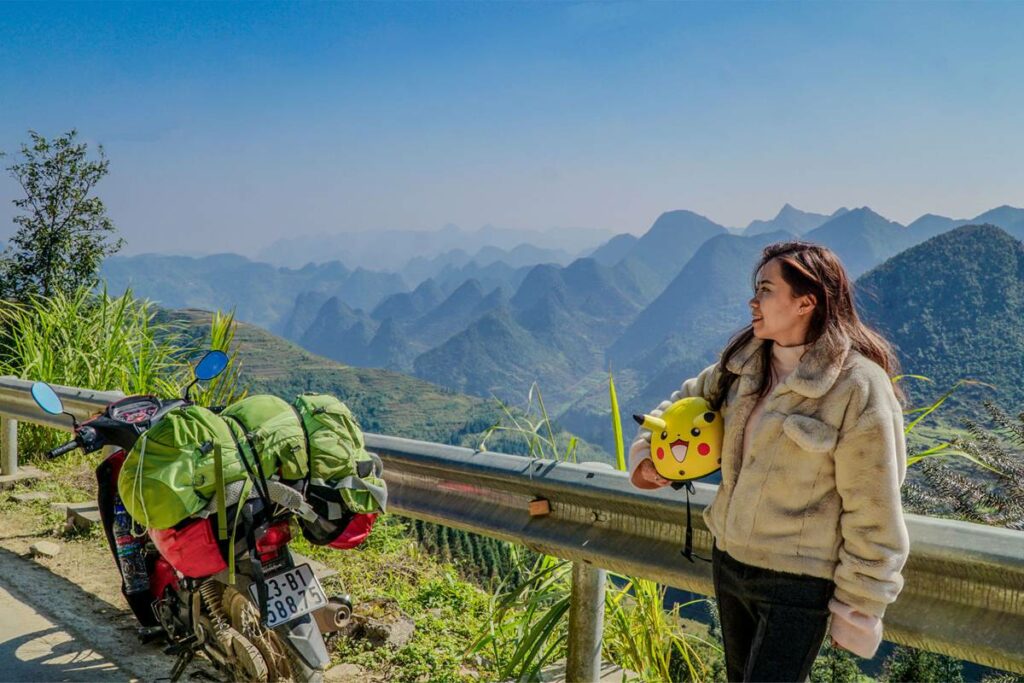
Everything in this list of best things to do in Ha Giang can be combined into this one highlight: the Ha Giang Loop . The Ha Giang loop is a 3 to 5 day route that starts and end in Ha Giang City. Each day you visit a new place and the scene along the road between your destinations is getting better and better.
You will driver over high passes, enjoy landscapes with the most impressive mountains of Southeast Asia and discover the unique cultures of the local minorities. The best way to do the loop is on the back of a motorbike with an experience guide. If you prefer a bit more comfort and protection against the weather, you can also do the Ha Giang loop by car.
- Tip: Interested to do this loop on the back of a motorbike or by car? Check our unique Ha Giang loop tour .
2. Stunning roads & mountain passes
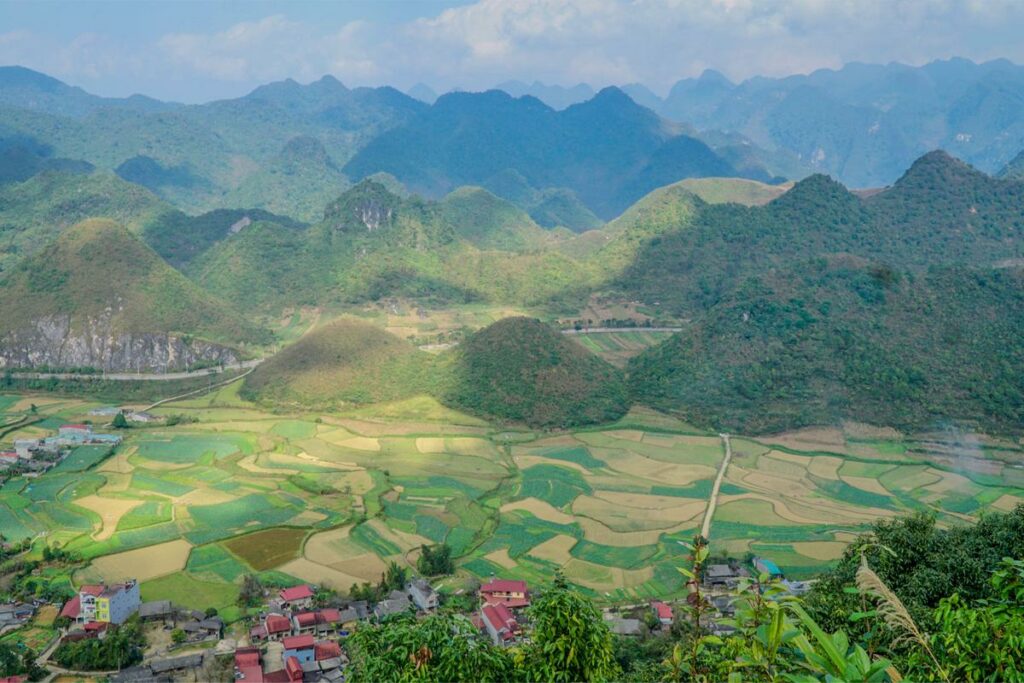
As mentioned, the best thing to do in Ha Giang is exploring the impressive mountains. There are dozens of mountain roads and mountain passes worth mentioning, and we could easily have used them to fill out the complete list of the 10 best things to do in Ha Giang. Instead we highlight some of the best.
The Quan Ba heaven gate is the first impressive mountain pass you wil pas starting from Ha Giang. From here you can enjoy stunning views on the Twin Mountains. Next mountain pass in the Tham Ma pass , with the iconic s-shape road. From here you drive through Sung La valley and have the option to either go straight to Dong Van or a detour via Lung Cu with some of the best mountain views you can wish for.
The Ma Pi Leng Pass is the king of the mountain passes of Vietnam . This road between Dong Van and Meo Vac has some of the most steep cliffs and impressive views. After Meo Vac heading to Du Gia via Mau Due you can expect lots of more scenic views with mountains.
3. Hoang Su Phi

Hoang Su Phi is one of the most off the beaten track destinations of Vietnam . It is not along the famous loop and there is hardly any transportation to this area. For this reason, most travelers have never heard of this place. And this is weird, because around harvest season, you can find here some of the most stunning rice fields of Vietnam . Very high terraced rice fields built in the mountains of Ha Giang. It is a great place for trekking and discovering the local minority villages that have cultivated the lands here for many generations.
- Tip: Do you want to visit this stunning rice fields landscape? Visit it with our Ha Giang tours . You can also combine the Hoang Su Phi rice fields with the Ha Giang loop!
4. Markets of Ha Giang
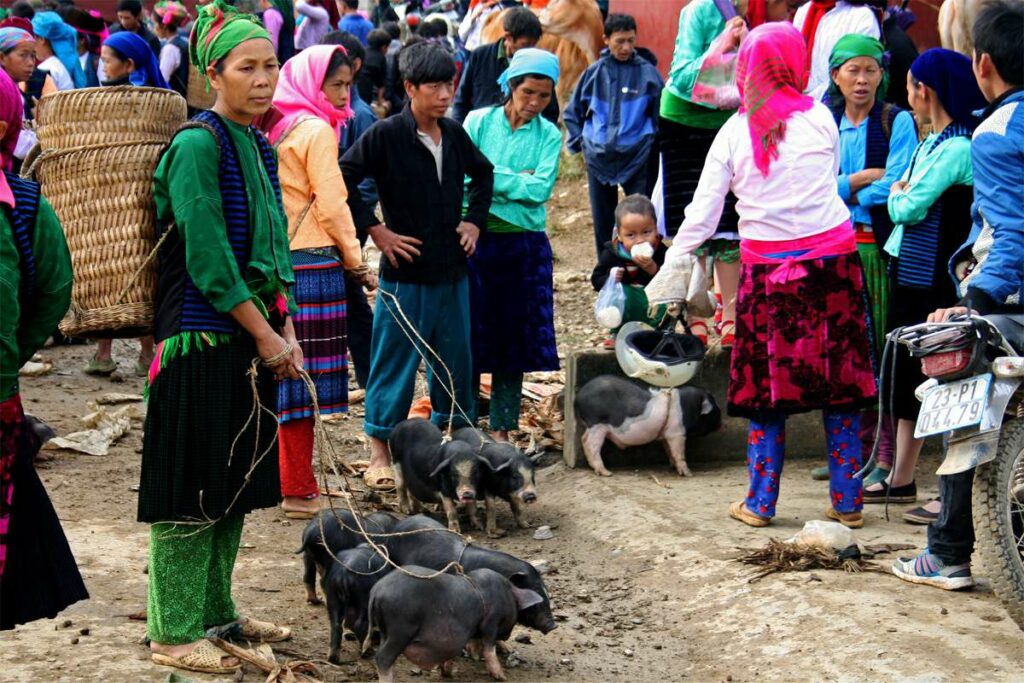
One of the other best things to do in Ha Giang is learn about the culture of the local minorities. In this province you will even find the highest number of ethnic minorities in Vietnam! While driving through this landscape they will not be difficult to see, as they often wear the most colorful and unique clothing. It is impressive to see them.
The easiest way to see these colorful ethnic minorities is to visit a market in Ha Giang . These mountain markets are often held once a week and hill tribes from all over the area come here to trade and socialize. It is a unique and colorful gathering, where people trade local goods, food, clothing and even farm animals. The largest market is the Meo Vac Market , which is held every Sunday.
5. Local minority villages
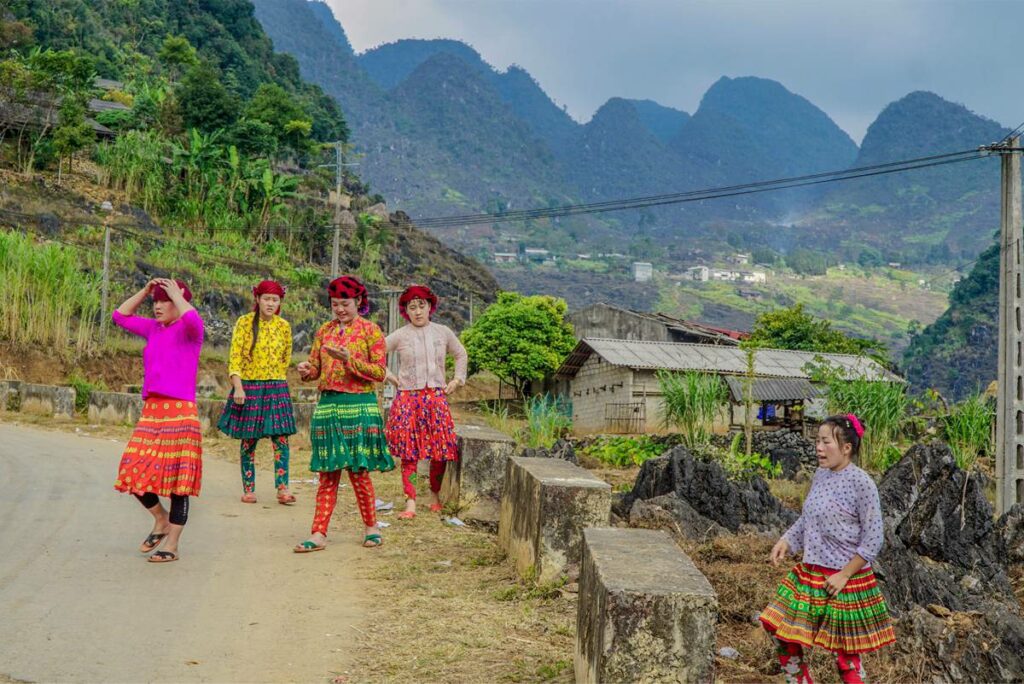
Another great way to discover this unique culture is to visit the small ethnic village. Here you can see their daily life, like work on the land and other different crafts. If you are traveling with a guide, he or she can help you communicate with them.
The villages can be found all over the province. Several different minorities live here, such as the Hmong, Dao, Lo Lo, Giay and Tay. They all have their own unique clothing, culture and language. You will also see various houses in these villages. Some minorities live in houses on stilts, while others live in stone or clay houses.
6. Trekking
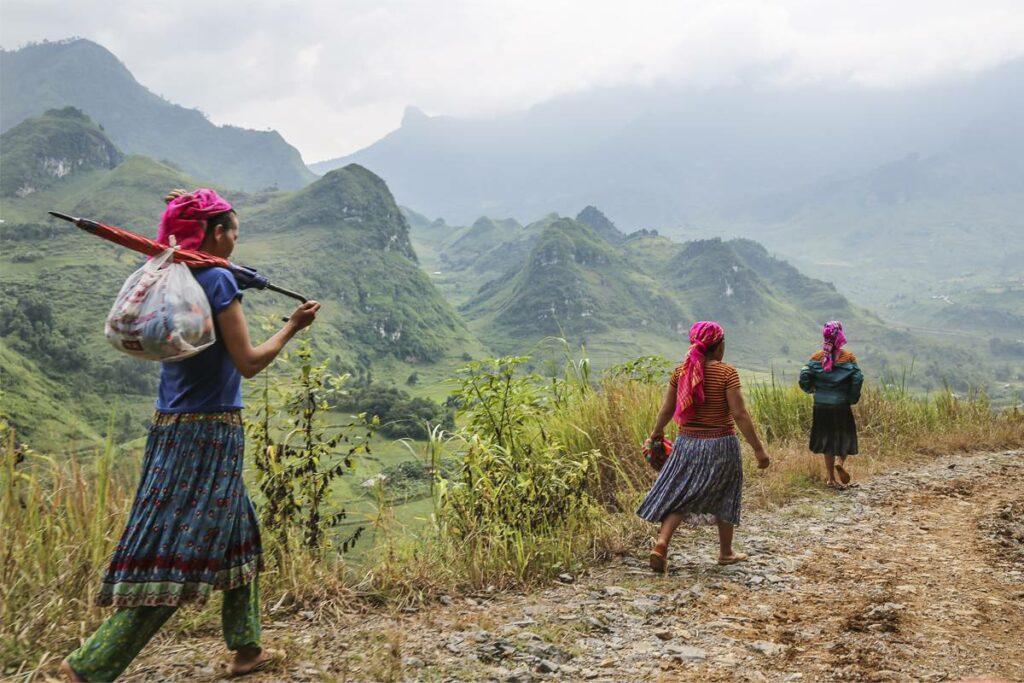
Sapa is the most famous place for a trekking in Vietnam . But not many people know that you can also do great trekking in Ha Giang . In the area around Hoang Su Phi you can hike through the terraced rice fields and spend the night in a local homestay. If you want to do a trekking during your Ha Giang loop, Dong Van is the best place. You won’t find many terraced rice fields, but hiking trails run through the most impressive mountains of Vietnam .
A walk is a wonderful change after sitting on the back of a motorcycle all day or in a car.
7. Historical buildings
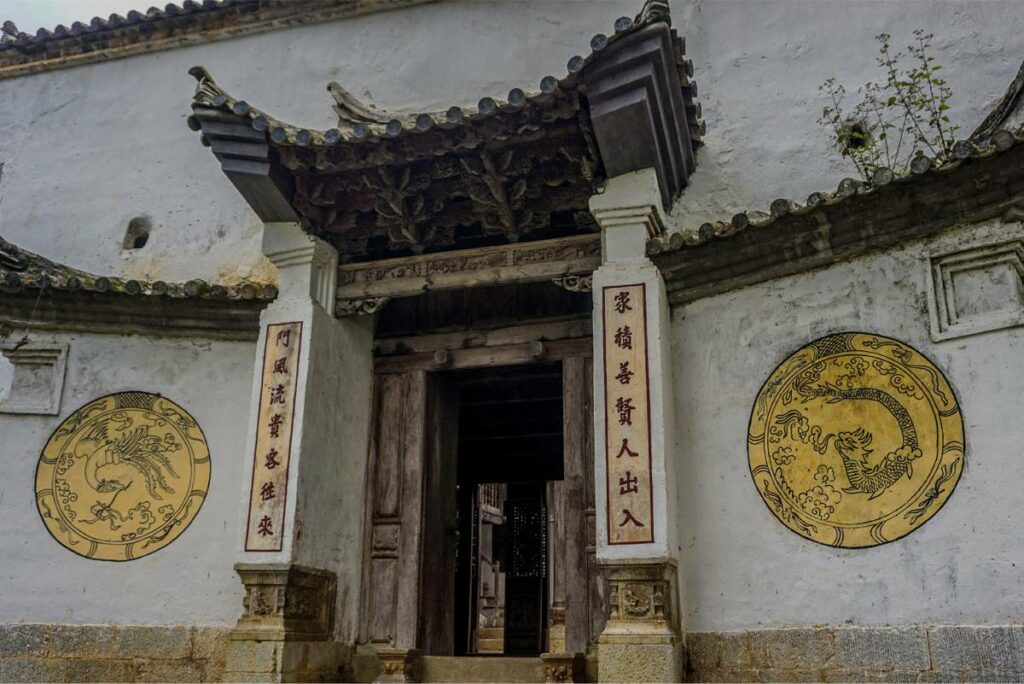
Ha Giang does not have large ancient cities such as Hoi An , Hue or Hanoi . Although there are some nice historical sites to visit along the way. The Hmong King Palace is where the former Hmong kings lived when they ruled much of northern Vietnam. In Sung La you will find the House of Pao (used in a famous Vietnamese movie). This house and the neighboring houses are also from the Hmong minority and about 100 years old.
You will also find buildings in the province that date back to the French colonial era. The old quarter in Dong Van is the best example of this. You will find an old French fort on a mountain behind the Old Qaurter where you now have a great viewpoint of the town. Between Meo Vac and Mau Due you will also find the ruins of a French guard post, set in a beautiful landscape.
8. Lung Cu flag tower

The Lung Cu Flag Tower is the tallest flag tower in Vietnam, indicating the most northern point in the country. The tower is nice to visit, but the road to Lung Cu makes this one of the best things to do in Ha Giang. You will pass some of the most stunning mountain scenery in Ha Giang and even the country. Make sure to stop at some of the local villages along the way to explore rural life.
9. Homestay experience
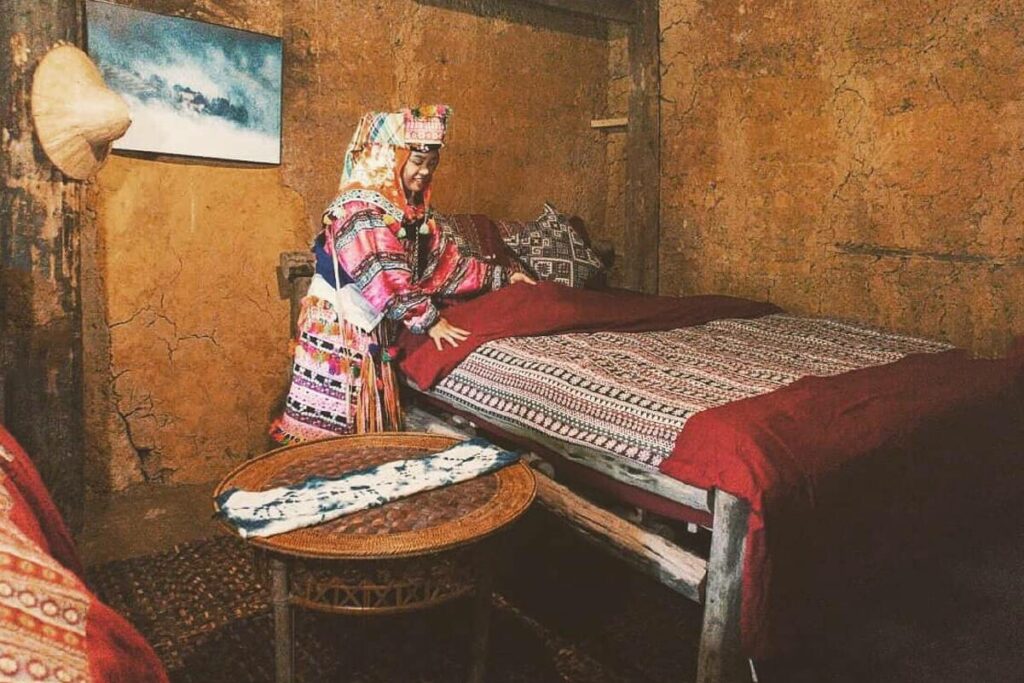
Another great way to experience the local culture is to stay overnight in a local homestay. These homestays are often owned by an ethnic minority family. Some homestays can be a bit basic with facilities, but you do an overnight stay mainly for the experience. It is highly recommended to have a family dinner where you eat very tasty local dishes together with all other guests and the local family.
10. Relax in Du Gia
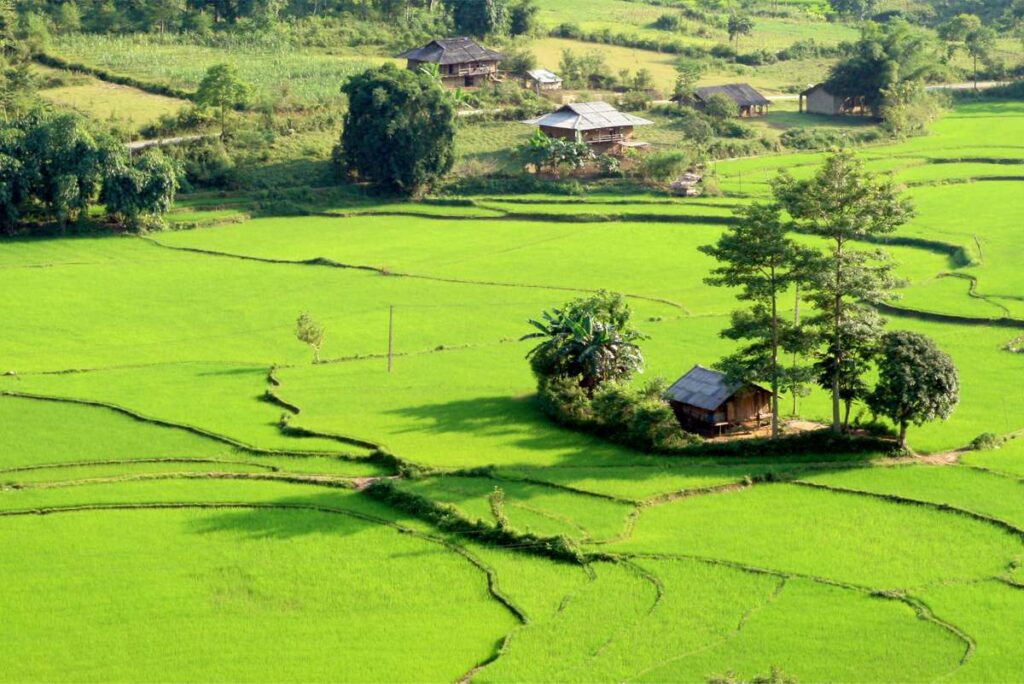
After riding motorbike for days or sitting in a car, it is nice to have a place where you can relax between the rice fields. The village of Du Gia is a great place for your last stop during the loop. It is mainly visited by people that do the loop in 4 or 5 days. Sit down to enjoy the views, walk along the rice fields or swim at the local waterfall.
Best hotels & hostels in Ha Giang
Hotels in Ha Giang CIty
- QT Guest House
- Kiki’s house
- Ha Giang Amazing hostel
Hotels in Dong Van
- Green Karst Hostel & Bar
- Binh Minh Hostel
- Lam Tung Hotel
Hotels in Meo Vac
- Ong Vang Meo Vac Hotel
- Little Yen’s Homestay
Hotels in Yen Minh
- Homestay bongbang
Although Ha Giang is slowly becoming more developed, the available accommodation is generally fairly simple. Larger cities such as Dong Van and Ha Giang do have hotels, but guesthouses and homestays are more common. They may offer fewer basic services, but they give you the opportunity to communicate with your local hosts and give them a glimpse into their daily lives.
The far north of Vietnam is a surprisingly tasty place to find good Vietnamese food. The restaurant scene consists of small “quan” restaurants where you have to sit on a small stool while the food is being cooked before your eyes. The locals will probably beg you to taste some rice wine, something you should be careful with.
Breakfast and dinner you will often eat at your homestay. It is recommened to book a family dinner and eat with the family of the host and other guest.
Ha Giang does not have an airport (yet) or train station. The only way to get here is by road
Busses to Ha Giang
There are buses and limousine vans driving between Hanoi and Ha Giang. You have the options for different night buses, varying in comfort, with the limousine VIP buses being the most comfortable option. The limousine vans drive during the day time and are a very comfortable option. The drive takes about 6 hours.
In addition there is also a bus between Sapa and Ha Giang. For other destinations you first have to travel to Hanoi.
Private cars to Hanoi
You can also take a private car from Hanoi to Ha Giang or extend your Ha Giang loop by starting already from Hanoi.
- Tip: In our Ha Giang loop tour you have the option to start your tour in Ha Giang or Hanoi; travel either by car, bus or VIP bus from Hanoi to Ha Giang (and the way back). This is easy if you don't want to arrange your own transportation at a bus station.
Motorbike – Going from one city to another in Ha Giang is easy and most fun by motorbike. Roads are winding and steep, but generally well-paved, so you can drive comfortably. If you are an inexperienced driver, do not underestimate these roads. You may want to consider taking a driver for safety. Being on the back of an easyrider is a great way to discover Ha Giang.
Car – Another good way to travel around Ha Giang is by car with driver. Book in advance to make sure that someone is waiting for you when you arrive in Ha Giang.
- Tip: Have a look at our Ha Giang loop tour . You can either choose to go by motorbike or car and have the option to do the route in 3 to 5 days.
Itinerary 3 days in Ha Giang
This is a very brief itinerary of the route. Read a full detailed guide and route of the Ha Giang loop here.
- Quan Ba Pass
- Tham Ma Pass
- Hmongs King Palace
- Lung Cu Flag tower
- Ma Pi Leng pass
More tips for traveling in Ha Giang
Where to go next.
Ha Giang can be perfectly combined with the neighboring province Cao Bang , where you can find the Ban Gioc waterfall , the biggest waterfall of Vietnam . It is also possible to combine Ha Giang with Sapa, though the distance is quite a bit further. Check our Ha Giang tours for there two combination trips.
If you want to go to Halong Bay , Mai Chau , Ninh Binh or any other destination south, you would always need to travel first to Hanoi.
Ha Giang with kids
It is possible to bring you children to Ha Giang. Being in the car for 3 to 4 or even 5 days can be a bit much for them though. What children do love a lot is being on the back of a motorbike of an experience guide. Driving with a guide is very safe, though it is important that children are tall enough and comfortable with this idea.
This province is not far developed for tourism (fortunately). This gives a very authentic view on life here, but keep in mind that communication would be difficult.
What to bring
When you go on a motorcycle, it is useful not to take too much with you. Choose a backpack instead of a trolley case. In the summer it can be very hot, but bring clothes to protect you against the rain. In winter it is mainly dry, but it is advisable to bring a windbreaker against the cold wind and some warm clothing. Do not bring too much, but wear thinner clothes in layers.
- Destination Guide
- Essential Guide
- Getting Around
- Vietnam Month by Month
- Inspiration
- Vietnam blog
- Travel tips
- Custom Made Trip
- Day- & Multiple Day tours
- Holiday Packages
- Local Meo Vac Homestay
- Local Dong Van Homestay
- Our Team & Company
- Our Customers & Reviews
Copyright © 2023 Local Vietnam
Start typing and press enter to search
Free ebook vietnam travel guide.

- Be Inspired
- Destinations
- Things to do
- Eat & Drink

Ha Giang tourist map
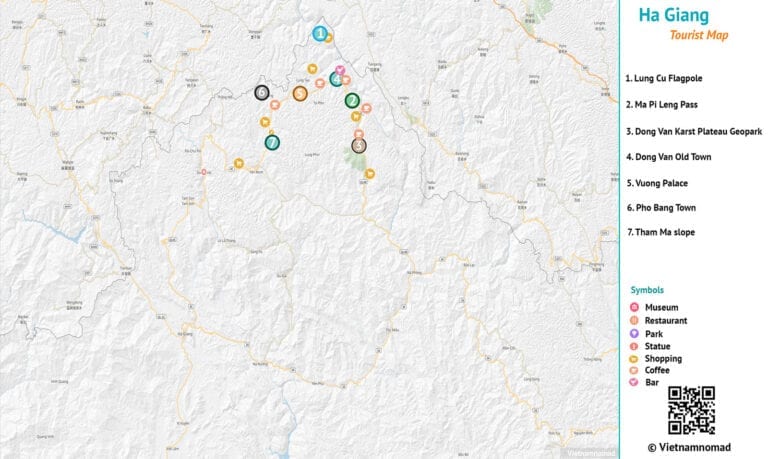
We would like to introduce you to Ha Giang tourist map; the map includes the most popular destinations as well as useful information such as restaurants, bars, and shopping.
Ha Giang weather
Ha Giang is beautiful all year round, you can travel to Ha Giang at any time of the year. However, to fully explore the beauty of this rocky plateau, you should come to Ha Giang at the following time:
January – The Flower season
In spring, flowers such as peach, plum, and rapeseed bloom all over Ha Giang. Coming to Ha Giang at this time, you will admire a picture full of life and color. The weather in Ha Giang is also very comfortable for traveling, which is a little bit cold.
May to Jun – the WaterFall Season
From May, when the rainy season comes, water pours from high fields will flow into low areas, thus form “water towers”, which extend from the top of the mountain to the foot of the hill. The water season lasts until the end of July; from May to Jun is the most beautiful time.
Coming to Ha Giang at this time, visitors can see the picturesque rice fields in Hoang Su Phi, Quan Ba Double Mountain, or along Ma Pi Leng Pass road.
September to October – The ripen terraced rice season
The season of ripe rice in Ha Giang is from September to the middle of October. Ha Giang at this time is covered with the bright yellow of terraced fields.
If you want to breathe in the sweetness of the ripe rice flavor and capture the moment in the shiny golden rice fields, you should visit Ha Giang around this time. From mid-October onwards, the farmers will start to harvest rice, so do not miss the moment when the rice fields are at their best.
October to December – the Buckwheat flower season
The buckwheat flower season in Ha Giang lasts from early October to the end of December. Unlike the buckwheat flower in other places, in Ha Giang, this flower has a light pink color, grows in large fields along the road or the valley, even on jagged cliffs. The buckwheat flower fields create poetic and majestic scenery.
In the middle of October, Ha Giang people also organized buckwheat flower festivals with many enjoyable cultural activities. So this is the most beautiful time to travel to Ha Giang.
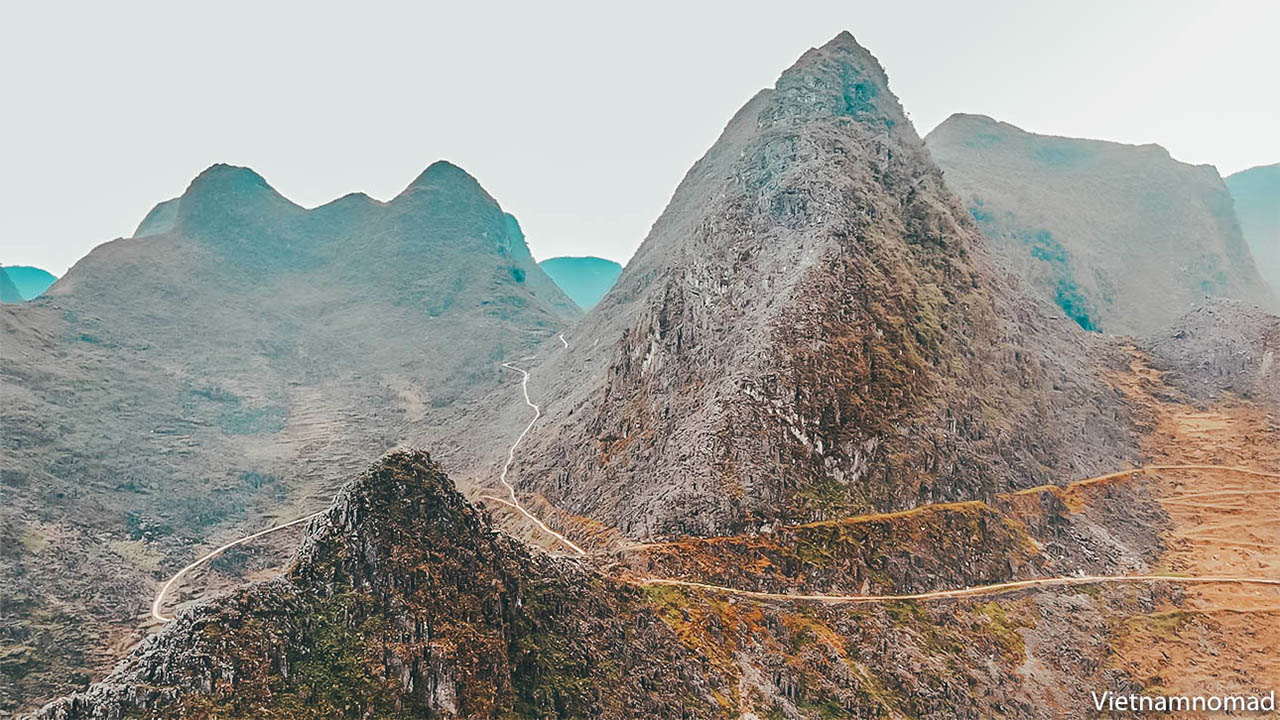
How to go from Hanoi to Ha Giang?
Discover transportation deals for Ha Giang from our partners >
Ha Giang is about 300 km northwest of Hanoi . The road to Ha Giang is quite twisted, there are usually two ways to go from Hanoi to Ha Giang. By bus
From Hanoi and the Northern provinces, you can choose a sleeper bus to get to Ha Giang. After traveling by bus from Hanoi to the city of Ha Giang, you can easily rent a motorbike or take a 16-seat bus to Dong Van and Meo Vac. Travel by bus is the best choice because the distance from Hanoi to Ha Giang is both far and dangerous.
From Hanoi, you can take a sleeper bus to Ha Giang from Hanoi Old Quarter, My Dinh Bus Station, or Noi Bai intersection with prices from 200.000 VND/ ticket/way.
By motorbike or car
This way has the advantage of saving money and admiring the majestic landscape along the way. However, make sure you are experienced long-distance driver, and knowledgeable about the road from Hanoi – Ha Giang. If you do not know the way, you are easy to get lost and could be in danger.
Directions from Hanoi to Ha Giang by motorbike or car
In Hanoi, there will be two directions for you to choose from. This route is nearly 300 km long, taking 6-7 hours to arrive.
Route 1: Noi Bai – Lao Cai highway
This route is quite easy to go, but only for cars, motorcycles are not allowed to move.
Route 2: Highway 32
This route is for both motorbikes and cars. The road may be longer than several tens of kilometers. But this road is less traveled, so it is quite safe.
Where to stay in Ha Giang?
According to travel experiences in Ha Giang, Dong Van and Meo Vac are two areas with the most significant number of accommodations, so you can easily find a place to stay here. Besides these two areas, Quan Ba and Yen Minh also have a lot of hotels too.
Note: Hotels in Ha Giang often run out of rooms, especially on holidays. In October and December, when the buckwheat flowers bloom, almost homestay, hostels or hotels in Ha Giang are run out of the room. Room rates in peak seasons are always high, but if going on normal days is not too expensive.
Should stay at a hotel, motel, or homestay when traveling to Ha Giang?
Hotels, hostels, or homestays are all three popular types of accommodation in Ha Giang. If you are traveling in groups, to save money, you should rent motels or homestays with rooms for large groups.
If traveling with family, you should come to Dong Van to rent a hotel. Particularly for a group of 6-8 people, if you want to see the buckwheat flower garden, you should rent a homestay in Lung Cu, Dong Van, or Meo Vac town. A few homestays are located overlooking the beautiful flower fields.
Here are some recommendations for accommodation in Ha Giang, which are excerpted from the Vietnam travel guide book .
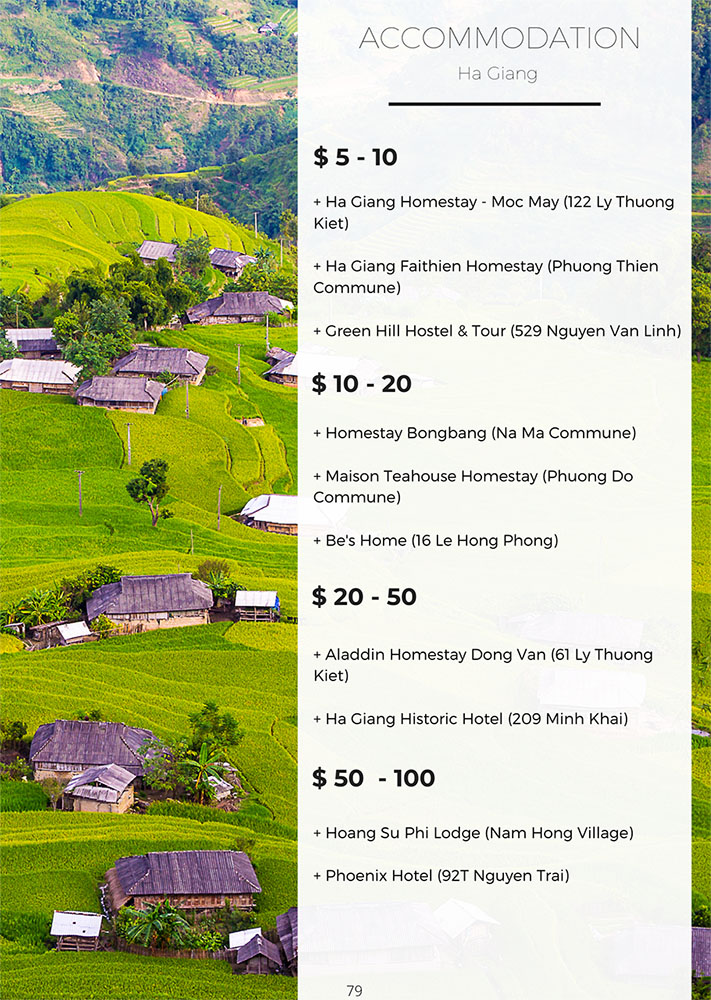
Top 9 must-visit attra ctions in Ha Giang
Maybe you have seen many photos of Ha Giang, but there will be no words to describe the beauty here until you see it with your own eyes. Here are the famous tourist destinations you cannot ignore when coming to Ha Giang.
1. Lung Cu Flagpole
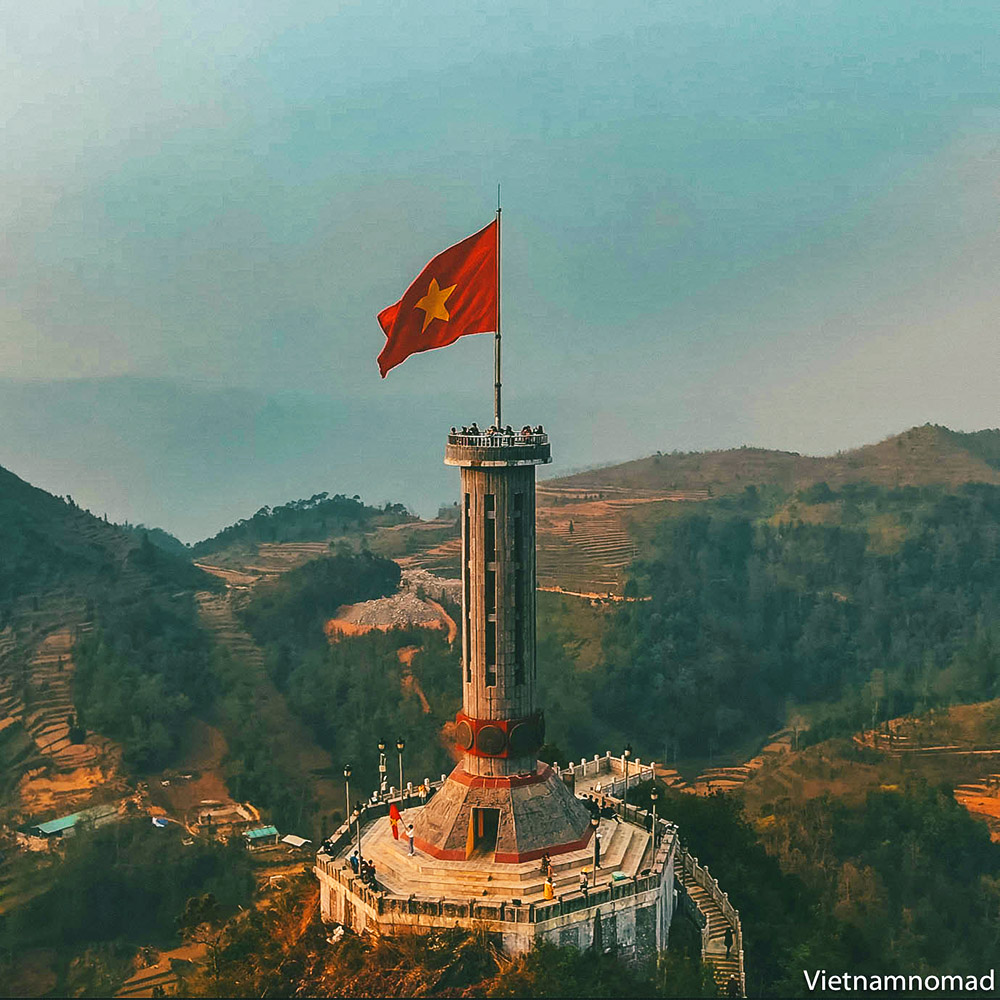
Perhaps no tourists come to Ha Giang without visiting the Lung Cu Flagpole. From this flagpole to the North pole of the country is about 2km. But in the subconscious of Vietnamese people, this is still a symbol of Vietnam.
The flagpole is located in Lung Cu Commune, Dong Van District, with a height of 1.470m above sea level. From Ha Giang center, visitors will have to travel nearly 200km of rugged mountain roads to get here. This is one of the national flagpoles on the top of Lung Cu, also known as the Dragon Mountain. The name of this mountain range is also associated with many legends recounted by many people. Lung Cu in H’mong language means the land where dragons live.
Lung Cu Flagpole is also built based on the model of Hanoi Flagpole. At the foot of the flagpole, you will see eight sides of bluestone reliefs, which simulate images of the history of the nation. Combined with these are the patterns that show the typical culture of the Ha Giang ethnic community. On the way to conquering the stone steps, you can see the masterpieces of nature created on the Dong Van rock plateau.
2. Ma Pi Leng Pass
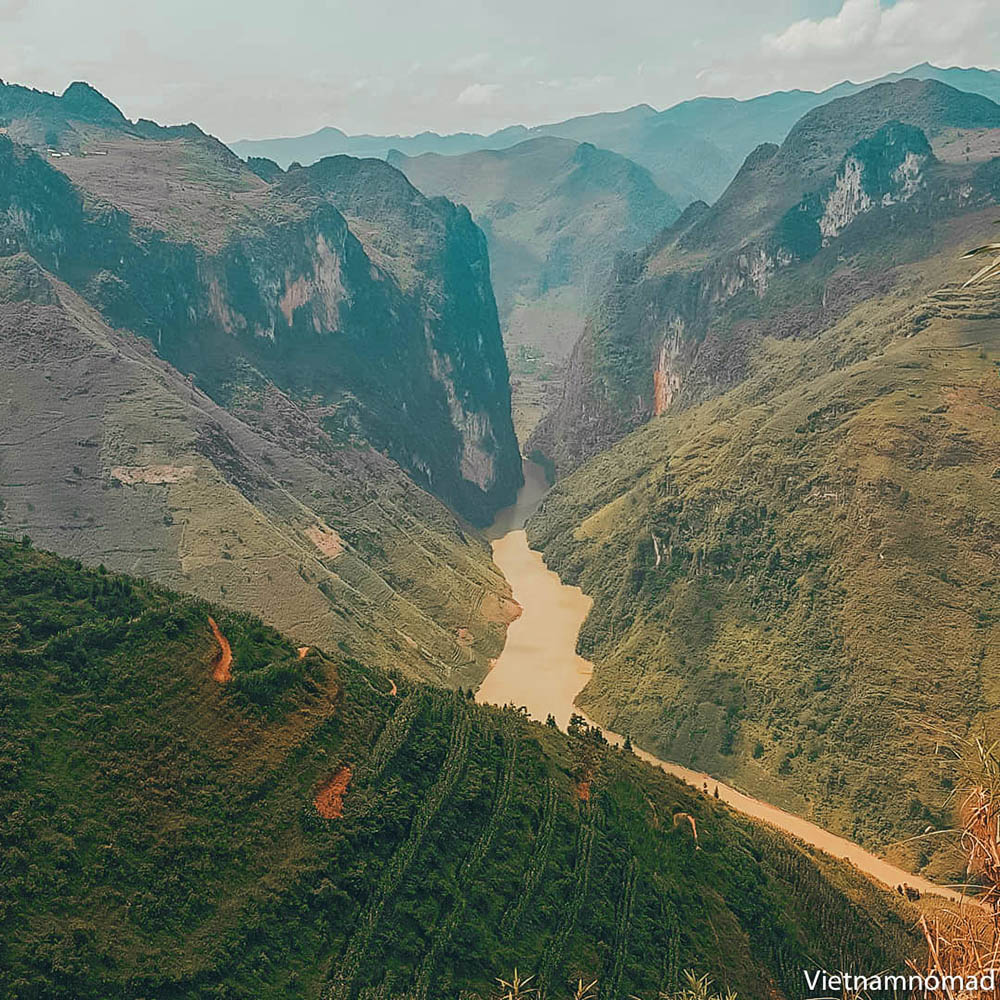
Ma Pi Leng Pass is on the Hanh Phuc road connecting Dong Van and Meo Vac. This is known as the most beautiful road in Ha Giang rocky plateau. If you come to Ha Giang once, try to drive on this road with one side is the sky-high mountains, the other is a deep abyss, and the Nho Que river winding below. It was a big challenge for adventure lovers. Standing on high, looking far away, you will see the identical mountains, floating clouds, and fanciful deep pools. This is the place to feel the immense grandeur of the mountains on the northern border.
3. Dong Van Karst Plateau Geopark
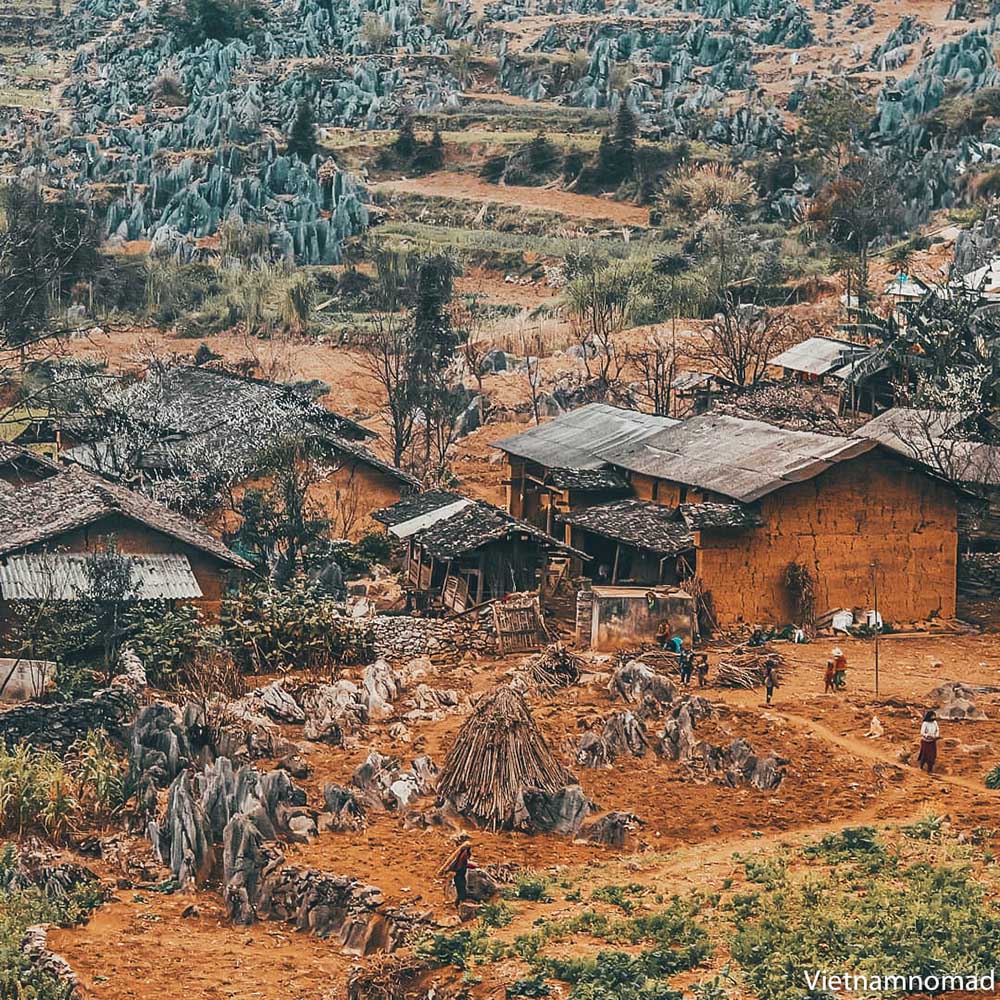
Located at an average altitude of 1.000 – 1.600 m above sea level, Dong Van Karst Plateau Geopark extends through 4 districts of Quan Ba, Yen Minh, Meo Vac, and Dong Van of Ha Giang province. According to the UNESCO Global Geopark Network Advisory Council, Dong Van Karst Plateau Geopark is one of the unique limestone areas, containing typical marks on the development history of the Earth’s crust, natural phenomena, beautiful landscapes, aesthetics, high biodiversity, and long-standing cultural traditions of indigenous communities. In 2010, this plateau was officially recognized as a Global Geopark .
Rocks were built into solid fences, winding around small houses, cornfields, and vegetable fields. The family men carefully selected the rough, rugged, and angular stones, then skillfully arranged them without the use of cement or any adhesive material to create a unique stone fence. Therefore, it is often said that the stone fence of the Mong people shows the caring of a man to his family. The more beautiful stone fence is to prove that the house has a great man.
Dong Van Karst Plateau Geopark is probably the most beautiful when spring comes. At that time, everywhere in the hills and mountains is covered with bright yellow mustard flowers. The mossy roofs are dotted with scarlet peach blossom petals and pristine white plum blossoms.
4. Tham Ma slope
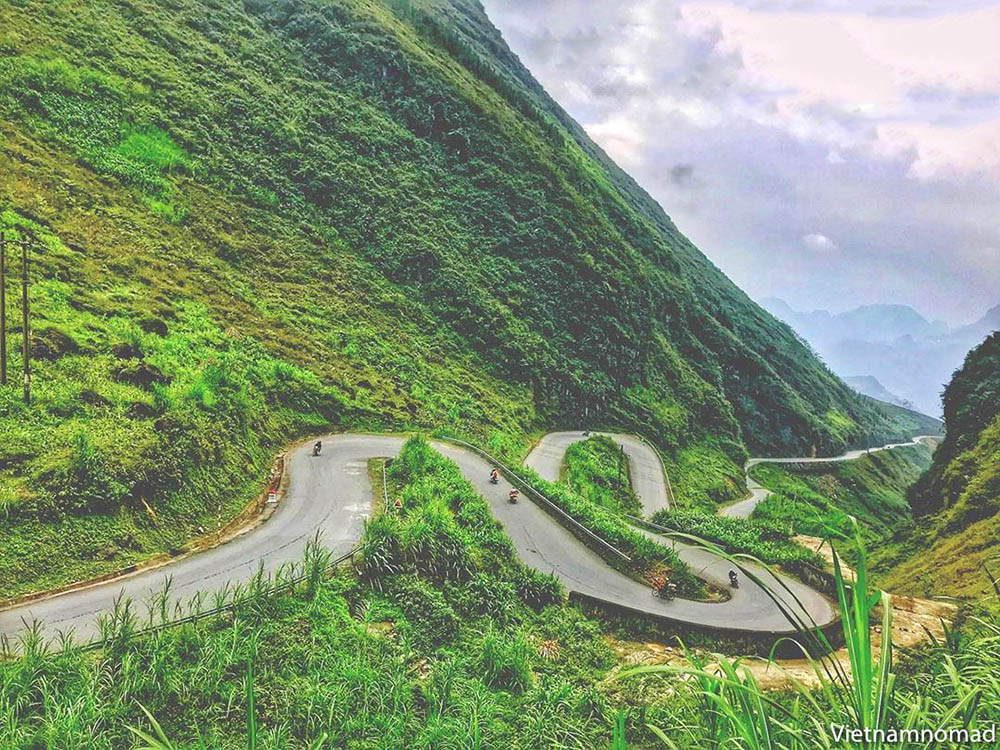
Tham Ma Slope is a winding mountain pass on 4C Highway, which is running from Ha Giang to Meo Vac District. It is a passing segment with nine bends in Ha Giang, which is a familiar path for young people who love to explore and admire the majestic natural beauty when coming to Ha Giang.
This famous slope takes visitors to the first gateway in Dong Van, a famous tourist destination in Ha Giang. Tham Ma slope is literally understood as a slope used to assess horsepower. Legend has it that, in the old days, on this slope, people put horses from the foot of the slope up. If the horse was up to the top of the slope and still strong, then he was a good horse that was kept. In contrast, the horses that went down the slope but were weak will be slaughtered and processed into Thang Co dish sold in highland markets.
5. Dong Van Old Quarter
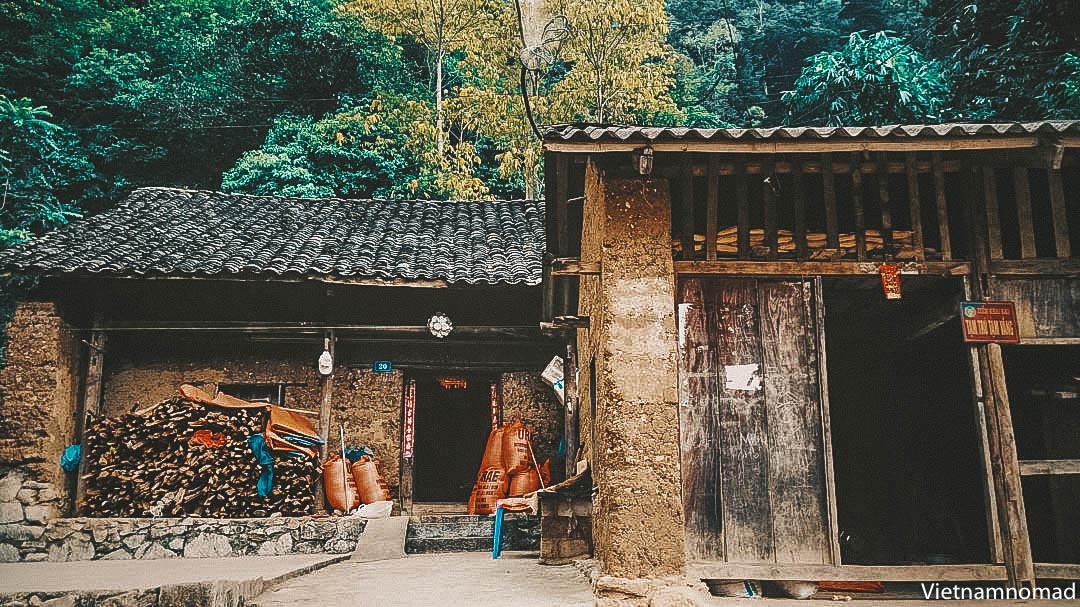
Dong Van Old Quarter lies in the middle of a valley surrounded by rocky mountains. The old quarter has only 40 roofs, nestled under rocks. In the evening, the town is quiet and peaceful. If you go to the town on the evening of 14,15,16 monthly following the lunar calendar, you will see a very different old town with red lanterns. Besides, during these days, there are some activities such as displaying brocades, performing, and selling traditional dishes of ethnic groups. Early in the morning, the old town is painting a clever combination of two tones: the bright yellow of the sun and the grey of old houses. The popular architecture here is two-story buildings with walls. Early in the morning, sitting under a small roof, enjoying hot coffee is an exciting experience that you must try once in your life.
6. Vuong Palace
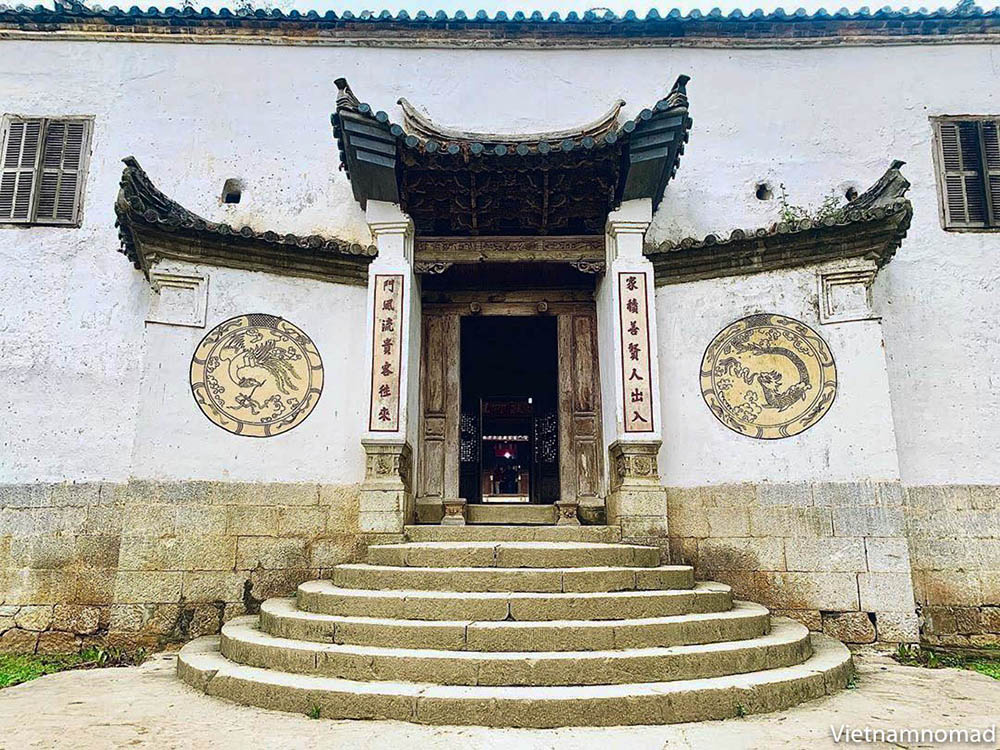
Vuong Palace is located in Sa Phin Commune, Dong Van District, Ha Giang. This is the residence of King-Cat, which was built in 1919 and completed in September 1928. King-Cat mansion has an area of 3.000m2 with a construction cost of 15.000 white silver coins, equivalent to 150 billion VND now.
Before construction, the King Cat traveled to China to find a feng shui master to choose the direction of land and the construction site. After passed through 4 districts, finally, Vuong Chinh Duc (head of the Vuong family) decided to choose Sa Phin village to build the mansion.
Vuong Palace is influenced by three architectures: Mong, French, and Chinese. The palace has four vertical houses, six horizontal houses divided into pre-palace, neutral, and post-palace. It has a total of 64 rooms built with two floors of green stone walls. This edifice was recognized as a National Monument by the government in 1993. In 2004, the Vuong family decided to dedicate this mansion to the government for preservation. The ticket price to visit Vuong Palace is 20.000 VND.
7. Sung La Valley
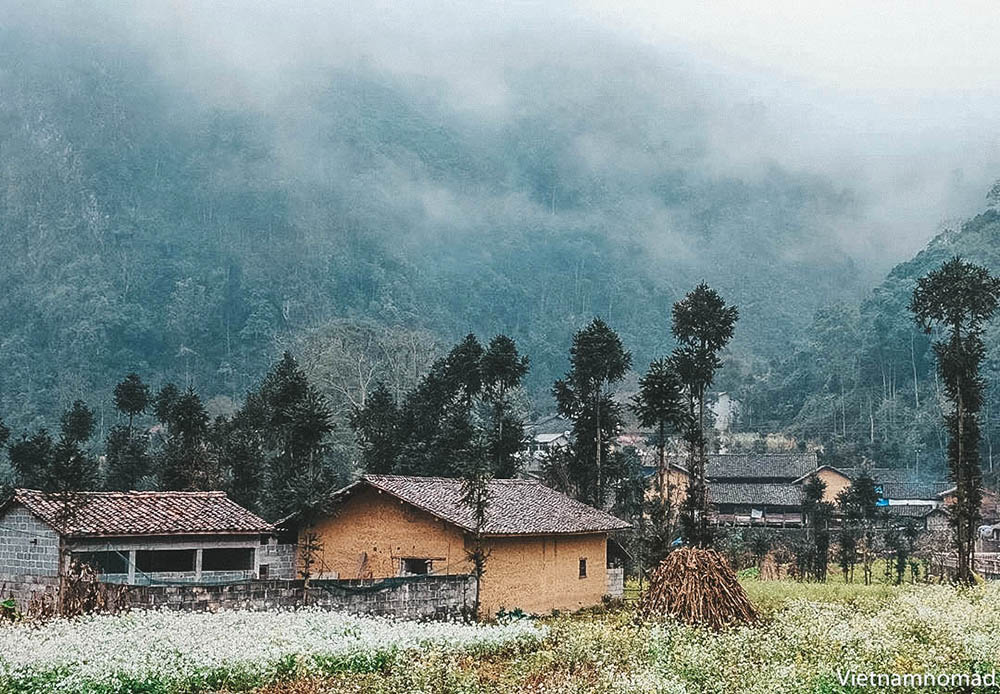
Sung La Valley is known as one of Ha Giang tourist destinations famous for its blooming flower gardens. This place attracts visitors by the rustic beauty and tranquillity of the small roofs, the green cornfields, the buckwheat flower fields. Sung La’s scenery is a typical beauty of Ha Giang. It is dubbed as the flower among the rocky plateau. In Sung La valley, there is Lung Cam village which is currently home to more than 60 households, mainly Lo Lo, Mong, and Han. In particular, Lo Lo village is the most rustic and oldest one. It is also known for being the setting for the movie “Pao’s story” in the nearly 100-year-old house. Although the house has been recently remodeled, it still retains a pure rustic beauty. To get to “Pao’s house” in Lo Lo village, you will come across a road stretching of buckwheat flowers. In January and February, Pao’s house is surrounded by peach blossom and plum blossom.
8. Tu San Alley
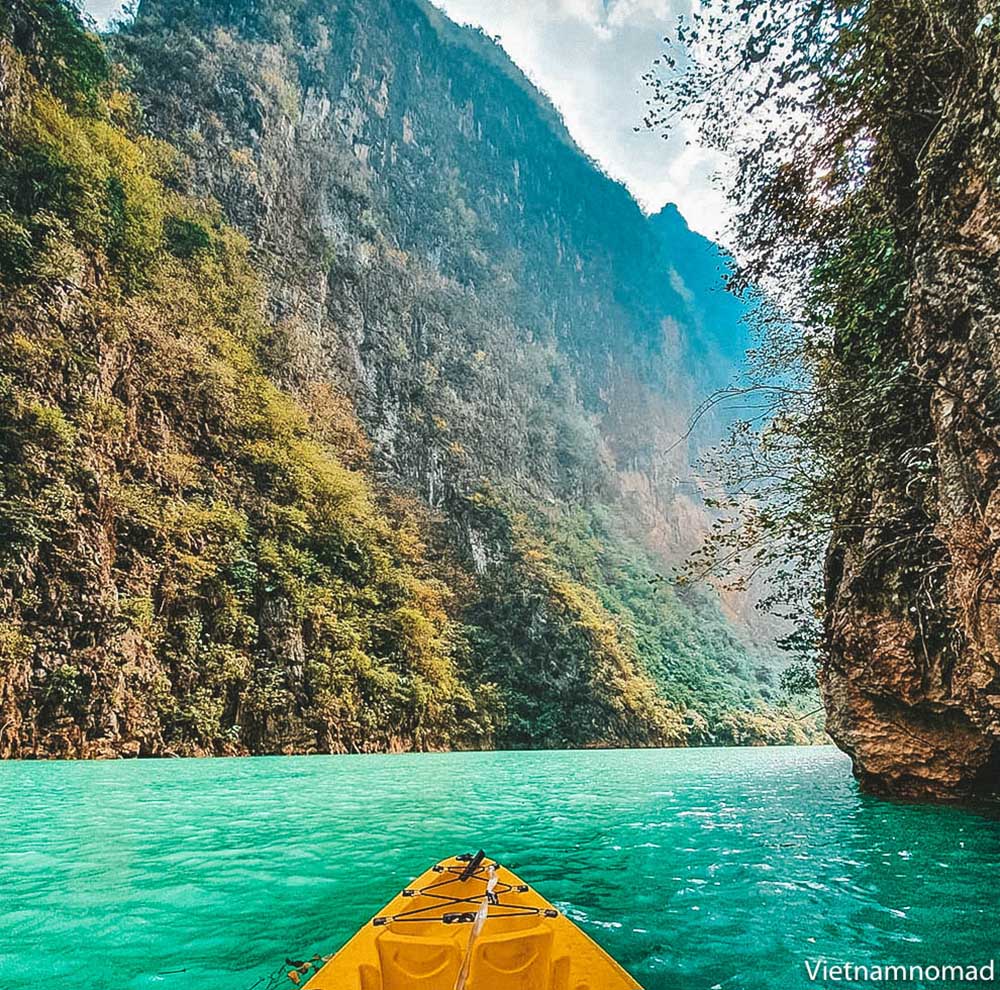
With a height of cliffs up to 700 – 800m, a length of 1,7km, a depth of nearly 1.000m, Tu San alley has considered not only a unique spectacular landscape of the Dong Van rock plateau but also the deepest alley in Southeast Asia. Many years ago, when the Nho Que river was not blocked for hydroelectricity, very few people could access the foot of the Tu San alley; visitors can only admire the grandeur of the alley when stood in the bends on Ma Pi Leng road. After the hydropower dam blocked the flow, the Nho Que River became quieter; local people began to motorize boats to take visitors. Today, visitors can take a boat trip to visit Tu San alley for 45 minutes with a ticket price of 100.000 VND. Many visitors can also enjoy a Kayak if they want.
Tu San alley is located in the middle of the mountains, hidden in the morning mist, making the scenery both majestic and mysterious. Anyone who comes here cannot avoid feeling overwhelmed by the rare and beautiful natural scenery. Sitting down on the boat, visitors can hear the murmur of the water under their feet, which is bringing an indescribable feeling.
In February and March every year, the whole river will glow with the red color of rice flower and the blue of the water, creating a beautiful landscape picture.
9. Pho Bang Town
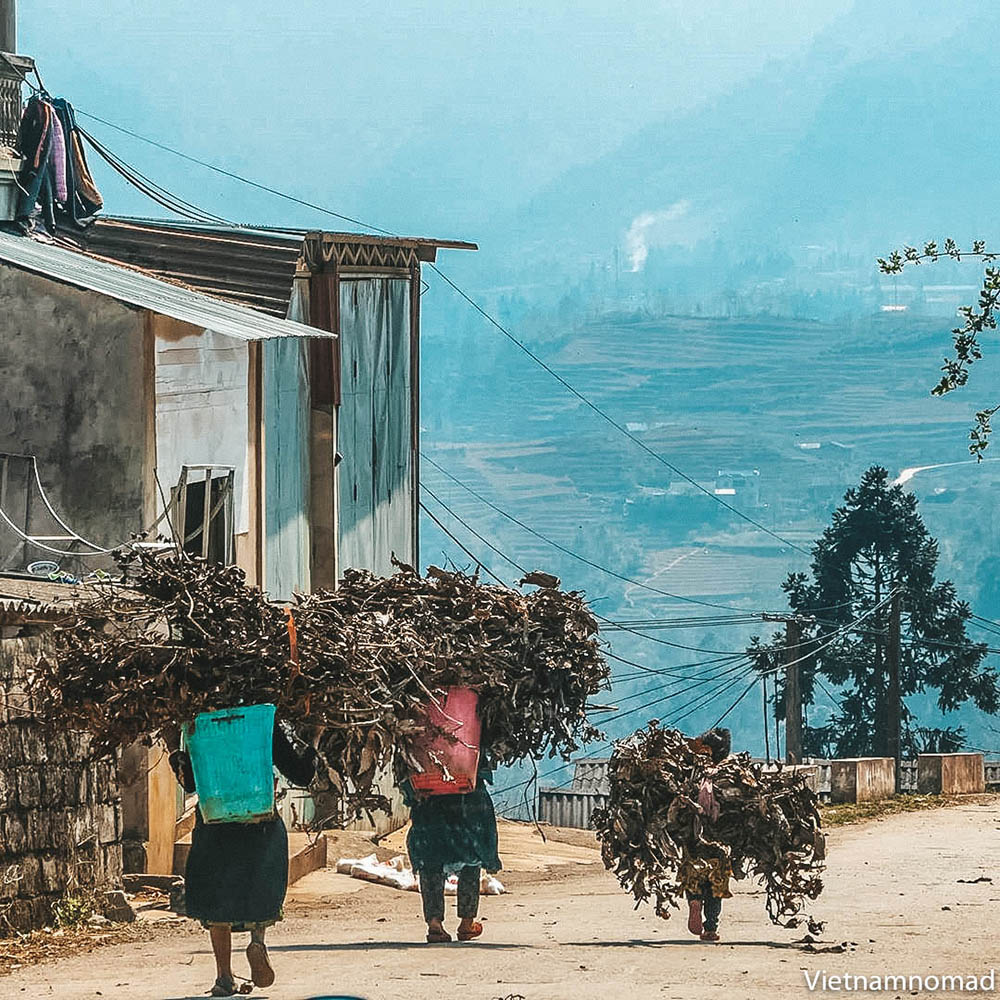
Pho Bang town is located in Dong Van district, Ha Giang. This place is known by many tourists as the “forgotten town”. Pho Bang town is a suitable place for those who are looking for peace. Life here is simple but warm, there seems to be no hustle here. The houses nestled by high mountain burrows in the mountains. The roofs of yin and yang, the walls of the old houses, the stone fences, all create a beautiful Pho Bang town.
Top 7 must-try dishes in Ha Giang
Traveling to Ha Giang is not only to admire the beauty of the rocky plateau but also to enjoy its cuisine. Top Ha Giang delicacies that you cannot ignore will be reviewed in the article below!
1. Thang Co
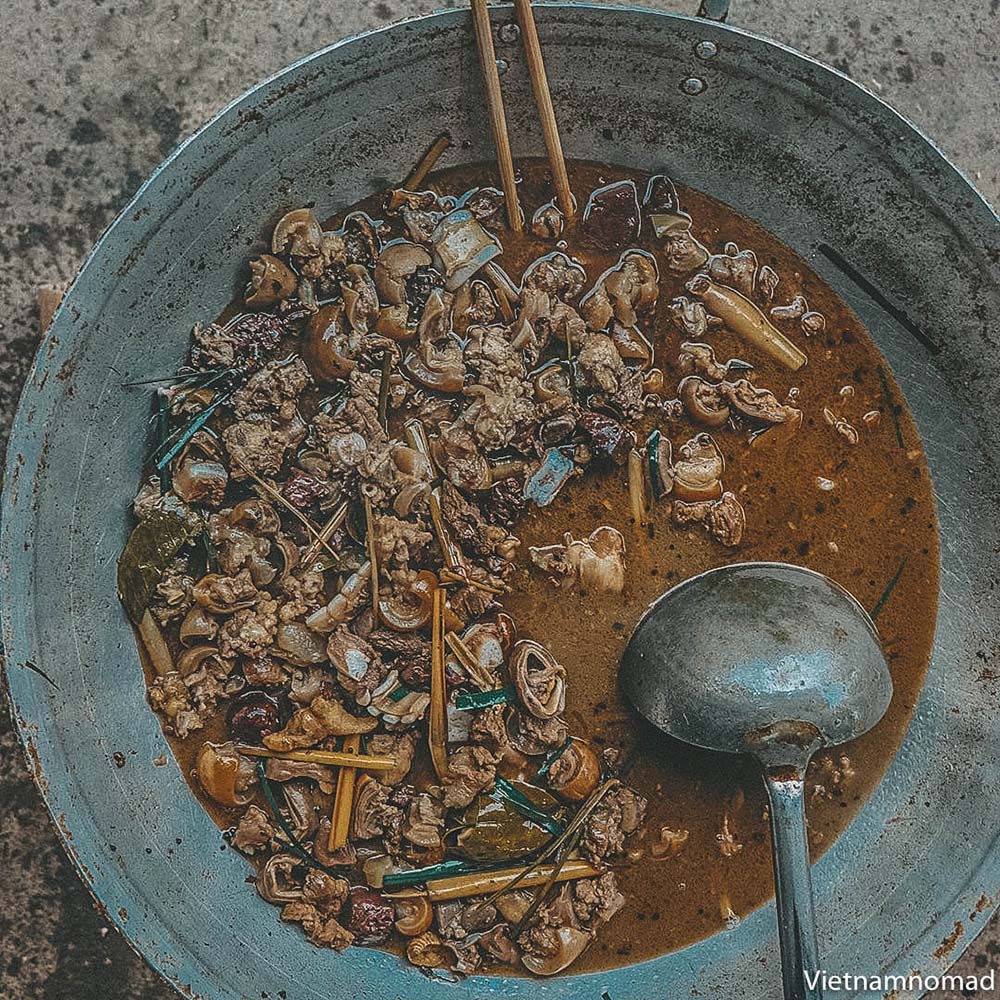
Thang Co was a traditional dish of the H’Mong people, which later became a popular dish of the Northwest highland people. Originally Thang Co was made from horse meat, but now people also use beef, buffalo, and pork. Each place has its cooking method, but the best recipe is probably in Ha Giang.
To cook it well, there must be a special recipe. Horse organs are cleansed, cut, and then marinated with spices. The traditional spice used for Thang Co is usually salt, cardamom, cinnamon, and chopped lemon leaves. Then put them all in a large pan, which uses horse fat to fry. Once the meat has set, the cook adds water and simmers over high heat for a few hours. Thang Co is an indispensable dish in every Ha Giang upland market.
2. Xoi Ngu Sac
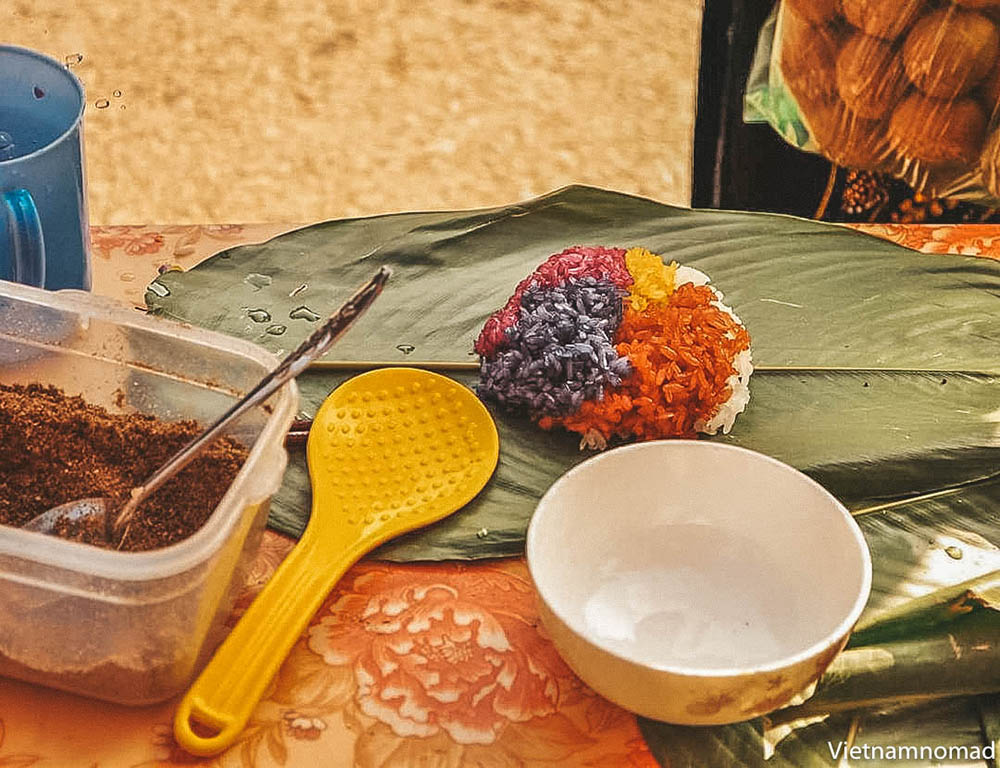
Xoi Ngu Sac (five-colored sticky rice) is a delicious dish that visitors to Ha Giang should enjoy. Glutinous rice is mixed with different types of forest leaves to create beautiful colors and fragrant smells. Five striking colors of this dish represents five elements, namely Metal, Wood, Water, Fire, and Earth. The green color comes from galangal leaves, ginger or pineapple leaves. Purple takes its tone from rosemary leaves, San San leaves, or black rice leaves. Yellow is from turmeric. Orange comes from gac fruit. White comes from the original sticky rice
Encapsulated in a delicious five-color sticky rice dish that is the most quintessential of the Ha Giang plateau. Do not forget this fascinating dish if you have the opportunity to come to Ha Giang!
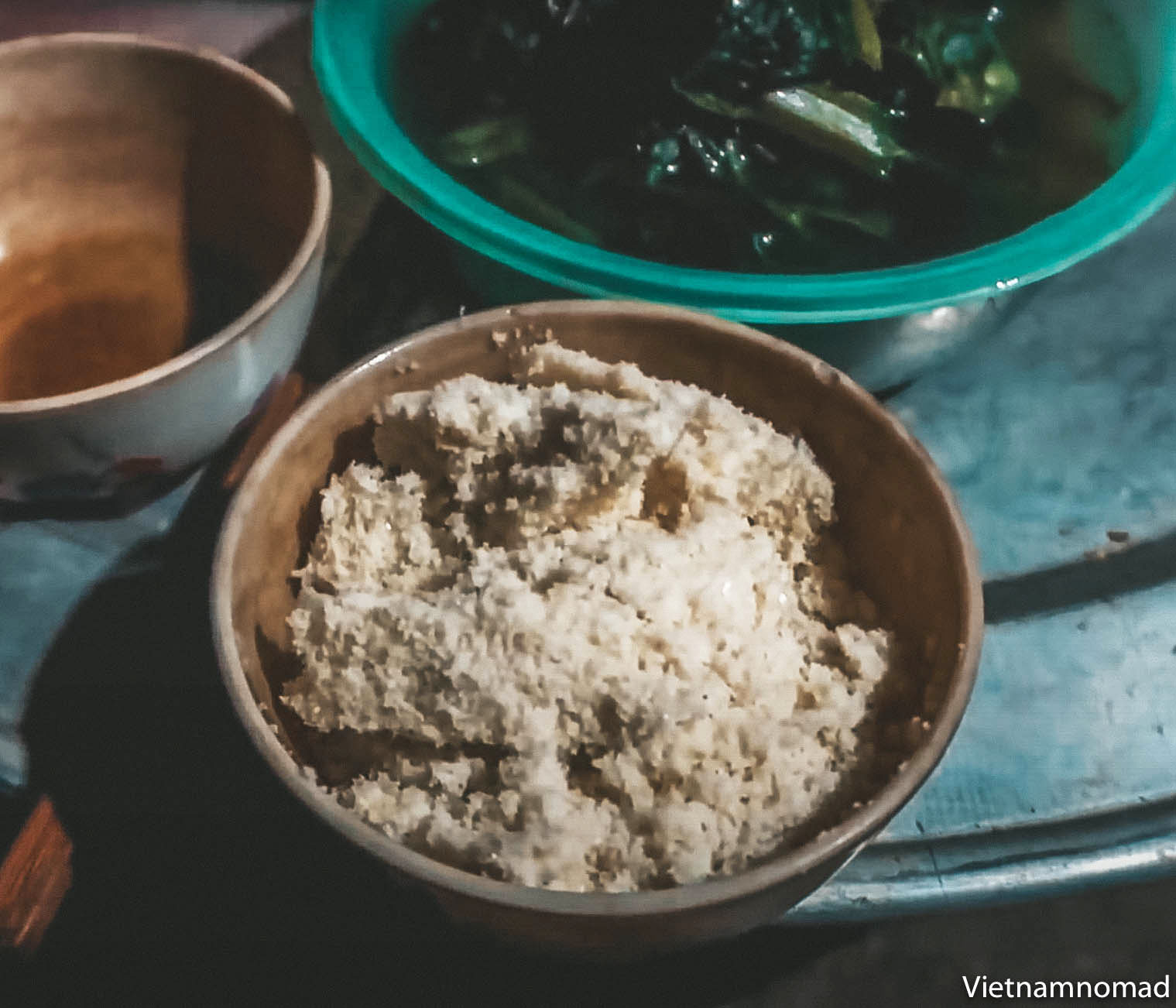
Men Men is a unique dish from name to taste, which is made from pounded corn. This dish is often eaten with wild types of soup such as vegetable soup, meat soup.
A bowl of Men Men is only 15.000 VND. You can buy these at any Ha Giang market. Eating Men Men in the evening is most appropriate. However, this is a seasonal dish. So you can only enjoy Men Men during the corn harvest.
4. Buckwheat Cake
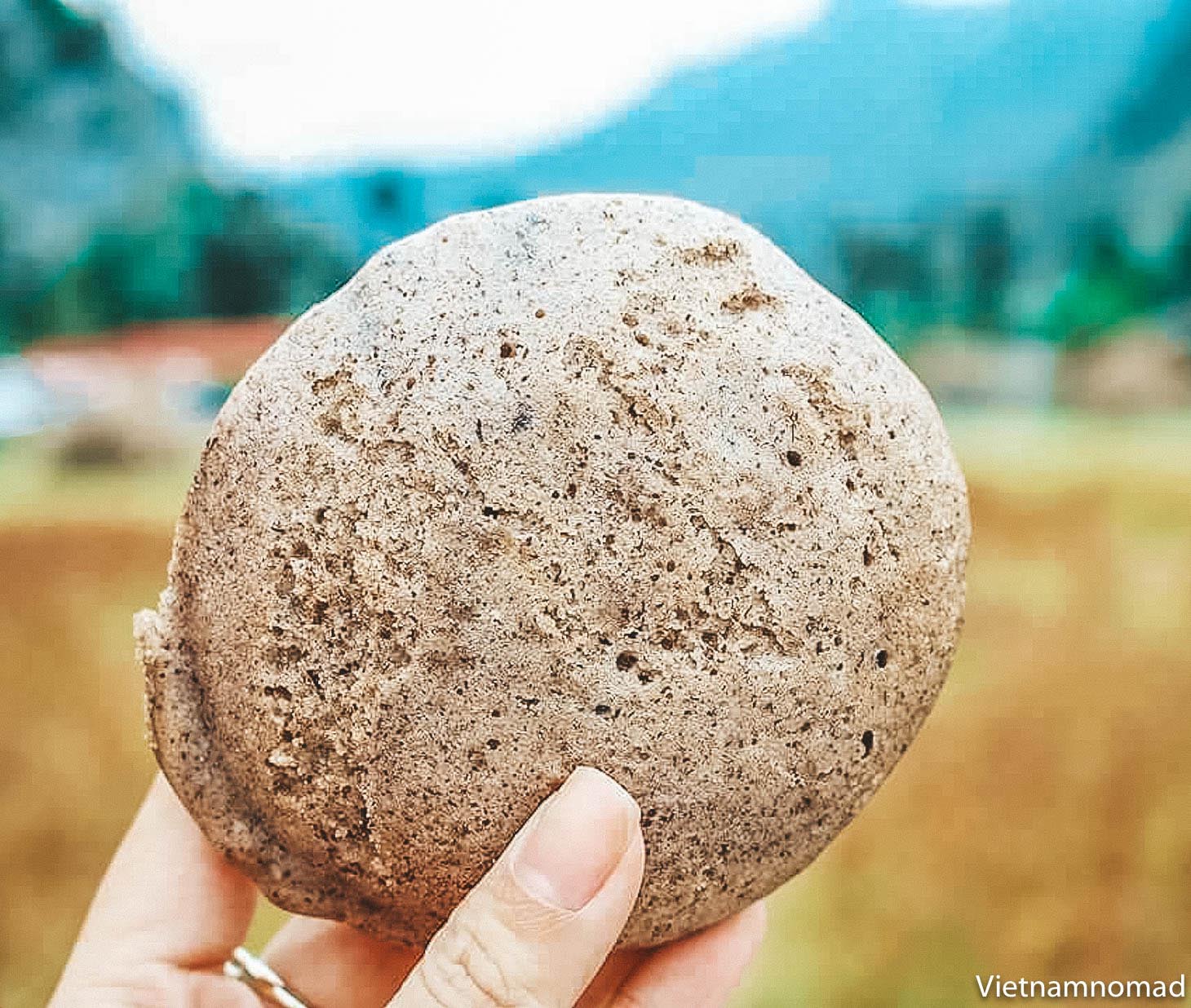
Buckwheat flower is not only one of the most beautiful flowers attracting many visitors, but it is also a food material in Ha Giang. When the season comes, people often take buckwheat flowers as milled flour for cattle and also use them to make a famous dish called buckwheat cake.
To make buckwheat cakes, people have to spend a lot of effort. They must use a mortar to grind the stems to make a smooth powder. Then knead the dough with water and mold it into the most beautiful buckwheat cakes.
The buckwheat cakes are grilled with charcoal, so it has an attractive aroma. There is nothing better than eating a cake in the cold winter.
A box of buckwheat cake has an average price of 25.000 VND to 30.000 VND.
5. Aconite root congee
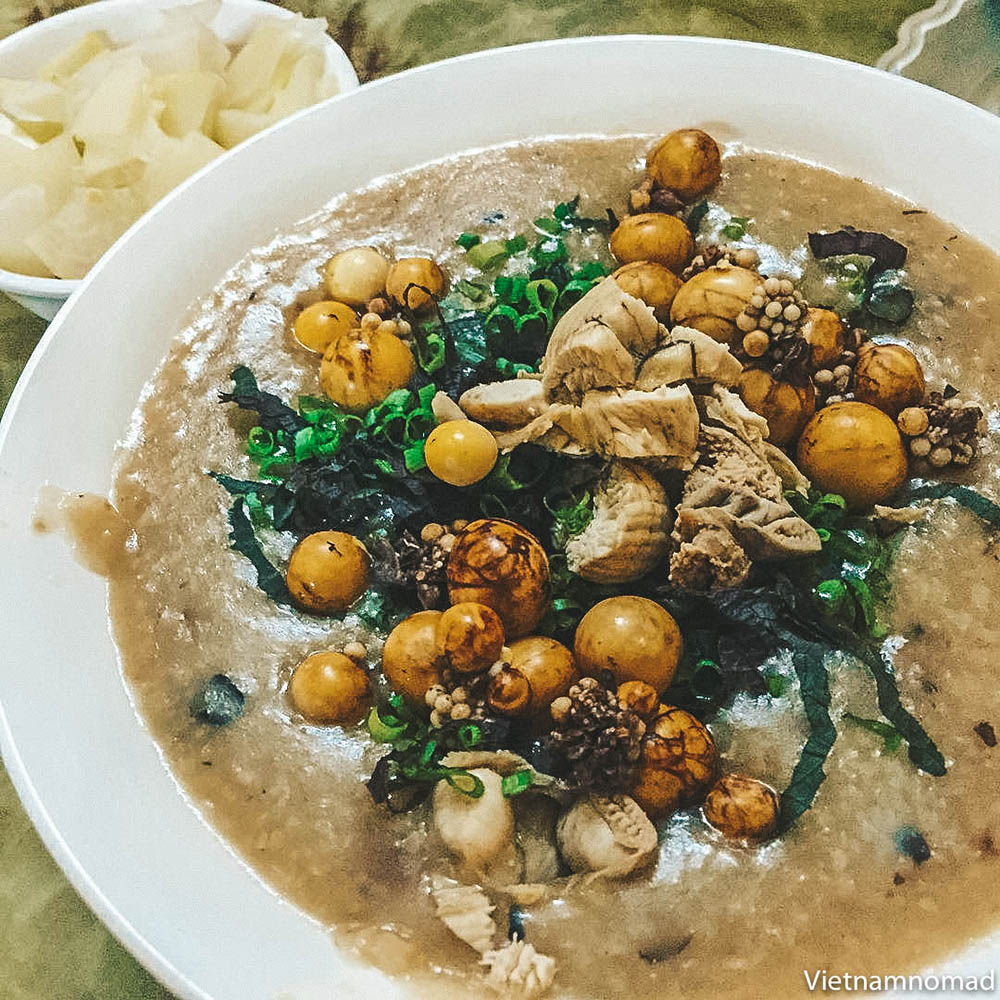
Aconite root congee in Vietnamese is called Chao Au Tau is one of the dishes that many people love when coming to Ha Giang. This dish is made from simple ingredients but offers very delicious. The main ingredients of this dish are trotter, aconite root, and rice. You will feel the delightful taste of the rice combined with the sweetness of the trotter. Enjoying a bowl of Chao Au Tau in the cool morning will help you feel the full taste of this dish. Each bowl of aconite root congee is priced from 25.000 to 30.000 VND. A popular dish but offering an unforgettable taste.
6. Bac Me bamboo cooked rice
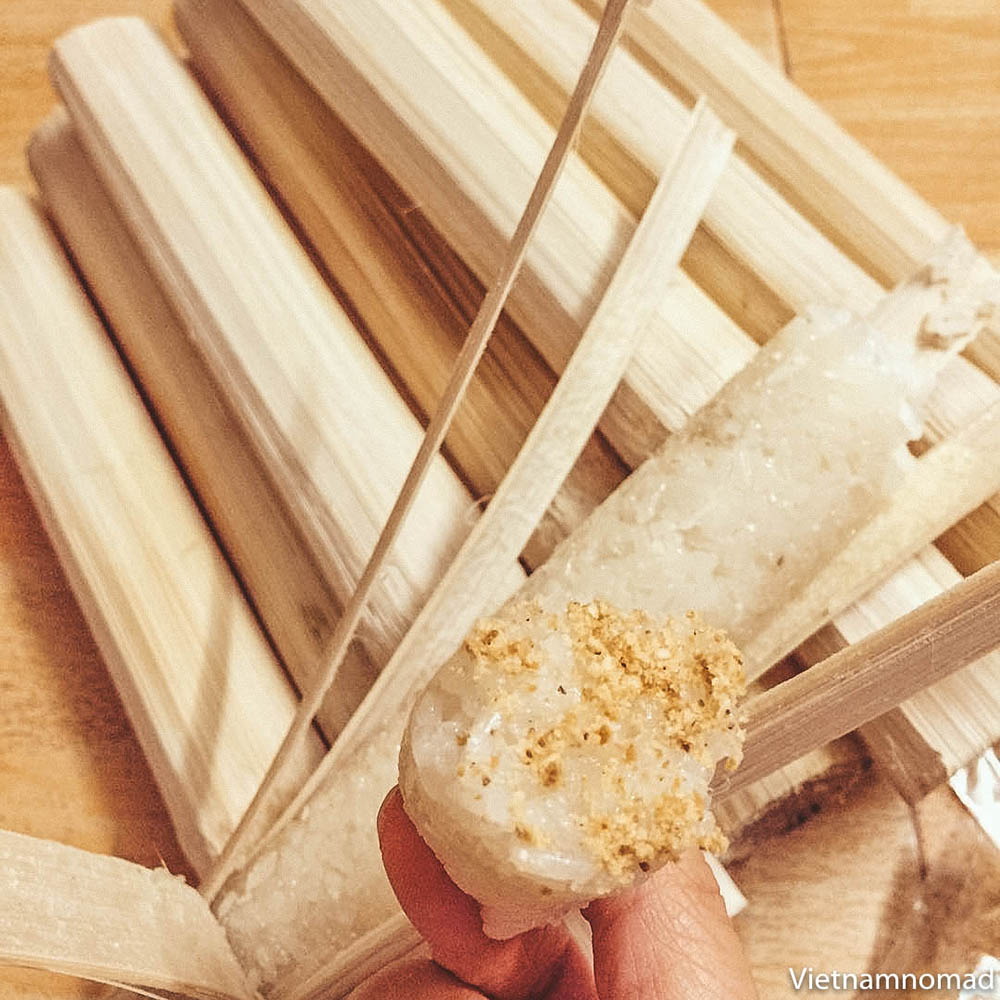
Com Lam (bamboo cooked rice) is cooked in a bamboo tube and grilled on fire. Ethnic minorities often make this dish to take with them when going to the field for farming, because it is so convenient and well-preserved. To make Bac Me bamboo cooked rice is simple and also not expensive. People often choose the raw material as the best glutinous rice grown in the fields, then soak it in water. The choice of rice is the most important factor because they determine the delicious and aroma of this dish. Soak the rice, wash, and mix well with a little salt. Then pour the glutinous rice into a bamboo tube and pour water into the top layer of rice. Then take the banana leaf or dong leaf as a knot so that the knot is tightened at one end.
7. Thang Den
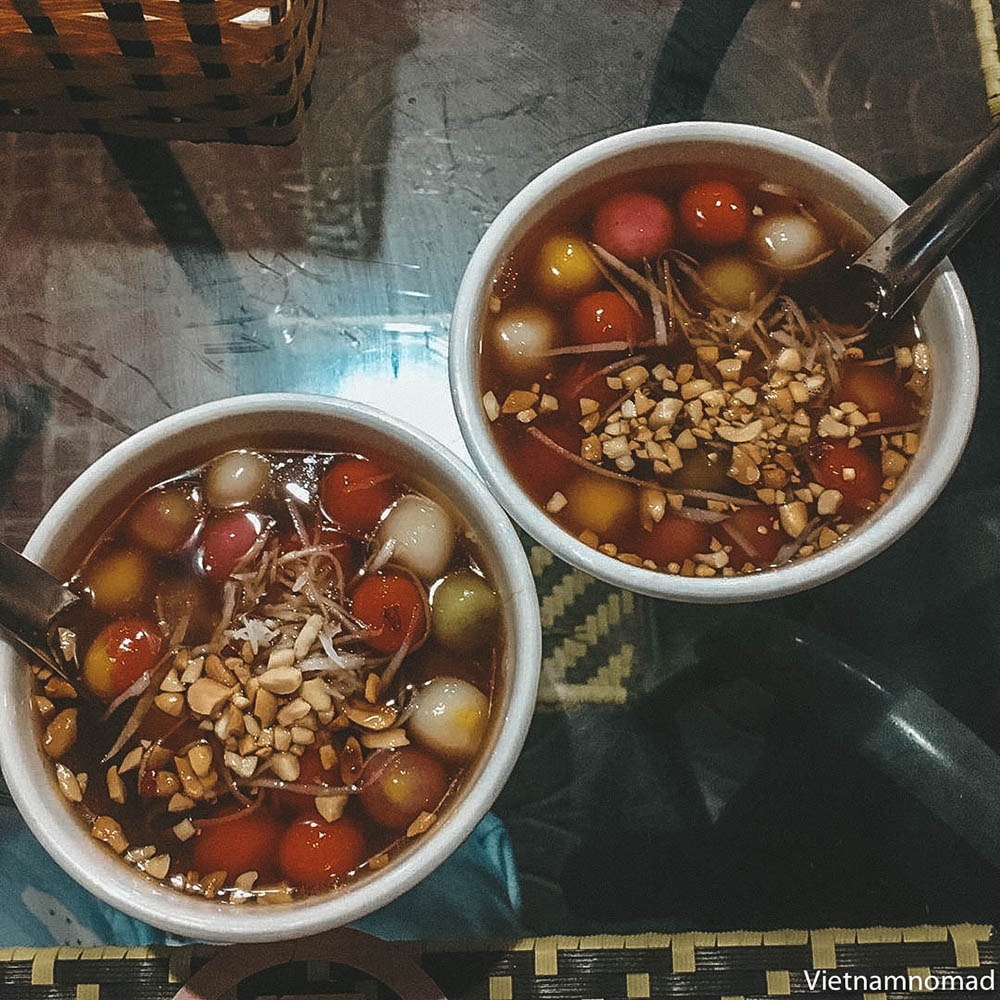
If you look at first, you may be confused Thang Den with water drift cake (a popular dessert in Vietnam). Thang Den dish is made from upland rice flour. It has a green bean paste inside. People circle it into smaller balls than water drift cake, but the color is similar. Then cook with sugar water and fresh ginger. When enjoying, add some roasted peanuts to the top to create a fragrant and different flavor. This dish is good for your health, especially in the winter. Thang Den is mostly sold at the roadside or local markets for only 5.000 VND/bowl.
The unique cultural markets in Ha Giang
Like other Northwest provinces, the upland fairs are a unique cultural feature in Ha Giang. These are not only places for people to exchange, buy, and sell goods but also allow visitors to experience the unique cultural characteristics of many ethnic minorities here.
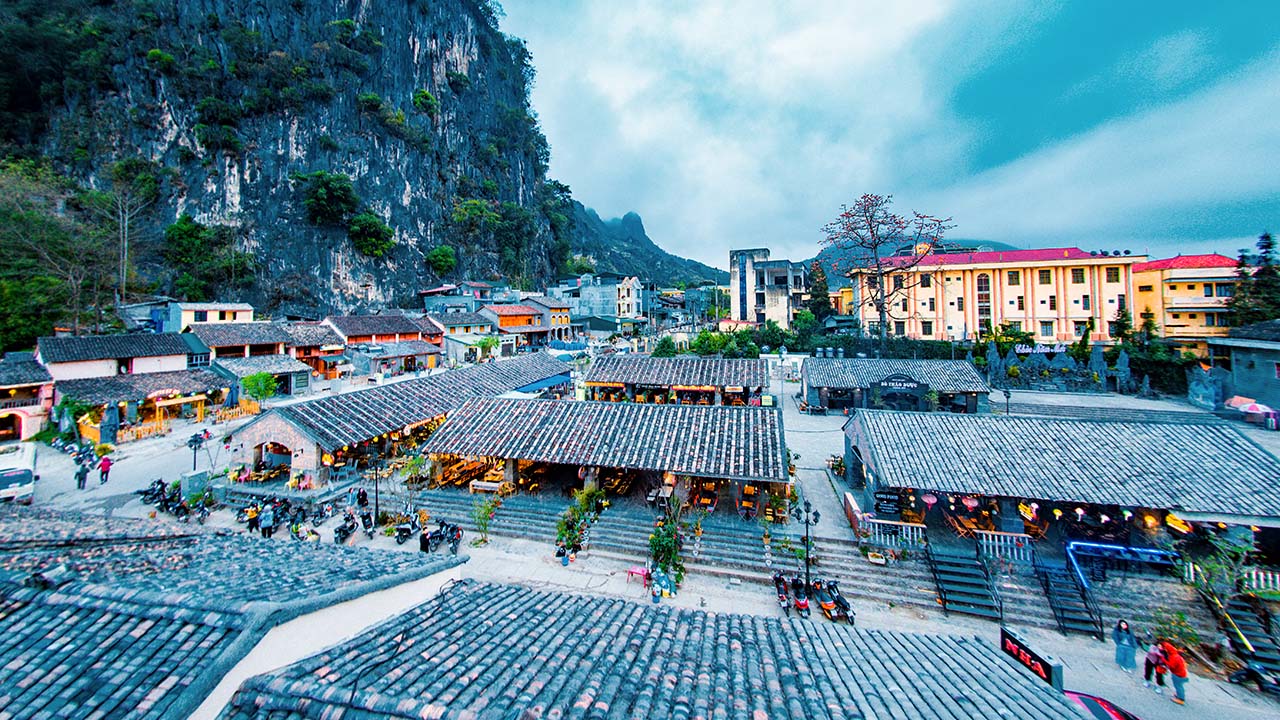
Khau Vai Love Market in Meo Vac District
This fair is held only once a year at the end of the third lunar month, which is held in a wide, flat valley in Khau Vai Commune, about 20 km from Meo Vac Town. At first, the fair was just a place for couples to go on a date and a traditional night market for Mong people. But later, Khau Vai Market has gradually become a dating market, a place to find the love of young people. Coming to Khau Vai Love Market, visitors will have the opportunity to admire “colorful flowers”, which are created by many different costumes of ethnic minorities such as Mong, Giay, Dao, and Tay.
Du Gia Market in Yen Minh District
Du Gia Market is located more than 60km from the center of Yen Minh Town. The market is held in the center of the commune, which is one of the quite primitive markets, imbued with upland ethnic culture.
In Du Gia Market, there are often many cultural and artistic activities taking place. Visitors can listen to the typical lip flute, as well as enjoy the unique dishes of the people here, such as corn wine and Thang Co. The fair takes place every Friday but only lasts until noon.
Pho Cao Market in Dong Van District
Located about 25 km from the center of Dong Van, Pho Cao Market is a famous market in Ha Giang that meets every six days. Like Du Gia market, Pho Cao lasts only from early morning to noon. Pho Cao Market is the place to sell local products. And it is also a cultural exchange place for 17 ethnic groups living in border communes.
Lung Phin Market in Dong Van District
In Dong Van, apart from Pho Cao fair, there is Lung Phin fair, only meeting on Monkey day and Tiger on the lunar calendar. Visitors to Lung Phin Market will admire the diverse cultural colors of the ethnic minorities here and have the opportunity to enjoy highland specialties such as Lung Phin snow tea, dried beef, wine corn, and mint honey.
Central Market in Meo Vac District
The market is located near the Meo Vac stadium, which takes place every Sunday. Unlike other markets, people often go to the market from the night before to the next day. This is the largest fair among the upland markets in Ha Giang with lots of goods, agricultural products, and household items.
Here is all Ha Giang travel information you need to know before coming to Ha Giang. We hope you will have a great trip with lots of exciting experiences.
Meet in Vietnam!
Related Articles
Mui ne, phan thiet, ha long bay.

The most complete Ha Giang Travel Guide (updated regularly)
(Last updated: July 21, 2022 )
In this Complete Ha Giang Travel Guide article I’ll cover the following topics:
Best time to visit Ha Giang
- Travel to and around Ha Giang
- Accommodations in Ha Giang (plus List of hotels in Ha Giang and List of homestays in Ha Giang )
Ethnic markets in Ha Giang
Nho que river boating.
- Suggested Itinerary for a trip to Ha Giang (4 days 3 nights)
- Summary of tips for travelling to Ha Giang
- Tip for solo travelers to Ha Giang
Feel free to comment below if you want to share any other tips you have about traveling to Ha Giang 🙂 This Ha Giang Travel Guide will be updated regularly, so it’ll be great if you can contribute with any tip or information regarding travelling to Ha Giang.
You might also want to check out these articles before reading this Ha Giang Travel Guide
5 of my best travel experiences in Ha Giang
Attractions in Ha Giang that will leave you amazed

The best time to visit Ha Giang is at… anytime. Yes, Ha Giang is beautiful all year round. There are certainly more popular times when travelers flock here and accommodations tend to run out, such as:
- September – October : when the yellow rice terraced fields are ready to be harvested
- November – December : when buckwheat flowers bloom all over the valleys
- January – February : when plum and peach flowers bloom
- In April on the day of the Khau Vai Love Market (27/03 Lunar Calendar) and during the time water is poured all over the rice paddy terraced fields
However, even if you visit Ha Giang when it’s less inundated with tourists (such as during the summer months), you will still find Ha Giang’s beauty intact. Rain or shine, the awe-inspiring mountains are always there to wow you.
Please note : Check Ha Giang weather forecast well before your trip. There is light rain in September-October and occasional storms during the summer months. In January and February, thick fog can make it dangerous to drive here.
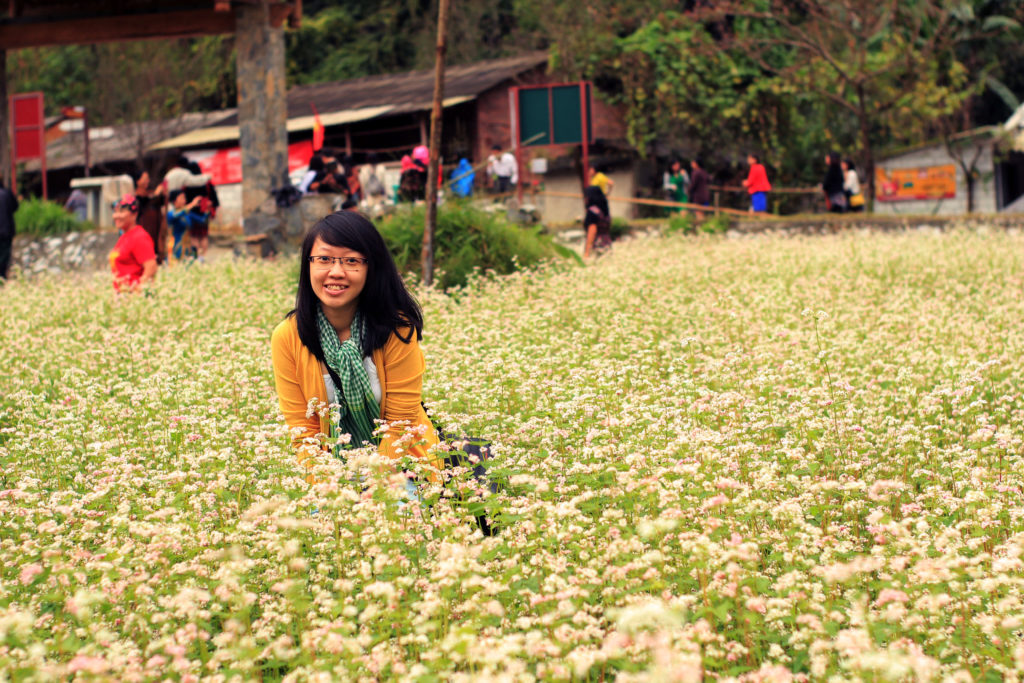
How to travel to and around Ha Giang?
Travel to ha giang from hanoi.
From Hanoi, you can go to Ha Giang either by motorbike (which takes from 8 to 10 hours as the distance from Hanoi to Ha Giang is 300 km), by rental car , by coach or by night bus (with berths).
Coaches from Hanoi to Ha Giang
Coaches and night buses from Hanoi to Ha Giang mostly run from My Dinh station. I’d recommend booking your coach ticket via vexere.com, where you can compare the price and time of different buses and pay online using Visa or Mastercard.
Otherwise, buying tickets directly at My Dinh station is also fine. Some coach companies also allow you to bring along your motorbike for an extra fee (call them to check beforehand).
Hiring a car from Hanoi to Ha Giang
Here are some travel companies you can contact. Note that drivers often don’t speak much English. You will also need to find an English-speaking guide (US$25 – US$45 / day) who will explain to you about the places and assist you if something happens on the road.
Vietnam Path Finder :
- US$440 / 4-seat car / 5 days
- US$485 / 7-seat car / 5 days
Including gas, road tolls, parking fees, and driver
Transviet Travel :
1,800,000 VND / day / 7-seat car including gas and driver
Travel to Ha Giang from Sapa or Lao Cai
There are 2 daily coaches (6am and 11am) that depart from Lao Cai to Ha Giang City. The coach takes around 5-6 hours and costs VND 120 000 / ticket (around US$6).
If you’re in Sapa, this means you need to go back to Lao Cai the night before departure.
Note : Please go to Lao Cai Bus station and check the bus timetable there beforehand as departure time might change.
Travel around Ha Giang
After arriving in Ha Giang city the next morning, you can take another bus to Quan Ba, Yen Minh, Dong Van or Meo Vac depending on your travel itinerary. Remember to ask the bus driver about the return time, in case you want to get back to Ha Giang city.
Then, you need to catch a motorbike taxi (xe om) to the attractions in these districts. You’d better have your itinerary ready by the time you find a xe om in Ha Giang city and then show him places that you want to go to.
The main disadvantage of xe om (motorbike taxi) is that most of the time, you will find it hard to communicate to the driver without knowing Vietnamese.
Here are some buses from Ha Giang city to Quan Ba, Yen Minh, Dong Van and Meo Vac . (Source: cungphuot.info)
Ha Giang City – Quan Ba
CƯỜNG THÚY (Runs from Ha Giang at 5-6am) – Tel: 0915 407522
THẮNG PHƯỢNG (Runs from Ha Giang at 11:30am) – Tel: 0915 185434
TÂN YÊN (Runs from Ha Giang at 12:00) – Tel: 0912 369134
Ha Giang City – Yen Minh
NGỌC CƯỜNG (Runs from Ha Giang at12:00-13:00) – Tel: 0904 256279
HOÀNG TUYÊN (Runs from Ha Giang at15:30) – Tel: 0912 120566
Ha Giang City – Dong Van
CẦU MÈ (Runs from Ha Giang at 5:00-12:00) – Tel: 0915 448933
A SINH (Runs from Ha Giang at 5:00-12:00) – Tel: 0984 520371
TRUNG YẾN (Runs from Ha Giang at 12:30) – Tel: 0979 682261
Ha Giang City – Meo Vac
HOÀNG TÀI (Runs from Ha Giang at 5:00-11:30) – Tel: 0912394082
CẦU MÈ (Runs from Ha Giang at 5:00) – Tel: 0167 2116226
NGỌC KHÁNH (Runs from Ha Giang at 9:00) – Tel: 0987 382992
QUANG NGHỊ (Runs from Ha Giang at 10:30-12:30) – Tel: 0946744733
By motorbike
Alternatively, you can rent a motorbike in Ha Giang city and ride by yourself. It’s necessary to prepare a photocopy of your passport for the motorbike owner to keep. Also, don’t forget to check out this list of what to pack for a motorcycle trip in Vietnam before hitting the road.
Most hotels in Ha Giang offer motorbike rental services. Simply ask them for the best quote!
To rent 4-seat to 29-seat cars in Ha Giang City, contact Mr. Vinh (Tel: 01646115115). This option is suitable for groups of 3 or more people.
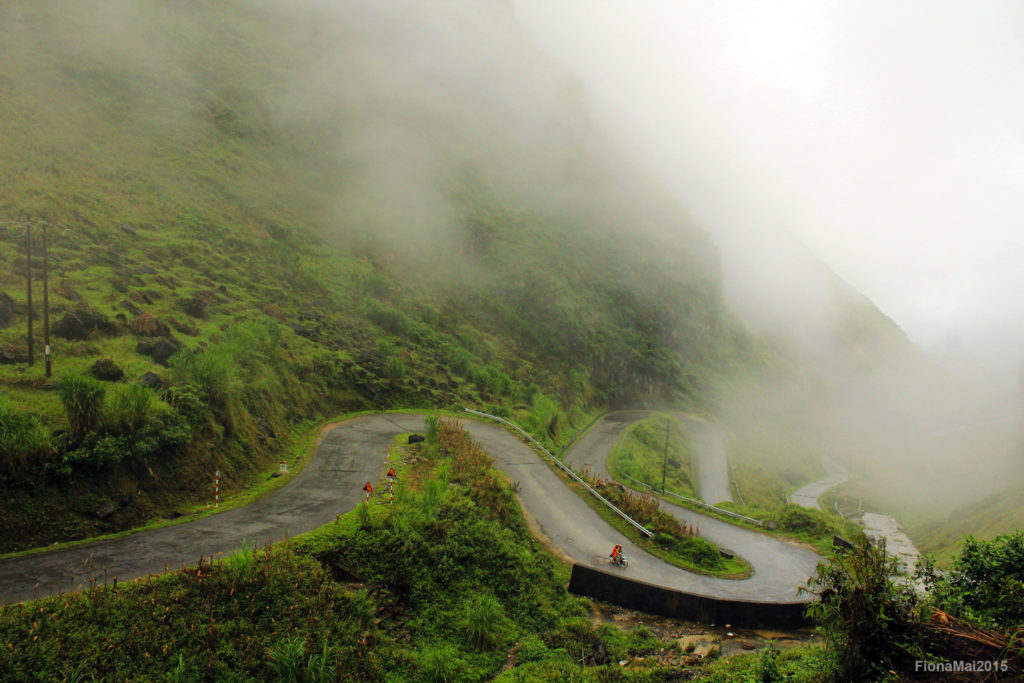
Accommodations in Ha Giang
Recommended hotels in Ha Giang City
Bông Hostel : This place has been recommended a lot recently by backpackers to Ha Giang. Free travel advice.
Ha Giang Hostel : They also offer motorbikes for rent and free travel advice
Golden Jungle House : Rustic style hotel with a good buffet breakfast
Phoenix Hotel Hà Giang : 4-star hotel with modern rooms and suites
Recommended hotels in Hoang Su Phi
Panhou Retreat : 4-star eco-friendly hotel surrounded by ponds and vegetable gardens
Recommended hotels in Dong Van
Aladdin Farmstay : Private rooms and dorm rooms including breakfast

Recommended hotels in Quan Ba
H’mong Village Resort : Rooms and bungalows with a great mountain view
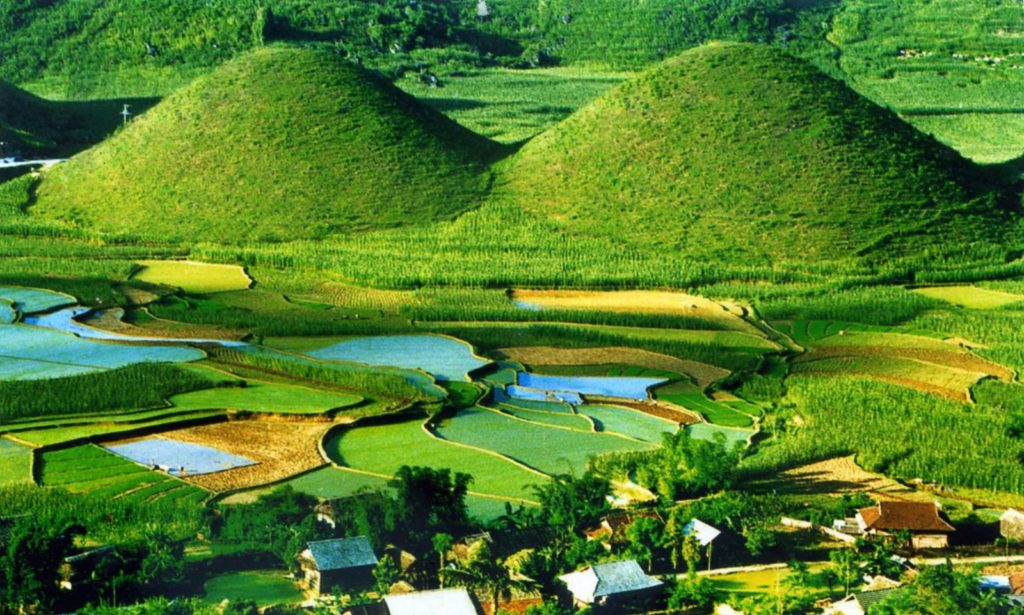
Recommended hotels in Meo Vac
Meo Vac Clay House : Rooms and dorms with garden and mountain views
Mai Dao 2 Hotel : Basic rooms, located near Meo Vac market
Recommended hotels in Yen Minh
Thien Minh Guesthouse : Clean and comfortable rooms
Recommended homestay in Ha Giang
Homestay Bongbang Lovely homestay in a H’mong family
Nậm Lỳ Homestay : A simple homestay in Hoang Su Phi with beautiful views of mountains and valleys
Here are some popular ethnic markets in Ha Giang which are also easy to access. Note that these markets all start very early in the morning, at around 6 am.
Ethnic markets in Dong Van
Dong Van Market : Every Sunday morning in central Dong Van town
Ma Lé Market : Every Saturday morning, around 10km from Dong Van town center
Pho Cao Market
Lung Phin Market
Ethnic markets in Quan Ba
Quyet Tien Market : Every Saturday morning
Quan Ba Market : Every Saturday morning
Ethnic markets in Yen Minh
Yen Minh Market : Every Sunday morning
Du Già Market : Every Friday morning
Ethnic markets in Meo Vac
Meo Vac Market : Every Sunday morning in the town center
The beauty of Nho Que river is undeniable, as it gently flows across rugged mountains in the north of Vietnam like a green sewing thread.
Boating on Nho Que River in Dong Van, Ha Giang is an unforgettable experience, as you can fully immerse in the breathtaking beauty of nature with scenes of imposing mountains on both sides.
How to take a boat on Nho Que river
There are several ways to take a boat on Nho Que river but I’ve figured out that the way below is the most straightforward.
Firstly, book a boat by calling one of the boat owners below. (Make sure you ask someone to help you speak Vietnamese with them).
- Mr Diep: 0865040992
- Mr Dai: 0964426017
- Ms Hoa: 0865818268 / 0856769000
Next, if you go by motorbike from Dong Van Old Town Market, take the main road to a place called “Lối xuống bến thuyền Tà Làng – sông Nho Quế” on Google Maps.
Then, search Google Maps the way from there to “Bến thuyền hẻm Tu Sản” , which is the boat station where you can board a boat to explore the beautiful Nho Que river.
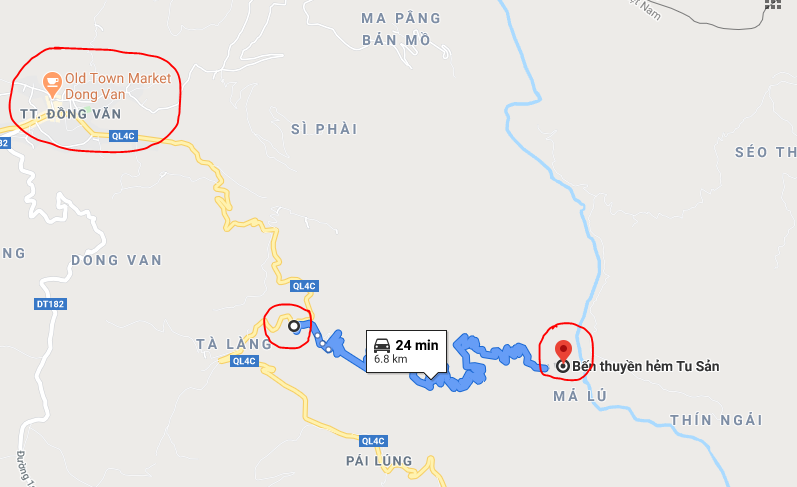
NOTE : It’s a rugged zigzag path that is not easy to go. Remember to be extra careful!
The price is VND 150,000 per person for a 30-minute boat trip on Nho Que river. Simply sit back and enjoy the amazing landscape here!
Suggested 4-day Ha Giang itinerary
This Ha Giang itinerary is for those who travel from Hanoi to Ha Giang for 4 days and 3 nights (actually you’ll only spend 2 days around Ha Giang). This can be quite rushed but is ideal for those with limited time.
Check the map below for more info about the routes (click to zoom).
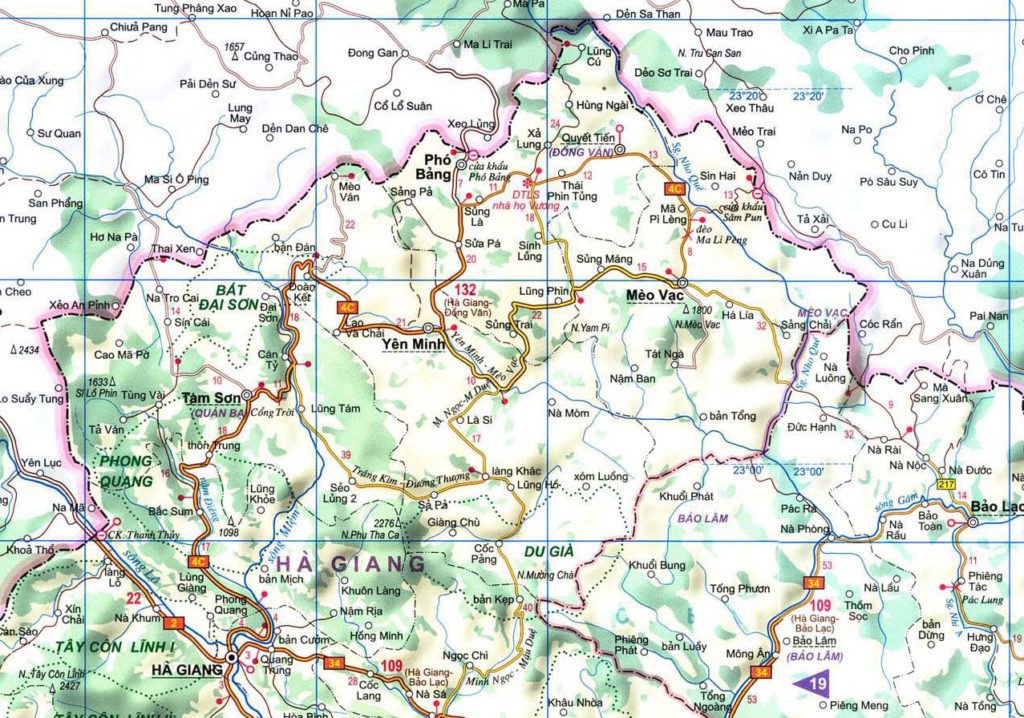
Take a night bus from My Dinh Bus Station in Hanoi to Ha Giang. Spend the first night on the bus.
Arrive in Ha Giang city at around 4-5 am. Have breakfast and rent a motorbike in Ha Giang city, or find a xe om (motorbike taxi) and show him your intended destinations for the day.
Depart to Quan Ba (50km) and visit Quan Ba Valley. Visit Lung Tam Weaving Village.
Depart to Yen Minh: The route will be Quan Ba – Can Ty – Na Khe – Lao Chai – Yen Minh (40km). You will ride past the Yen Minh Pine Forest, which can be foggy during the winter months.
Stop at Yen Minh for lunch.
Depart to Pho Cao (10km) and then to Sung La (10km). These are great places for photos, as you will be able to see villages of local ethnic groups where houses are built by stacking stones together.

Depart to Sa Phin (5km) and visit the Vuong Family’s Mansion
Depart to Lung Cu (22km) to visit the Lung Cu Flag Tower – the northernmost point of Vietnam’s territory. The distance is around 25km.
You should leave Lung Cu for Dong Van by 5.30 pm lest darkness makes it harder to drive.
Spend the night in Dong Van
Visit Dong Van’s old town and Dong Van market
Depart to Meo Vac (~ 40 km) and behold Ma Pi Leng on the way
Have (early) lunch in Meo Vac
Afternoon :
Depart to Ha Giang City (160km)
Visit Tha Village with ancient stilt houses (2km from Ha Giang City)
Catch the night bus from Ha Giang back to Hanoi. Spend the night on the bus.
Arrive in Hanoi early in the morning
Any tip for a solo traveler to Ha Giang?
The more well-prepared you are, the better experience you will have!
Also, don’t be discouraged by the stereotype that Ha Giang is only meant for mass tourists and adventurous strong men on motorbikes. Ha Giang can be a great destination for anyone, including solo travelers. Just read about Ha Giang and plan as much as you can before departure, and you’ll be absolutely fine!
Summary of Ha Giang travel guide:
- Book things (hotel, motorbike, etc.) beforehand when you’re still in Hanoi so as not to avoid language barriers. Find someone who can speak Vietnamese to help you with the booking.
- Bring a list of essential Vietnamese phrases to communicate with locals (eg. How much is this? What time does the bus leave? Etc.)
- Bring along your passport! Foreigners occasionally get their identity checked when traveling near Vietnam’s border.
- Foreigners are also required to apply for a permit when traveling to Ha Giang. The cost is VND 230,000. The staff at your hotel in Ha Giang can help you arrange this. Otherwise, you can visit the immigration office in Ha Giang city (415A Tran Phu St.) to sort it out by yourself.
- A first-aid kit will also come in handy.
- Avoid visiting Ha Giang during public holidays and check the weather forecast before you go
I wish you a great trip to Ha Giang, and as always, I’d LOVE to hear your own experiences when traveling here.
This Ha Giang Travel Guide is meant to be updated regularly. Therefore, if you have any other tips about Ha Giang travel that you want to share, please don’t hesitate to comment below! Let’s help each other enjoy the beauty of Ha Giang (while it lasts) 🙂
–> Pin this Ha Giang Travel Guide for your future Ha Giang trip!

- ha giang travel guide
38 thoughts on “ The most complete Ha Giang Travel Guide (updated regularly) ”
Dear Fiona,
very interesting your post from Ha Giang but perhpas do you still have some good knowledge about Cao Bang and Lang Son?
Thank you for the attention and kind regards.
Hello Luigi,
I am planning to publish a travel guide for Cao Bang and Lang Son soon, especially for trips to Ba Be Lake and Ban Gioc Waterfall. In the meantime, if you have any question about travelling to Cao Bang and Lang Son, please feel free to email me at [email protected] and I will be happy to answer you to the best of my knowledge.
Thanks for this, very informative! Do you know what is the average cost of hiring a xe om for a full day in the Ha Giang region?
Hi Jessica,
The price depends on how many kilometers your ride covers. It costs around 5000 VND / km but might cost more when riding on mountainous terrains. Since attractions in Ha Giang are often far from each other, I think it will cost you at least 500 000 VND for hiring a xe om full day.
Can I do Ma Pi Leng pass in 1 day from and ending in Ha Giang?
Super sorry for my late reply. Yes you absolutely can. The road leading through Ma Pi Leng pass (Happiness Road) is around 20 km long. From Ha Giang city you can drive along this road and even stop for photos within one morning 🙂
Hi Fiona! Thanks so much for all this information. I was wondering if you might have a map of some sorts that you can share? How are the roads there? If i have time fir an extra day to the itinerary what else would you do? Thanks a lot Ariella
Hi Ariella,
What kind of map do you need (a map with detailed roads or just a basic map with locations of the tourist attractions)? In any case, you can try googling “Bản đồ Hà Giang” (“Ha Giang map” in Vietnamese) and check the Images results. Hopefully you can find one that is most suitable for you there. Unfortunately I haven’t got any for myself, but I’ll try to find some and add to this post. I believe those who ride motorbikes in Ha Giang use google map most of the time.
If you have one extra day here, I would recommend spending time immersing into the daily life of local H’mong people, so that you have a deeper understanding of their interesting culture. Perhaps you can stay in one of their homestays and ask to join their cooking time or farming activities?
Hope you’ll have a great time in Ha Giang! 😀
I have included a Ha Giang map in this post. Hope this is useful for you all to plan for your trips. Happy travelling! 🙂
Fiona – great information, thank you so much for sharing. I’m thinking of going to Ha Giang in a few days from Hanoi. The weather looks very wet for the next week or so. Do you have any tips on what to look for in the forecast to make sure it’s not too wet or foggy? In general is early April very rainy?
I am really impressed with your writing skills as well as with the layout on your blog. Is this a paid theme or did you modify it yourself? Either way keep up the excellent quality writing, it is rare to see a great blog like this one nosaadyw..
Thank you very much for your very informative blog. We will be traveling to the north of Vietnam in July. We would like to stay a night at the auberge Meo Vac but unfortunately they only speak Vietnamese so I could not make a reservation for 5 adults the 15th of July. Could you help me with this?
Best regards,
Hi Anouk, I am currently not in Vietnam so I unfortunately cannot call them for you. However, you can make a booking online via tripadvisor here .
Hello! Thanks for the super helpful and detailed information! If I’m gonna do the day 2 and 3 as above, will I be able to get a Xe Om (with my backpack) throughout? Or will it be possible to rent for 1 day from Ha Giang to Dong Van, then do a day of trekking around Dong Van, then continue the journey from Dong Van to Cao Bang on another Xe Om? Appreciate your help on this(:
Hi Claire, Yes you can hire a xe om or rent a motorbike to go from Ha Giang to Dong Van and do trekking around there, but I think it’ll be difficult to find a xe om who will take you from there all the way to Cao Bang. As far as I know, there’s also no public transport between Dong Van and Cao Bang. There are 2 options you can consider: 1. I’ve once heard of someone who managed to hire a xe om from Meo Vac to Bao Lac (~75km) and then take a bus from there to Cao Bang city. You can also try doing the same. I’m not sure of the cost but I think it can be up to 800,000vnd. 2. If you have your own motorbike (which you bring from Hanoi for example), in the afternoon of day 3 you can ride from Meo Vac to Bao Lac (instead of going back to Ha Giang city), then depending on the time, you might want to spend the night in Bao Lac or continue riding to Cao Bang City. Hope this helps. I will try looking for more info about the route from Ha Giang to Cao Bang and add updates to this Ha Giang Travel Guide. BR, Fiona
Hi Fiona, thanks for the reply! That’ll be really awesome (: (dont think I ride well enough for option 2 but option 1 is real comforting to hear!)
“Wonderful work! This is the kind of information that are meant to be shared around the internet. Disgrace on Google for now not positioning this put up higher! Come on over and seek advice from my website . Thank you =)”
There are some interesting tips on how to get to Ha Giang. I wouldn’t like to go by motorbike from Hanoi, the overnight sleeper bus sounds a better option. I would love to photograph the flag tower!
We (8 of us) intend to visit Ha Giang for 5 days. We would want to engage a driver and guide to and fro from Hanoi to Ha Giang.
1. Can you advise what is the must go places? We do not want to do a rush rush tour and hence do not want to cover too many places. 2. Any recommendation on some simple and short trek to meet and mingle around with the tribes people? 3. We would like to stay in homestay too. However, end Dec will it be too cold as I was told they do not have any heater available? 4. I have gotten a quotation which charge $430 for 6 days package including Ba Be lake. Is this cost reasonable? 5. Is Ba Be lake worth going as it was not in my original plan. 6. Any good guide and driver to recommend? The guide needs to be English speaking.
Thanks in advance and looking forward to your advice.
Hi there, here are my answers to your questions: 1. I guess you will have at least 3 full days to explore Ha Giang during your 5-day trip, which is quite sufficient to cover most of the must-visit attractions here. My most favorite attractions are Lung Cu Flag Tower (make sure you climb to the top for the amazing view from there), Ma Pi Leng and Quan Ba Twin Mountains . You might also want to visit one of the ethnic markets here 🙂
2 + 3. I don’t have any particular recommendation regarding trekking trails. However, I would suggest staying in one of the ethnic minorities’ villages and ask the locals living there for trekking options around those areas. They’ll know best. Some of the relatively more “luxurious” homestay options that can provide heaters are Dzao Lodge and Auberge de Meo Vac. While they look more like hotels than homestays, their locations within ethnic minorities’ villages will also make it easy for you to interact with the locals.
4. Is that quotation per person? Does it include food, accommodation and guide as well? For your reference, hiring a 7-seat car with a driver and no guide costs $90 / day / car (but you have 8 people so it might cost more). A group tour with 10+ people will normally cost from $30 – $50 / day / person, including food, transport, guide and accommodation.
5. I love Ba Be and the beautiful scenery there! However, I personally feel it’s better to visit Ba Be in the summer, as the cool weather here can help alleviate the summer heat in Hanoi. If you visit Ba Be in December, it might be quite chilling while sitting on the boat 🙂
6. I don’t personally know any driver or English-speaking guide to recommend, but you can contact this company to ask for a quotation. They are used to arranging private customised tours in North Vietnam.
Happy travelling! 🙂
Hi Fiona! I just discovered your blog and I love it!
I’m travelling to Vietnam next August and I wanted to ask which place would you recommend: Ha Giang, Pu Luong or Mu Cang Chai? I could spend there 4 days.
Thank you very much!
Hi Elena, Thanks for visiting my blog! Mu Cang Chai and Pu Luong are most beautiful during the harvest season in late September – early October, when the rice fields all turn yellow. If you travel to Vietnam in August, I think Ha Giang should make a better destination as there are more things to see and do there compared to Mu Cang Chai and Pu Luong. Just keep in mind that you’ll need at least 3 days to visit Ha Giang, whereas Mu Cang Chai and Pu Luong can each be covered in 2 days. Have fun! Fiona
Thank you!!! I’ll follow your advice!
Hey Fiona, no questions for now but just want to say you are amazing for sharing this with the world – great blog, please keep writing!
Thank you very much for your kind comment 🙂
I agree with Daniel, you are amazing! I’m sure isn’t easy to find the time to help us all!
I’d like to ask you one more thing about Ha Giang province 🙂 🙂 Do you know Hoang Su Phi?
I’d like to go to Hoang Su Phi after completing the Ha Giang loop and there is very few information available on the internet. I have a lot of doubts:
– The road is safe enough to go by motorbike? – At what time do the buses leave from Ha Giang to Hoang Su Phi? How long is the trip? – Where should I stay in Hoang Su Phi in order to do a nice hiking around the rice terraces? – One night is enough or should I spend two?
THANK YOU!!!!!
Hi Elena, I am super sorry for my late reply! You’re going to be here in August so I hope my comment is not too late though. The road to Hoang Su Phi is quite difficult to ride, but of course can be completed given that the weather is good. Some areas can be very muddy and slushy when it rains. To get to Hoang Su Phi from Ha Giang: I know there’s a bus from Bac Quang but I’m not sure about the time. Perhaps you can ask a local in Ha Giang about this? There’s also another bus from Tan Quang, which departs twice a day at 7am and 1pm. The journey takes around 3,5 hours. You can stay at Nam Hong and Thong Nguyen homestays for easy access to the terrace fields. I’d love to stay 2 nights haha but of course if you don’t have enough time, one night should be fine 🙂 Fiona
You are the best! Thank you for your help!
We would love to go to this area, but we will be travelling with our toddler of almost two years old (1 year and 8 months). Will that work? And would you have some tips for us? (tips on how to get around and see the surroundings without having to spend too much). Can you use busses to get from one village to the other? And die you tried to hitchhike?
Hi Quirine, I wouldn’t recommend travelling with your toddler to this area as the journey could be quite exhausting for her (and you two as well). If you want to visit Ha Giang on a low budget, the best way is to rent a motorbike and do the driving by yourself. Buses do exist but many of them do not go deep into villages, not to mention that their inconsistent timetable can be time-consuming for you. I have not tried hitchhiking in Ha Giang or anywhere in Vietnam so I can’t really say much, but that sounds like something worth trying. Viet people are not very accustomed to picking up strangers on the road, but the ethnic minority people around that area might take you on their motorbikes? 🙂
I’ve read several of your posts by now and love them! There’s always so much information and details! Thanks a lot for all your ideas. It’s so inspiring to plan a trip and makes it so much easier as well 🙂
I’m glad you’ve found my blog helpful 🙂 Happy travelling!
Hi Fiona, Thank you for your blog. Great Work! I am planning to go from Hanoi to Ha Giang. I’d like to visit as many ethnic markets as possible where the hill tribe people sell fabrics. So many of the markets change the days they are held so I am confused about which markets to plan to visit.
I will arrive in Ha Giang March 13 return to Hanoi March 17 in the evening.
Can you please suggest an itinerary for finding old hill tribe (Hmong batik, Red Dao, Tay brocades etc.) textiles at markets during this time and also villages where they may be selling old clothes and fabrics? Thanks very much! Jan
Hi Jan, thanks for reading my blog post about Ha Giang. I have sent you an email about this. Check it out 🙂
Ha Giang is such a beautiful, dreamy and peaceful place! It is less touristy compared to Sapa, therefore I could totally immerse myself in the authentic and interesting local life with minority people. Btw, thank you for your informative and amazing blog post!
I’m glad you like Ha Giang too 🙂 Thank you for reading my post!
Amazing! I know nothing about traveling all over the country, what a wonderful looking place to explore.
I really appreciate this wonderful post that you have provided for us. I assure this would be beneficial for most of the people.
Leave a Reply Cancel reply
Your email address will not be published. Required fields are marked *

Modal title
What to do in ha giang – a complete travel guide.

The North of Vietnam does not possess the sparkling modernity of a major city; it is, however, the rustic nature that keeps visitors coming back for more exploration. Ha Giang is among the up-and-rising travel destination in the area thanks to the adrenaline-rushing motorbike trails, eye-catching mountain passes, and breathtaking nature. Read our blog on how you can prepare for your trip to Ha Giang.

Beautiful scenery captured from the side of the road in Ha Giang
Table of Contents
1. Quick Facts about Ha Giang Province 2. What to Pack for Ha Giang 3. Where to Stay in Ha Giang 4. Ha Giang Travel Permit 5. How to Get to Ha Giang Province 6. What to Do and See in Ha Giang Province 7. What to Eat in Ha Giang Province 8. When to Visit Ha Giang Province 9. Other Local Tips for Visiting Ha Giang Province 10. Final Thoughts on Ha Giang Travel
1. Quick Facts about Ha Giang Province
Most people would travel from Hanoi to Ha Giang, and you would need a travel permit and a recognized motorbike driving license. See the section below for more details.
Weather: The best time to visit Ha Giang is during the dry season (November – March) when the weather is generally settled (with the temperatures ranging from 20 oC – 25 oC / 68 oF – 78 oF). However, expect cold and chilly weather from the mountain wind when you drive the motorbike. Read the bottom of this guide on which month to visit Ha Giang.
Geography: Ha Giang is 320 km away from Hanoi. The province lies on the northernmost point of Vietnam and shares a 270 km long border with southern China. The terrain contains mostly of rocky mountains, forested hills, limestone formations, and springs.
Demographic: 25 ethnic minorities are residing in 11 districts in Ha Giang province, which includes a provincial city of the same name.
History: the land establishment dates back to 3,000 years ago, and since then has undergone numerous courageous battles against the enemy for independence. During the colonial period, the French tried to lure the Hmong King Vuong Chinh Duc with an aim to take over the area, but the King stood his ground in supporting the Ho Chi Minh’s ally.
2. What to Pack for Ha Giang Travel
Besides the essentials for your Vietnam Travel, make sure to bring these items when traveling to Ha Giang.
Check this guide for a complete packing list for Vietnam :
- Passport & Visa
- Appropriate clothing (depends on the month of travel)
- Raincoat/toiletries (you can find these along the way at roadside shops, so bring cash in Vietnam Dong)
- Camera & spare batteries (check adaptors )
- Security/ waist belt
- Medicine (bug spray, Antihistamines, Imodium)
- Entertainment items (books, games)
- Laundry items to wash your own (or you can easily find laundromats for VND 15k – 20k per kg)
- Quick-dry towel & scarf
- Water bottle
- All should be compacted in a backpack, preferably made of waterproof materials
- Walking/hiking shoes
- Face mask & a good quality helmet (if you’ll be riding the motorbike)
- Translation app to Vietnamese (this will come in handy when you’re in the remote region)
- GPS phone with data for map navigation (3G/4G is cheap in Vietnam)
Check Where to Buy a SIM Card in Hanoi
And since you’re traveling to a more off-the-beaten-path destination, it is advisable that you sign up for travel insurance from a trusted brand like World Nomads.
Get an insurance quote below:
3. Where to Stay in Ha Giang Travel
Since Ha Giang is not a tourist-centric area in the North of Vietnam, the accommodation options and modern hotel services in the area are quite limited. On the contrary, the cost is pretty economical, and you can easily stay under budget on your trip to Ha Giang.
The provincial city Ha Giang, Dong Van and Meo Vac districts in the province are where you can find good choices for hotels and homestays. Check out our recommended places on Where to Stay in Ha Giang .
Or find a hotel on Agoda:
4. Ha Giang Travel Permit
You may need a permit when visiting Ha Giang, mostly to present to the police when visiting the area. We say may here because nobody is likely to check for the permit. You will be more likely to be checked if you travel near the frontier area, which you’ll see signs on the side of the road like below. Although nobody is likely to ask you for that in general, it is necessary to avoid unexpected problems. We didn’t get checked once. You might be fined up to VND 1 million if you’re unable to show the permit. The permit price is VND 210,000 (USD 10) per person, and the process is quite swift and easy. Most hotels or guesthouses along the way of Ha Giang Province can help you with acquiring one.
Where to get your permit yourself when in Ha Giang City: Immigration office, 292 Tran Phu Street, Ha Giang City
Documents required: passport, motorbike registration if you’re traveling by motorbike

5. How to Get to Ha Giang Province
Most people would depart from Hanoi to Ha Giang. Hanoi has the Noi Bai International Airport , which is accessible from within the country or from overseas. There are several ways to get to Ha Giang from Hanoi, though the choices are not abundant as after all, Ha Giang is still an off-the-beaten-path area. Note that you may need the travel permit even when opting for public transportation.
Traveling to Ha Giang by Bus Many transportation companies have buses leaving for Ha Giang Province from Hanoi, and the majority of them offer good basic amenities, such as the reclining seats or a sleeper bus to make sure that you have a comfortable trip. The journey takes 6 – 8 hours and usually goes through the night to arrive at Ha Giang city by dawn.
- Pros: convenient, cheap, and suitable for traveling in groups.
- Cons: the long hours of traveling may take a toll on your back and legs; what is more, the staff may not speak English. Having said that, you can avoid those hindrances by booking a bus ticket online as you will receive all the road details and prices via email.
Search for bus (and train) tickets here:
Traveling to Ha Giang by Train There is no direct train from Hanoi to Ha Giang Province. You need to get off at Lao Cai Station and take another 6-hour bus to reach to Ha Giang. However, this is a favorable option if you’ll be coming from the Sapa – Lao Cai way.
Traveling to and around Ha Giang Province by Motorbike Motorbike is the most popular means to explore Ha Giang Province among adventurous solo or small group travelers. This is also a favorite means of transportation to travel around Ha Giang province. The 300 km ride of the Ha Giang loop can be arduous as it would take 3-15 days to complete, depending on your route and motorbike loop, and some underdeveloped roads do not make it any easier. Sometimes, you might have a delay from the blocked road due to previous landslides (but this is rare). On the brighter side, there is breath-taking scenery to marvel at along the way, from the splendid limestone karst and deep gorges, to the peaceful life of the ethnic villagers. Our take is that our motorbike trip through Ha Giang was totally worth it.
See our tips for renting a motorbike in Hanoi .

Travel tips:
- It is by law that you wear a helmet when driving, and for foreign riders in Ha Giang, you must acquire a Vietnamese license or an International Driving Permit (IDP).
- Check the bike quality carefully, especially if it is a rental. Brakes, lights, oil, chains, tires, etc.
- Make sure you plan & pack carefully according to the weather in Ha Giang.
- Be careful of the landslide during the raining season and the sharp turns at the mountain pass. If driving, you should honk when turning at extreme curves with little to no visibility to inform other vehicles that you’re coming in the opposite direction.
- Start the journey early in the day, and don’t risk going on an unfamiliar road at night.
- Plan your petrol and distance needed for the day – don’t wait until almost empty to refill.
- Factor in your driving time and do not base your timing off of Google Maps. The region is so beautiful that you’ll be making many stops along the way for photos. A good rule is to multiply your time needed by 2 or 3. Like, if the map says you’ll get there in 3 hours, plan for 6 hours.
- Try to stay on roads on Google Maps that are marked “QL” instead of wandering onto “TL” or “DT” roads. QL roads are considered national highways, so the road conditions are better than TL or DT.

A QL road at Dong Van

Vietnamese ethnic minorities walking their cattle back home before the sunset
6. What to Do and See in Ha Giang
Ha Giang is now internationally praised for its spectacular pristine nature and unique ethnic cultural traits. Not only the prominent attractions but also the little sneak peeks into the local’s life can lead you wonders to wonders relentlessly.
Quan Ba Heaven’s Gate The Quan Ba Valley stands at the height of 1,945 m and is a combination of uniformly-looking hills. Such a magnificent view has endearingly dubbed the valley the name “the Heaven’s Gate” at Quan Ba.

Tham Ma Pass The Tham Ma Pass does not seem to be for drivers with a faint of heart, but its sexy twists and turns create such an epic view along the way. The road lies on the 4C Highway, connecting Meo Vac District and Ha Giang City.

Ma Pi Leng Pass The Ma Pi Leng Pass also lies in the Highway 4C at the altitude of 1,500 m, connecting Dong Van and Meo Vac districts. The highway was built in the 1960s by the ethnic villagers.

The famous Ma Pi Leng Mountain Pass – totally worthy of a trip to Ha Giang

Phuong Thien Cave Phuong Thien Cave is home to numerous natural caves and grottos, and most notably, the Fairy Spring and Fairy Hill that associate with the mythical story of female sentient beings having frequented in the area.
Dong Van Karst Plateau Geopark This is a massive geopark of Vietnam that covers most of the four districts in Ha Giang: Meo Vac, Dong Van, Yen Minh, and Quan Ba. Almost 80% of the area is limestone, in addition to mountain peaks and deep valleys.

Lung Cu Flagpole As mentioned above, Ha Giang shares a land borderline with China, and it is the Lung Cu Flagpole that marks the northernmost point of Vietnam. There is an entrance fee of VND 25,000 charged by ethnic minorities at the steps before walking up to the flagpole. Motorbike parking is free.

This was a short part of the road leading up to the Flagpole being slippery and muddy due to the rain (picture taken in May 2019)

But once you’ve reached the top of the Flagpole, the view is very rewarding

View is taken from the Lung Cu Flagpole – Vietnam’s northernmost point, bordering China

Mansion of the Vuong Family Vuong Chinh Duc – who was appointed as the Hmong King in the early 20th century – built a mansion for his family residence in the Chinese design. The building was recognized as an architectural heritage in Dong Van District in 1993.
Weekly Markets As opposed to the wet market culture in the flatlands in which the market is held daily, markets in the mountainous regions, and particularly in Ha Giang, only meet once a week. Depending on where you’re staying in Ha Giang, make sure to join the local villagers in these weekly occasions to blend in with the vibrant atmosphere of the trading activities here and grab some unique souvenirs for yourself. One reminder is to ask the local organizer, if possible, to check when the market will be organized.
- Lung Phin Market (Meo Vac District): every Monday and “days of Tigers” of the month.
- Sa Phin “backward” market (Dong Van District): held in backward order during the weeks. In other words, if it is held on Sunday one week, in the following week, it’ll be held on Saturday, then on Sunday in the next week, etc.
- Hoang Su Phi Sunday Market (Hoang Su Phi District): opens on Sunday mornings
- Ma Le Frugal Fair (Lung Cu peak): regular market sessions on the weekend mornings
- Meo Vac Cattle Market (Meo Vac District): held every Sunday
- Xin Man Market (near the Chinese border): organized every Sunday
Plan your route ahead of time if you want to visit these markets. It is advisable to visit early to avoid the crowd of tourists.
Khau Vai Love Market Of all the ethnic markets in Ha Giang, Khau Vai Love Market in Meo Vac District is the most popular and awaited among both locals and tourists. The market starts from the late evening in the 26th of the third lunar months and lasts till the end of the next day. Traditionally, it is when and where the young villagers gather to find their significant other. Therefore, do expect a lot of colorful costumes and a romantic atmosphere in the stunning highlands
Hiking and Trekking in Ha Giang For outdoor lovers, hiking in the majestic peaks of Ha Giang is an unforgettable memory. The highest tops of Ha Giang are Tay Con Linh Peak and Kieu Lieu Ty Peak.
7. What to Eat in Ha Giang
Au Tau Porridge This is a type of rice gruel cooked with, you guess it, a type of poisonous flowering plants! But fear not, au tau is completely safe and edible when appropriately treated.

Have a bowl of hot au tau porridge when in Ha Giang City – most shops open in the afternoon – evening
Steamed Eggrolls (Banh Cuon) The steamed eggrolls is an easy dish to enjoy. One portion is often enjoyed with a delicious dipping bowl of mixed fish sauce.
Thang Co Thang Co is a type of soup originates from the Hmong people, and is usually made from pieces of either horse meat, pork, or beef. The dish is eaten with spicy chilly flakes. You can easily spot giant pans of thang co in the weekly market in Ha Giang, ready to be served.
Con Lam Bac Me Com Lam is one of the many signature rice dishes in Vietnam. The glutinous rice is carefully grilled on hot charcoal in a bamboo shoot before eaten with sesame salt.
Grilled Algae Grilled Algae is a staple dish of the Tay people. Though algae are nowhere near a usual cooking ingredient in any household, the Tay people know just the right seasonings to add and create a remarkable taste.
8. When to Visit Ha Giang Travel Guide
Ha Giang shares the humid subtropical climate in the northeast of Vietnam. Nevertheless, the montane weather patterns vary depending on the regions and altitudes. There are two seasons: the dry & cold season (November – March) and the rainy season (April – October), so naturally, the dry season is when you can freely explore Ha Giang without worrying about the unexpected showers. Nevertheless, Ha Giang still presents distinguished charm at different times of the year, so make sure to check your calendar carefully to plan your ideal itinerary in Ha Giang.
Springtime (January – February): is the time when the whole country supposedly enjoys the Tet holiday according to the Lunar calendar. The new year celebrations and festivals in Ha Giang, on the other hand, is especially vibrant thanks to the diversity of the ethnic groups in the area.
March: is when Ha Giang puts on its most colorful coat with the plums and peaches gardens blooming in profusion.
April sees the gathering of the Khau Vai Love Market, which only happens once a year and is actually considered the Tet holiday in the northernmost mountains when people dress up nicely and rejoice in the exultation of the market.
From May to October, is when you can enjoy the best panoramic view of the terraced fields and observe the agricultural life of the locals. Beware of landslides in the raining season.
October to December is probably the most visited time of Ha Giang due to the blossoming of the buckwheat flowers , especially after the magnificent landscape has captured international attention not so long ago.

Ha Giang terraced rice field taken in May 2019 (slight rain on our trip)
9. Other Local Tips for Ha Giang Travel
- Bring cash. Though there are ATMs widely available in Ha Giang city and the central districts, the local vendors only accept cash.
- See our tips for Avoiding Food Poisoning when Traveling in Vietnam
- Budgeting: plan for USD 25 per day, including accommodation, food, fuel, other small miscellaneous expenses (note that this number is a conservative budget)
10. Our Final Thoughts on Ha Giang Travel
If not now, then when? Hands down, do it! Despite being a far-off area, the breath-taking nature in Ha Giang will fulfill your adventurous spirit. It’s a once in a lifetime trip that’s totally worth it, and you’ll probably end up talking about it for a long time. Trust us. 🙂
Read our blog on Motorbiking through the Ha Giang Loop to plan for the adventure of your lifetime.
Do feel free to share with us if you have any other cool suggestions for Ha Giang travel in the comments below.
More Vietnam Travel Guides
A day trip to co loa citadel in hanoi, what to do in tay ninh travel guide, saigon attractions: the independence palace, is it safe to travel hanoi by myself, bun cha – hanoi’s classic in ho chi minh city, landmark 81 – observe ho chi minh city from above.
© i Tour Vietnam Travel Guides (2013 - 2024) Privacy Policy
- +84 70 6666 520
- [email protected]

- Your cart is empty
- # Things To Do , Vietnam Travel Advices
Visit Ha Giang: A Must-read Travel Guide
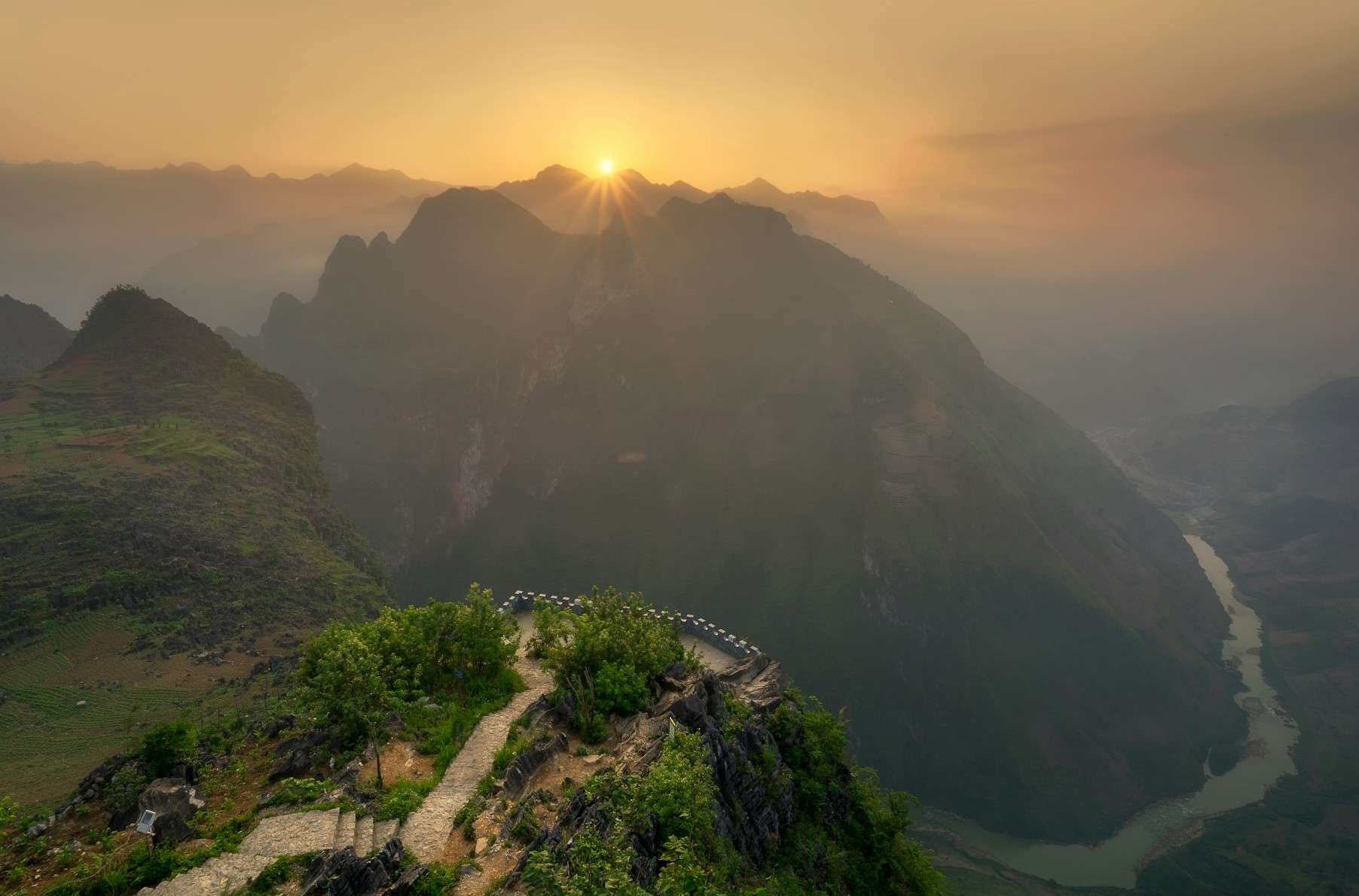
About Ha Giang
Ha Giang (also called Ha Giang Loop by international travelers) is a province located in the northernmost part of Vietnam – 300 kilometers (186 miles) from Hanoi.
Ha Giang is famous for its breathtaking landscapes, including the UNESCO-designated Dong Van Karst Plateau Geopark, lush mountains, steep hills, and winding roads, making it a popular destination for adventure travel and cultural exploration. Ha Giang is also renowned for its rich cultural diversity, with several ethnic minority groups, including the H’mong, Tay, and Dao, living in the area.
See Ha Giang on maps:

Best time to visit Ha Giang
The best time to visit Ha Giang, Vietnam, is typically during two main seasons: spring and autumn.
Spring (March to May): This is a wonderful time to visit as the weather is generally mild and pleasant. Spring in Ha Giang is known for its blooming flowers, including peach blossoms and plum blossoms, which cover the hills in vibrant colors. This season also marks the beginning of the Khau Vai Love Market festival, an annual event that attracts people from various ethnic groups.
Autumn (September to November): Autumn is arguably the most stunning season in Ha Giang, when the weather is cool and comfortable. This period is famous for the terraced rice fields turning golden-yellow as they ripen, creating breathtaking landscapes. Late October and early November are particularly recommended for photographers and nature enthusiasts looking to capture the beauty of the harvest season.
While these are the optimal times for scenic beauty and cultural experiences, Ha Giang can be visited year-round. Each season offers its own unique appeal:
Summer (June to August) can be quite hot and rainy, which may lead to landslides in the mountainous areas. However, the rain also brings lush, green landscapes.
Winter (December to February) is cold, especially in the higher altitudes, with occasional frost and snow. While it’s less ideal for trekking, the winter season offers a different perspective on the region’s beauty and the challenge of colder weather.
Choosing the best time to visit depends on what you want to see and experience. The spring and autumn seasons offer the most comfortable weather conditions and the most vibrant landscapes.

Where to stay in Ha Giang
Meo vac valley.
Meo Vac Valley is a wonderful place to spend your time. It’s located in a scenic valley overlooking the mountains. The room was clean, warm, and spacious and the beds are super comfortable for relaxing.
- Address: QL4C, Pả Vi, Mèo Vạc, Hà Giang, Vietnam
- Contact: 0941260789
- Amenities: free wifi, breakfast, parking, restaurant

Mong Lodge is a gem place in the stunning remote areas of Ha Giang. The host is very friendly and accommodating. Linens and towels are fresh, with hot water. Dinner and breakfast are available.
- Address: Pả Vi, Mèo Vạc, Hà Giang, Vietnam
- Contact: 0857899333
- Price: 400,000 – 500,000 VND
- Amenities: free wifi, breakfast, dinner parking, restaurant

Hoang Su Phi Lodge
Hoang Su Phi Lodge has fabulous rooms overlooking a flooded rice paddy field with regular water buffalo visitors. Loud frogs croaking at night to send you to sleep. Lovely friendly staff, great food, cold beer in the fridge. Lovely peaceful walks around the surrounding area.
- Address: Nam Hong Village, Hoàng Su Phì District, Ha Giang, Vietnam
- Contact: 0866196878
- Price: 950,000 – 2,000,000 VND
- Amenities: free wifi, breakfast, dinner parking, restaurant, airport transfer, laundry

H'Mong Village Resort
H’Mong Village Resort offers unique architecture inspired by traditional Hmong culture, set in a serene environment over 20 hectares, with views of the Mien River and surrounding mountains. The resort features bungalows designed to mimic the shape of a traditional Hmong back carrier, providing a culturally immersive experience.
- Address: Khu Tráng Kìm, Quản Bạ, Hà Giang, Vietnam
- Contact: 02193836868
- Price: 1,650,000 – 1,800,000 VND
- Amenities: free wifi, breakfast, dinner parking, restaurant, airport transfer, laundry, spa, swimming pool

P'apiu Resort
P’apiu Resort in Ha Giang is highly praised, with a perfect score for its unique accommodations and exceptional services. It offers villas with stunning mountain views, a garden, a terrace, sauna, and hot tub. The on-site restaurant serves both American and Vietnamese cuisine, catering to vegetarian preferences as well.
- Address: Km18, Bắc Mê, Hà Giang, Vietnam
- Contact: 02193841999
- Amenities: free wifi, breakfast, dinner parking, restaurant, airport transfer, laundry, spa, swimming pool, massage,..

Best things to do in Ha Giang
Milestone zero.
“Milestone Zero” or Milestone KM 0 in Ha Giang is a symbolic starting point for travelers embarking on their journey through the stunning landscapes of Ha Giang province. Located in the city center, it’s more than just a geographical marker; it’s a testament to the adventurous spirit of the region. This spot is highly attractive to travelers for both its cultural significance and as a launching pad for exploring the diverse, scenic routes of Ha Giang. It’s a place where journeys begin, filled with the promise of natural beauty, rich history, and the enthralling challenge of the roads ahead.
For more information, read this article:
Milestone Zero Ha Giang – The start of all Ha Giang Loop tours

Bac Sum Pass
The Bac Sum Pass is a mountainous stretch on National Highway 4C, extending from Minh Tan commune (Vinh Xuyen district, Ha Giang) to Quyet Tien commune (Quan Ba district, Ha Giang). This is Ha Giang province’s longest pass, spanning 7 kilometers with an altitude exceeding 450 meters.

Ma Pi Leng Pass
Ma Pi Leng Pass is widely regarded as one of the most beautiful and dramatic mountain passes in the country. It stretches over approximately 20 kilometers between the towns of Dong Van and Meo Vac, traversing the Dong Van Karst Plateau. The pass is situated at an elevation of about 1,500 to 2,000 meters above sea level, offering breathtaking views of steep hills, deep valleys, and the Nho Que River below.

Tham Ma Pass
Tham Ma Pass is one of the most impressive mountain passes on the Ha Giang loop, particularly renowned for its steep inclines and breathtaking landscapes. The pass’s unique name, which translates to “Horse’s Nose Pass,” adds to its allure, inviting adventurers to experience its distinct and memorable path through Ha Giang’s captivating highlands.

Although Tham Ma Slope and Ma Pi Leng Pass are familiar names to many tourists, the “ M Pass ” is not as widely recognized. Traveling from Meo Vac towards Yen Minh and returning to Ha Giang city, travelers will discover a road that beautifully winds into the shape of an “M,” a distinctive feature of the Bac Sum Pass.

Quan Ba Heaven Gate
Quan Ba Heaven Gate , a prominent landmark in Ha Giang, stands over 1500 meters above sea level and is about 43 km from Ha Giang City. Positioned between two mountain peaks, it allows for a road to pass through, marking the beginning of the Happiness Road and serving as Ha Giang’s first gateway. From atop the mountain, visitors can enjoy a panoramic view of the Northwestern forested landscape.

Tam Son Town
Tam Son Town serves as the administrative center for Quan Ba district and is the gateway to the Dong Van Karst Plateau Global Geopark. This town is traversed by National Highway 4C and is notably home to the enchanting Twin Fairy Mountains, a natural marvel that stands out in the region.

Lonely tree Ha Giang
The Ha Giang Lonely Tree , a towering hsienmu wood tree approximately 40 meters tall with a trunk wide enough to be embraced by five people and a lush canopy, is situated beside National Highway 4C through Can Ty commune in Quan Ba district, Ha Giang province. This road, flanked by rocky mountains on one side and deep valleys on the other, has made the tree a must-visit photo spot, widely shared online, turning it into an iconic stop for visitors to Ha Giang.

Nho Que river
Gently flowing at the base of Ma Pi Leng Pass, the Nho Que River is a well-known spot beloved by Ha Giang travelers. Throughout the year, its waters display a stunning emerald green hue, shining amidst the cool grey of the surrounding mountain bases. This tranquil river, with its deep green patches, complements the majestic scenery of ancient forests, mountain rocks, and clouds, making it a picturesque escape within Ha Giang’s grand natural landscape.
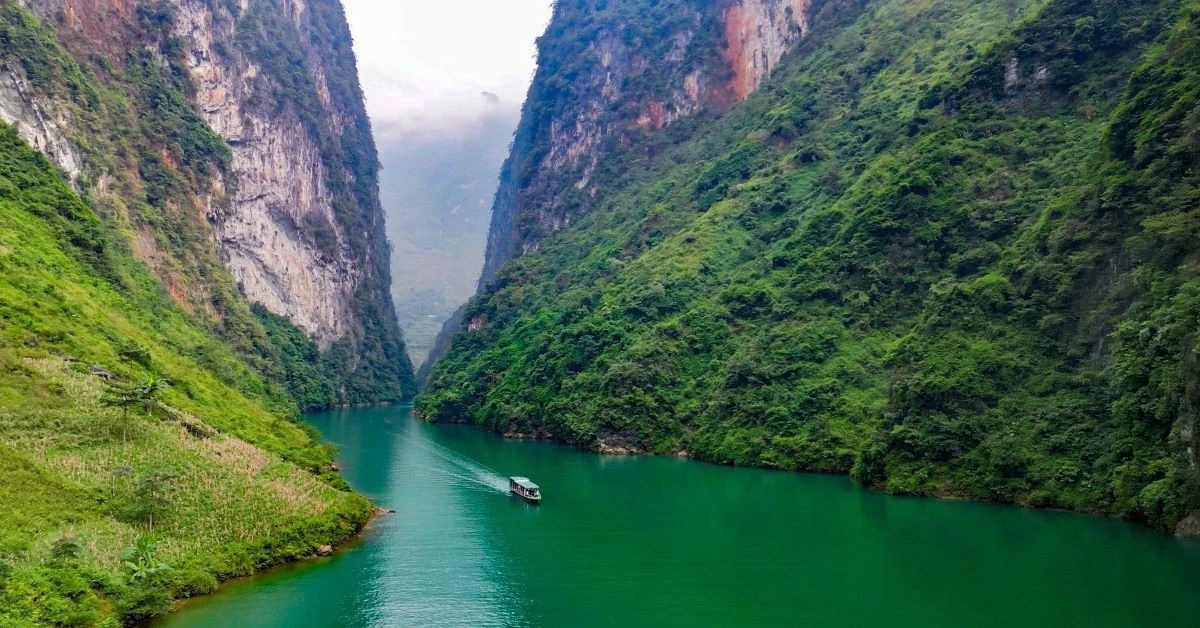
Pa Vi Village
Around 160km from the heart of Ha Giang city, Pa Vi H’Mong Village stands as a unique tourist destination that draws numerous visitors. Covering an area of about 46,000 square meters, it comprises three main areas with nearly 30 households. The village features a cultural house, an exhibition hall, and a recreational area used for showcasing the local people’s cultural and artistic expressions, promoting the beauty of the local community.

Nam Dam Village
Nam Dam Village , renowned for its stunning natural landscapes and well-preserved traditional values, offers visitors an immersive experience in its distinctive stilt houses and the local Dao ethnic group’s simple, friendly lifestyle. This commitment to tradition and tourism development has positioned Nam Dam as a sustainable destination. Recognized for its efforts, Nam Dam has been honored with an ASEAN award for its accommodation model that integrates the introduction, experience, and preservation of heritage within the Dong Van Karst Plateau Geopark.

Tha Village
Tha Village in Ha Giang welcomes visitors with its serene and unpretentious beauty, characterized by gentle terraced fields, simple stilt houses, and lush palm hills. While sharing similarities with other villages in Ha Giang, Tha’s identity as a Tay community adds unique cultural nuances to its charm.

Lo Lo Chai Village
Located at the base of the famous Dragon Mountain in Lung Cu commune, Dong Van district, Ha Giang province, Lo Lo Chai cultural village is just about 1km away from the Lung Cu Flag Tower. Home to the Lo Lo and Hmong people for generations, Lo Lo Chai has emerged as a prime tourist destination in the Dong Van Karst Plateau and Ha Giang at large, attracting visitors with its rich culture and history.

Dong Van flea market
The Dong Van flea market convenes every Sunday morning, offering a once-a-week opportunity to witness the transformation of the usually quiet old quarter into a bustling, vibrant festival. This market day brings together a kaleidoscope of colorful attire worn by ethnic groups like the Dao, Hmong, Tay, Nung, Giay, and Lo Lo, infusing the air with a sense of celebration and community.

Lung Cu flag point
The Lung Cu Flag Point , a national flagpole, is perched atop Lung Cu peak, also known as Dragon Mountain, at an elevation of 1470 meters above sea level in Lung Cu commune, Dong Van district. Visiting this historically sacred site is a must-do for anyone exploring Ha Giang, as it symbolizes the spirit and unity of the Vietnamese people.

Pao's House
Pao’s House , located in Sung La commune, Dong Van district, became a notable tourist attraction after being featured in a film. Visitors traveling to Ha Giang often make it a point to visit this location, which is about 20 kilometers from Dong Van. Reminiscent of an oil painting, Pao’s house evokes nostalgia for bygone eras, offering a unique glimpse into decades past and scenes typically found only in movies, with its traditional yin-yang tiled roofs and closely built structures.

H'Mong King's Palace
The H’Mong King’s Palace , also known as the Vuong family mansion, is a grand architectural work covering nearly 3,000 square meters. Located in the Sa Phin valley of Dong Van, Ha Giang, this majestic mansion was built in the 20th century. Its ancient beauty and strong ethnic identity have made it a popular destination, drawing numerous tourists annually.

Sky path Ha Giang
Perched on the Dong Van Karst Plateau, known for its raw and poetic beauty reminiscent of a “gray paradise” amidst the mountains, the Sky Path Ha Giang is a miraculous earth formation standing approximately 1,700 meters above sea level. The majestic landscape of the Sky Path, as we see it today, has been primarily shaped by the geological faulting of the Nho Que River over 30 million years ago.

Transportations
To ha giang.
To get to Ha Giang, travelers typically start from Hanoi, which is the nearest major city with various transport options available. You can take a sleeping bus or limousine car , which is the most common method, with several companies offering daily services to Ha Giang. The journey takes approximately 6-8 hours. Alternatively, for a more adventurous route, you can rent a motorbike in Hanoi and drive to Ha Giang, enjoying the scenic route at your own pace. This option offers flexibility and the opportunity to explore the stunning landscapes along the way.
Around Ha Giang
The best way to explore Ha Giang is by motorbike , offering the flexibility to navigate the winding roads of the Ha Giang Loop at your own pace, with opportunities for impromptu stops to admire the scenery. This method is highly popular among adventurers seeking to fully experience the region’s dramatic landscapes and cultural richness up close.
Itineraries and tour
The best itineraries to explore Ha Giang are 3 days 2 nights (3D2N) or 2 days 1 night (2D1N). While 3D2N is best for exploring almost all things to do in Ha Giang , 2D1N is the optimized itinerary for those who don’t have much time.
For detailed itineraries and the best Ha Giang Loop tour , visit this:

Ha Giang Loop Tour From Hanoi (2D1N/ 3D2N)
Locations available: HCMC, Hanoi, Da Nang, Hoi An, Nha Trang, Phu Quoc, Da Lat,…
Recent Posts

Gay bars in Da Nang: Low quantity but high quality

Life as LGBT+ in Vietnam: Pride & Struggles

Top 5 best Banh Mi in Saigon
Enter the e-mail address associated with the account. We'll e-mail a link to reset your password.
Ha Giang, the northernmost province of Vietnam, is an extraordinary destination famed for its rugged landscapes and rich ethnic diversity. This remote and breathtaking region offers travelers an unfiltered experience of Vietnam’s natural grandeur and cultural richness, from towering limestone mountains and winding roads to the vibrant traditions of its local ethnic communities.
“A Rugged Adventure Through Lush Landscapes, Ethnic Minority Tribes, and Heaven’s Gate Awaits!”
Get free trip planning advice from vietnam is awesome, experience ha giang, attractions.
Ha Giang is famous for its dramatic landscapes and cultural experiences. The Dong Van Karst Plateau Geopark, a UNESCO World Heritage site, showcases unique geological formations. The Ma Pi Leng Pass offers some of Vietnam’s most spectacular mountain views. The region is also a mosaic of diverse ethnic cultures, evident in its colorful traditional markets and local festivals.
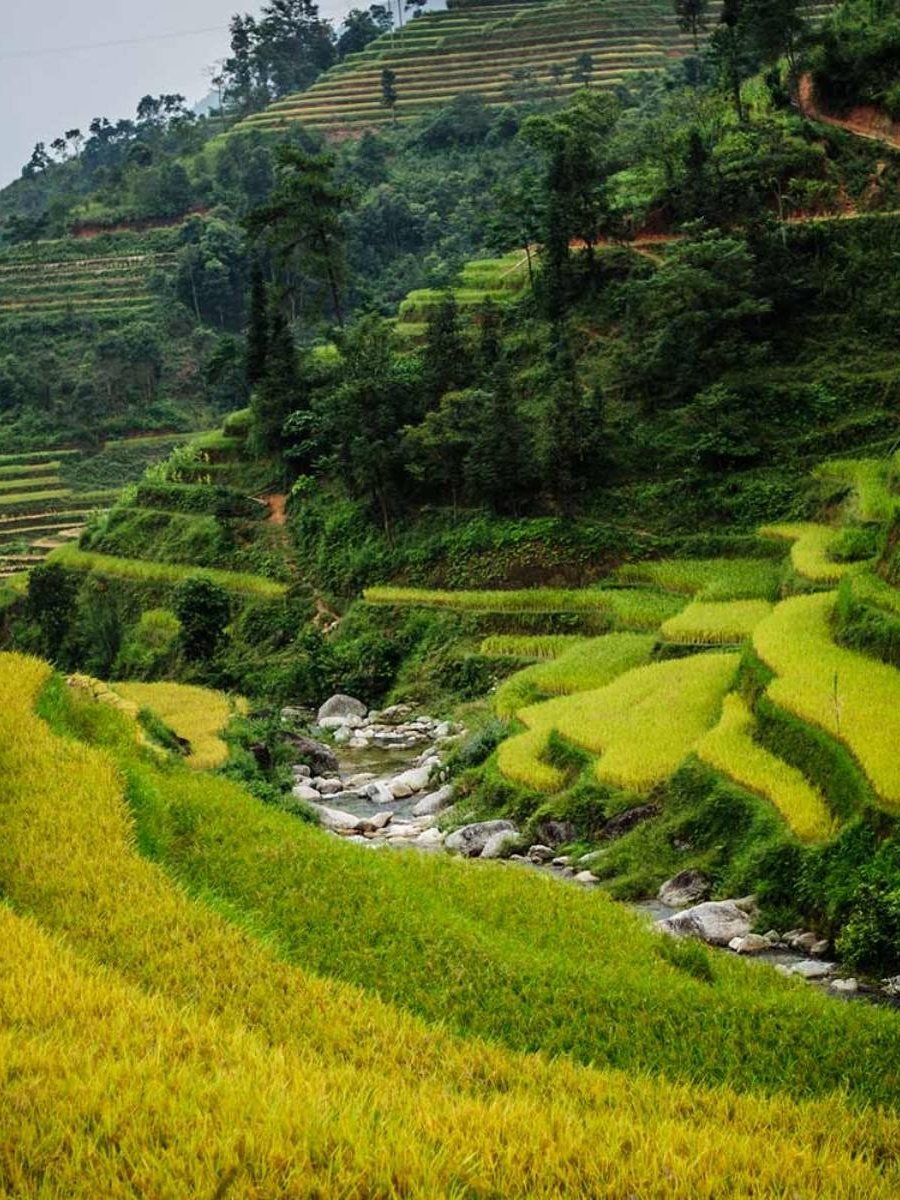
Hoang Su Phi

Nho Que River
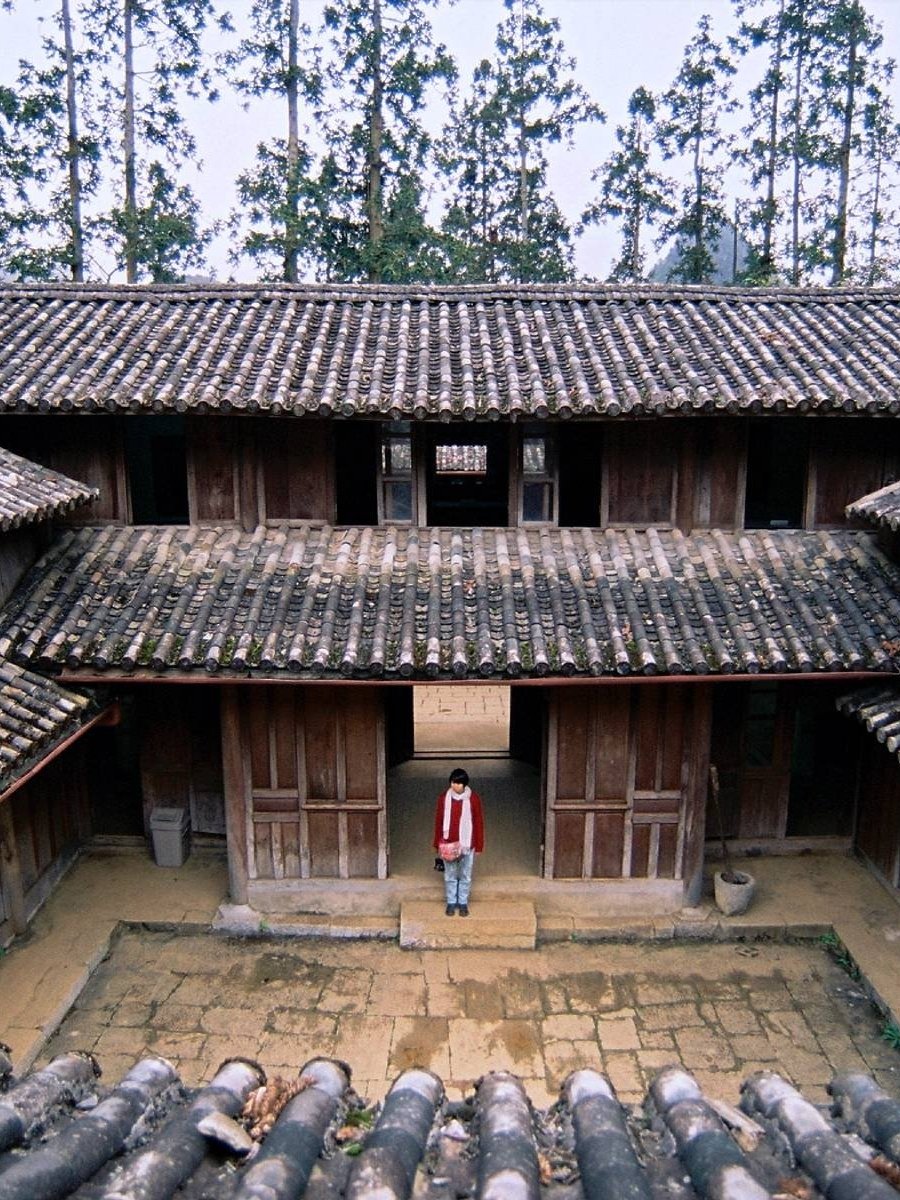
Dinh Vua Meo
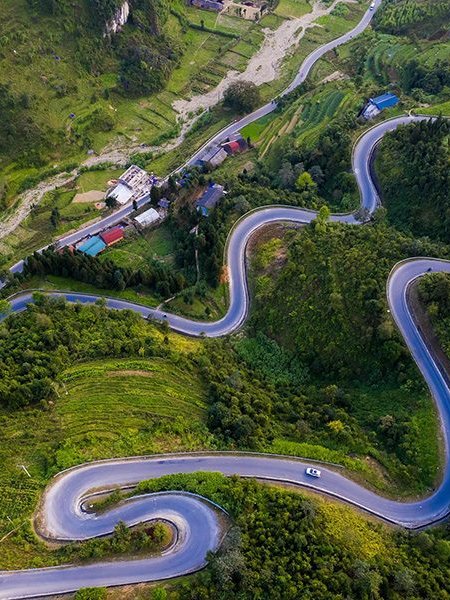
Ma Pi Leng Pass
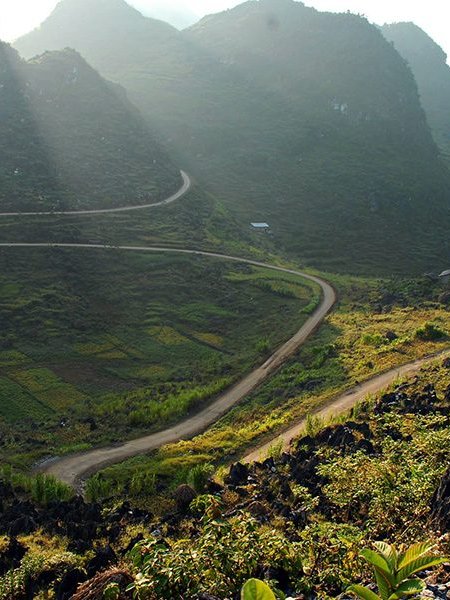
Quan Ba Pass
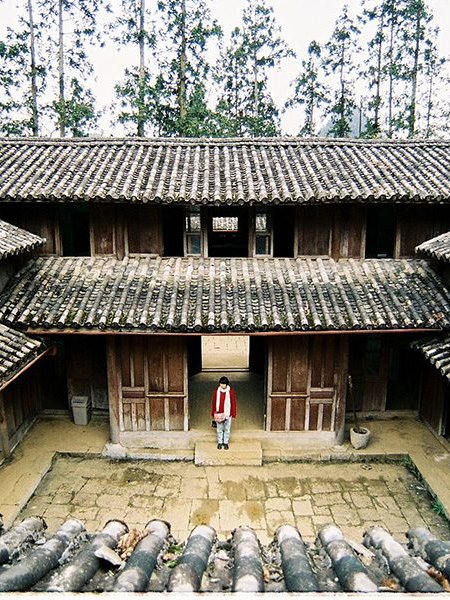
Vuong Palace
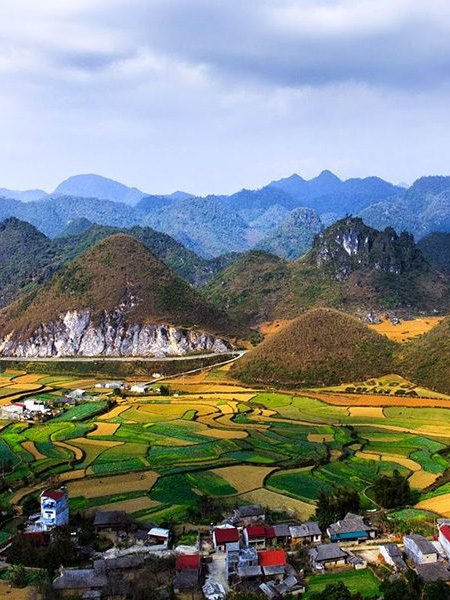
Dong Van Karst Plateau Geopark
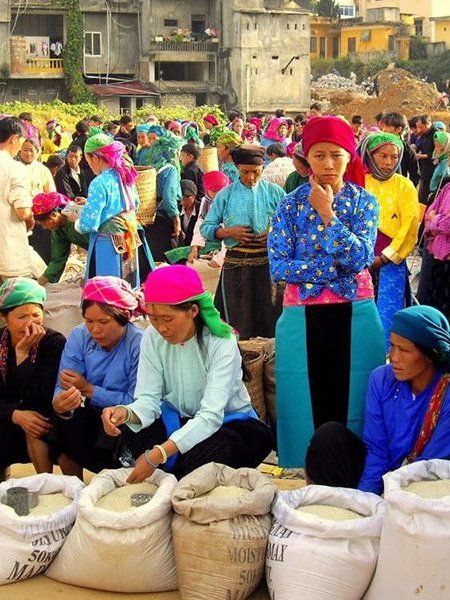
Dong Van Market
Ha Giang’s cuisine is as diverse as its culture. Our carefully curated list includes everything from local eateries serving traditional dishes unique to Ha Giang’s ethnic groups to select restaurants offering a fusion of local and international flavors.

Bong Retaurant
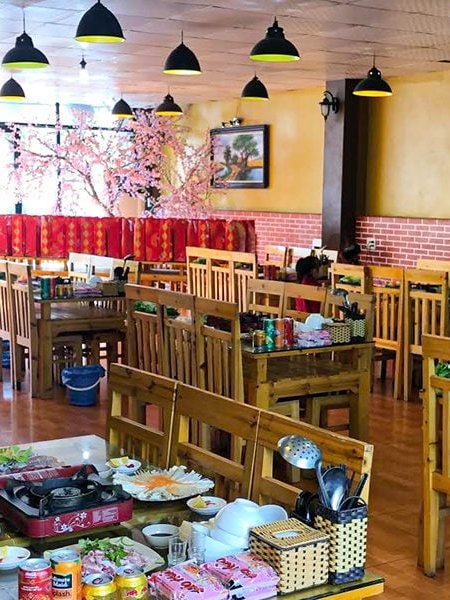
Com Nieu An Nhien

Golden BBQ Restaurant

MR.Hung Bar Restaurant
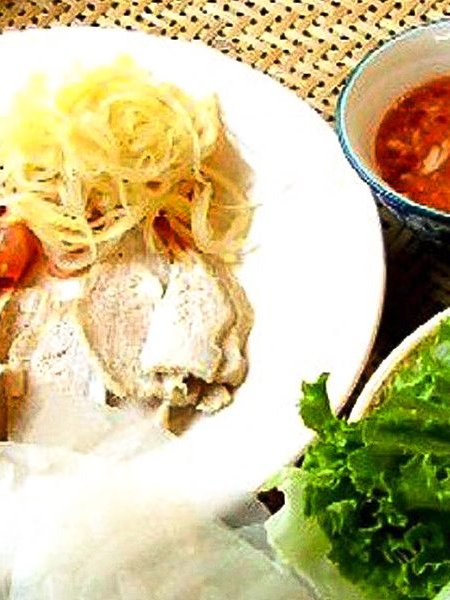
Nha Hang Com Vn 123 Quoc Tuan
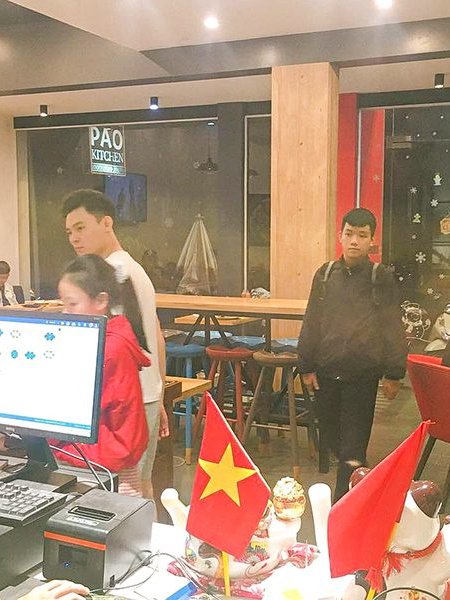
Pao Kitchen – Chicken, Pizza, Spaghetti

Roma Italian Restaurant
Travel inspiration & local legends.
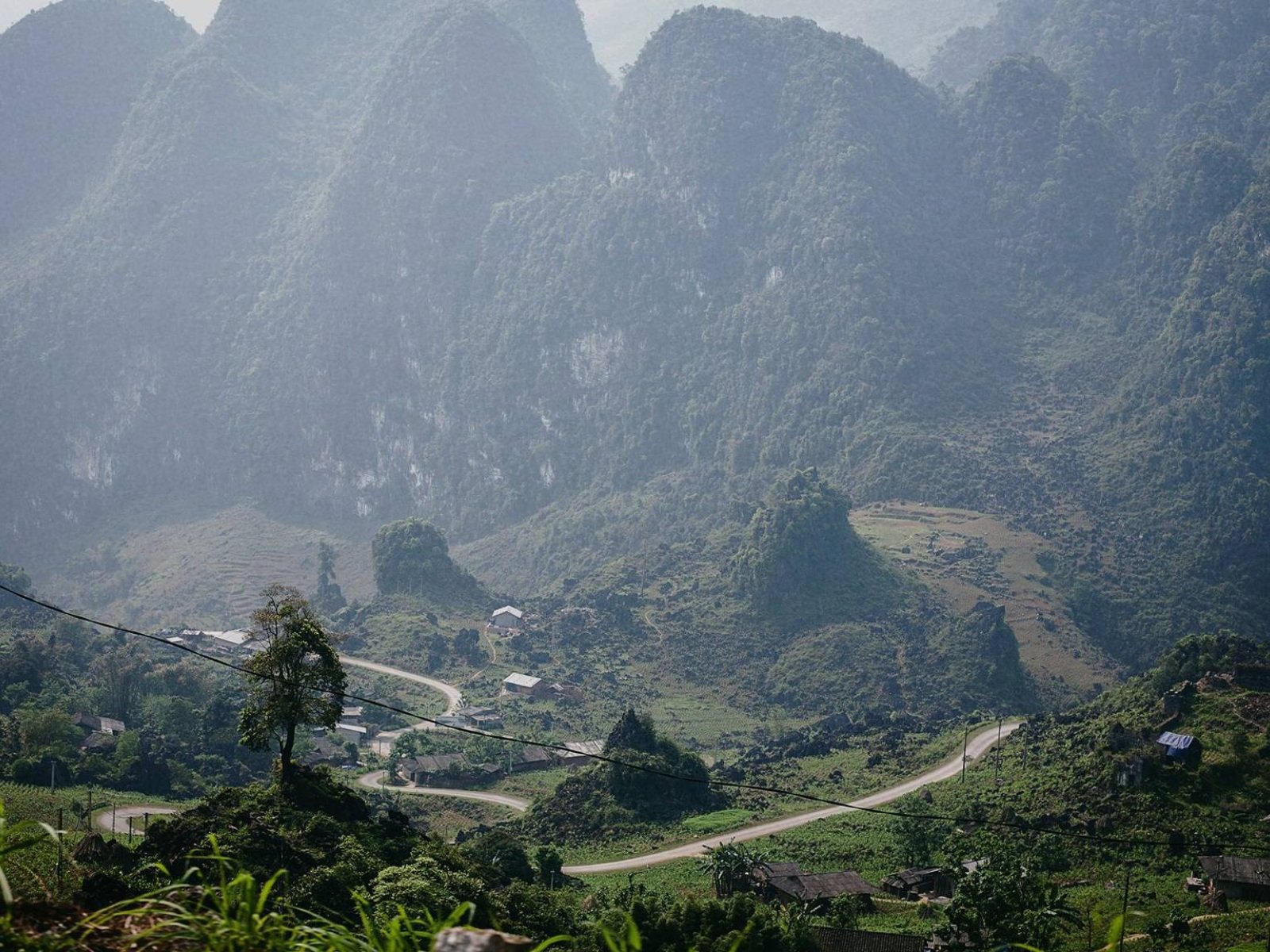

Adventure In The Ha Giang Loop: Your Comprehensive Guide To Routes, Tips, And Hidden Treasures
November 3, 2023
Ha Giang Handbook: Essential Travel Tips
When is the best time to visit ha giang.
The ideal times to visit Ha Giang are during spring (March to May) and autumn (September to November). These months feature less rainfall, clearer skies, and moderate temperatures, perfect for exploring Ha Giang’s breathtaking landscapes. Autumn enchants with its golden rice terraces and the Buckwheat Flower Festival’s vivid fields, while spring is known for its mild climate and blooming flowers.
Transportation Tips
A. getting to vietnam.
Flying is the best and most convenient option when traveling to Vietnam, with three international airports in key locations. Noi Bai Airport (Hanoi International Airport) is the best choice for those starting their adventure in the North. Overland bus travel from neighboring countries like Cambodia, Laos, and Thailand offers an adventurous alternative for Southeast Asian travelers.
B. How to get to Ha Giang
To get to Ha Giang, you have a few options depending on where you’re starting from:
- Private Transfer: For peace of mind you can book a private transfer with Vietnam Is Awesome.
- Bus: If you’re coming from Noi Bai Airport or Hanoi Old Quarter, you can take a luxury bus starting at about $16 per person or a taxi for around $250. The bus takes 5 hours, while the cab offers more privacy and convenience, dropping you off directly at your hotel.
- Rail: The closest railway station is in Lao Cai (about 200kms away/ near Sapa).
C. How to get around in Ha Giang
Once you’re in Ha Giang, your transportation options are limited. Walking is possible, but it’s a huge region with hilly terrain. Biking is a great option, with many hotels and shops offering rentals for both mountain and road bikes. However, the terrain can be treacherous, so renting a motorbike with an experienced driver is recommended for most visitors. Prices for hiring drivers vary, so it’s best to inquire with locals or agencies in Ha Giang or try Easy Riders.
Before You Go
- Visa: Check the visa requirements for your nationality. Many travelers can get a visa on arrival or an e-visa. Get the Ultimate Guide for getting a Vietnam Visa [here].
- Timezone: Vietnam is in the Indochina Time Zone (ICT), UTC+7.
- Voltage: The standard voltage is 220V, and the plugs are usually Type A (two flat pins) or Type C (two round pins).
- Internet: Most hotels, cafes, and even restaurants in Ha Giang offer free Wi-Fi; Wi-Fi plans are so cheap in Vietnam that almost all businesses have one. But it’s easy, inexpensive, and well worth buying a local SIM card with a data package at the Airport upon arrival. Mobile data is not as consistent in Ha Giang as in most parts of Vietnam. In fact, you may not get any signals at all in the remotest areas of the Ha Giang Loop.
- SIM Cards: You can easily purchase SIM cards at the airport or local stores for data and calls. Note that you’ll need to provide your passport to get a SIM. Viettel, Mobifone, and VinaPhone are the best mobile networks for Hanoi and most parts of Vietnam.
- Currency: Vietnam uses the Vietnamese Dong (VND). VND only comes in bills (no coins), and 1 USD equals about 24,000 VND (commonly abbreviated as 24k). Some shops catering to tourists may accept USD, but most only take VND.
- Credit Cards: Visa and MasterCard are commonly accepted, but smaller businesses usually only take cash.
- ATMs: There are very few ATMs in Ha Giang. Downtown Ha Giang’s main city has a handful, but we highly recommend you keep plenty of cash on hand and store it in a safe place.
- Tipping: Vietnam is not a tipping culture, so a tip is not expected. A tip is a good way to bring a smile to someone’s face, though. Note that cab drivers and tour guides often rely on some tipping, so it’s a good idea to tip them.
Understanding Culture & Customs In Ha Giang
Ha Giang is home to many minority tribes, making it a melting pot in Vietnam. Remember to respect local traditions, ask for permission before taking photos, dress modestly, be patient with communication, be culturally sensitive, and avoid giving handouts to children due to significant poverty levels, in efforts to keep them in free schooling.
Common questions about Ha Giang
A few good options for accommodation in Ha Giang City are Du Gia Stream Lodge and Ha Giang Historic House. If you’re traveling the famous Ha Giang Loop, a few great choices are H’Mong Sister House, Du Gia Homestay, Hoang Minh Hotel, Tam Giac Mach Hotel, and Pao’s Sapa Leisure Hotel. Keep in mind that Ha Giang is more rural than most parts of Vietnam and has fewer good-quality accommodations than some areas.
Some fantastic Vietnamese food options in Ha Giang are Bong Restaurant , Com Nieu An Nhien , Golden BBQ , Mr Hung Bar Restaurant , and Nha Hang Com VN 123 Quoc Tuan . If you’re in the mood for Western food, some good options are Pao Kitchen or Roma Italian Restaurant .
Ha Giang is best known for its rustic natural beauty, perhaps best demonstrated by its misty karst formations and lush green valleys full of rice paddies. It’s also known for the Ha Giang Loop, famous worldwide as a premier mountain biking and motorbiking route. The many ethnic minorities in Northern Vietnam add to the area’s color and beauty.
Even though Ha Giang is a remote location, there are a ton of beautiful natural and historical landmarks to explore. Read more about the famous Ha Giang Loop, Ma Pi Leng Pass, the local minority villages, and more in our listicle of the top 11 things to do in Ha Giang . You can also venture to one of the awe-inspiring natural parks in the area for even more natural beauty.
The most affordable months to visit Ha Giang are late November through February. These months are often very cold, resulting in less foreign and domestic tourism and lower prices for many tourist services. The area can be beautiful during that time, though, because mists creep over the mountains and give them an added air of mystique.
The best ways to get around once you’re in Ha Giang are by bicycle, motorbike, or foot for shorter distances. You can also hire a motorbike or car with a driver to take you around. Unfortunately, public transportation in Ha Giang is not as consistent as in most of Vietnam.
September-November is often considered the ideal time to visit Ha Giang. The weather is cooler and clearer, making it perfect for trekking and exploring the region’s natural beauty. The highlight is the rice harvest season in late September and early October when the rice terraces turn a beautiful golden-yellow.
If you only want to travel the Ha Giang Loop to take in the region’s most iconic sights of natural beauty, 2-3 days is enough. If you also want to explore on your own, 4-5 days is better. If you want to do all that, plus connect with the local culture of Ha Giang, dedicate at least a week to the area.
© 2024 Vietnam Is Awesome. All rights reserved.
Northern Vietnam
Central vietnam, southern vietnam.
You are using an outdated browser. Please upgrade your browser to improve your experience.
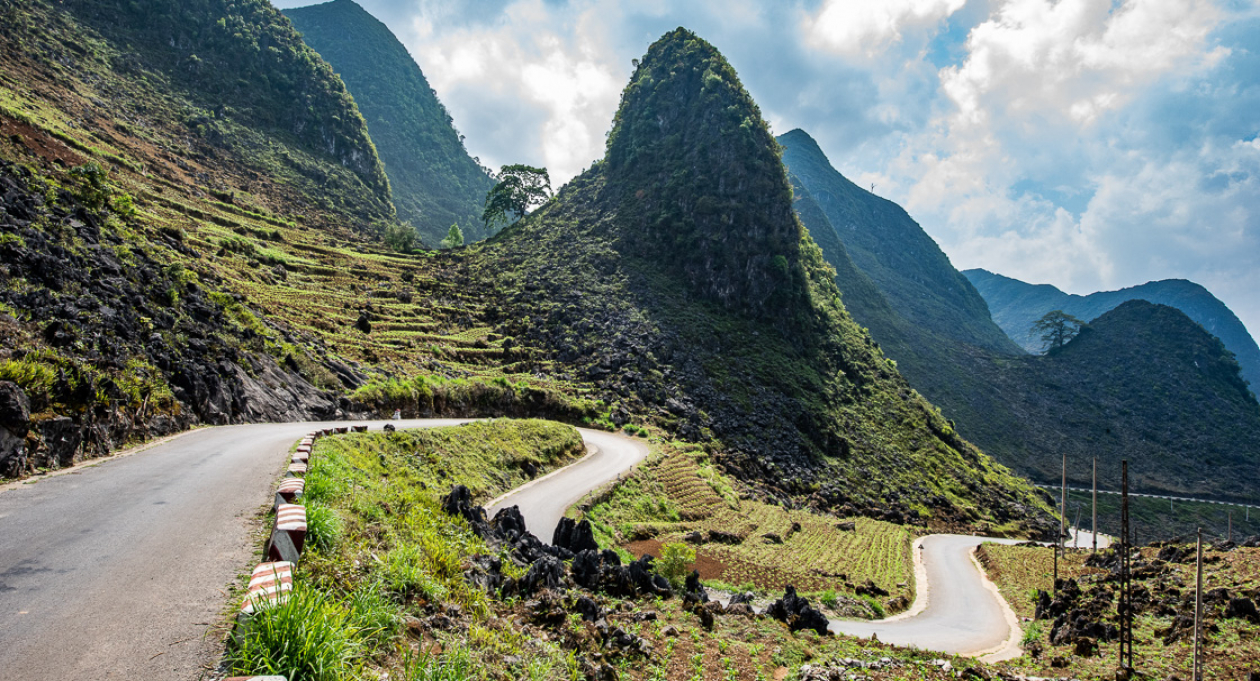
- The Ha Giang loop: a four-day road trip
The Ha Giang Loop, an adventurer's paradise. All photos by Jason Zullo
High in the north of Vietnam is a place where the road winds through jaw-dropping canyons and breathtaking mountain passes. The Ha Giang loop is a dream come true for adventures travellers craving the open road. Pack your gear, charge your batteries, and prepare for an adventure.
This four-day route follows the ql4c northeast from hà giang to bảo lâm, and the ql34 southwest from bảo lâm back to hà giang., day 1: ha giang city to yen minh.
Get an early breakfast in Hà Giang city before hitting the road. As you head north on the QL4C, the landscape quickly transforms into a limestone mountain range, covered with lush jungle. Soon you’ll reach the Dong Van Karst Plateau, a UNESCO Global Geopark. The highlight of this section of the trip is Heaven’s Gate Pass, where you’ll get your first taste of exhilarating views along with challenging, tight curves.
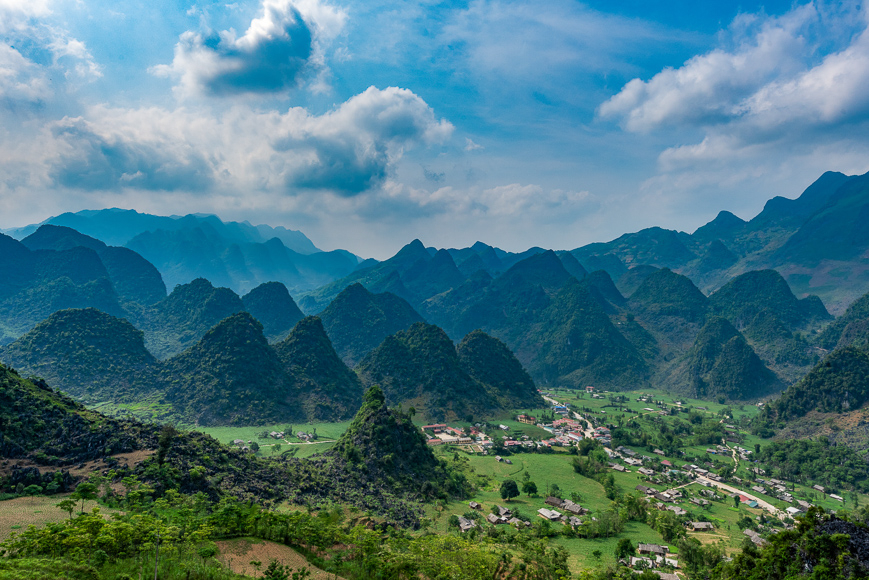
Cruising down from Heaven’s Gate Pass, you’ll arrive in Tam Sơn -- a town surrounded by jutting, forested hills -- just in time for lunch. Here the restaurants and road stalls serve classic Northern Vietnamese fare. And like anywhere else in the country, a great Vietnamese coffee is not hard to find.
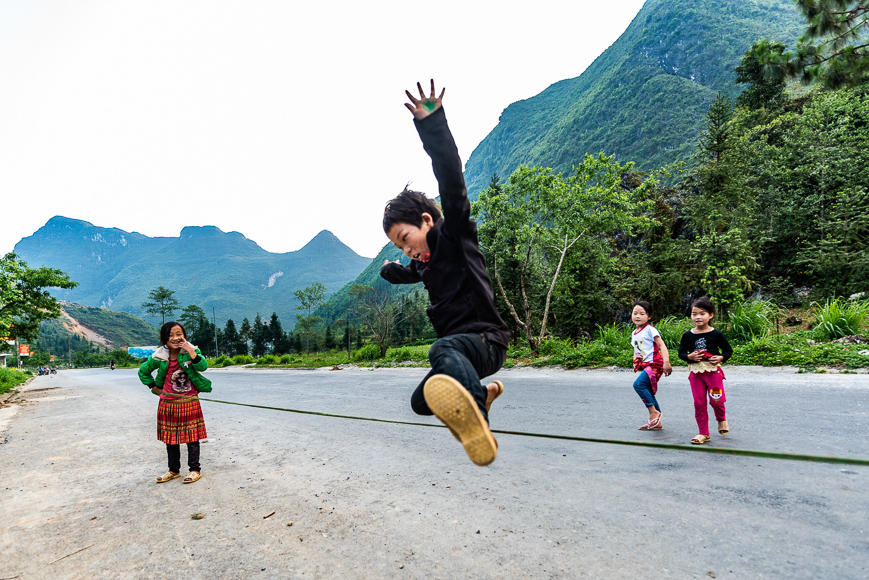
Once you’re refuelled, continue on the QL4C towards Yên Minh. The road follows the beautiful Mien River before climbing through a tall canyon. Cruise though karst plateaus and mountain passes before arriving at Yên Minh, where you can settle in at a local hotel for the evening.
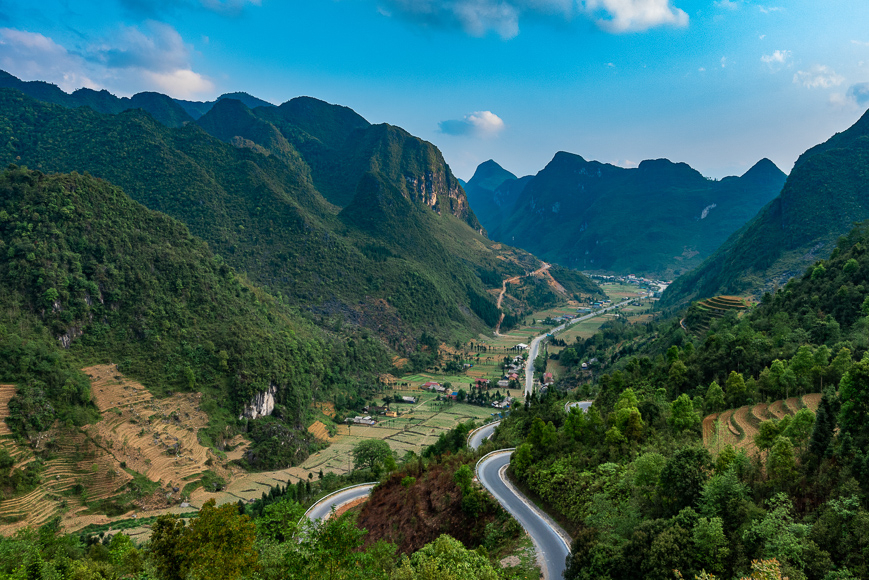
TIP: It’s best to reserve your hotel or homestay ahead of time when staying in smaller towns: the best accommodations fill up quickly, especially during high season.
Day 2: The Vietnamese Border
Enjoy a steaming bowl of pho for breakfast before you set off for Dong Van, taking the QL4C northeast. The steep road quickly rises above the tree line, revealing an otherworldly landscape of eroded limestone karsts with incredible views at every turn. Dốc Chín Khoanh (Nine Turn Pass), is a great place to stop and admire the sets of curved roads descending into the valley below. Stop in the Sà Phìn area for food and fuel.
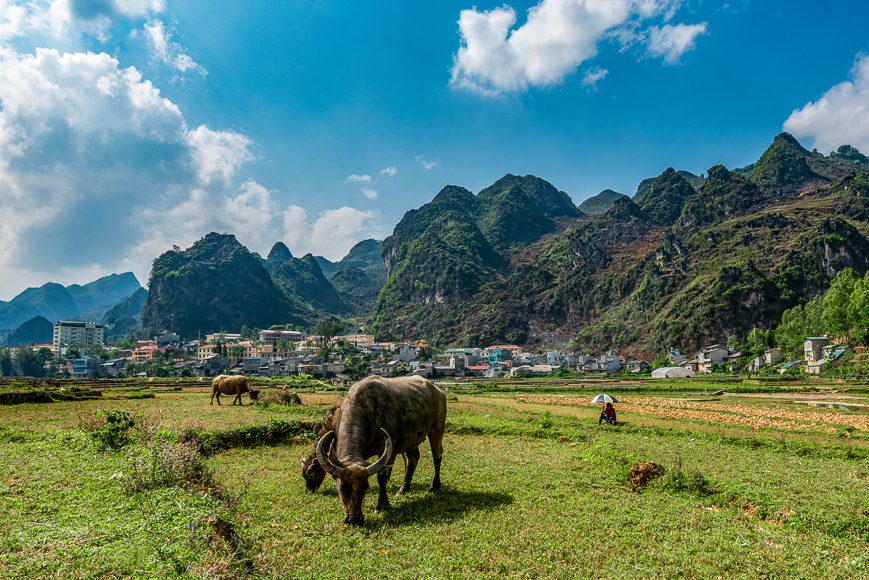
A three-hour detour takes you to the Lũng Cú Flag Tower. The 360-degree views over the border into China are worth the effort. Back on the QL4C, you’ll have no shortage of stunning views on the way to Đồng Văn, where you’ll stay. Set aside time to visit a local market, either at night or in the early morning, and see the colourful ethnic minorities going about their business.
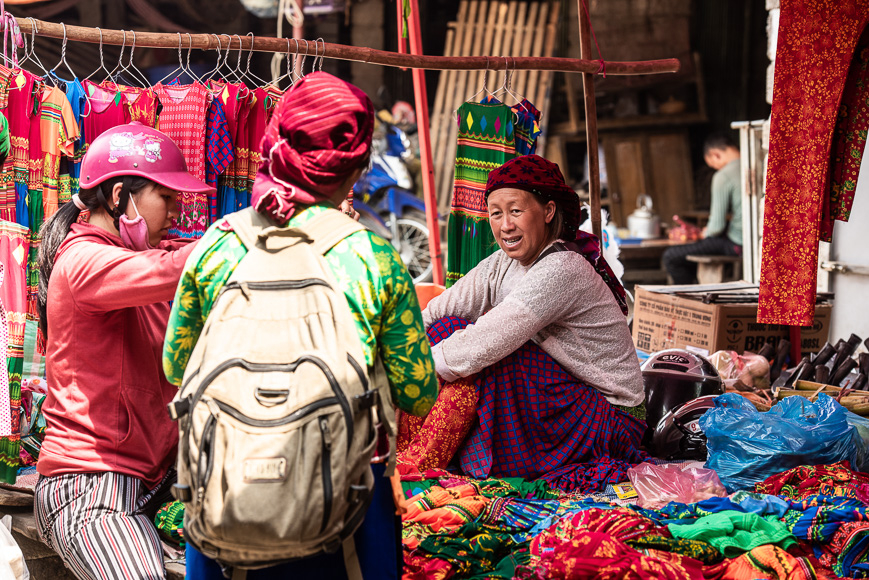
TIP: Be sure to check with your host in Dong Van about dates and times for the local markets. It’s a cultural experience you won’t want to miss.
Day 3: Đồng Văn and Mã Pí Lèng Passes
Today you’ll encounter what is arguably the most mind-blowing stretch of road in all of Vietnam. From Đồng Văn all the way to Mã Pí Lèng Pass, the valley floor drops far below as you wind your way through massive peaks and canyons. The only problem may be the number of stops you feel compelled to make, as every turn is full of picture-perfect views.
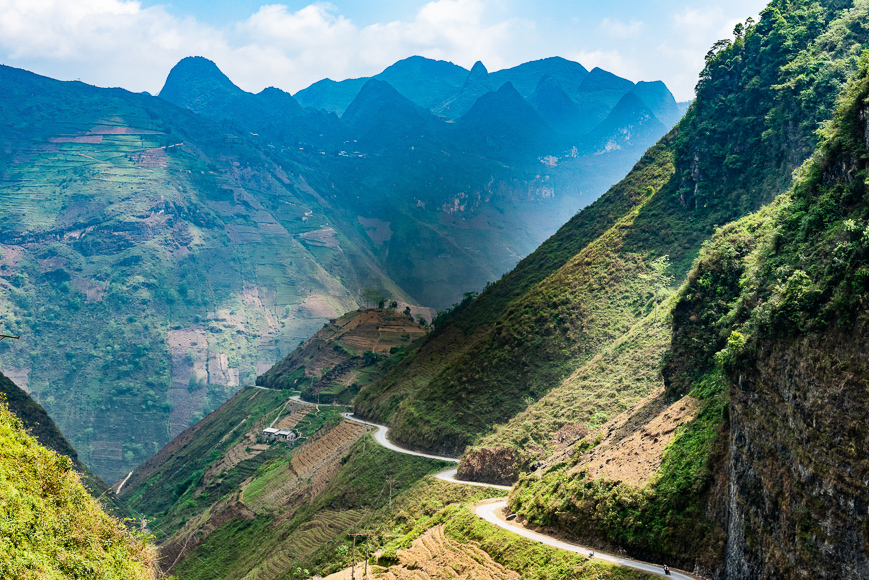
Mèo Vạc is only 24 kilometres from Đồng Văn, but it will take most of your morning to reach it, if you stop to appreciate the panoramic views along the way. Once there, enjoy this quaint town, which has colourful character and more than a few options for lunch.
For a quick detour, take a left off of QL4C at the bottom of Mã Pí Lèng Pass onto side road 193A. It’s a short but fun ride offering a closer look at the winding Nho Quế River below.
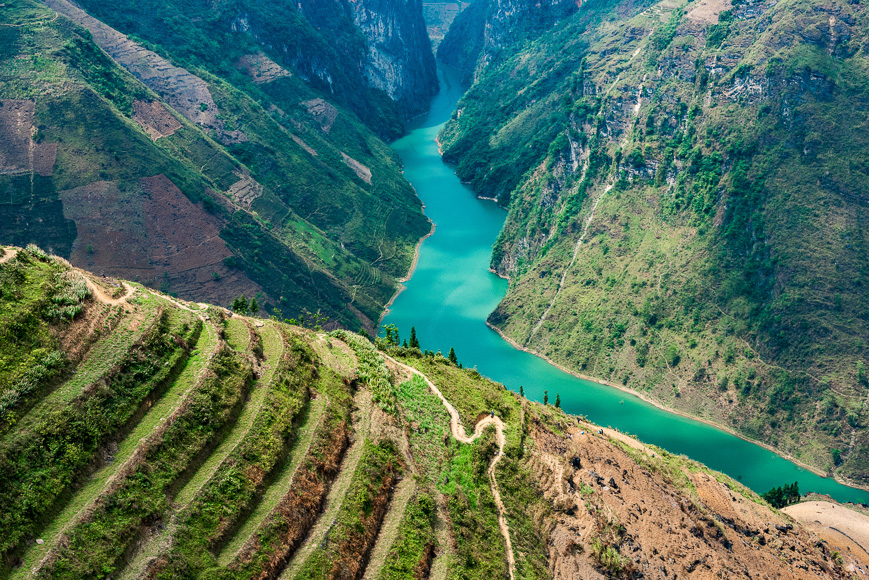
You’ll finish the day in Bảo Lâm, a small hamlet with wonderfully warm locals. Spend a few hours relaxing in this remote setting, readying yourself for the drive back to Hà Giang in the morning.
Day 4: Back to Hà Giang City
Start the last day of your trip with a simple breakfast and stock up on provisions to make the journey back to Ha Giang. From Bảo Lâm, take QL34 southwest towards Hà Giang. The road follows the Gâm River most of the time, making for an enjoyable drive along the valley floor. There will still be plenty of twists and a few passes but nothing as strenuous as before.
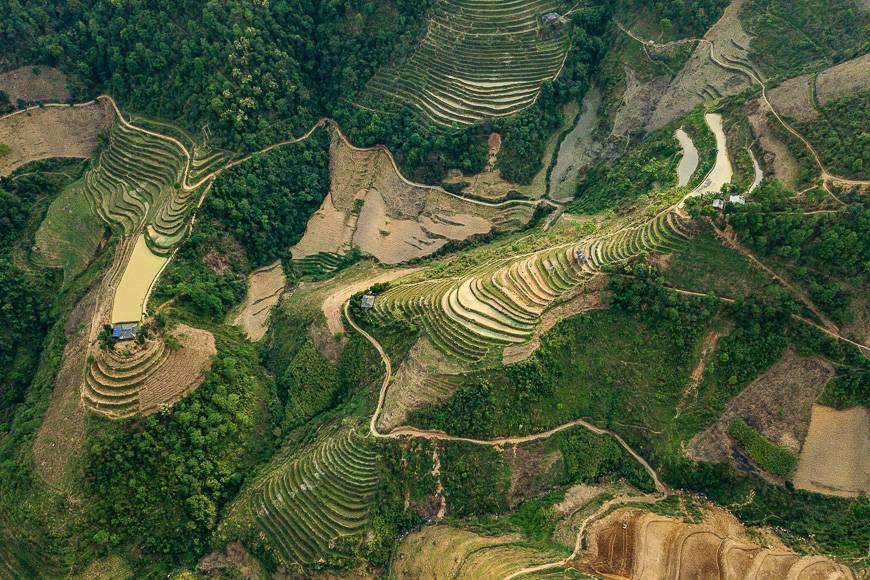
Stop in Bắc Mê for bite at one of the local food stalls. You’ll find fewer towns in the last stretch before reaching the city.
Arrive back in Hà Giang City and treat yourself to some modern comforts after all the miles travelled over the last four days.
Practical Tips
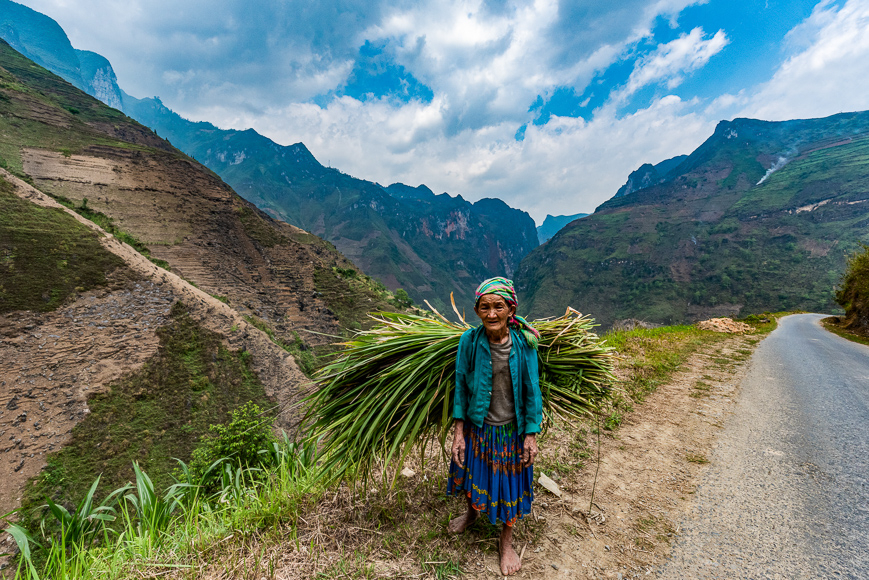
What to Expect
You’ll be travelling through the northernmost part of Vietnam, and there are limited resources once outside of Ha Giang. Be sure to bring enough cash, as ATMs are scarce.
How to Get There
Daytime and overnight buses depart from My Dinh bus station in Hanoi for Ha Giang regularly. Private transfers and tours can also be found online or through tour companies in the capital.
You can easily find motorbikes for rent in Hà Giang City. Both Honda and Kawasaki Service Centres are available in town.
Road Conditions and Safety
The roads of on this route are in good condition for the most part, however, obstacles and construction can show up anytime. For safety, approach curves with caution, drive during daylight hours and stop after dark.
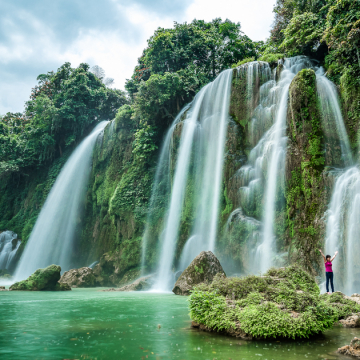
- You are here:
- Things to do
Create an account
Already have an account? Click here to sign in
By clicking submit, you agree to our Privacy Policy and Terms of Use
Sign in with your social accounts
Sign in with your email
Forgot password? Click here to get it back
Don't have an account? Sign up here
Forgot Password
The entered email has subscribed for Vietnam Tourism monthly newsletter

- Work with me
Ha Giang: A Detailed Travel Guide to Vietnam’s hidden Gem

This Ha Giang travel guide has all you need to know to plan your trip to one of the most fascinating places in Vietnam. Don’t miss it!
If you are interested to read the whole story from our trip with more photos, I have written an article about our five-day trip in Ha Giang .
It boasts of the most majestic and impressive natural landscapes in Southeast Asia, yet so many travelers overlook it. Ha Giang is a fascinating place where apart from an inspiring scenery, you have easy access to the most rural and authentic side Vietnam .
This travel guide of Ha Giang is packed with the most up-to-date and reliable information (November 2017) to plan your trip and start making your itinerary.
Let’s start!

Why go to Ha Giang?
Is Ha Giang worth it? There is no doubt that you will not fall in love with Ha Giang . So my answer is YES. DEFINITELY YES. Ha Giang had been on my list for some time. I told myself that I am not leaving Vietnam without seeing it with my own eyes. I can’t believe I hadn’t heard of this place years ago.
Since Ha Giang is not frequently featured in itineraries to travel through Vietnam , I feel I need to explain why this was my absolute favorite destination in the country. Ha Giang province is located in the most northern part of Vietnam , about 400 km northwest of Hanoi . This remote and mysterious province is a showcase of unbelievable mountain landscapes, limestone walls, roaring rivers, smiling people and hundreds of kids. Apart from its stunning scenery, Ha Giang is home to many different ethnic tribes like H’mongs. That is why Ha Giang is a great opportunity to peek into the rural way of living. It’s all very laid-back and serene, just how the Vietnam experience should be.
A buffalo in the mist somewhere among the mountains of Ha Giang province. One of the most beautiful places of Vietnam. . . . #vietnam #hagiang #buffalo #mistymountains #travelphotography #dnescestujem #dnesletim #dnesfotím #wildlifeart Příspěvek sdílený JANA VITOUSKOVA (@miles.and.smiles.away), Lis 16, 2017 v 9:54 PST
How to get to Ha Giang
How to get from hanoi to ha giang.
In Hanoi , you can catch a sleeper bus to Ha Giang from Mỹ Đình bus station. Buses leave almost every hour starting at 4:30 am till 1:30 pm. The night buses leave between 6 pm till 9:30 pm. The ticket should cost 200,000 dongs. The bus takes about 7-8 hours, give or take, with one mid-way stop as there is no toilet on the bus.
How to get to Ha Giang from other places
We live in Hai Phong (a city right next to Cat Ba island) and you can take a night bus from a bus terminal Ben Xe Cau Rao as we did. The bus ticket cost us 250,000 dongs and the journey took about 11 hours.
Things to keep note when purchasing bus tickets:
- Reserving bus tickets at hostel and hotels is the most assured way
- Be aware of fraud bus drivers at the bus station that will cheat your fares
- Buy the tickets only at the ticket counter
- If taken to the bus, do not pay before departure. The bus conductor will collect bus fares during the journey.
Best time to visit Ha Giang
Almost any time of the year is good to visit Ha Giang . There is really no best season for a motorbike ride. The hot and rainy season runs from April into October. The cold and dry season starts in November and ends in March.

Average temperatures in Ha Giang throughout the year. Note this is for Sapa area. However, the weather in Sapa is pretty similar to Ha Giang. Source: weather-and-climate.com
Must things to see in Ha Giang
Fairy bosom.
Fairy Bosom is a unique landscape with two symmetrical smooth hills. They are so charming and balanced that locals started calling them Fairy Bosom and its name dates back to ancient times and it is associated with many legends.
Heaven’s Gate
Quan Ba Heaven’s Gate is located about 50 km north of Ha Giang town and it is the gateway to the geological park. Once upon a time, behind the gate was a kingdom of Hmong people with 4 districts Quan Ba, Dong Van, Meo Vac and Yen Minh. In 1939 the French built a huge wooden door, 150cm thick to divide this area from the rest. The door is no longer there, only a sign in both English and Vietnamese languages: Quan Ba Heaven’s Gate.
Lũng Cú flagpole
The most northern village of Vietnam called Lũng Cú , Vietnam’s North Pole. The ‘pole’ itself (entrance fee; 20,000vnđ [$1]) is a tower atop a small hill with excellent views across China from the top.

Getting around Ha Giang
The easiest way is to rent a bike in Ha Giang . There are few different companies to choose from, but we rented our bikes from QT Bikes & Tours. We paid 200,000 dongs per day for Honda Blade, but you can choose from many more, for example, a dirt bike Honda XR for 900,000 dongs. Their bikes are new and well maintained. The guys in the shop will recommend you the best tour based on the number of days you plan to stay.
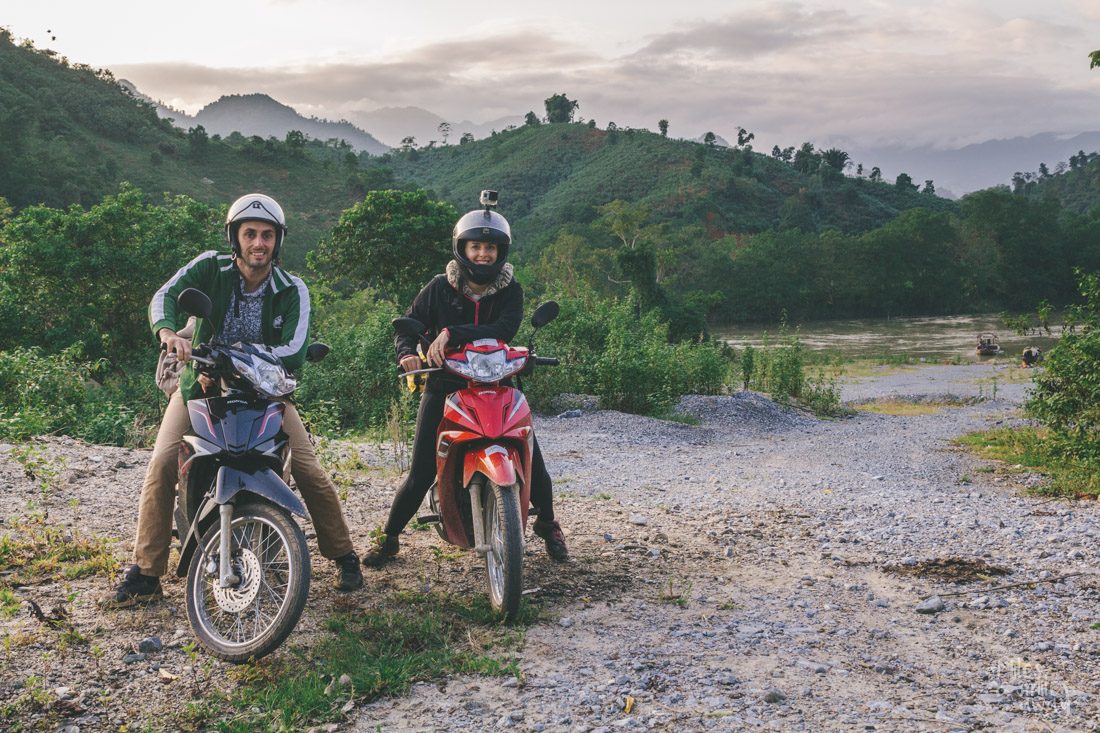
Us with our bikes Honda Blade
Where to stay in Ha Giang
I usually use HotelsCombined.com to find accommodations. It’s safe, easy and reliable. In this area, you can also use Airbnb or just follow the recommendation from the bike rental shop. We rented our bikes from QT and they told us exactly where we can stay in each place. All the places were amazing. We spent 5 days in Ha Giang province. When we arrive in the early morning we took another short nap in QT hostel (that is free if you rent a bike from them). Next two days we stayed in Du Gia village and stayed at QT Du Gia guest house (70.000 dongs). When we arrived at Dong Van we stayed in Da Nho hotel . Our last night we spent in a small village Nam Dam in an amazing homestay Hong Thu . All places are included on my map.

BBQ in style at Hong Thu homestay
Cost of things in Ha Giang (as per November 2017)
Vehicle rentals: motorbikes in Ha Giang can be rented from 150,000 dongs/day.
Gasoline: depends on your bike, but we usually paid 60-70,000 dong for the full tank (Honda Blade semiauto)
Food: Local restaurants served main dishes starting at 70,000 dongs. A bowl of pho (noodle soup) starts at 40,000 dongs though. A big water bottle (1,5L) was around 20,000 dong.
Entrance fees: the only entrance fee we paid was at Lung Cu to get to the top of the tower and it cost us 20,000 dongs.
Accommodation: I’d say you can expect to pay somewhere around 70,000 per person in a hostel or homestay and around 500,000 for a medium-quality double room.
Ha Giang Travel Tips
1. Take your time to unwind. A three-day trip is not enough to truly feel the essence of Ha Giang . Four or five days is the best. In this case, longer means better
2. Make sure you bring enough cash
3. Keep your cool when driving! You will hear a lot of honks – there are so many winy roads that it is always better to announce your presence to everyone.
4. Don’t forget to bring these things with you:
- Extra socks
- Waterproof cover for your phone, camera and your documents
- Sturdy footwear/riding boots – never think of riding a motorbike in flip-flops or sandals
- Your personal medication/first aid kit
- Mosquito repellent & sunscreen
- Earplugs (for the bus journey or for sleeping at hostels)
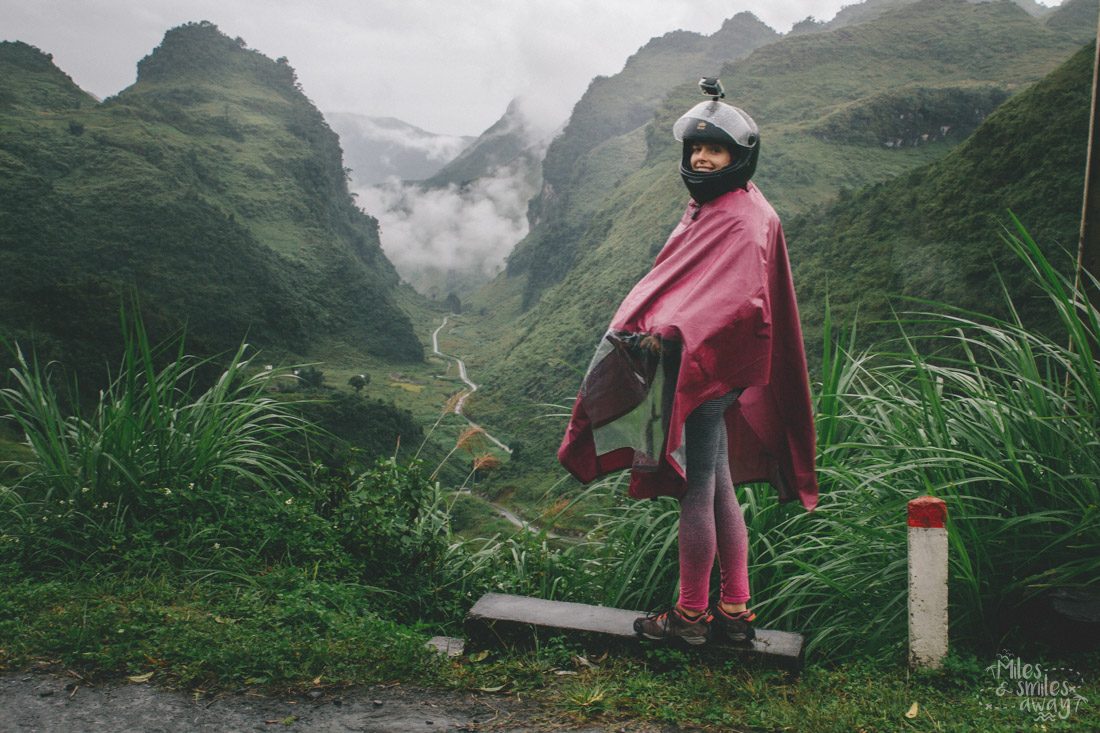
Standing on the top of Heaven’s Gate
Here you can find all details, which route we took, where we stayed and where I stopped to take photos.
Land Cruising in Bali
Ha giang loop 5-day itinerary: explore rural vietnam on your own, you may also like, ha giang loop 5-day itinerary: explore rural vietnam on your..., diving in sipadan island, one of the best dive spots..., leave a comment zrušit odpověď.
Save my name, email, and website in this browser for the next time I comment.
14 comments
Hi, Your blog truly inspired me!! My boyfriend and I will be following your itinerary to the T and we just wanted to check if you did the entire route without a guide? We will probably be staying at the places that you recommended as well, such lovely pictures! Also, did you book the homestays/hotels in advance? We will be heading to Ha Giang next weekend, with little to no preparation in terms of hotel bookings etc (dear me)!
Hi Beatrice! We made the whole trip by ourselves. We didn’t book any homestays or hotels in advance either. However, we were there during the rainy season, so not many tourists were travelling in that area. Ask the bike rental guys where to stay as they recommended us all the hotels/homestays. I think they know the owners and know their availability. Enjoy it and be careful…some parts might be a bit tricky, but nothing serious.
We just went from Sa Pa to Ha Giant city then on to stay in Dong Van. We did it all by local buses booking via hotel reception in Sa Pa and Ha Giant and just walked down to the city center in Dong Van. The area is a little slower than usual right now according to the locals, but we got good deals on booking.com. still it is cheap enough you wouldn’t have to book ahead. For those interested you certainly can do a great trip by public bus. If they have room and you wave they will pick you up between towns. Our best day was walking 11 km in a loop from Dong Van, north around the mountain through Ma Pang, Ma Tia and Ma U and back to Dong Van behind the field behind the town. We enjoyed it more than Mai Pi Leng, but the weather was better too. Just don’t be afraid to get off your bike and walk a bit, or even do the trip with public transport. No tribal folks asking for anything. They just try their “hello?” and go about their day. Also at the market we got the same prices as locals without bargaining, for fruit and veg.
Hi, i am from Singapore. In dec, we are heading to Hagiang. We have booked a driver n guide. Am wondering if in Winter, is there anything much to see in Hagiang
Hi Ruby, My GF and I are also from Singapore. We will be heading to Ha Giang on first week of Dec. Just wanted to say hi and see if you guys are also travelling on the same period.
Hi Ruby, Winter is not that rainy. However, it might be cold. So prepare yourself for that. I was there at the end of October, and it was wet and chilly, but we enjoyed it a lot anyway.
Thank you for your precious time writing an excellent review. Your satisfaction really inspires me a lot.
Thank you so much Ventori. Greeting from the Czech Republic.
Hello, I love this post! I just have a technical question: how do you rent a bike there? Do you need a driving licence?
best regards!
Hi Marta, I’m happy you love my post! You can check QT guys online and book it in advance. Or you ask the bus driver to take you to QT hostel where you can sleep for free for a few hours in case you arrive early in the morning and in the morning they take you to their motorbike shop. We needed only our passports. We didn’t have to show our driver’s licence.
Thank you for a wonderful review. I am going to Ha Giang next month and your post just convinced me that it was a right decision. What time of the year were you there? I am considering bringing a heavy raincoat but not sure if it’s a smart choice with the current temperatures.
Hi Masha! I’m really happy you like my article and that it helped you to decide to go to Ha Giang! We were there at the end of October and it was raining most of the time. But on the other side, I got some amazing moody photos 🙂 You can buy some raincoats there – I think you will be okay with some basic one. No need to have a heavy one. Enjoy it! And if you have more questions, let me know 🙂 Happy to help.
I greatly appreciate your article, you’ve convinced me to travel via motorbike through Ha Giang, Thank you!
I only have 2 nights and 2.75 days and I’d like to do as much of the loop as possible w/out it being rushed. Question for you- do you thinks it’s possible for a first time motorbike rider to make it from Ha Giang to Dong Van (137km) in 1 day. I’ll be leaving Ha Giang city around 7/ 8am.
Thanks, Scott
p.s- Your photography is stunning.
Hi Scott, I’m happy I inspired you to go to Ha Giang. The roads to Dong Van are in a good condition so you might be able to do it. However, there is so much to see on the way that I’m a bit worried, you would want to stop to see those amazing views. But we drove from Dong Van to Nam Dam village in a day with stopping. So I guess you can do it.
This website uses cookies to improve your experience. We will ll assume you are ok with this, but you can opt-out if you wish. Accept Read more


Ha Giang City – travel guide & 7 things to do
Ha giang city in brief.
- Serving as the capital of Ha Giang province
- Home to a population of just more than 56,000 residents, representing 22 diverse ethnicities
- Lack of an airport or train station
- Approximately 6 to 7 hours’ drive away from Hanoi
- Notable as both the starting and ending point of the renowned Ha Giang Loop
Ha Giang City – the start & end of the Ha Giang Loop
Ha Giang City serves as both the starting and finishing point of the renowned Ha Giang Loop , a scenic route that brings you to Ha Giang province’s key highlights.
From Ha Giang City, you have the options of hiring a car with a driver , self-driving a motorbike , or embarking on the journey with a local guide on a motorbike ( easy rider ). The loop, which spans at least 3 days but can be extended to 4 or 5 days, concludes back in Ha Giang City, where you can return to Hanoi.
How to get there
Ha Giang City is accessible solely by road, as it lacks an airport or train station. The most convenient access points are from Hanoi, although connections between Sapa and Ha Giang are also available. Regardless of your starting point within (northern) Vietnam, the route typically involves passing through Hanoi, as it serves as the main gateway to Ha Giang City.
The journey from Hanoi to Ha Giang takes approximately 6 to 7 hours.
Options for traveling from Hanoi to Ha Giang :
- Sleeper bus : Operating at night, this option allows you to save daylight hours for exploration in Ha Giang. However, nighttime travel on buses doesn’t suit everyone’s preferences, and the quality of sleep can vary. VIP buses with enhanced comfort are also available.
- Limousine buses : These comfortable buses run during the day, with departures from early morning to early afternoon. Morning departures get you to Ha Giang City by noon, offering the chance to rest, explore the city, or even start the loop upon arrival.
- Private transfers : Renting a car with a driver is another option. While not necessarily more comfortable than limousine buses, private transfers offer greater flexibility in terms of pickup times and locations.
Best things to do in Ha Giang City
1. countryside & villages.
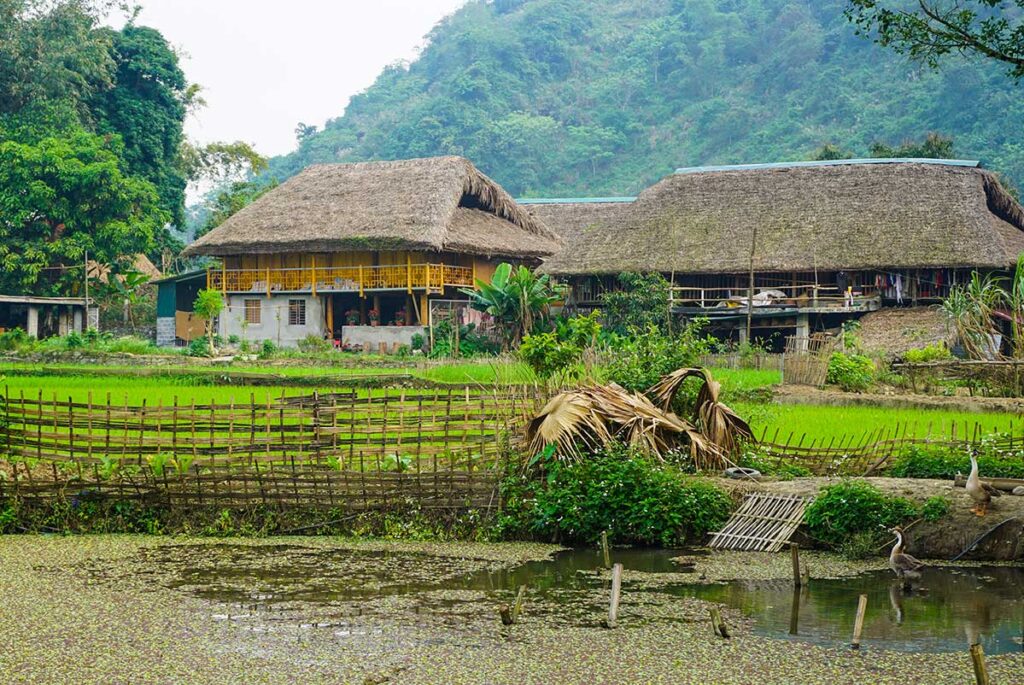
The real charm of Ha Giang City lies just beyond its borders. Venture into the nearby ethnic villages, where traditional houses dot the picturesque landscape of green rice fields, grazing buffaloes, rolling hills, and lush forests. Thon Tha Village , in particular, offers an immersive experience with the option to stay overnight in a homestay.
2. Walk along the river
Take a leisurely walk along the city’s riverbank, especially in the evenings when the atmosphere is delightful. Cozy coffee shops and eateries line the riverside, offering a relaxing setting. During the day, consider a drive or motorbike ride alongside the river, where it meanders through mountains, villages, and serene countryside.
3. Number 6 waterfall
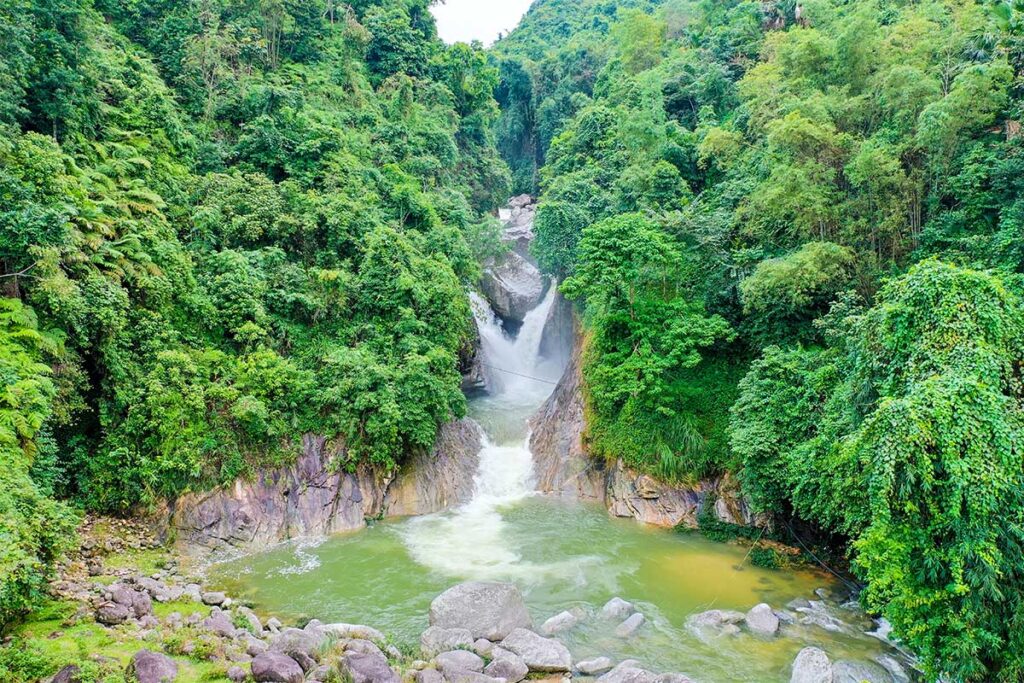
When summer brings its rain, it’s the ideal time to visit a nearby waterfall just a short distance from the city. The rainy season enhances the waterfall’s beauty, and the warm weather makes the natural pond inviting for a refreshing dip. The waterfall is surrounded by villages and verdant forests.
4. Ha Giang City viewpoint
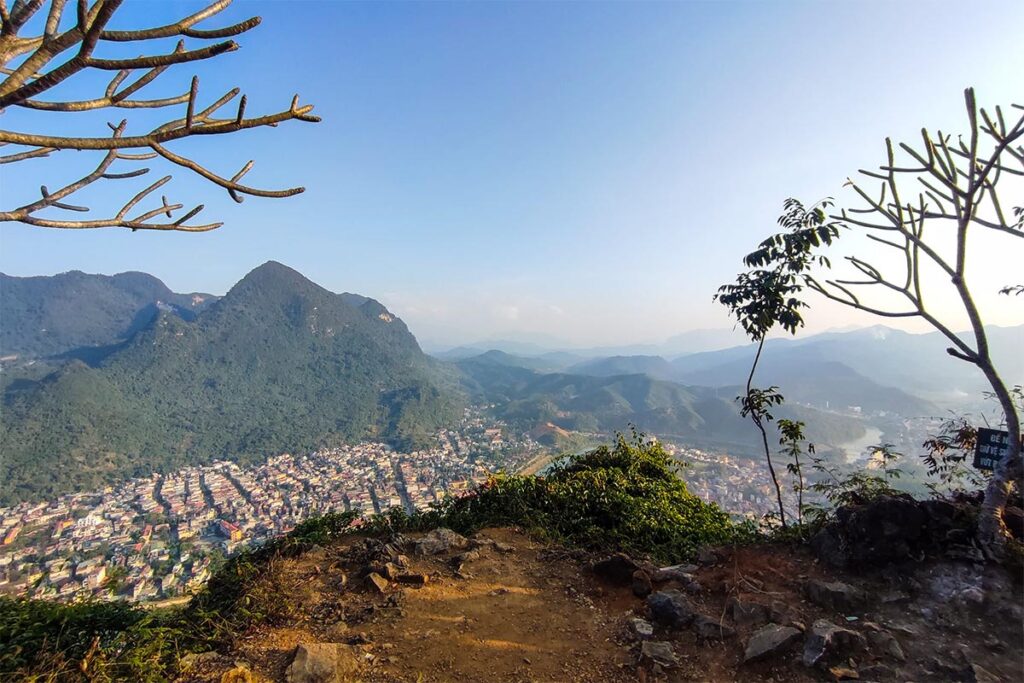
Situated just 1.5 km from the bustling city center on the city’s western edge, the Ha Giang City Viewpoint offers a stunning panoramic perspective of the landscape below. To get there, drive up to Cafe Nui Cam, a local hotspot that marks the beginning of your uphill journey.
From the café, you’re in for an climb—approximately 800 steps. While it may sound daunting, rest assured that the ascent is well worth the effort. As you make your way up, you’ll be rewarded with increasingly expansive views of Ha Giang City, culminating in a breathtaking 360-degree panorama at the top.
This viewpoint is especially popular for catching the sunset. You can also take a moment to explore the nearby old war ruins and a temple.
5. Local eateries and street food
Dive into the local culinary scene by indulging in street food and dishes at small eateries. Sample Vietnamese classics like pho and banh mi. Embrace the city’s atmosphere further by spending time at local cafes, perfect for people-watching while sipping traditional Vietnamese coffee.
6. Landmark 0

Capture the moment by taking photos at Landmark 0, the zero milestone that signifies stepping onto the Ha Giang rocky plateau. Although not a formal tourist attraction, it has become a symbolic check-in point for many, offering a sense of arrival in this captivating region, especially for Vietnamese tourists.
7. Ha Giang Museum
While not the most extensive museum in Vietnam, the Ha Giang Museum can be a worthwhile visit on a rainy day. Though mostly in Vietnamese, the museum sheds light on the region’s history, geography, nature, and the diverse cultures of its ethnic minorities. Traditional tools, clothing, and dwellings are among the exhibits that offer insights into local life.
Tips for staying here
1. thon tha village alternative.
As Ha Giang City offers limited atmosphere and not many things to do, it’s worth considering an alternative like Thon Tha Village.
Situated just beyond Ha Giang City, Thon Tha is a Thay ethnic minority village with stilt houses nestled amidst picturesque rice fields. Some of these houses function as homestays, allowing you to experience an authentic stay with a local ethnic family. Beyond simply lodging, daytime exploration provides an opportunity the beautiful countryside, while evenings offer a chance to engage in cultural exchanges with your hospitable hosts.
2. Skip or stay overnight?
In terms of logistics, including Ha Giang City in your itinerary is not a must. You have the option to kick off your Ha Giang Loop immediately upon arrival in Ha Giang City, and straight on the end of your loop back in Ha Giang City you can take the bus back to Hanoi. Opting for this approach can help you save both time and money.
3. Eating & drinking
Ha Giang City doesn’t boast a vibrant nightlife, but you might find a bit more social interaction at the hostels where fellow travelers gather for drinks. The city hosts a considerable number of restaurants, some even serving Western cuisine. If this appeals to you, make the most of it, as during the loop, you’ll likely be indulging in local fare at native eateries and homestays.
4. Arriving at night
When arriving on the night bus from Hanoi to Ha Giang City, you might reach as early as 4 AM. To ensure a well-rested start for your loop journey, it’s advisable to book a hotel room for a few additional hours of sleep. If you do the Ha Giang Loop by tour, this is normaly already included. With the benefit of some extra rest, you can kick off your loop adventure after a leisurely breakfast around 8 or 9 AM.
- 25 highlights & Route
- 3 - 4 day itinerary
- Ha Giang to Dong Van
- Dong Van to Meo Vac
- Meo Vac to Ha Giang
- Weather & Best visit time
- What to bring
- Health & Safety
- Ha Giang Loop with Kids
- Ha Giang Loop at 60+
- Hanoi to Ha Giang
- Sapa to Ha Giang
- Ninh Binh to Ha Giang
- Cat Ba to Ha Giang
- Easy Rider (behind motorbike)
- Driving motorbike yourself
- Renting motorbike
- 10 best local markets
- 7 best mountain passes
- 10 best local villages
- 9 best viewpoints
- 6 best rice fields places
- Where to stay
- Best homestays
Travel Guide
- Ha Giang Loop Essentials
- How to get to Ha Giang
- Getting around Ha Giang
- Ha Giang Loop Tours
- Ha Giang Combo tours
- Local Ha Giang River Lodge
- Local Dong Van Hidden Valley Lodge
- Local Meo Vac Mountain View Lodge
About Local Ha Giang
- Reviews & Guest Experiences

Excited to visit Ha Giang? Book your local experiece here!
- Dansk ( Danish )
- Français ( French )
- Deutsch ( German )
- Italiano ( Italian )
- Español ( Spanish )

Maifootsteps
Blog du lịch của Mai- Mai's travel blog

A detailed Ha giang Vietnam travel guide by a Vietnamese !
Ha Giang Vietnam is a place that people easily get attracted by its wonderful wild beauty. Ha Giang is not only famous by winding roads, steep hills but also with colourful flowers and interesting traditional culture. It is indeed ideal for outdoor activities such as trekking and camping. Lets come to Ha Giang to get the most interesting experiences about this upland area. Hope that my Ha Giang travel guide can help you fully discover this wonderful highland.
1. Some interesting facts about Ha giang Vietnam :
2. is ha giang worth it ha giang vs sapa ., 3. weather in ha giang, which season is the best time to visit, 4. how many days i should spend in ha giang vietnam, 5.1 from hanoi to ha giang ., 5.2 from sapa to ha giang, 6. transportation in ha giang vietnam, 6. getting your permit in ha giang., 7. what to bring to ha giang vietnam, 8. where to stay in ha giang ( best place to stay in ha giang), 9. ha giang loop route/map, 10. ha giang tour – ha giang travel guide, 11. what to do in ha giang , 12. ha giang itinerary ( 5 days, 4 days, 3 days), 13. independent trekking ha giang ( ha giang trekking map), 14. what to buy in ha giang, 15. what to eat in ha giang, 16. ha giang vietnam travel guide.
- Ha giang Vietnam shares a long border with the south of China. This province has Lung Cu flagpole- the northernmost point of Vietnam. It has been said that the first flagpole has existed here for almost a thousand years as a symbol of Viet nam sovereignty. The flag itself is a gigantic 54 square meters, symbolising the 54 ethnic groups in Vietnam.
- Ha giang Vietnam has various species of flowers however the most outstanding flower is buckwheat flower. It is considered as an icon or an indispensable specialty of Ha Giang. Annually, buckwheat flower festival taken place in autumn attracts a lot of tourists from all over the world to enjoy this incredible landscape.
- Ha giang has a variety of beautiful terrace field especially Hoang Su phi.
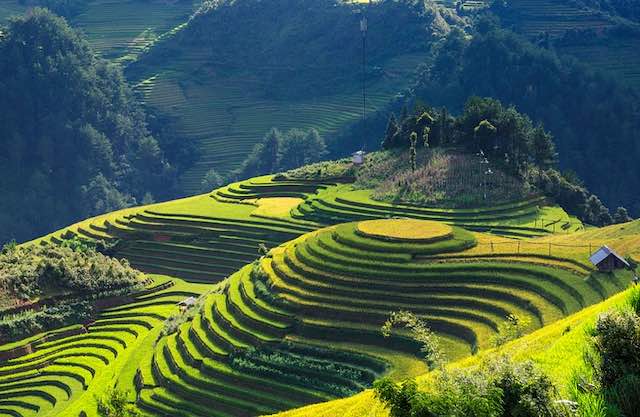
- Ha giang Vietnam is famous for Ma pi leng pass which is known with its breathtaking view of high mountain and lovely valley. Ma Pi Leng Pass is indeed the king of all mountain passes in Vietnam. Many tourists have said that this pass is truly an unknown stunning geography treasure in the world.
- Besides majestic mountains, Ha giang also has many spectacular caves. The most well-known is Lung Khuy cave and Na Luong cave.
- Ha Giang Vietnam consists of various ethnic minorities (Chechens, Tay, Hmong, Dao, Nung, Cao Lan, Hoa, Lo Lo, etc). They can be distinguished by their clothing. However, most of Ha Giang’s population is H’Mong- an ethnic minority group. They are very enthusiastic and hospitable. If you have arrived in Ha Giang city, dont forget to try living at local’s accommodation to know more about their life. Definitely recommend!

Whether you are a truly nature lover or enthusiast traveler, travel in Ha Giang is always a fascinating experience that you should not ignore. For me, Ha giang is always in my must list when telling about Vietnam tourism places. Ha noi or Ho chi minh city even dont attract me that much comparing to this stunning land.
Many people ask me how do I think about Ha giang vs Sa pa. In my opinion, both town have their unique beauty and even some similarities. You can see wonderful passes, beautiful terrace rice fields and flower gardens in both Sapa or Ha giang Vietnam.
However if you are seeking for an unknown places with not many tourists then Ha giang would be my answer. Ha giang is just a completely charming area and a must-do for visitors that want an authentic and unique travel experience. The wild beauty of Ha giang Vietnam is only recognised during 400km journey with majestic mountains, terrace rice fields, flower gardens, steep hills, winding roads… so I would highly recommend adding Ha Giang Vietnam to your holiday itinerary if you are an adventurer seeking for unknown land .
Unlike Ha giang, Sapa is much more touristy right now. Sa pa is far more accessible than Ha Giang, with more accommodation options and better tourist infrastructure. There are various attractions in Sapa Vietnam which is easily reached by foot . Sa pa would be your choice if you travel with kids or seeking for an easy and comfortable trip.
See more: A comprehensive Sapa travel guide !
Weather in Ha giang Vietnam differs from time to time and every season has its own unique beauty. The climate is divided into two distinct seasons: rainy and dry season. The climate also changes depend on the altitude. Rainy season is from late April to early October. Ha giang weather is normally hot & humid with constant rainfalls. Whereas in the dry season, there is not big shower like in rainy season and the shower is cooler down.
In my opinion, i would recommend you to travel to Ha giang anytime from September to November. At This time, the temperature is most pleasurable, in their mid 20’s. October and November is peak season for local Vietnamese tourists. It is the time when the buckwheat fields in full blossom and expect that hotels and tourism service can be very busy. Remember to book your stay and activities in advance in the peak season in Ha giang Vietnam .
Here are some standout feature in Ha giang travel guide in every season:
- In the beginning of the spring ( after lunar new year- normally it is in February), people will have opportunity to participate in various traditional festivals in Ha giang Vietnam such as buffalo fighting festival, house racing festival or special Khau Vai love market.
- In March, it is one of the most beautiful time of Ha Giang with peach and plums blossom along with its nice fragrance.
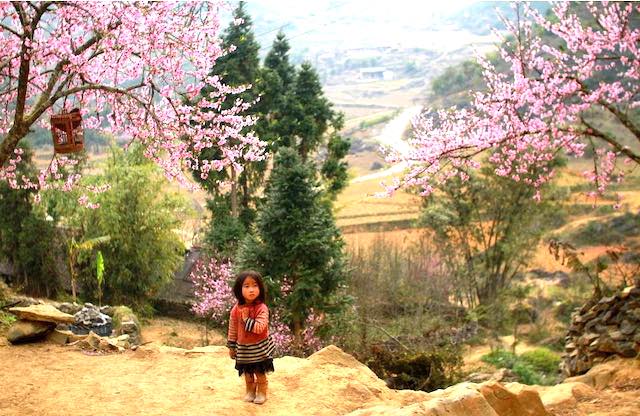
- In May and June, you will have chance to witness the charming Ha Giang Vietnam on the “falling-water season”. During this time, local get rainwater from mountain down right to their terrace field and start a new rice crop. The terrace field is filled with rainwater like a huge sparkling mirror. This season is the rainy season in Ha giang so you would better check Ha giang weather forcast in advance.
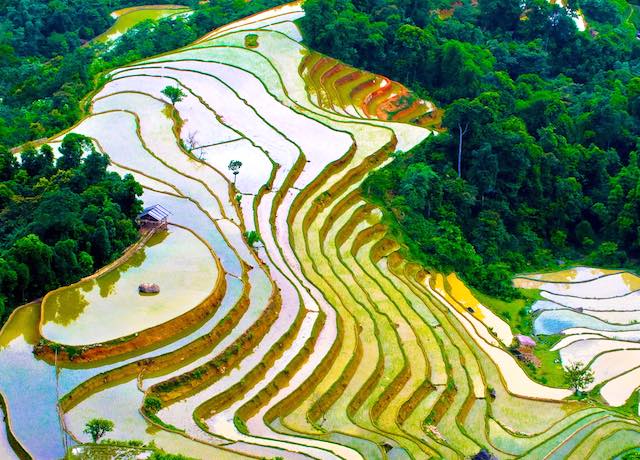
- August and September is the season of ripe rice in Ha giang Vietnam. You will have a chance to witness the terraced fields with a golden colour of rice. Very stunning landscape however the early October would be the best time to capture those.

- Late October – November is the time when the buckwheat flower blooms with a purple colour on the hillsides like a purple carpet spreads. An incredible landscape there.

- After the buckwheat flower season, you will witness the brilliant yellow cauliflower season in December. The flowers fields are spreading a bright yellow colour on the slopes creating an unforgettable scenery.

In my opinion, 3 days 4 nights is the most reasonable time that people often take when traveling to Ha Giang Vietnam . If you dont have much time, then 3 nights 2 days is a ok but a little rush. If you a truly nature lover and want to enjoy the peaceful atmosphere here, then 5 or 4 days should be considered. We Vietnamese often take a 3 days trip to Ha giang as the most popular plan.
5. How to get to Ha giang Vietnam ?
The distance between Hanoi and Ha giang is around 300km and the closest airport from Ha giang is Noi Bai- Ha Noi airport. So the only way to get there is by bus or motorbike.
- From Hanoi to Ha Giang by sleeper bus:
From Hanoi to Ha giang, it takes around 9 hours to go by bus. The bus go to Ha giang will depart from My Dinh bus station. The best bus brand is named Hai Van.
If this bus is gone, you can take the other one named Bang Phan, Cau Me, Hung Thanh, Ngoc Son. There is one trip in every 30 minutes and the latest one is from 21h30 at My Dinh bus station.
Ticket price ~ 150k-350k / person.
Particularly, Hai Van has 2 lines: the bed is usually 200k / person and the cabin line (350k / person – one cabin per person)
Ha giang travel guide : There are two ways to book a bus from Ha noi to Ha giang Vietnam:
- Book the ticket via your accommodation in Ha noi and they will organise for you to be picked up at the front door by the bus company. Remember to pay the ticket only in the ticket counter in the bus station or pay to the bus conductor when the bus already move. Don’t pay them before departure .
- Book online ticket here.
- From Ha noi to Ha giang by motorbike:
For those who like to explore and experience, they can choose to go by motorbike. With a distance of nearly 300km, traveling by motorbike to Ha giang can take 8-10 hours. You can choose one of the two routes as follows:
Road 1: From Hanoi to Trung Ha bridge via Son Tay direction, follow Thao river to Phu Tho and then go to Tuyen Quang via Highway 2 to Ha Giang.
Road 2: From Hanoi, follow the direction of Thang Long Bridge, turn to Vinh Phuc, go towards Viet Tri, Phu Tho and Tuyen Quang, and follow along Highway 2 to Ha Giang.
Ha giang travel guide : For those who do not have experience on the road by motorbike, carefully prepare the map, phone, personal papers, … to get the best trip.
Its around 200km ( 7 hours) from Sa pa to Ha giang. However the road is quite difficult to go so I would prefer a bus more than motorbike. There are 4 buses running from Sapa to Ha Giang : Cuong Thinh , Quang Tuyen, Quang nghi, Trung bac.
Time of departure: 20h10 or 10.00
Pick up point: Sapa bus station
Ticket price: VND 150.000- 250,000 / ticket ( paid diretly to the bus driver).
The easiest way to book a bus is via your accommodation and they will reserve you a spot.
Renting a motorbike is the best transportation in Ha giang Vietnam in order to explore this highland. If you dont have good driving skills, then i would recommend you to hire a local tour guide during your stay here.
Some good rental services:
- Rental service in Mr. Hong Hao. In general, the service is very good. You can contact them via their fanpage.
- Hang Chang motorbike rental. – Website: hangthuong.com
Address : No. 15B, Pham Hong Thai Street – Group 17 – Minh Khai Ward – Ha Giang City.
Free : helmets, travel maps, 2 bottles of water, free accommodation and hot showers.
Price : range 150-250k/day
Getting your permit for Ha Giang Vietnam is very easy. Foreign visitors should go to the immigration office at 415a, Tran Phu Street. You will need to give them your passport, pay 210,000 VND and a few minutes later, your permit is ready. If you’re traveling by motorbike, you need to give them your registration number too. This Ha giang travel guide is asked whether its obligatory or not ? Actually you will be safe if no policeman or hotel staff ask you about this. However just in case of your safety, getting your permit in Ha giang is always recommended.
Ha Giang is a climatic region with more differences than other regions, especially in the highlands. When visitors come to Ha Giang, you should pay attention to some of the following Ha giang travel guide:
+ Should bring warm clothes when going up to the highland area because the climate changes suddenly and the weather is getting colder at night.
+ Prepare some medicines to treat common diseases like flu , headache because visitors can get it when they do not adapt to high temperature and cold climate.
+ If visitors come to Ha Giang Vietnam between July and August, it is recommended to bring rain gear or umbrellas. It is the time of the rainy season, visitors may encounter continuous rainy days or rain showers suddenly.
+ If tourists participate in the type of sports tourism in Ha Giang, it is recommended to carefully prepare the protective equipment and medicines, first aid precautions.
If you are seeking for a homestay in Dong Van, then Trieu Nghi would be your best option. This homestay is in a good location with a rice fields and peaceful surrounding . The lady is very nice, food is delicious and the price is very affordable.

Ha giang travel guide in Ha giang loop route : There is two popular roads from Ha giang city to Lung Cu flag pole. You should go both 2 ways in order to enjoy the wonderful scenery there. The first way is to go towards Quan ba, Lung Tam, Yen Minh and Dong Van district. Through this road, visitors will have opportunity to enjoy various breathtaking landscape in Quan Ba heaven gate, Yen Minh pine forest, Lung Tam line cooperative, Tham Ma slope. I would prefer you to go this road on the first day you come to Ha giang Vietnam. This Ha giang loop route is more than 200km, however you can stop and rest in Yen Minh overnight and continue for the next day.
The second way from Lung Cu flag pole to Ha giang city is through Ma pi leng pass, Meo Vac, Duong Thuong, Du Gia, Mau Due district. This Ha giang loop route is really beautiful with lovely terraced rice field and winding roads. However Mau due- Du gia road is considered as the most dangerous road in Ha Giang Vietnam so you should be very careful if you drive motorbike in rainy season. If you want to go for a shorter distance ( 20km less), from Duong Thuong, you can turn to Quan Ba and head towards Ha giang city.
See more: All you need to know about Sapa Travel guide.
If you do not have driving experience and want to find a Ha giang tour . I would prefer you to book a Ha giang local guide more than Ha giang tour from Ha noi. This is also the way to support ethnic people in Ha giang due to the fact that the ethnic minority in Ha giang still have high level of poverty. I would recommend local guide by Ha giang road trip . They are a group of 4 young ethnic men who are very responsible, open-minded, and motivated about sharing their culture. Highly recommend !
- Dong Van old Town: Dong Van Ancient Town was formed in the twentieth century, located right in the valley with surrounding cliffs. Ancient town has the architectural features of ancient Chinese people. In the 1880s, when occupying this area, the French had some important architecture plans towards Dong Van. Until now, those unique stone architecture are still remained.
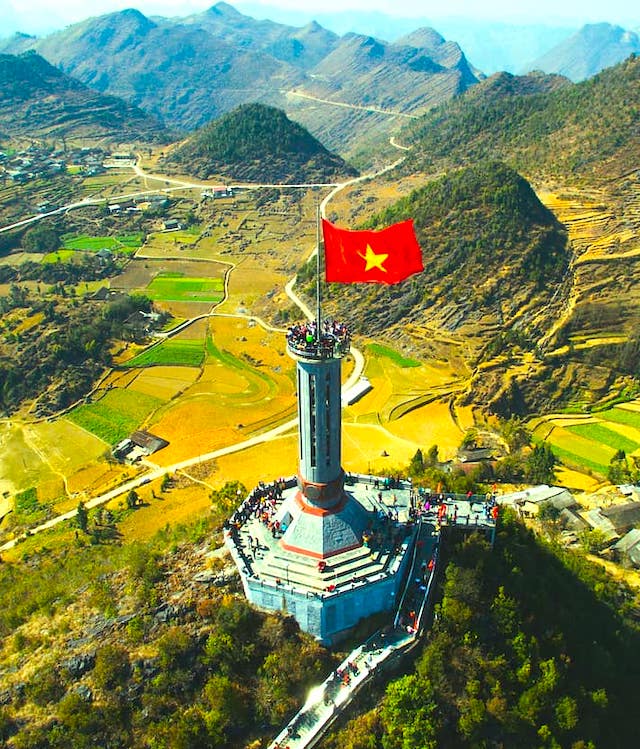
- Lung Cu flagpole: Lung Cu flagpole is located on a mountain peak about 1700m above sea level. If you want to visit this place, you need to go through more than 500 stone steps. This is a great check-in place of the adventurers.
- Ma Pi Leng Pass: Ma Pi Leng Pass is 20km long with a height of 1200m above the sea level. It’s said to be the most astonishing mountain road and the king of all mountain pass in all of Vietnam.
It’s the most difficult pass to build but also the most fascinating and beautiful pass to enjoy in Vietnam. The road was built in the 60s of the 20th century by a lot of workers who worked very hard for 11 years to build this road.
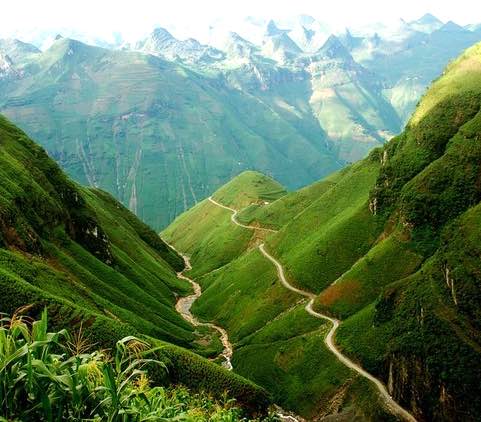
The road along the mountainside has romantic, stunning scenery that is ideal destination for riding motorbike. This is an exquisite winding mountain drive with sharp and blind curves and hairpin switchbacks leading the traveler over the mountains. At the top of the pass there’s a stone stele recording the marks in the construction process. The gigantic mountains offer blissful sights along with the Tu San Canyon between them.
Ha giang Vietnam travel guide : At the bottom of the Tu San Canyon is the deep green Nho Que river. You can have a trek from Ma pi leng pass to Nho Que river however it will take around 1 day in order to reach there. Nowadays there are also many tourism companies organising a boat tour in Nho Que river.
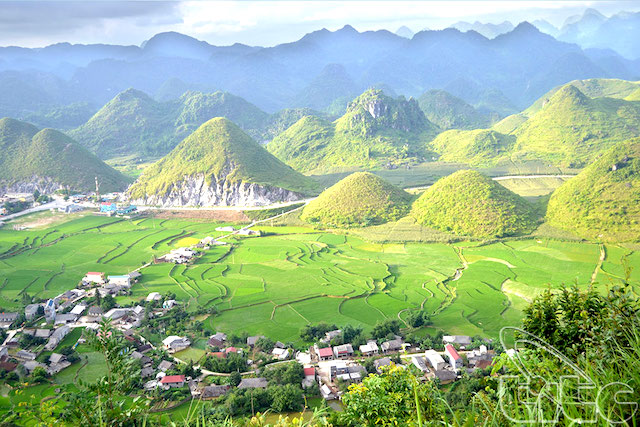
- Quan Ba heavenly gate: Quan Ba heaven gate is about 1500m above sea level. The road to heaven gate must pass through the roads crossing the high mountain, covered by a thick layer of fog, one side is deep cliffs. Standing on the sky gate can see the fields of terraced fields.
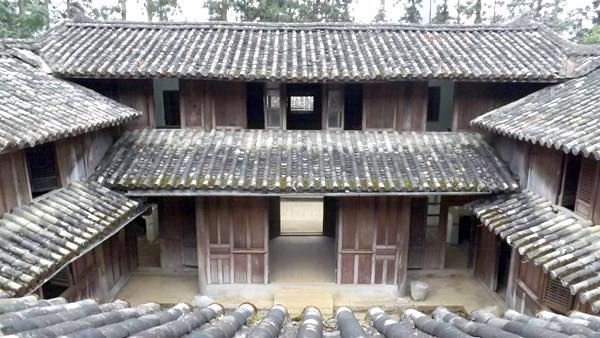
- Wang’s mansion: The mansion was built in the twentieth century, located about 24km from Ha Giang city. This is a place to be visited by many tourists.
- Market session: Ha Giang is famous for Quan Ba market, love market Khau Vai. Market sessions are usually held on weekends, trading handicrafts of H’Mong ethnic groups. Khau Vai Market every year is only held once on March 27 of the lunar calendar. On this day, single boys and girls from different ethnic groups will come here to find their own half.
- Buckwheat flower : Ha giang is well known for marvellous buckwheat flower fields. Normally, there is full blossom from the 3rd week of October to early November. Flowers are tiny white and mixed with a little purple and pink. Every year , Ha Giang welcomes a large number of tourists to visit the buckwheat field, or join the buckwheat flower festival. It is the time that Buckwheat flowers are blooming around the slopes and foothills.
Check the link above to know more about a detailed Ha giang motorbike loop itinerary that we Vietnamese often take. Hope this help !
The surrounding in Ha Giang is very spectacular with winding mountain roads, pine forests, terraced rice fields, steep hills, farming villages and wonderful views from every corner. And that’s the reason why Ha Giang trekking is considered as a must thing to do for adventurous travellers in Vietnam.
Independent trekking
I only suggest independent Ha Giang trekk for those who have trekking skills and experiences, because the terrain of Ha Giang is very rugged and dangerous . You should have a very detailed plan and prepare everything carefully before departure.
Ha Giang trekking with local guide .
As i have mentioned before, you can find a local guide for you to explore Ha giang. Ha giang local guide will help you to explore various wonderful places easily and avoid being lost. And if this is your first time of trekking in Ha giang, hire a local guide is absolutely the best deal.
Check the link above to know more about Ha giang’s specialities and market’s meeting schedule in Ha giang.
- If travelling by motorbike from Hanoi to Ha giang , you should only stop in Ha Giang City to ensure safety. When you reach Ha Giang City around 4-5pm, if you move on to Quan Ba, it is likely that you will see foggy weather in Quyet Tien section. So be careful with this road.
- Only self-drive in Ha Giang Vietnam if you ride a motorbike quite well. It is best to have experience in riding mountainous area before.
- Always remember to check your motorbike before renting it. The vehicle must have at least one left mirror (two mirrors are recommended for good rear view).
- Please use a good quality helmet to ensure your safety.
- On days with lots of fog, you shouldnt go on the road too late (about 5-6 pm), it is best to reach your accomadation when it is still bright. Ha Giang Vietnam has various road which is very dangerous to go under bad wheather condition.
- During peak seasons, always book a hotel / homestay as well as a sleeper bus ticket at least 5-7 days prior to departure to ensure a reservation.
- You should wear hiking shoes or sports shoes when travelling to Ha giang Vietnam . It is advisable to bring warm clothes, gloves (suitable for riding a motorbike) if traveling to Ha Giang by motorbike in winter
- If you are not confident in the ability to ride, I would prefer you booking tour from Ha noi or Ha giang.
- Do not give money or candy to children on the road. In Ha giang Vietnam , ethnic children often begin to support their families financially through selling trinkets to tourists. Do not encourage this by buying from children – buy from adults.
- Children have poor or non-existent dental hygiene. So do not give them candy or sweets – it will cause dental issues. If you want to give them something, safe toys, book, pencil are highly appreciated.
- Do not sit in the middle of the entrance door of the Mong people to take photos, sit on either side.
- Ask for permission before taking photos of the local people.
- Plan to spend 4 or 5 days on the loop if you want to enjoy the nature. Some travellers haven’t had much time and do it in 3 days. But with this way, you have to drive 150km in average every day.
Dont hesitate to ask me if you still have questions about Ha giang Vietnam travel guide. Vietnamese are the most suitable one that can help you fully explore this unknown land.
Ha giang Viet nam travel by Bay Tele:
Rate my post
Average rating 5 / 5. Vote count: 3
Hiện chưa có đánh giá
As you found this post useful...
Follow me on social media!
We are sorry that this post was not useful for you!
Let us improve this post!
Tell us how we can improve this post?
List of useful websites for your travel experience.
- - Book your accomodation at Booking.com or at expedia.com.
- - Book your entrance tickets or tours at Klook or Viator.
- - Compare and book means of transportation at omio.com . Pleas use this code linhm0h7b4w6d to earn 10€ discount on over 40€ value booking, put the code on section received an invite code of Travel bonus .
- - Buy travel insurance at Worldnomads.
- - Book your Train, Bus, Ferry, Transfer & Flight Tickets Booking in Asia & Worldwide at 12go.asia
- - Support me through Paypal.
Leave a Comment Cancel reply

- Ha Noi – Sapa
- Ha Noi – Ha Long
- Sapa – Ninh Binh
- Ninh Binh – Ha Long
- Ha Giang Loop
- Ninh Binh Tours
- Sapa Trekking Tour
- Sapa Hiking Tour
- Search for:
Travel Guide , Ha Giang Loop
[2024 updated] ultimate guide to the ha giang loop road trip.

The Ha Giang loop is a circular route that is best explored on two wheels that runs along Vietnam’s border with China in its far north. This spectacular route, weaving through the Ha Giang province, is not just a journey through roads less traveled; it’s a voyage into the heart of Vietnam’s rich cultural tapestry and breathtaking natural beauty. Ha Giang, with its challenging mountain passes, lush valleys, and vibrant ethnic cultures, offers an experience that resonates deeply with the spirit of exploration and adventure.
Table of Contents
About Ha Giang Loop
The Ha Giang Loop is a motorbike loop that circles Ha Giang, the northernmost province of Vietnam that borders China. You guessed it. Starting approximately five hours north of Hanoi, it is east of Sapa. Here are some of the most beautiful road sections I believe you will find in Vietnam, Southeast Asia, and the world. I’d love to visit, so feel free to disagree in the comments and tell me of somewhere even more beautiful!
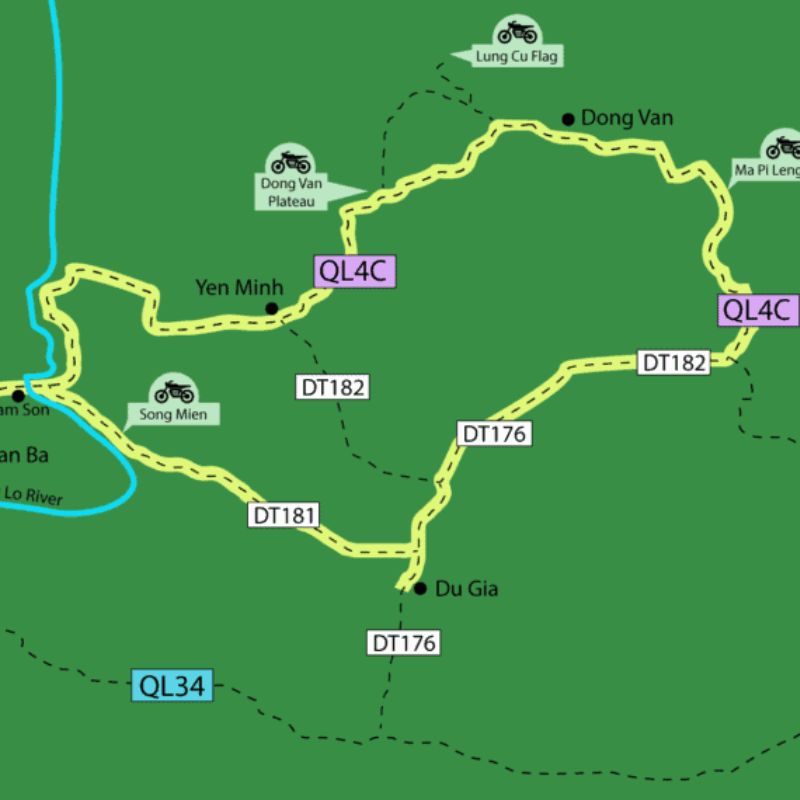
Approximately three to four days are needed to finish the entire loop, but it’s best to allow at least four days so you can take your time and see everything. I don’t think I could complete the loop in less than four days.
This fascinating route passes through canyons, geological faults, high passes, valleys, and abysses. Its main attraction is the well-known Ma Pi Leng Pass, one of Vietnam’s four magnificent mountain peaks. The allure of a Ha Giang loop tour is enhanced by the opportunity to visit 22 different ethnic groups, each with their own unique cultural heritage and mouthwatering cuisine.
How to get to Ha Giang?
Known as one of Southeast Asia’s most amazing overland treks, the Ha Giang loop is an absolute must for serious backpackers. Starting in Quan Ba and traveling through Yen Minh, Dong Van, Meo Vac, and back to Quan Ba, the route covers about 350 kilometers.
Getting to Ha Giang, a province in the northernmost part of Vietnam, involves several steps, depending on where you are starting from. Here are the most common routes:
Hanoi is the closest major city to Ha Giang and the most common starting point for travelers.
- Duration: Approximately 6-8 hours.
- Options: There are several bus services, including sleeper and express buses.
- Departure Points: Buses typically depart from My Dinh, Gia Lam, or Nuoc Ngam bus station in Hanoi.
- Booking: Tickets can be purchased online or at the bus station.
By Motorbike:
- Duration: It takes about 8-10 hours, depending on the route and speed.
- Route: Follow the National Highway 2 and then QL2C to Ha Giang.
- Note: This option is suitable for experienced riders, as the route can be challenging.
By Private Car or Taxi:
- Duration: About 6-8 hours.
- Advantage: More comfortable and flexible but more expensive.
- Booking: Can be arranged through travel agencies or hotel concierges.
From Other Cities in Vietnam
By Air: The nearest airport to Ha Giang is Noi Bai International Airport in Hanoi. After reaching Hanoi, follow the above-mentioned methods.
By Train/Bus : Reach Hanoi via train or bus from other cities, then proceed as above.
Riding a thrilling motorbike adventure is unquestionably the most captivating way to experience the Ha Giang loop. This journey explores undiscovered regions of Vietnam by traveling through ethnic villages, tribal settlements, barren valleys, imposing limestone peaks, and towering mountains. The route is a winding road that winds through the highlands and parallels the border between Vietnam and China.
What is the best month for Ha Giang Loop?
Late September through November is the ideal time to embark on the Ha Giang loop motorbike adventure. When visiting Ha Giang at this time of year, visitors can take in the picturesque golden rice terraces.
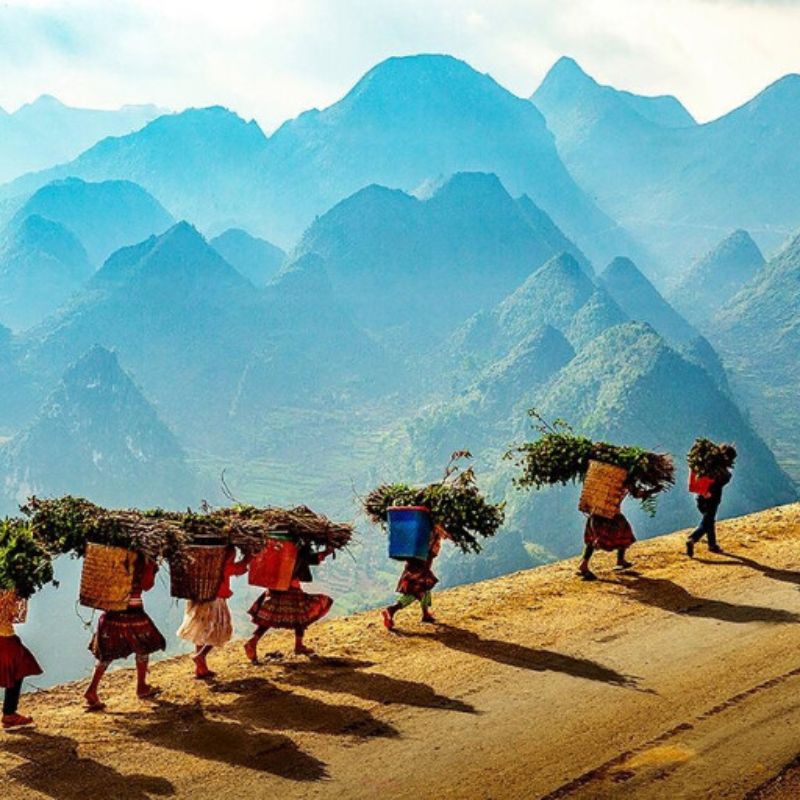
Even though the weather gets chilly in December, the Ha Giang loop offers serene surroundings, charming winter foliage, and misty valleys.
Additionally, from January to March, when the town is in the dry season with little rain, you can experience the Ha Giang loop. This is the time of year when you can enjoy the festive atmosphere of the Lunar New Year.
The top highlights of the scenic Ha Giang loop
The Ha Giang Loop, a breathtaking journey through Vietnam’s northernmost province, is renowned for its stunning landscapes, rich cultural heritage, and thrilling roads. Here are the top highlights along the loop:
Quan Ba Heaven Gate
Quan Ba Heaven Gate is more than just a geographical marker; it’s a stunning natural gateway to the wonders of Ha Giang. Situated at a high altitude, it offers breathtaking views of the verdant Tam Son valley below, characterized by its serene beauty and distinctive twin hills. This spot is not only a visual treat but also an ideal place for photography enthusiasts. The Heaven Gate’s elevation gives a sense of being on top of the world, making it a memorable start to the Ha Giang Loop adventure.
The Twin Mountains (Fairy Bosom)
The Twin Mountains, locally known as the Fairy Bosom, are nestled near Tam Son town. These unique hills, resembling the shape of a woman’s bosom, are steeped in local folklore and are considered a symbol of fertility by the indigenous people. The surrounding landscape, with its rice fields and traditional houses, adds to the charm of this natural attraction. The site’s blend of natural beauty and cultural significance makes it a must-visit spot on the loop.
Ma Pi Leng Pass
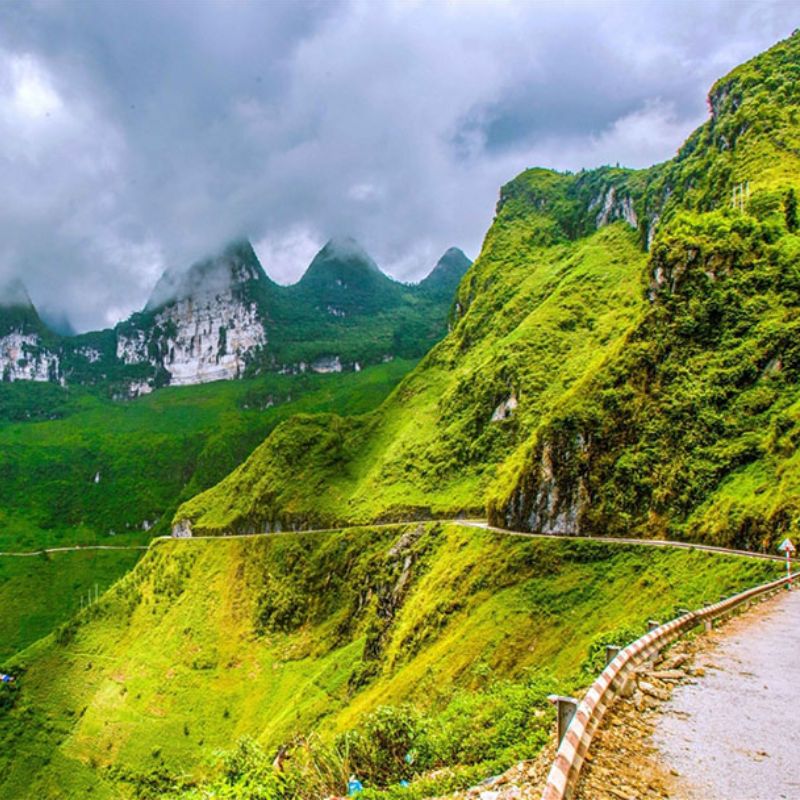
Ma Pi Leng Pass is one of the most spectacular roads in Vietnam, often referred to as the “King of the Vietnamese mountain passes.” This challenging road snakes through towering cliffs and deep valleys, offering dramatic and awe-inspiring views, especially from the famous Ma Pi Leng viewpoint. It’s a paradise for motorbike enthusiasts, with its hairpin bends and steep inclines providing an exhilarating riding experience. The pass connects Dong Van and Meo Vac towns and is a highlight for anyone seeking adventure and unparalleled natural beauty.
Dong Van Old Quarter
The Dong Van Old Quarter is a quaint and historical part of Dong Van town, showcasing a blend of traditional H’Mong and Chinese architectural styles. The old quarter’s narrow streets, lined with old houses made of clay bricks and tiled roofs, evoke a sense of stepping back in time. It’s a great place to explore on foot, discover unique local handicrafts, and sample traditional foods. The weekly market is a cultural spectacle, bringing together various ethnic groups in a vibrant display of customs and commerce.
Lung Cu Flag Tower
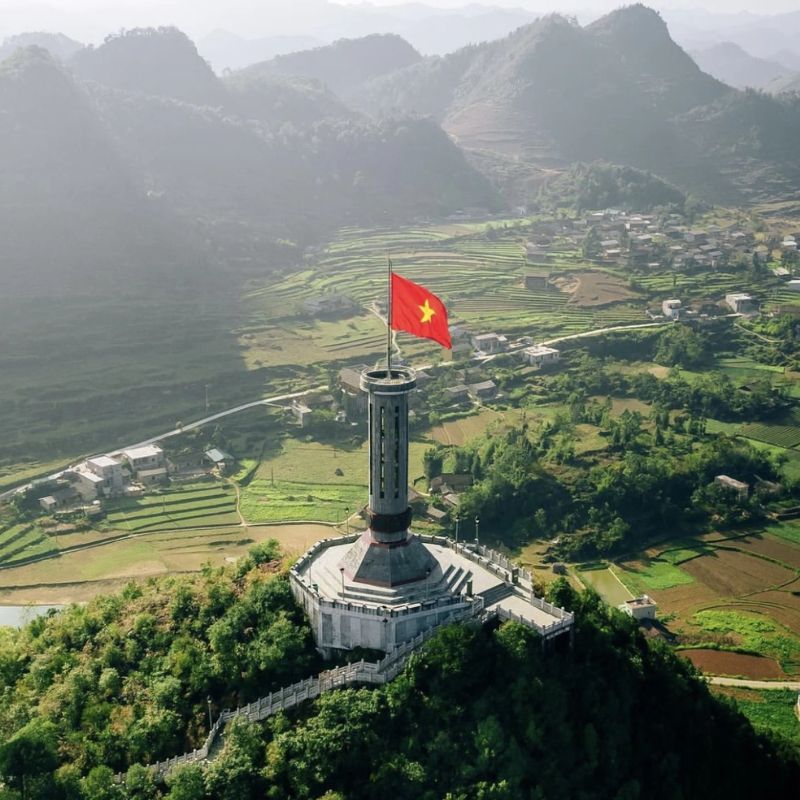
Situated near Dong Van, the Lung Cu Flag Tower marks the northernmost point of Vietnam. It’s a symbol of national pride, standing tall and overlooking the scenic landscape that borders China. Visitors can climb to the top of the tower, where a large Vietnamese flag flies, offering panoramic views of the surrounding hills and valleys. The site is not only a tourist attraction but also a poignant reminder of Vietnam’s historical struggles and triumphs.
Hoang Su Phi Rice Terraces
The Hoang Su Phi Rice Terraces are a breathtaking sight, especially during the planting and harvesting seasons when they turn into a mosaic of vibrant greens and golden yellows. These terraces are not just agricultural feats but also a testament to the ethnic groups’ harmonious relationship with nature. Exploring these terraces offers a peaceful and picturesque experience, allowing visitors to appreciate the intricate and labor-intensive farming practices of the local communities.
Ha Giang loop 4 days itinerary
4D5N Ha Giang Loop Mototbike Tour from Hanoi [Book Now]
Day 1: Hanoi – Ha Giang – 0km Milestone – Quan Ba Twin Mountains – Pho Bang
It takes around 6 hours to travel from Hanoi to Ha Giang by bus. For time efficiency and to maximize enjoyment, consider catching an early morning bus and resting during the journey. Upon arrival, rent a motorbike to begin your exploration of Ha Giang. Be careful to secure your luggage neatly on the bike and take a short rest before starting your adventure.
Quan Ba – Yen Minh
In Quan Ba, two must-visit spots are the Quan Ba Twin Mountains and the 0km Milestone.
0km Milestone
Located in the center of Ha Giang city, this spot is easy to find and marks the intersection between Ha Noi city and Ha Giang region. Enjoy a leisurely breakfast in the city before heading here for photos.
Address: P. Nguyen Trai, Ha Giang city, Ha Giang province.
Quan Ba Twin Mountains
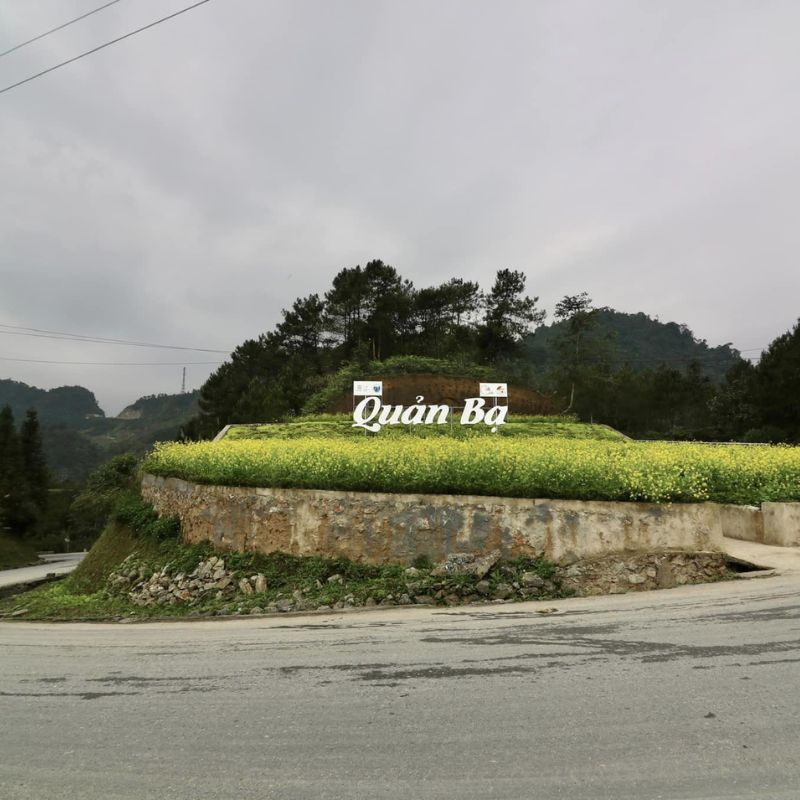
Also known as the Fairy Bosom, the Quan Ba Twin Mountains surprise visitors with their magnificent natural formation. Located amidst vast green rice fields, the view from above is poetic and breathtaking. It’s about 46km north of Ha Giang city, past the Bac Sum slope. A few kilometers further, you’ll find the Quan Ba Heaven Gate, a popular spot in the travel community, marking the start of the Happiness Road leading to the Dong Van Plateau. Here, you can relax, enjoy a coffee, and admire the clouds and scenery.
Shortly after, you’ll see the famous Lone Tree on the road to Yen Minh, another popular check-in spot. Upon reaching Yen Minh town, have lunch and rest to prepare for the afternoon journey to Pho Bang.
Rest and Dinner in Pho Bang
Consider staying at an interesting homestay built in traditional H’mong architecture, like Lao Xa’s ancient house. Here, you can experience the unique culture of the ethnic groups. Pho Bang town doesn’t offer many activities for tourists in the evening, so take this opportunity to rest after a long day and prepare for the trip to Dong Van the next day.
Day 2: Dong Van Stone Plateau – Lung Cu Flag Tower
Dong Van Stone Plateau
Recognized by UNESCO as a global geopark, the Dong Van Stone Plateau holds significant geological history. The unique karst landscapes and the serene life of the local people here are indescribably beautiful.
Dong Van Town – Dong Van Old Quarter – Lung Cu Flag Tower
The second night of your 4-day, 3-night Ha Giang trip will be in Dong Van town. Here, you can choose from a variety of hotels, homestays, and guesthouses. Dong Van is busier than Pho Bang and offers a wider range of food and accommodation options.
The Old Quarter preserves the unique culture of the H’Mong people and hosts famous markets attracting many visitors. The ancient stone houses and mossy stone fences give a sense of tranquility and authenticity.
The Lung Cu Flag Tower is a historical landmark and the northernmost point of Vietnam. From the waiting area, climb 279 steps to the Dragon Mountain peak, where the flag tower stands. Although the climb is challenging, it’s a proud moment to reach this historical checkpoint. The view of the Then Pa fields and the peaceful life of the H’Mong people in Lo Lo Chai village is an unforgettable sight.
Day 3: Ma Pi Leng Pass – Nho Que River – Meo Vac
Ready for day 3 of your trip? The more you explore Ha Giang, the more breathtaking landscapes you’ll discover in this northern region of Vietnam.
Following the Happiness Road, you’ll encounter Ma Pi Leng Pass, one of the four great passes in Northern Vietnam. Characterized by hairpin turns, with hills on one side and valleys on the other, it’s a magnet for bikers who wish to conquer this route. For thrill-seekers, there are daunting check-in points like the Death Stone Cliff and White Rock Cliff.
Nho Que River – Tu San Alley
A highlight of the third day is a boat trip along the Nho Que River. From Ma Pi Leng, head to the boat dock at Xin Cai or Ta Lang village. Be prepared for a winding 2km walk to reach the dock. Carry light gear and wear proper shoes.
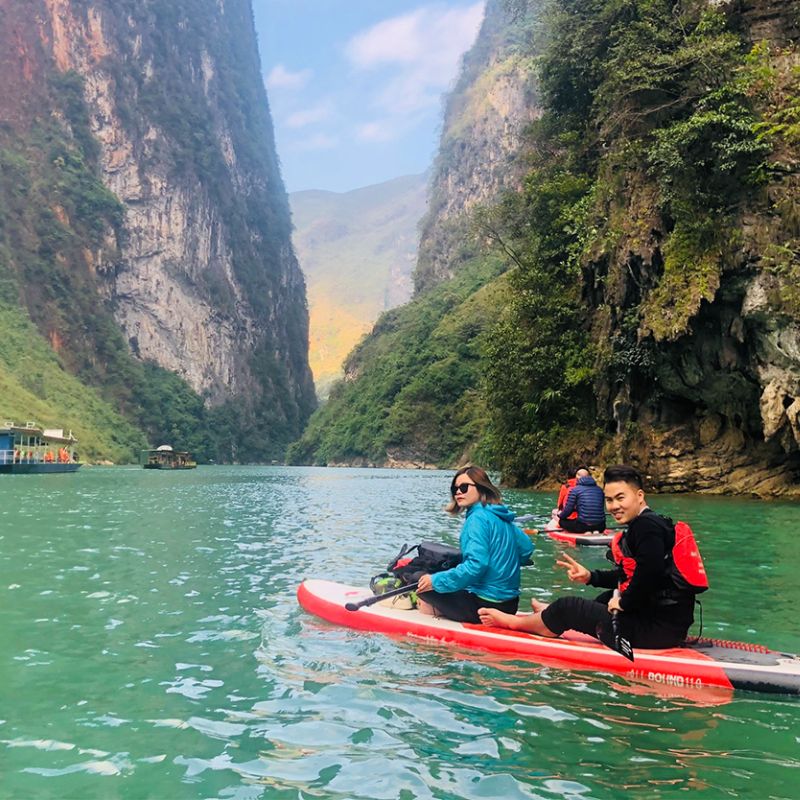
Boat options on the Nho Que River include:
- Motorboats: Prices vary from 100,000 to 150,000 VND per person, often shared or for group guests.
- Manual boats: Choose between iron or wooden boats. If inexperienced, you can hire a rower for 100,000 to 150,000 VND per person.
- Kayaks: The cheapest option at about 50,000 VND per person, but ensure you have kayaking experience, good health, and can swim.
Floating down the Nho Que River, the Tu San Alley, the deepest gorge in Southeast Asia, comes into view with its majestic, towering cliffs. You might even spot a group of langurs native to this area.
Meo Vac Town
After a long day of exploration, head to Meo Vac for the third night’s stay. The town offers a variety of guesthouses, hotels, and homestays. For an ethnic experience, consider staying in a homestay as suggested by Klook.
Day 4: Meo Vac – Ha Giang City – Hanoi
Explore Meo Vac
If you visit around March or April according to the lunar calendar, check out the famous Khau Vai Love Market in Meo Vac. Additionally, you can explore the Lo Lo cultural village and engage in artistic or community activities. Don’t miss trying local specialties like five-color sticky rice, green vegetables, Au Tau porridge, grilled moss, men men (steamed cornmeal), and corn wine with yeast.
Return to Ha Giang City – Back to Hanoi
From Meo Vac, there are three routes back to Ha Giang. You can follow the same route as Day 1 through Yen Minh – Quan Ba. For a more adventurous route, consider the Mau Due-Lung Ho route, which is more challenging and suitable for experienced riders. The last route, the easiest and longest, takes you along QL4C then down to QL34, passing through Cao Bang province. Choose the route that best fits your time and personal schedule.
Where to Stay in Ha Giang
There are several places to stay along the Ha Giang Loop road trip, even though it’s the less-traveled route. Here is where to stay in the town of Ha-Giang, but we’ve highlighted the best spots to stay along the Ha-Giang in our itinerary below:
Homestays in Ha Giang
Traditional Ethnic Homestays: For an authentic experience, consider staying at places like Yen Minh Homestay in a small village, where you can immerse yourself in the daily life of ethnic groups such as the H’Mong and Dao. Another great option is Lo Lo Homestay in Meo Vac, known for its traditional architecture and communal dining experiences.
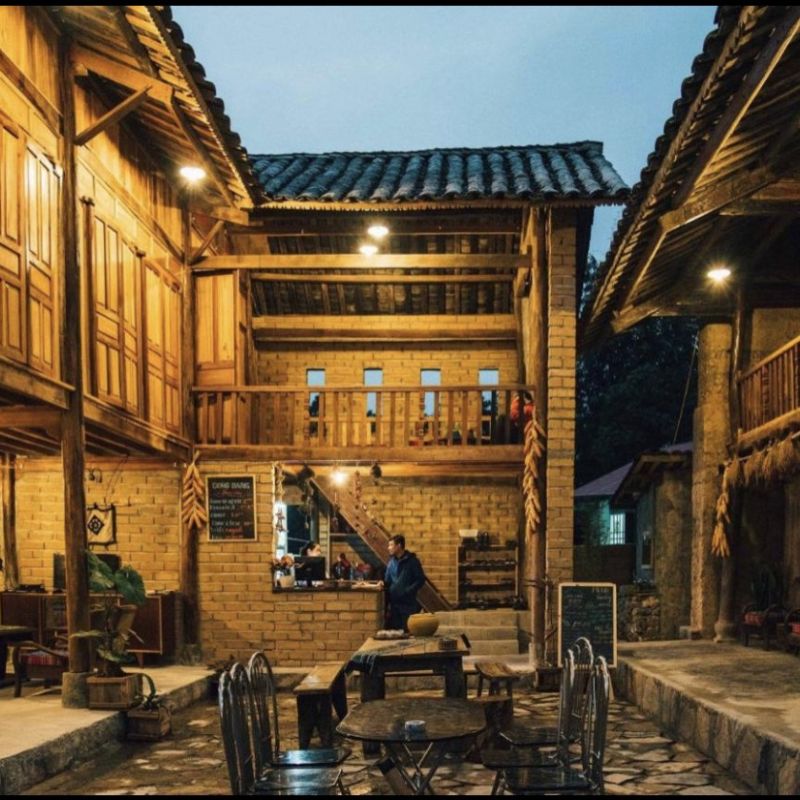
Eco-Friendly Homestays: Du Gia Eco Homestay in Du Gia offers an eco-tourism experience with its organic gardens and involvement in local sustainability projects. This homestay blends traditional practices with a focus on environmental conservation.
Hotels and Guesthouses
Budget Guesthouses: In Ha Giang city, Truong Xuan Resort is a popular choice, known for its family-run hospitality and basic yet comfortable amenities. Another option is Lam Tung Hotel in Dong Van, which offers a budget-friendly stay with essential facilities.
Mid-Range Hotels: For more comfort, consider Hoang Su Phi Lodge in Hoang Su Phi district. This hotel offers modern facilities, including Wi-Fi and on-site dining, in a more traditional setting. Kiki’s House in Ha Giang City is another mid-range hotel that provides a good balance between comfort and local charm.
Resorts and Boutique Hotels
Boutique Hotels: Auberge de Meo Vac – Mountain Lodge is a boutique hotel in Meo Vac, showcasing unique local art and textiles in its decor. The hotel offers a cozy and personalized experience.
Resorts: Pan Hou Village Eco Resort in Hoang Su Phi is set in a picturesque location and provides high-end amenities like a spa and gourmet dining. This resort is ideal for travelers looking for luxury in a natural setting.
Camping and Adventure Lodges
Camping Sites: Nam Dam Village Camping offers organized camping experiences where you can enjoy the beautiful landscapes of Ha Giang in a close-to-nature setting.
Adventure Lodges: Jungleman Homestay & Adventure in Ha Giang city caters to outdoor enthusiasts with activities like trekking and motorbiking. It’s a perfect base for those seeking adventure and cultural exploration.
Which bike to choose for the Ha Giang Loop Road Trip?
Choosing the right motorbike for the Ha Giang Loop is crucial for a safe and enjoyable journey. Here are some popular bike options:

Honda Wave/Semi-automatic Bikes:
- Engine: Around 110cc.
- Suitability: Ideal for beginners due to their light weight and ease of handling.
- Pros: Fuel-efficient and reliable.
- Cons: Less power for steep inclines.
Honda XR or Yamaha XTZ (Manual Bikes):
- Engine: 150cc to 250cc.
- Suitability: Best for experienced riders; offers more power and control on rugged terrains.
- Pros: Better for steep and challenging parts of the loop.
- Cons: Can be more challenging for less experienced riders.
Honda Winner (Sports Bike):
- Engine: 150cc.
- Suitability: Good for those who are comfortable with manual transmission but want something lighter than the XR or XTZ.
- Pros: Agile and fun to ride.
- Cons: Less comfortable for very long rides.
Scooters (Automatic):
- Engine: 110cc to 125cc.
- Suitability: Suitable for riders who prefer automatic transmission.
- Pros: Easy to ride, especially in towns.
- Cons: Less power, not ideal for very steep roads.
Adventure and Dual-Sport Bikes:
- Engine: 250cc and above.
- Suitability: For experienced riders who seek comfort and power.
- Pros: Great for all types of roads, better shock absorption.
- Cons: More expensive and heavier.
What to pack for a Ha Giang Loop?
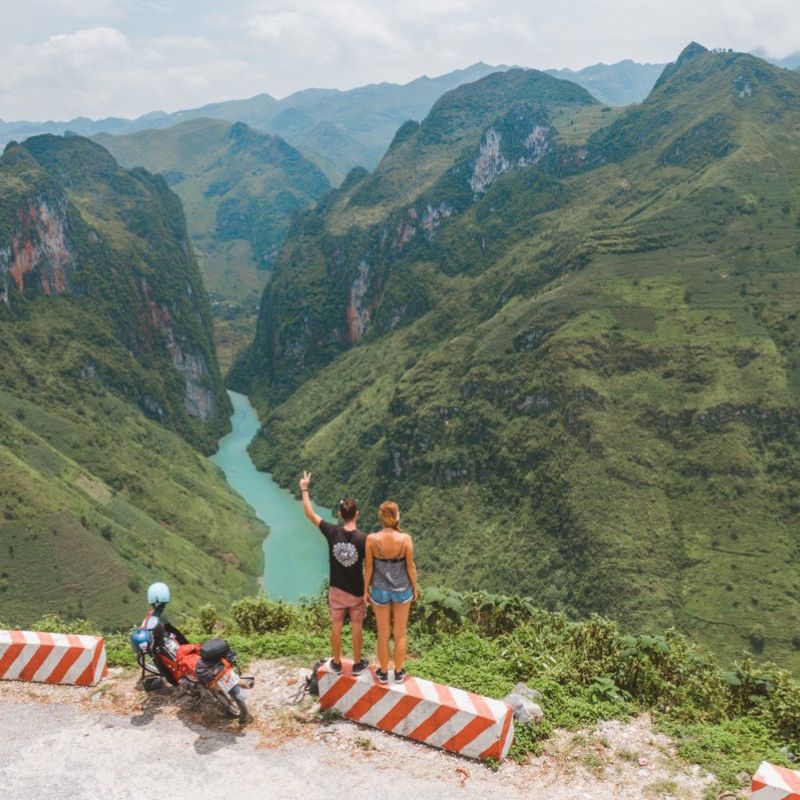
You should choose attire suitable for the weather conditions and sightseeing locations. The temperature in Ha Giang can be quite low. Therefore, when traveling to Ha Giang, you should wear warm clothing.
Prepare a detailed itinerary for exploring Ha Giang to ensure your trip goes smoothly.
Consider having a few alternative destinations in case the places you plan to visit are not operational or if there are access issues.
Be sure to pack everything you need for your Ha Giang trip, including clothes, a jacket, sunglasses, hats, shoes, sunscreen, raincoat, necessary medications, and personal items.
Carry enough cash to avoid theft or loss.
Bring a power bank for your phone in case of battery depletion.
You can prepare some snacks or educational materials as gifts for the ethnic children.
How much does the Ha Giang loop cost?
The cost of doing the Ha Giang Loop in Vietnam can vary significantly based on several factors, including your choice of accommodation, transportation, food, and other personal expenses. Here’s a breakdown to give you a rough estimate:
Transportation
- Motorbike Rental: Approximately 150,000 – 200,000 VND per day ($6 – $9 USD).
- Fuel: Around 100,000 VND per day ($4.5 USD), depending on your bike and how much you ride.
- Bus from Hanoi to Ha Giang: Around 200,000 – 300,000 VND each way ($9 – $13 USD).
Accommodation
- Homestays/Guesthouses: Ranging from 100,000 to 300,000 VND per night ($4.5 – $13 USD).
- Hotels: For more upscale options, prices can range from 500,000 VND and above per night ($22 USD and above).
Food and Drink
- Local Meals: Approximately 30,000 – 50,000 VND per meal ($1.3 – $2.2 USD).
- Western Meals: Can be more expensive, around 100,000 – 200,000 VND ($4.5 – $9 USD).
Miscellaneous
- Entrance Fees: Some attractions have small entrance fees, typically around 10,000 – 50,000 VND ($0.5 – $2.2 USD).
- Emergency Funds: It’s always wise to have a little extra for unexpected expenses.
Total Estimated Cost
- Budget Traveler: Averaging 600,000 – 800,000 VND per day ($26 – $35 USD), including all expenses.
- Mid-range Traveler: Approximately 1,000,000 – 1,500,000 VND per day ($44 – $65 USD).
- Luxury Traveler: 2,000,000 VND per day and above ($87 USD and above).
Final thoughts and travel tips
Embarking on the Ha Giang Loop is the adventure of a lifetime, offering breathtaking landscapes, rich cultural experiences, and a sense of freedom on the open roads. To ensure a memorable and safe journey, here are some travel tips:
Safety First: Always wear a helmet while riding. Drive cautiously, especially on unfamiliar mountain roads.
Health Precautions: Carry basic first aid and any personal medications. Be prepared for altitude changes and potential motion sickness.
Local SIM Card : Having a local SIM card is invaluable for navigation and in case of emergencies.
Weather Preparedness: The weather can be unpredictable. Pack for cold and rainy conditions, especially if traveling during the cooler months.
Language Barrier: Learning a few basic Vietnamese phrases can be helpful. A translation app can also be beneficial.
Cash is King : Many places in Ha Giang may not accept credit cards. Ensure you have enough cash, especially when traveling in remote areas.
Travel Insurance: Consider getting travel insurance that covers motorbiking, especially if you’re renting a bike.
Plan But Be Flexible: While having an itinerary is great, be open to deviating from it. Sometimes the best experiences are unplanned.
Pack Lightly: Only carry essentials on your bike to make your ride more comfortable and manageable.
Stay Connected: Inform someone about your travel plans and check in regularly, especially if traveling alone.
The Ha Giang Loop is a famously beautiful route that enthralls travelers with its stunning scenery, rich cultural history, and friendly locals. Travelers will have an amazing experience riding this well-known motorbike route in Northern Vietnam, which passes through colorful ethnic villages, breathtaking mountain passes, and picturesque valleys. Ha Giang doesn’t just offer a route; it offers a transformative experience, a chance to embrace the unexpected and a journey that challenges and changes you, making it a must-visit for anyone who yearns to experience the road less traveled.
How long does it take to complete the loop?
The duration to complete the Ha Giang Loop typically ranges from 3 to 5 days. This timeframe allows for a comfortable pace, enabling travelers to fully immerse themselves in the stunning landscapes and unique cultural experiences that the route offers. While it’s possible to rush through in a shorter period, it’s advisable to take the time to explore and appreciate the scenic stops, ethnic villages, and historical sites along the way. For those who wish to delve deeper into the local culture or engage in more extensive exploration, extending the trip beyond 5 days can be rewarding.
Is the Ha Giang Loop dangerous?
The Ha Giang Loop is known for its challenging terrain, featuring narrow, winding roads and steep inclines, which can present risks, particularly for inexperienced motorbike riders. The mountainous route demands cautious and responsible riding, as conditions can vary with weather changes and road surfaces. While it’s not inherently dangerous for prepared and skilled riders, it does require a heightened sense of awareness and respect for local traffic norms. For those not confident in their riding abilities, it’s advisable to join a guided tour or hire a driver.
Can I do the loop if I don’t ride a motorbike?
Yes, you can experience the Ha Giang Loop even if you don’t ride a motorbike. There are alternative options such as joining organized tours that use cars or minibusses, which provide a safe and comfortable way to explore the stunning landscapes and cultural highlights of Ha Giang. These guided tours often include stops at all the major attractions along the loop and offer the added benefit of experienced guides who provide valuable insights into the local culture and history.
Additionally, for those who prefer a more personalized experience, hiring a private car with a driver is another viable option. This allows for a flexible itinerary tailored to your interests and pace, ensuring you don’t miss out on the incredible experience the Ha Giang Loop offers.
I'm Trang, the wanderlust-driven spirit behind these travel tales. Born with a heart that yearns to roam and eyes that seek the beauty in the diverse corners of our planet, I’ve ventured far and wide, gathering not just memories but stories, experiences, and a profound appreciation for the world's tapestry of life. Each destination I've visited has been a teacher of its own, imparting lessons of history, humanity, and the boundless wonders of nature. Through my blog, I aim to be your guide, not just in navigating the physical landscapes but in experiencing the soul and essence of each place. Join me as we journey together, one story at a time, unraveling the globe's myriad mysteries. Whether you're a seasoned traveler or just beginning to scratch that travel itch, I hope to ignite in you the same burning passion for exploration that guides me.
Leave a Reply Cancel reply
Your email address will not be published. Required fields are marked *
Save my name, email, and website in this browser for the next time I comment.
Username or email address *
Password *
Remember me Log in
Lost your password?
Ha Giang travel guide: Journey to the Untamed Beauty of Vietnam
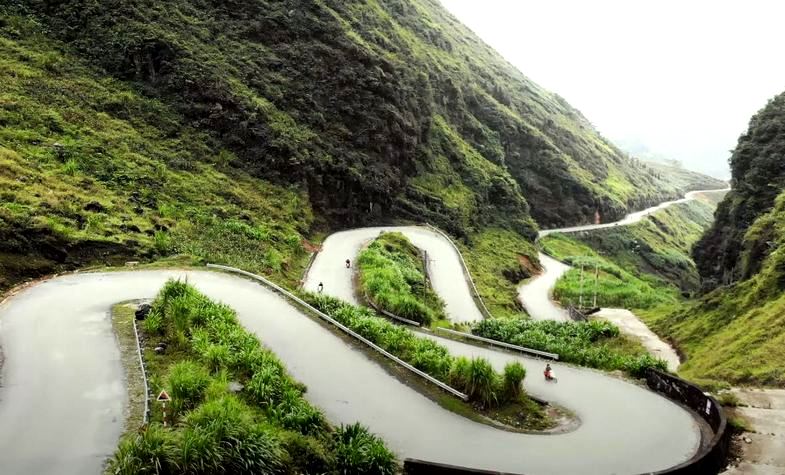
Ha Giang is a province located in the Northeast region, with an area of nearly 8,000 square kilometers. This place is blessed with a diverse ecosystem of forests, mountains and rivers. Ha Giang has always won the hearts of travelers from afar with majestic landmarks such as Ma Pi Leng Pass, Quan Ba Twin Mountain, Tu San Gorge and many long-standing cultural and historical sites such as Dong Van Old Town, Dong Van rock pass. Plateau. In addition, the province also has many unique ethnic villages with typical local culture. Therefore, if you are looking for a trip that is both beautiful, informative, and imbued with a spirit of adventure, then Ha Giang is the next must-see destination for you.
Table of Contents:
Best time to visit Ha Giang
Experience ha giang loop by motorbike, explore stunning roads and mountain passes, visit hoang su phi, colorful markets - a signature of ha giang, trekking ha giang, try specialties of ha giang.
Following to best Ha Giang travel guide , the best time to travel to this beautiful place is from September to March next year, not only because this is the season of ripe rice and blooming flowers, but also the time of spring festivals of ethnic communities in the mountainous region. Take note of the most brilliant milestones of Ha Giang to fully feel the beauty of this highland land.
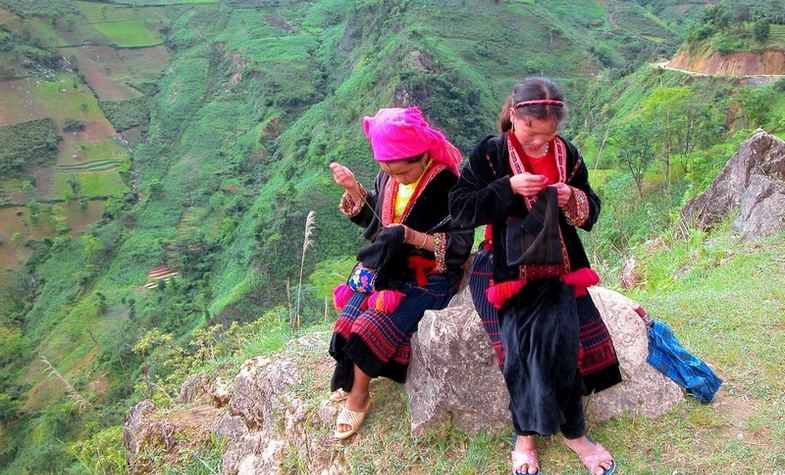
- August to October: This is the time when the terraced fields in Ha Giang are immersed in the golden color of ripe rice, the most beautiful is the Hoang Su Phi area.
- October to November: If you are fascinated by the beauty of buckwheat flowers, don't hesitate to plan a trip to Ha Giang between October and November. Don't forget to visit Lung Cu Flagpole, Lung Cam Cultural Village, Ma Pi Leng Pass, Thach Son Thanh - Quan Ba to see the most beautiful buckwheat flowers.
- January to Lunar New Year: Spring from January to March is the time when Ha Giang is filled with the colors of flowers such as yellow canola flower, white plum blossom, pink peach blossom. This is also the time when many unique festivals of the mountain town take place such as Gau Tao Festival of the Mong people, Long Tong Festival of the Tay people, Lap Province Festival of the Dao people.
What to do in Ha Giang?

Ha Giang loop by motorbike offers a unique and unforgettable way to experience the stunning landscapes and cultural heritage of the area, and the adventure of traveling the rugged mountain terrain by motorbike can be a thrilling experience.
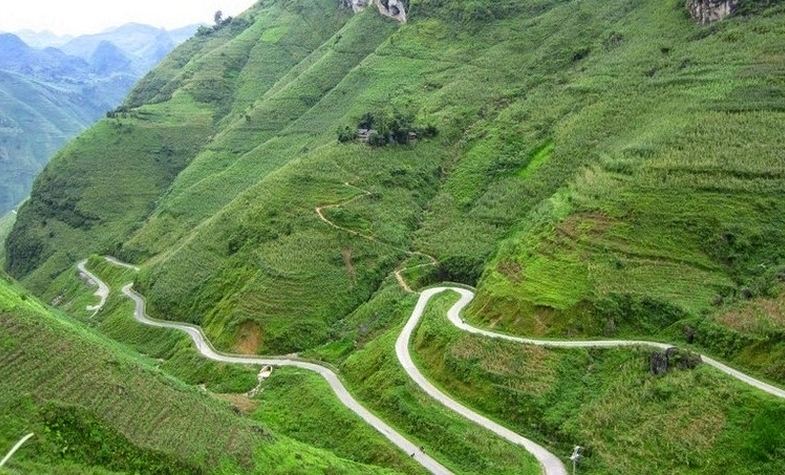
Exploring the dramatic mountains is one of best things to do in Ha Giang. There are plenty of mountains and pass roads to choose from, so we've handpicked some of the best for you. Quan Ba Heaven Gate is the first pass you will encounter on the way from Ha Giang, offering a beautiful view of the Twin Mountains. Next is Tham Ma pass with the iconic S-shaped road that runs through Sung La valley. From there, you can head straight to Dong Van or take a detour through Lung Cu, which has some of the most breathtaking mountain views. Ma Pi Leng Pass is the king of mountain roads in Vietnam, boasting steep cliffs and impressive views on the road from Dong Van to Meo Vac. Finally, expect more beautiful views of the mountains after Meo Vac as you head towards Du Gia through Mau Due.
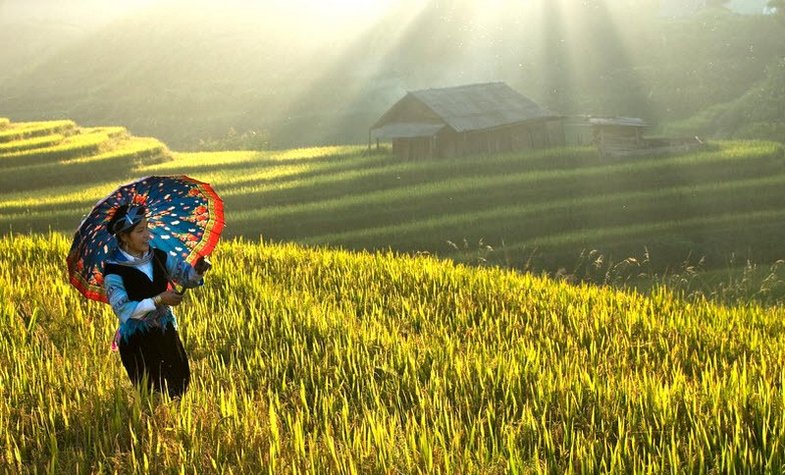
Hoang Su Phi in Ha Giang is known for its beautiful terraced fields that cover the hills and mountains creating a beautiful landscape. The terraced fields are considered the most beautiful in Vietnam with different colors and shapes through the seasons. In addition, local ethnic minorities, such as the Hmong and Dao, have preserved their traditional lifestyles and cultural practices, making it an interesting place to learn about customs. and their traditions.
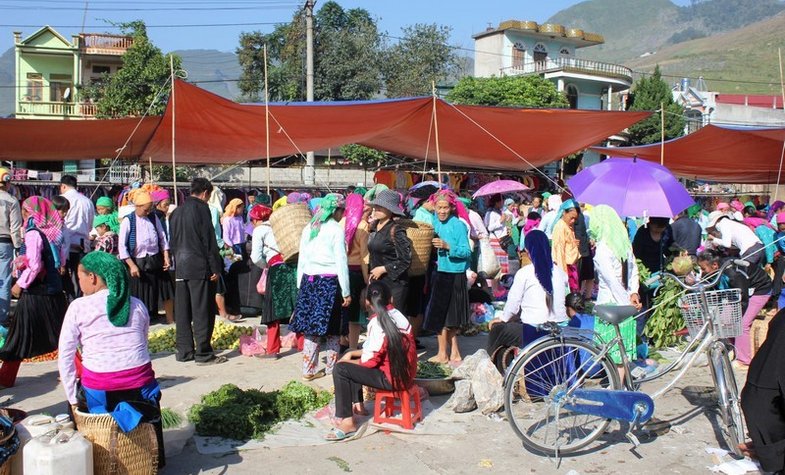
Colorful markets are a feature of Ha Giang and a unique aspect of the local culture. The market is the gathering place of ethnic groups in the area, coming to buy and sell a variety of goods. The markets are usually held once a week, but the specific dates vary depending on the location.
The markets are a great opportunity to experience local culture and see traditional clothing, crafts, and food. Visitors can also try local specialties such as thang co (soup made from beef or horse meat), yeast (a type of cornbread) and corn wine. In addition to food, the market also offers a variety of goods such as clothing, textiles, agricultural tools and handicrafts.
Some of the most famous markets in Ha Giang include Dong Van market, Meo Vac market and Lung Phin market. These markets are particularly vibrant and attract people from all over the region. Overall, visiting a colorful market is a must-do for anyone interested in experiencing Ha Giang's unique culture.
If you like climbing and hiking, Ha Giang is definitely a destination worth considering. The mountainous area is home to many climbing routes that offer breathtaking scenery and views. You can hike through rice terraces, visit remote hill tribe villages and soak up the local culture.
There are many hiking options available, ranging from easy hikes to challenging treks that require a high level of fitness. The most popular hiking route in Ha Giang is Dong Van Rock Plateau Geopark, which offers a variety of walking routes through stunning landscapes and secluded villages.
Ha Giang has a diverse culinary culture with a blend of ethnic minority cuisine and traditional Vietnamese dishes. Here are some must-try dishes when coming to Ha Giang:
Thang Co is perhaps one of the most famous specialties of the highland plateau. The main ingredient of this dish is meat and organs of buffalo, cow, or horse, sautéed and then simmered for several hours with typical mountainous spices and herbs. This dish is often sold in local markets. Don't forget to order a cup of fragrant and sweet corn wine to fully enjoy Thang Co as the way of the ethnic people!
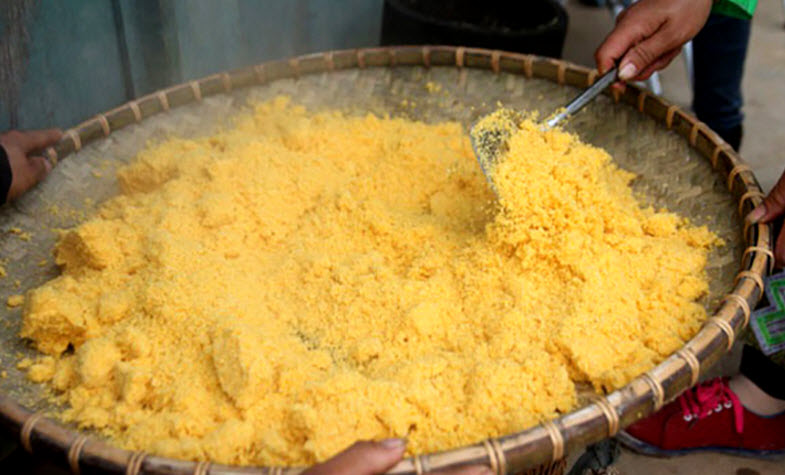
Men men, also known as corn cake, is a traditional steamed cornmeal dish of the Mong people. After each corn season, mature corn kernels are separated and ground into a fine powder before being steamed with water. To ensure it is delicious, Mèn mén should be steamed over low heat and with enough water to prevent it from drying out.
Au Tau Porridge
Also known as bitter porridge, is made from the poisonous Au Tau root that is abundant in the mountainous areas of the North. The root is soaked in rice water overnight and then boiled for four hours until thickened, which usually takes about four hours. Then it is cooked with pork bone broth and pork leg meat. Au Tau Porridge is delicious when served hot with spring onions, Vietnamese balm, raw egg yolk, and minced meat.
- Five-color sticky rice : a colorful dish made from glutinous rice and natural food coloring from leaves and flowers.
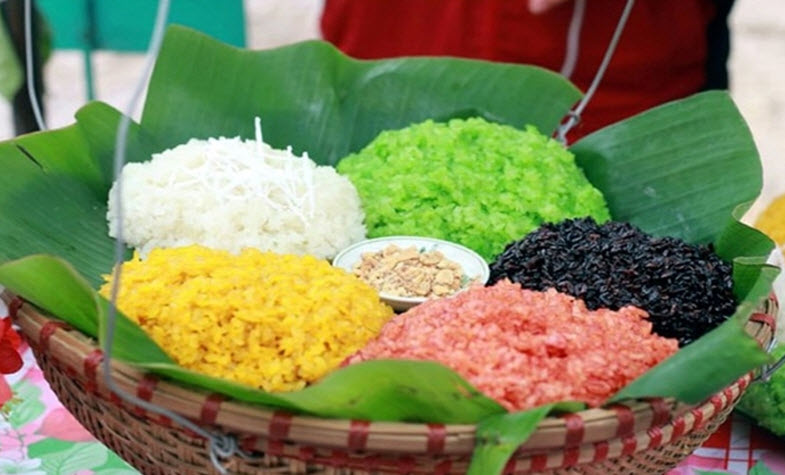
- Bac Me Chicken : Chicken served with a dipping sauce made from salt and lemon.
- Smoked buffalo meat : is a specialty of ethnic minorities in Ha Giang, the meat is often seasoned with spices and smoked for preservation.
- Barbecue : There are many grilled dishes to try in Ha Giang, including grilled pork, grilled goat and grilled sticky rice.
- Thanh Minh duck hot pot : hot pot dish is made from duck meat with herbs and local spices.
- Local fruits : Ha Giang is known for its delicious fresh fruits, including peaches, plums, pears and persimmons.
In conclusion, Ha Giang is a hidden gem in northern Vietnam that offers stunning natural beauty, unique culture, and delicious cuisine. From the famous Ha Giang loop to the colorful ethnic markets, and the traditional dishes like Thang Co and Men Men, there are many reasons to visit and explore this beautiful province.
Maybe you like our Vietnam off thebeaten track tours : Northeast Vietnam soft adventure tour | Binh Lieu trekking experience 3 days
*** Travel Authentic Asia Company is your best choice for discovering the beauty of Southeast Asia. Our experienced and knowledgeable travel advisors are committed to helping you create a tailor-made tour and extraordinary experiences in this majestic region.
If you're looking for an authentic cultural experience, do not hesitate to contact Travel Authentic Asia to choose a Vietnam tour or to customize your own style tour to Southeast Asia.
Vietnam bestselling tours
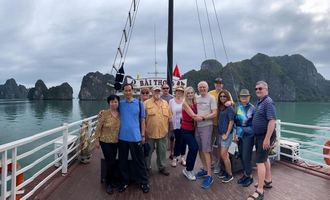
Spectacular Vietnam - 2 Weeks
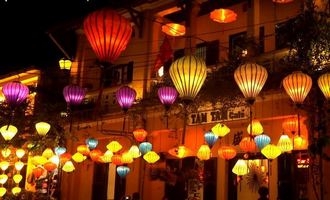
Vietnam discovery tour of highlights from North to South
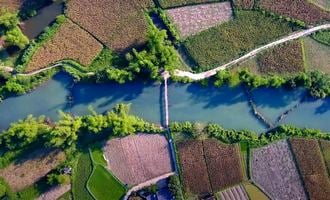
Northeast Vietnam soft adventure tour

Ha Giang Loop Adventure Tour
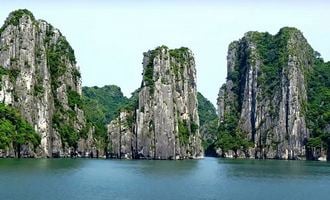
One-week Vietnam tour of amazing cities, mountains & bay

Vietnam Family Tours Of Real-life Experiences
Tours in other destinations.

Southeast Asia
.jpg)
HA GIANG TRAVEL GUIDE Attractions - Top Things to do - Best time to come - and more...
Nestled in the far north of Vietnam, Ha Giang Province beckons to intrepid travelers with its untamed landscapes and vibrant ethnic cultures. This concise guide unveils the beauty and adventure that await you in Ha Giang, from its dramatic mountain passes and terraced fields to its rich tapestry of hill tribe traditions. Discover the essentials for an unforgettable journey through this remote gem in northern Vietnam.

Dong Van Karst Geopark: Vietnam's Geological Marvel

The Best Time to Visit Ha Giang: A Seasonal Guide

Trekking Tours in Ha Giang: Exploring the Rugged Beauty of Northern Vietnam

Ha Giang Travel Guide: Exploring Vietnam's Hidden Gem

The Enchanting Buckwheat Flower Season in Ha Giang

Hoang Su Phi Rice Terraces: A Verdant Tapestry of Northern Vietnam

Top Things To Do in Ha Giang

Get Your Trip Customized
1:1 Support | Within 24h Response | Local Specialist
OTHER GREAT HA GIANG TOURS

RICE TERRACES AND KARSTS
Hanoi - Hoang Su Phi - Quang Ba - Dong Van - Meo Vac - Ba Be - Hanoi

ESSENTIAL HA GIANG
Hanoi - Ha Giang - Yen Minh - Dong Van - Meo Vac - Ha Giang - Hanoi

BA BE LAKE & KARST GEO-PARK
Hanoi - Ha Giang City - Dong Van - Meo Vac - Ba Be Lake - Hanoi

Ha Giang highlights and travel guide
Updated November 2023
Ha Giang at a glimpse
Located in the northernmost region of Vietnam, Ha Giang Province is famous for its stunning natural beauty, which includes towering limestone cliffs, deep valleys, and traditional villages. Several ethnic minority groups live in the region, each with their own culture and traditions.
Where is Ha Giang:
Ha Giang is located in Vietnam's Ha Giang region, approximately 310 kilometers north of Hanoi.
Going to Ha Giang from Hanoi
The best way to get to Ha Giang from Hanoi is to take a minibus, which takes around 6.5 hours and costs approximately 420,000 VND ($17)
The best time to visit Ha Giang
The best time to visit Ha Giang is from September to November when the weather is mild and dry.
What to see & do
Paradise for nature lovers and adventure seekers, Ha Giang is well-know for : The Ha Giang Loop : A 350-kilometer round-trip journey through majestic landscapes of pinnacle limestone cliffs, deep valleys, and traditional villages..
- The Dong Van Karst Plateau Geopark: A UNESCO-designated geopark that is home to ethereal 400 million years old karst formations.
- The Quan Ba Heaven Gate: A beautiful mountain pass with stunning views of the surrounding landscape..
- The Lung Cu Flag Tower: The northernmost point of Vietnam, with a tower that provides panoramic views of the surrounding countryside.
Where to stay
Ha Giang offers a range of accommodation options, including hotels, hostels, and homestays. Choose between Ha Giang Backpacker Hostel, Pao's Sapa Leisure Hotel or a Homestay, which offers a unique opportunity to experience the local culture and traditions by staying with a local family
What to taste
- Ha Giang is known for its rustic but delicious local cuisine, which includes:
- Thang Co, the traditional stew made with horse meat, organs, and bones.
- Au Tau Porridge, made with glutinous rice, ginger, and peanuts.
- Banh Cuon, a kind of steamed rice roll filled with minced pork and mushrooms.
Ha Giang overview
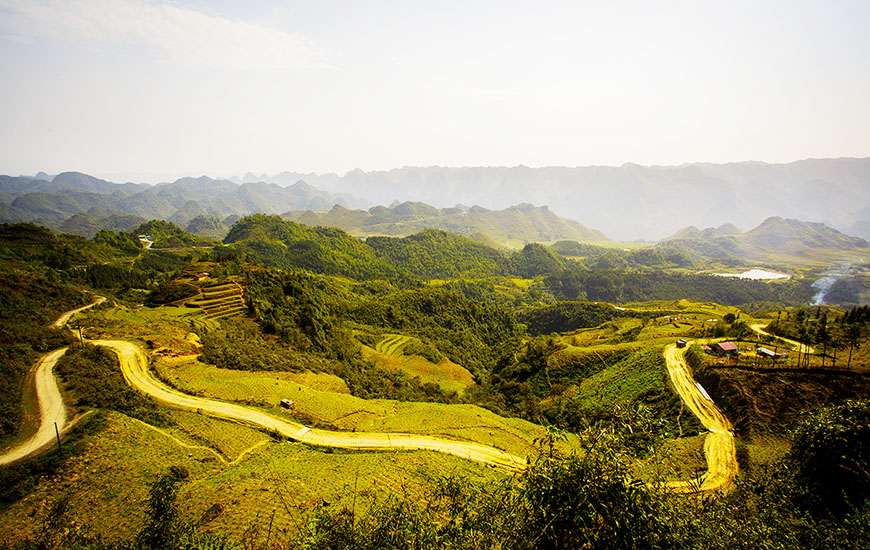
Culture and Arts
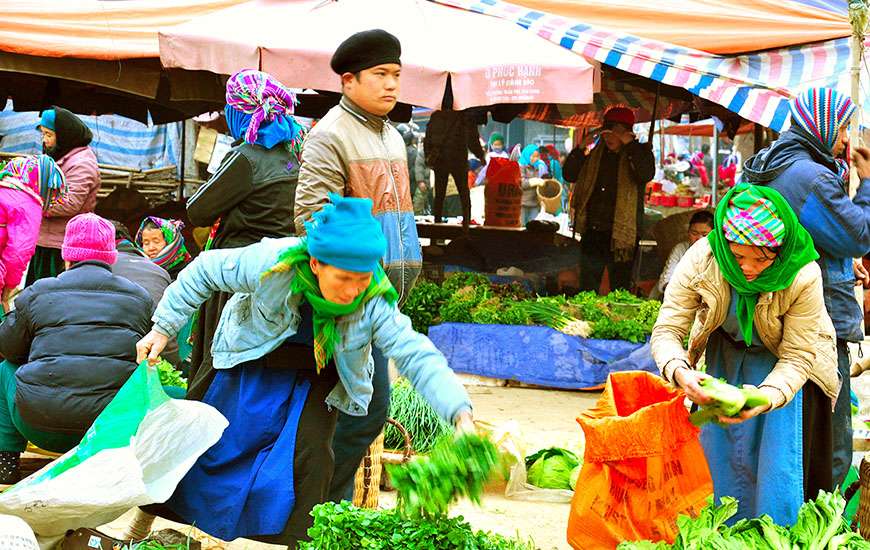
Festivals and Events
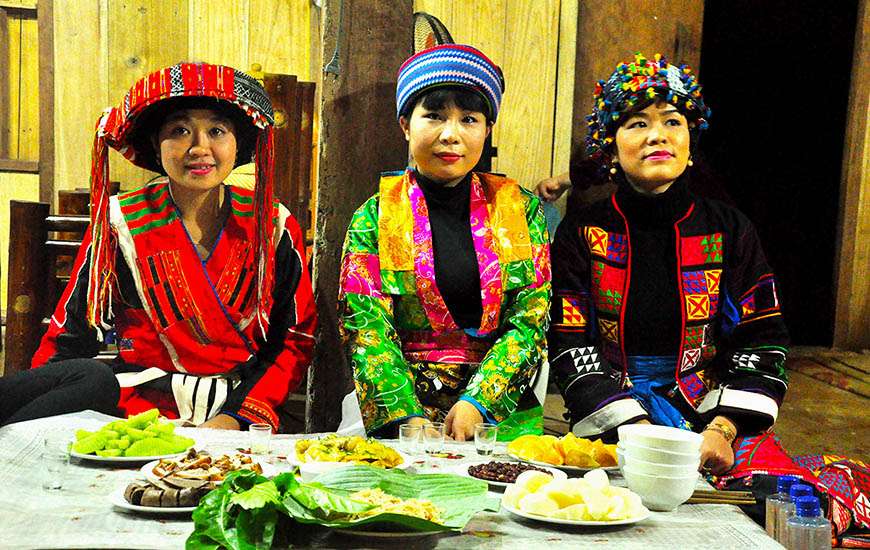
Food and Drink
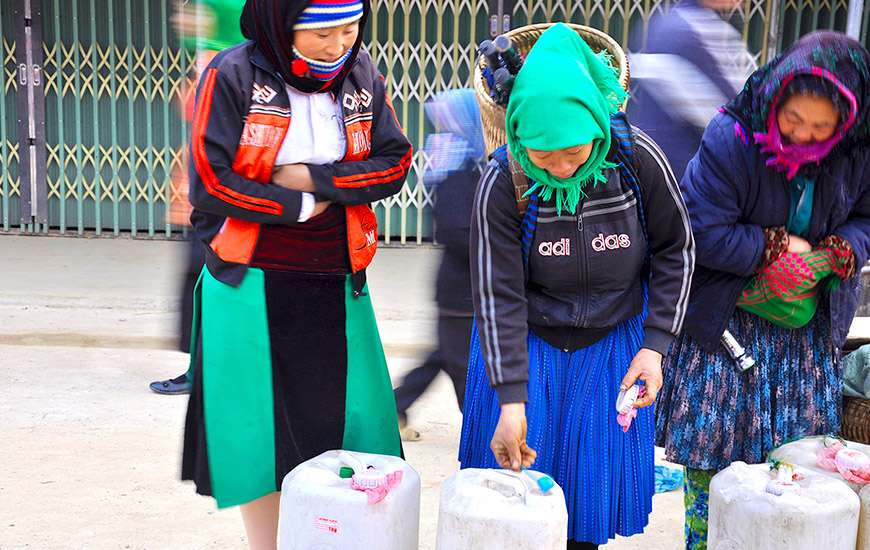
Trekking on the Trails of Northern Vietnam 9 days 8 nights
An exceptional journey Trekking on the Trails of Northern Vietnam - off the beaten track like no other to explore the most beautiful landscapes of North Vietnam and to meet the ethnic minorities such as the Dzao, black and flower Lo Lo, Hmong, Tay, Nung on the trails of Vietnam.
.jpg)
Ha Giang Hiking Trails 5 days 4 nights
Explore colourful ethnic groups and experience the sheer thrill of travelling along stunning roads that you'll never forget. This Ha Giang Hiking Trails totally off the beaten tracks will take you to the most impressive region of Vietnam, and over five days you will discover colourful local markets of the various ethnic minority communities, trek through the soaring mountains and experience the dizzying mountain passes of Dong Van and Ma Pi Leng.
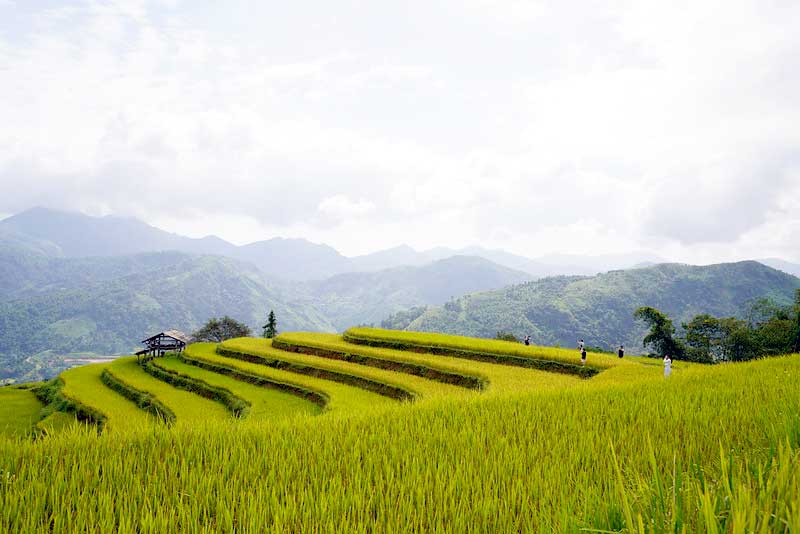
Trekking through Hoang Su Phi rice fields 4 days 3 nights
Everyone knows that Northern Vietnam is famous for its rice fields, buffaloes, ethnic villages. And this is a special tour to whom want to discover the truth off the beaten track, this trekking through Hoang Su Phi rice fields will take you to villages of La Chi people and the secret rice fields of Thong Nguyen. The lost destinations on tourist map.
In Association With


- Điều hướng nhanh
BEST TIME TO VISIT
What to explore, where to stay, what to eat, how to get there.
Ha Giang is just 300 kilometers from Hanoi, but the life that unfolds in the province is a world apart from most other places, given its topography and ethnic diversity.
Between September and November is the most ideal time to visit Ha Giang with dry climate and cool weather with average temperatures of 28 degrees Celsius.
From the end of September to early October marks the ripening of its terraced rice fields, which are a spellbinding sight.
Buckwheat flowers blooming in November is another unique sight in the northern highlands province.
Nestled in the middle of a valley, the Dong Van Old Quarter, also called Dong Van Old Town, is a unique gem in Vietnam’s final frontier that is surrounded by high rocky mountains and limestone formations.
The old town was formed in the early 20th century with a few Hmong, Tay and Chinese families settling down here.
Now, the town has 40 two-storied houses with a touch of Chinese architecture such as yin-yang tiled roofs, yellow walls and red lanterns hung on the gables.

Since 2006, the town has attracted tourists by organizing a lantern festival on the 14th, 15th and 16th days of each lunar month, around the full moon time. All the local families hang red lanterns, display their special product – ethnic brocade – and sell their traditional food in an effort to boost tourism, somewhat similar to what the more famous Hoi An ancient town has been doing.
Visitors pose for photos inside Hmong King’s Palace in Ha Giang. Photo by Ngoc Thanh
The palace consists of six two-storied houses with a total of 64 rooms, all connected to each other. The architecture features the Qing Dynasty style, with green pebbles, pine woods and terra-cotta tiles as the main building materials.
Admission fees cost VND20,000 per person.
Leaving Dong Van Town, a 25-kilometer road through steep paths and rugged mountains leads to the Lung Cu Flag Tower, which proclaims the nation’s territory and sovereignty, and is mark of pride for all Vietnamese citizens.
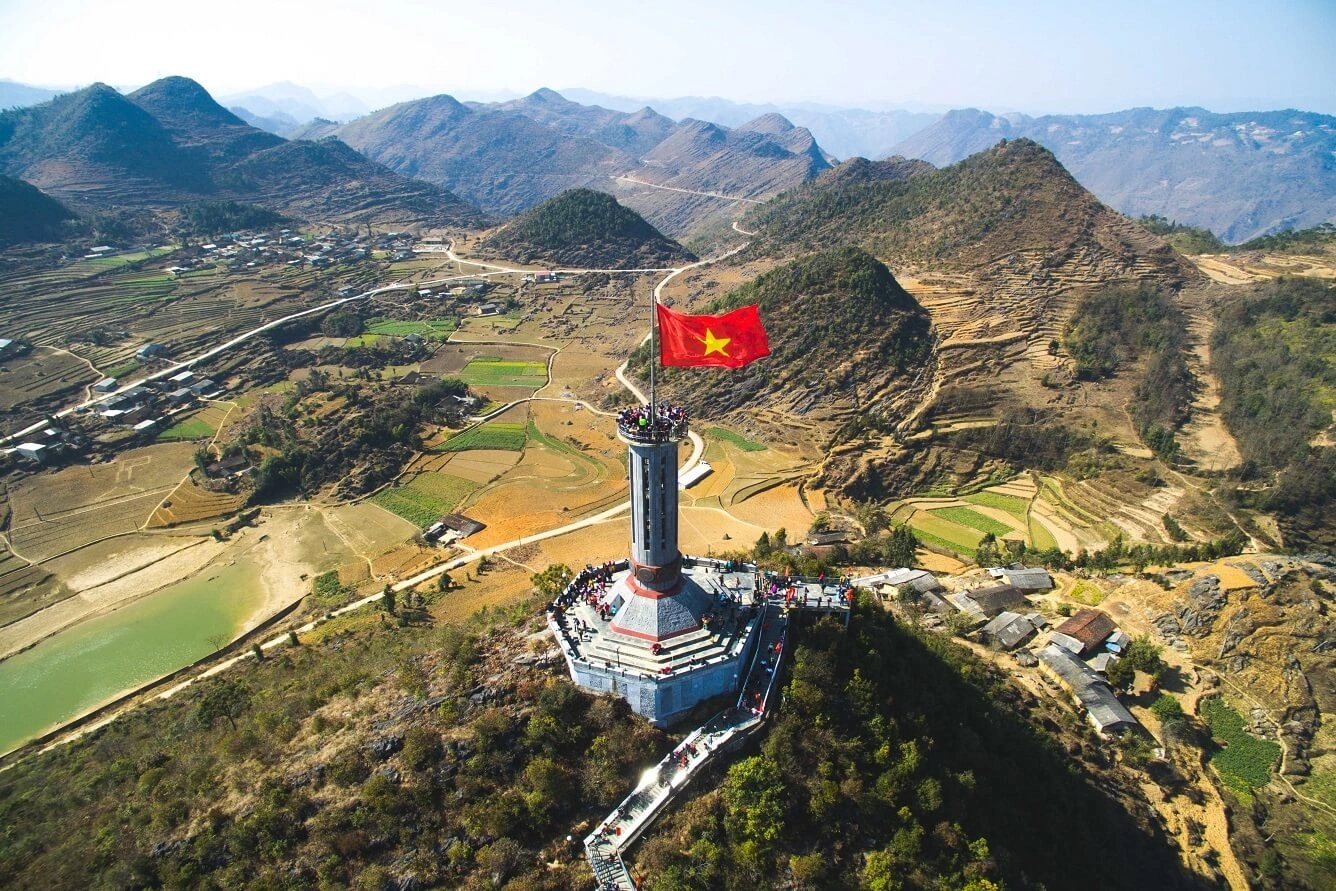
Built at the summit of Rong Mountain at the height of 1,700 meters above sea level, the octagonal monument is 33 meters tall and on top of the tower flies a 54-square-meter flag that represents 54 ethnic groups in Vietnam.
Visitors have to climb 389 stone steps and another 140 steps on a spiral iron staircase to get to the tower. A panoramic view of Ha Giang awaits those who reach the summit.
The Ma Pi Leng Pass is often described as one of the four most dangerous passes in Vietnam. Soaring over the pass is a mountain 2,000 meters high that is hugged tight by the Hanh Phuc (Happiness) Road connecting Ha Giang Town with the districts of Dong Van and Meo Vac.

The road was completed in 1965 after 11 years of construction mostly by workers belonging to the Hmong ethnic group.
Negotiating the pass is a tough task even for the most seasoned travelers and some foreign tourists have died driving off the pass.
"Ma Pi Leng pass is such a wonder of the world which lies right on the border of Vietnam and China. The pass offers breathtaking landscapes and exotic walking trails along the mount. Love this!" said Victor from Denmark.
"This might be one of the most beautiful places I've ever been to. A bit dangerous, I suggest you pay for a service with a driver," Zupanc Nina wrote on Tripadvisor.
Currently, some tour operators also offer one-day tours for inexperienced tourists to navigate Ma Pi Leng Pass. Experienced tour guides will take them through the rugged curves and steep cliffs.
Visitors can also request special photo stops along their way down Tu San, known as one of Southeast Asia’s deepest canyons.
There are 23 tourist boats that transport thousands of visitors who come to admire this majestic wonder every year.

"Before the Covid-19 outbreak, this place was crowded with tourists during weekends and holidays. Now we only get tourists traveling in groups to ensure safety," said boatman Trieu Chuong.
Along both sides of the river are rice fields planted by the Giay people.
Pho Tro , a small village on the outskirts of Pho Bang Town in Dong Van District, is characterized by traditional ‘trinh tuong’ houses with yin-yang tiled roofs.
As part of a rural renovation program, local authorities have improved infrastructure to develop tourism here. The village now has spacious headquarters and an elementary school. Cemented pathways provide easy access to every house. Households have received subsidies under the program to build bathrooms and indoor toilets.

As noted earlier, visiting Ha Giang from September until November is an opportunity to visit Hoang Su Phi District, famous for 3,000 hectares of terraced rice fields that form wavy, mesmerising golden yellow carpets.
There aren’t many places to stay in Hoang Su Phi, but homestays are available in villages or motels in Vinh Quang Town for VND250,000 to 550,000 ($10.68 to 23.50) a night.
It gets cold at nights and early in the morning, so taking a jacket along is a good idea when visiting Hoang Su Phi. Extra care has to be taken when driving on the road from Ha Giang Town to Hoang Su Phi because it’s narrow, winding and crowded with trucks.

Built atop a mountain in Yen Dinh Commune in Bac Me District, the P'apiu Resort is particularly favored by well-to-do couples who wish to enjoy a peaceful, secluded atmosphere and green landscapes.
The resort is also unique in that all its staff are local ethnic minority residents. Room prices start from VND9.8 million a night.
The Hmong Village resort in Quang Ba District, around 50 kilometers northeast of Ha Giang Town, has 25 bungalows surrounded by green trees and picturesque natural scenery.
Bungalows designed in the shape of rattan baskets that Hmong women sling on their backs to carry rice and other things are a distinctive feature of the resort.
It also has a community guesthouse that can accommodate up to 40 people at VND400,000 a night. A night's stay in the bungalows costs from VND2.4 million ($105.31).
Dong Van and Meo Vac districts offer budget-friendly homestays with prices ranging from VND100,000-230,000 per night.
Given the diversity of ethnic minority communities who live in Ha Giang, a culinary exploration of the province is a rewarding exercise.
The xoi ngu sac (five-colored sticky rice) – red, yellow, blue, purple and white – is made by using fruits, roots and leaves of plants. Glutinous rice is soaked in water for 6-8 hours and divided into five parts. Apart from the original white color, the other parts are dyed with a natural food coloring agent and steamed until tender.

The dish can be found at the weekly flea market in Dong Van Town.
From mid-October onwards, the Ha Giang rock plateau blooms with buckwheat flowers, a season which has already made the place a major tourist attraction. Residents use these flowers to make a signature dish - triangle buckwheat cake – that is difficult to find elsewhere.
The buckwheat seeds are harvested, dried and crushed into fine powder. The power is mixed with water to make flat round cakes that are then steamed for about 10 minutes. The cakes bought at the markets can be taken home as a special gift.

Tourists can buy this cake from street food vendors or food stalls in the Dong Van flea market.
Thang den is another signature dish made with glutinous rice flour in Ha Giang. It looks like banh troi , the cake with a sweet filling that is popular in Hanoi.
The thang den is made by mixing glutinous rice flour with sugar, shaped into balls and steamed. They are served with a syrup made with sweetened coconut milk and ginger. A bowl of thang den is topped with peanuts and/or black sesame seeds.

Though the steamed rice roll, banh cuon , is a popular dish in the north of the country, the version in Ha Giang is quite different. It is filled with pork/egg and mushroom, topped with dried shallots and served with a bowl of delicious bone broth flavored with fresh coriander, chopped scallions and Vietnamese pork sausage.
In Ha Giang’s chilly mornings, a bowl of hot broth with banh cuon makes for a great breakfast.

Banh cuon served with a bowl of hot broth is a popular breakfast in Ha Giang. Photo by Ngoc Thanh
The most popular restaurants to try this dish are: Ms.Ha’s stall at 31 Dong Van Town; and Ms. Cuc’s stall opposite to Ha Giang Town’s social security center.
A special porridge favored by the Hmong people in Ha Giang is made of the root of the monkshood aconite plant, known as au tau , which grows on Ha Giang’s highest mountain peak, Tay Con Linh.
The process of cooking the porridge is very time-consuming, because the roots can be poisonous without being processed and cooked in the right manner.
After harvest, the roots are soaked in water for a night and then simmered on a fire for about four hours. They can then be turned into dough and mixed with glutinous rice and pork trotters.
The porridge is only sold at night and is served with fried minced pork, pepper, herbs and sour bamboo shoots.

You can find this treat at Ngan Ha Restaurant at 161 Tran Hung Dao Street.
The black chicken hotpot is a not-to-be-missed dish on a cold day in Ha Giang. It is normally had with cabbage, peas and other vegetables that make the hotpot sweeter.
Unlike ga ac , a kind of black chicken in the Mekong Delta, the Hmong variety is a rare breed found in the northwestern mountainous provinces of Son La, Lai Chau, Lao Cai and Bac Kan. It is a favorite of the Hmong people, who believe that it helps enhance human vitality, including libido, and is good medicine for heart disease.

The hotpot is served at Oanh Hieu Restaurant in Dong Van Town and at Phan’s Restaurant on Hai Ba Trung Street.
Ha Giang Town is 300 kilometers from Hanoi and the most popular method of transportation is by overnight sleeper bus, for which tickets can be booked/bought at the My Dinh Bus Station. The journey of around six hours to reach Ha Giang Town costs VND200,000-350,000 ($8.54-15) per person.
On arrival, hiring a motorbike for VND150,000 a day is probably the best way to explore the undulating paths that embrace the province’s mountainous terrain.
With one’s own motorbike, take National Route 2 to Vinh Yen Town, turn into National Route 2C past Tuyen Quang and Viet Quang towns to reach Ha Giang. This is the easier route, though slightly longer.

Story by Hoang Phong
- Tắt chia sẻ
Ha Giang: markedly different geography and culture makes a difference

Highlands province to tax overnight visitors to karst plateau

Conquering the white cliffs: a thrilling Ha Giang camping adventure
Travelers return to nho que river adventures.

Ha Giang named Asia's leading emerging destination at World Travel Awards

Traditional Hmong weaving turns flax into fabric
- 1 Understand
- 3.1 By motorcycle
- 5.1 Car and motorbike rentals
- 5.2 Vinh Quang village
- 5.3 Tam Son town
- 5.4 Khu TĐC Bình Vàng village
- 5.5 Chinese border
- 5.6 Lũng Cú Flag Tower
- 9.1 Khu TĐC Bình Vàng village
Hà Giang is a city in the northeast region of Vietnam , on the banks of the Lô River. Its surroundings (and Hà Giang province in particular) can impress visitors with its high karst plateau, steep hills, winding roads, and ethnic diversity. It is ideal for outdoor activities such as trekking and camping.
Understand [ edit ]

Hà Giang is the main city of Ha Giang province, which is in the far north of Vietnam and shares a long border with southern China. The weather can vary greatly from hot, dry and windy to cold and rainy quickly.
Get in [ edit ]
By bus from My Dinh, Gia Lam and Giap Bat bus stations in Hanoi#By bus (300 km, 200,000 dong). Or you can book the bus and it will pick you up at your hotel.
Get around [ edit ]

By motorcycle [ edit ]
The Ha Giang Loop is a well known route around this region covering the UNESCO Dong Van Karst Plateau Geopark with views of karst formation and cascading rice paddies. Motorcycling is the most common method to cover this route of about 310 km. This circular route is Ha Giang -> Dong Van -> Meo Vac -> Mau Due -> Du Gia -> Ha Giang.
Two options for motorcycling is self-drive and "Easy rider", that is being passenger on a motorcycle with a local driver. The easy rider vehicles are often Honda Wave semi-automatics which is the type most popular with the locals. Safety standards in Vietnam is very poor and protective gears for the passengers are often lacking. It is also possible to self-drive while being in a group of about 15 motorcycles following a group leader, where the group may also include easy-riders.
Due to the difficult hilly terrain, scooters are not used on the Ha Giang loop. Common rental motorcycle models are Honda Wave/Blade 110cc clutchless "semi-automatic" (most popular with the locals), Honda XR150L 150cc manual off-road and Honda Winner/Winner X 150cc manual underbone. Daily rental prices are 280k VND for semi-automatic and from 350k VND for manual models.
Notably the road conditions range from acceptable tarmac (QL4C national road) to gravel to nearly impassable at some points, due to deep mud. Be aware of this as there are no signs forewarning such road conditions. Expect average speed of 30km/h on the few best surfaced sections of QL4C to as low as 9km/h on many part of the DT176. Your contributor has calculated the actual average speed for the entire loop at 20km/h.
As of 2024 April police have been frequently spotted at key locations along the loop such as at Ha Giang, Dong Van and Meo Vac where most travelers overnight. They target drivers without licence and/or international driving permit. It is not clear whether the police distinguish between the 1968 Vienna convention, which Vietnam belongs to, and the 1949 Geneva convention IDP, which some English speaking countries belong to, but technically Vietnam does not recognize.
By car [ edit ]
You can't rent a car without driver in Vietnam. So you should think about hire a car with driver, it's the best option for travellers. You can ask your hotel, hostel or homestay about it, but they will give you higher cost more than you find it by yourself.
See [ edit ]
Ha Giang is surrounded by typical Vietnamese countryside that includes rice fields terraces, green natural caves, cascading waterfalls and green tea fields. While wandering through the high mountains of Ha Giang you will be surprised to see such a variety of plants in one area, firs growing next to banana trees. The city of Ha Giang is the beginning of a famous journey called the "loop" that is a road that goes through the very top of the mountains of Ha Giang, next to the border with China. To fully immerse into the landscapes of Vietnam it is advised to travel by motorbike.
- Ma Pi Leng Pass : The road is quite difficult but a stop in this pass will have a panoramic overview of the province. Scenery in Ma Pi Leng pass is unique with majestic and wild beauty. Looking to the north and northeast, thousands of gray mountains concatenate to the horizon. Over the Ma Pi Leng, there has a mountain with 2,000 m height on the 'Happiness' road connecting Ha Giang, Dong Van and Meo Vac town.
- Quan Ba Heaven Gate : about 1,500 m above sea level, this is the entrance of Dong Van Plateau. The road to Quan Ba Heaven gate is winding, twisty crossing limestone mountains. From the top of the Heaven Gate, you could look down across a large valley of unending terraced fields, displaying a charming beauty like a paradise dimly visible through the clouds.
- Dong Van Plateau : Situated north of Ha Giang, near the Sino-Vietnamese border, this plateau is covered by karst mountains. Dong Van is an ideal place for trekking and mountain climbing, where grandiose mountains may challenge your spirit for real. In return, breathtaking landscapes, meetings with local ethnic minorities and learn from their life’s stories are nowhere can be found in the world.
- Rice terrace of Hoang Su Phi : an upland district of Ha Giang Province, it takes around 100 km by bus from the center of Ha Giang to Hoang Su Phi. recognized as National Heritage in 2012, Hoang Su Phi terraced rice fields is an ideal destination for sightseeing as well as photographers.
- Hmong King Palace : in Xa Phin Village of Dong Van District, which is around 24 km away from the district’s centre. With an area of 1120 m², this edifice was built in the early twentieth century in the form of the letter 王 (meaning "king" in English). This is not only a historical relic but also a fabulous architectural landmark of local ethnic groups. This edifice is also a destination always interested many visitors.
- Lung Cu Flag Tower : Built on the top of Dragon mountain, in the district of Dong Van and modeled on the flag tower of Hanoi. Plug in the 12.9-m flagstaff is a national flag with an area of 54 m², representing for 54 ethnic groups of Viet Nam. At the foot tower, there is a commemorative house, where displays production tools, costumes and cultural products of the ethnic groups in Ha Giang. The staircase that leads to the summit has 389 stone steps but to reach the top of the tower, you must also climb a spiral iron staircase of 140 steps.
- Pho Bang Village : peaceful and calm town, which is 117 km from Ha Giang city, Pho Bang Village is the home of Hoa and Mong ethnicities. The houses here embrace the traditional architecture. They have wooden columns and mud walls.

Do [ edit ]
Rent a motorbike or car to do the "loop" or to simply stroll around Ha Giang to have an authentic Vietnamese experience.
Car and motorbike rentals [ edit ]
A common price is 150,000 dong/day for a semi-automatic bike (110cc). You can find several rentals in Ha Giang. Some of them run out of motorbikes, but booking in advance is not necessary. It's better to have a look at the bike before renting.
- Car & Motorbike rental , N.10 Quyet Thang street, Ngoc Ha ward , ☏ +84 902093223 , +84 825331983 , [email protected] . 03:00-21:00 . Cars and motorbikes to rent with or without a driver or English-speaking guide. Large, well-maintained fleet of bikes. Gives advice on roads and places to stay along your route. Always good to book your bikes in advance. ( updated Mar 2020 )
Vinh Quang village [ edit ]
- 22.697734 104.528486 1 Hoang Su Phi . Hoang Su Phi terraced rice fields is an ideal destination for sightseeing and for photographers. Around 100 km by bus from Ha Giang to Hoang Su Phi. ( updated May 2016 )
Tam Son town [ edit ]
- 23.064688 104.99626 2 Twin Mountains – Quan Ba , located in Na Khoang village, Tam Son town, Quan Ba district ( 49 km from Hagiang city in the North ). Twin Mountains were formed from the geological movement processes of the earth’s crust, the fault of the limestone were about 400 million years ago. The perimeter of these 2 mountains are almost 1000 m², the area is approximate 3.6 ha. Twin Mountains also associated with some legendary stories which relates to the ambition and humanities of local people here. ( updated May 2016 )
- 23.068318 105.028257 3 Yen Minh . Yen Minh is a mountainous area, northern border of Hagiang (99 km from Ha Giang city in the north, along the highway 4C). There are many beautiful natural sceneries such as pine forest in Lao Va Chai commune; terraced rice fields Sa Ly (Ngam La commune), primary forest in Du Gia commune with diverse fauna and flora, Na Luong national cave, which are suitable for Yen Minh in developing eco and adventurous tourism. ( updated May 2016 )
Khu TĐC Bình Vàng village [ edit ]
- Trekking in ancient an tea forest (you can see huge tea trees)
Chinese border [ edit ]
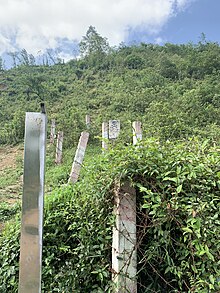
At the top of the loop it is possible to see the border of China. Portions of the border are said to have landmines, so staying on established paths is important here.
Lũng Cú Flag Tower [ edit ]
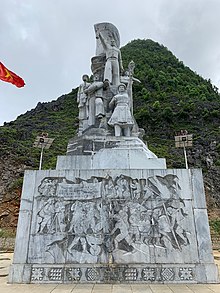
An impressive stone flag tower with views of both Việt Nam and China.

Buy [ edit ]
- 23.037591 105.04981 1 Lung Tam Linen weaving products , Lung Tam village, Quan Ba district , ☏ +84 1255 147 665 (Ms Mai) . Unique linen clothes, bags, handbags, scarfs, pillows, blankets, purses and many different things. Every linen cloth weaving have traditional patterns, with the images bring the culture and color of the Hmong ethnic people by complicated indigo dyeing and beewax batik drawing process. Mrs Mai is the leader of Lung Tam linen weaving cooperative. ( updated May 2016 )
- 22.693529 104.96747 2 Shan Tuyet Tea ( Snow Shan Tea ), [email protected] . Ha Giang is one of the provinces that has the oldest aged Shan tea of the Vietnam with a large leaf, bud and young leaf with snow-like white fur, good growth, high resistance of wetness, coldness, high productivity and good quality. Therefore, it is called snow Shan tea. This is the raw tea material of Hung Cuong Trading Company to produce organic tea products certified according to USDA, EU, COR, IFOAM standards. ( updated May 2016 )
Eat [ edit ]
Local delicacies: Thang Co, Au tau gruel (Au tau bulb), sausage (Lap suon).
Drink [ edit ]
Local drinks worth trying: corn wine, sugarcane juice, ancient Shan tea.
Sleep [ edit ]
- 22.810151 104.940483 1 Mama's House Hostel , No 368, 20 thang 8 street, 1st group, P. Nguyễn Trãi , ☏ +84915121987 , [email protected] . ( updated Oct 2018 )

Go next [ edit ]
- Has custom banner
- Has mapframe
- Maps with non-default size
- Do listing with no coordinates
- Has map markers
- Northern Vietnam
- All destination articles
- Outline cities
- Outline articles
- City articles
- Has Geo parameter
- Pages with maps
Navigation menu
View All wishlist
View all wishlist
- Top 10 Vietnam Tours
- Country Discovery
- Family Holidays
- Vietnam Eco Tours
- Vietnam Golf Tours
- Luxury & More
- Vietnam Honeymoon Holidays
- Beaches & Leisure
- Health, Spa & Wellness Tours
- Adventure Motorcycle Tours
Northern Vietnam
- Central Vietnam
Southern Vietnam
- Angkor Tours
- Classic Tours
- Luxury Tours
- Adventure Tours
- Family Vacations
- Beach Holidays
- Cycling Tours
- Luxury Holidays
- Honeymoon Packages
- Family Tours
- Great Wall of China Tours
- Hiking Tours
- Vietnam & Cambodia
- Vietnam & Laos
- Vietnam & Thailand
- Thailand & Cambodia
- Vietnam, Laos & Cambodia
- Halong Bay Cruises
- Mekong Cruises
- Hanoi City Tours
- Ho Chi Minh City Tours
- Halong – Cat Ba Tours
- Hoa Lu – Tam Coc
- Da Nang – Hoi An Tours
- Nha Trang Tours
- Phu Quoc Tours
- Mekong Delta Tours
- Ha Giang Tours
- Mai Chau Tours
- Shore Excursions
- First Trip to Vietnam
- 7 Days (1 Week)
- 14 Days (2 Weeks)
- Mui Ne Phan Thiet
- Ho Chi Minh City
- Tet Holiday in Vietnam
- Vietnamese Zodiac Elements
- Traditional Folk Games
- Kanchanaburi
- First Trip to Thailand
- 4 Days in Laos
- 5 days in Laos
- 7 Day in Laos
- Luang Prabang
- Savannakhet
- Useful travel apps in Laos
- 3 Days in Cambodia
- Cambodia in 5 Days
- Cambodia in 7 Days
- Angkor Thom
- Sihanoukville
- Kampong Cham
- Ngapali Beach
- Kalaw & Pindaya
- Best of Vietnam
- Beautiful Vietnam
- Vietnam weather
- Vietnam Food
- Vietnam Itineraries
- Vietnam Travel News
- Vietnam Travel Tips
- Vietnam Culture
- Ethnics of Vietnam
- Beautiful Thailand
- Thailand itineraries
- Thailand Travel Tips
- Beautiful Cambodia
- Cambodia Travel Tips
- Cambodia itineraries
- Beautiful Laos
- Laos Itineraries
- Laos Travel Tips
- Beautiful Myanmar
- Best of Myanmar
- City Highlights
- Myanamar Travel Tips
- Myanmar Itineraries
- Beautiful China
- Company News
- 14 Days in Vietnam and Laos
- 15 Days in Vietnam and Laos
- Vietnam and Laos in 17 – 20 Days
- 11 Days in Vietnam and Thailand
- 12 Days in Vietnam and Thailand
- 13 Days in Vietnam and Thailand
- 14 Days in Vietnam and Thailand
- 15 Days in Vietnam and Thailand
- 16 Days in Vietnam and Thailand
- Vietnam Visa
- Flights to Vietnam
- Vietnam domestic flights
- Vietnam MICE, Incentive travel
- Vietnam trains
- Thailand car rental
- Cambodia car rental
- Myanmar car rental
- Laos car rental
- Why Choose Us
- Logo, Slogan and Website
- Meet The Team
- Terms and Conditions
- Payment Methods
- Responsible Travel
- Land Tour Operator
- Create my Trip
Ha Giang Travel Guide
- Travel Guide
General Information
In the far north of Vietnam, in the province of Ha Giang, are mountains. Beautiful karst plateaus, breathtaking rice terraces, mind-blowing passes, genuine ethnic villages, and rich cultural heritage are all well-known features of this province.
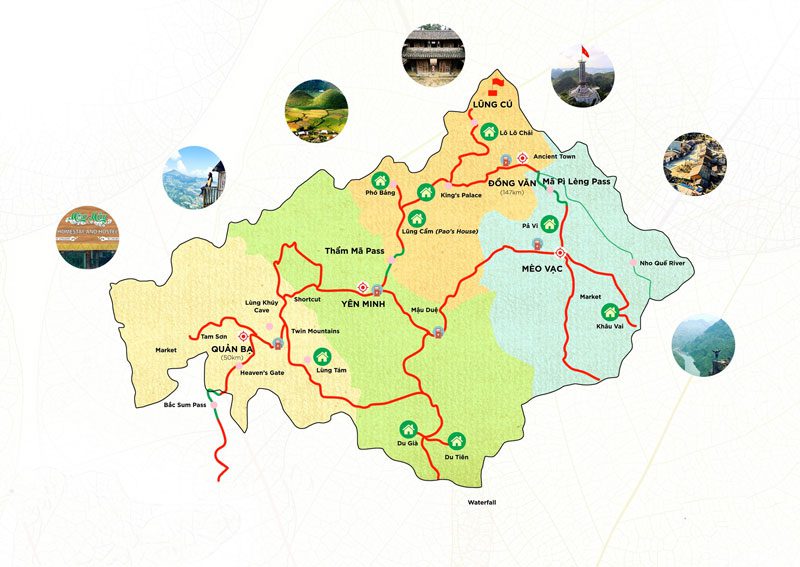
Ha Giang map
This region is still untouched by commercial tourism. Ha Giang is a great choice if you’re looking for somewhere that is less crowded and touristy than Sapa . A visit to Ha Giang will relieve all of your stress and provide you with life-enriching opportunities to experience the distinctive nature and culture of this area. Given that the road infrastructure has been repaired and is now open to all tourists, traveling to this province is much simpler today.
Ha Giang Weather & Best Time to Visit
Depending on what you want to do, you should decide when to go to Ha Giang. However, due to the moderate weather, it is often recommended to plan your Ha Giang tour between the months of February and April. It’s substantially warmer from April through September. The time from December to February has a maximum temperature of 16°C and is the coldest time of the year.
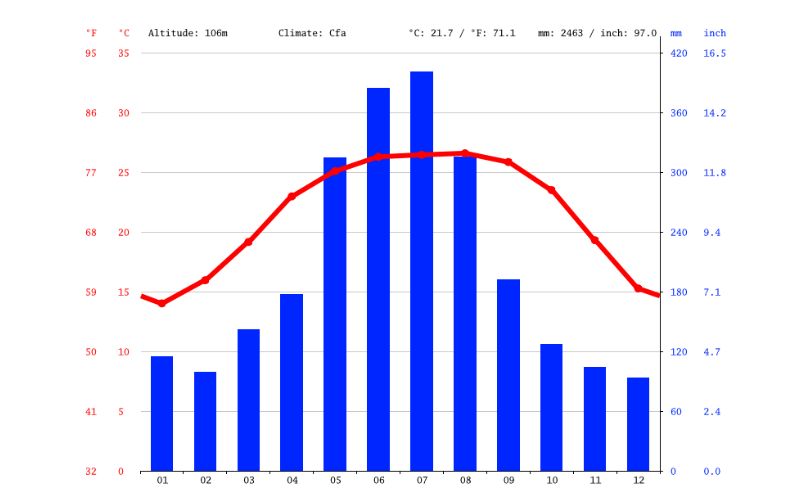
Ha Giang weather
In the rice terraces, the season for transplanting rice starts in May. In order to save water, farmers plow their land and raise the edges. The terraces get wet between May and June, and mirrors with the sky reflected in them start to form.
It is harvest time from September until October. When that happens, the rice fields turn a stunning shade of golden. For fans of photography, it is one of the liveliest and most enchanting times of the year. A beautiful transition from green to yellow is also something we notice.
When the buckwheat flowers bloom in Ha Giang from October to November, you can go there to observe them.
How to get to and around Ha Giang
By car or by bus.
From Hanoi, you can board a bus during the day or at night at a number of bus stops, including My Dinh, Giap Bat, Gia Lam, and Old Quarter. The trip takes about 6 to 7 hours to complete and is quite long (more than 300 km). You can get in touch with us if you want to rent a private vehicle. To help you get the most out of your trip, IDC Travel provides you with a car rental service with a driver. Before you depart, the price and vehicle quality are agreed upon. You can also travel to Ha Giang from several northern hilly regions. For illustration:
- Sapa-Ha Giang: 245km. Duration: 6h
- Yen bai – Ha Giang: 310km. Duration: 7h30
- Bac Kan – Ha Giang: 245km. Duration: 6h45
- Cao Bang-Ha Giang: 240km. Duration: 7h45
By motorcycle
Rent a motorcycle to get to Ha Giang if you enjoy freedom and adventure. However, it is not recommended because Ha Giang’s roads, particularly for foreigners, are extremely dangerous and there are several accidents every year.
For a short trip, the bicycle is an excellent mode of transportation. There are places to hire bikes, so you may explore the ancient town at your own pace. This service is also offered by some homestays.
In Ha Giang, there are three major taxi companies: Taxi Truong Xuan, Taxi Cong Hoang, and Taxi Son Dan.
Places to Visit in Ha Giang
Dong van karst plateau.
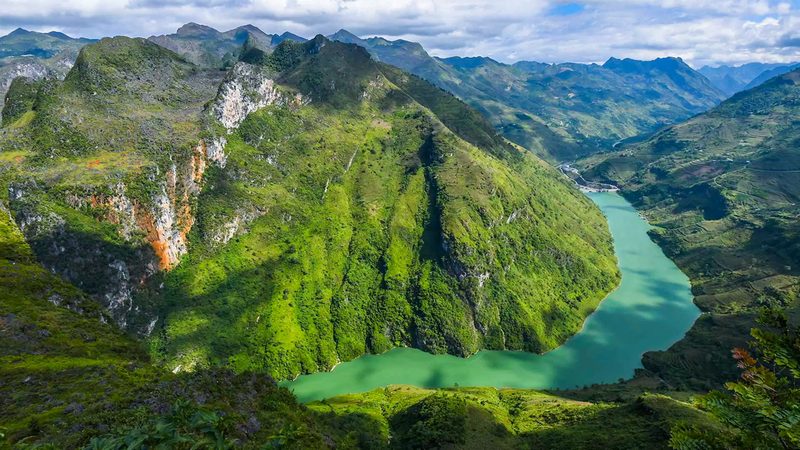
Ha Giang – Dong Van Karst Global Geopark
Dong Van Karst Plateau, which spans 574 km2, is impressive and includes the districts of Quang Ba, Meo Vac, Yen Minh, and Dong Van. It is the largest karst plateau in Vietnam and is positioned at a height of 1,024 m. A UNESCO World Heritage Geological Park is located on the plateau. It has been there for 500 million years. On the plateau, there is a market that is open every Sunday and holiday where ethnic minorities can interact and trade items.
It is a photographer’s heaven. You can escape the heat by traversing the plateau. The temperature will decrease as you ascend.
The rainy season, which lasts from May to October, and the dry season, which lasts from November to April, both occur on the plateau. The buckwheat flowering season, which lasts from October to April, makes the plateau even more gorgeous. Flowers with a mustard color flourish in the valleys.
Dong Van Old Quarter
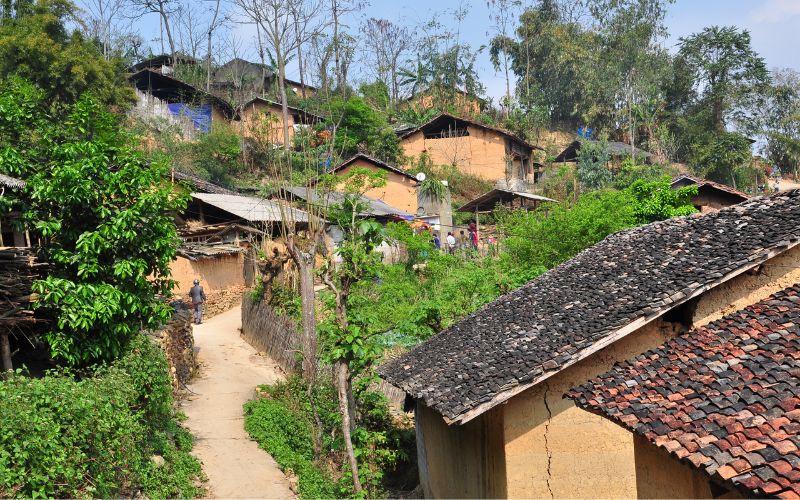
Only about forty dwellings make up the old quarter of Dong Van, which is only 40 kilometers from Ha Giang in a valley of the Dong Van plateau. Chinese-style homes frequently have two floors and Ying-Yang tiled roofs. Ironwood was used to build the homes. Mountains made of karst surround the city. Chinese ethnic minorities including the Hoa, Hmong, Tay, and Kinh have lived together for a while in Dong Van’s historic area. Dong Van, incidentally, means “sharing culture” place.
Quan Ba Twin Mountains

Quan Ba Twin Mountains should not be missed when visiting Ha Giang. The captivating splendor of the surroundings will astound you. Green rice fields at the base of the mountains resemble the attractive spring’s green clothing. Ripe rice turns a honey-yellow color in the fall. The Quan Ba Twin Mountains, which are located in the valley’s center, provide appeal to the area. Additionally, the twin mountain’s love story, which is infused with poetic purpose, conveys both the location’s renowned beauty and its inhabitants’ real lives. Quan Ba Twin Mountains is thus a popular tourist site and a representation of Ha Giang.
Ma Pi Leng Pass
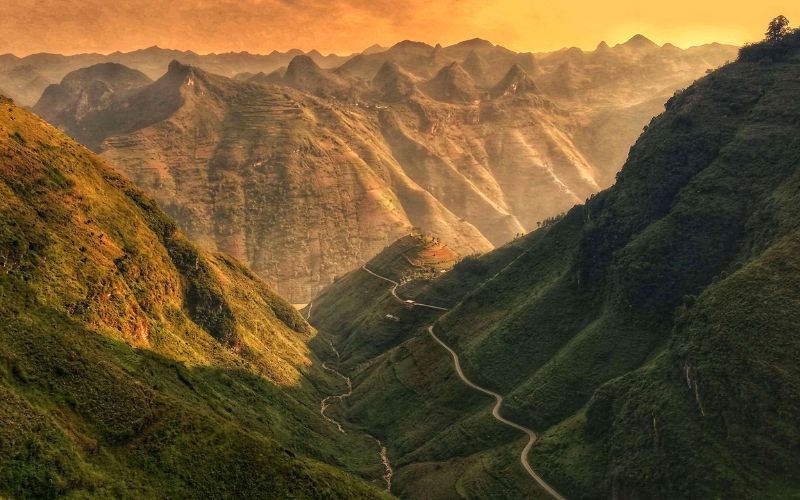
In northern Vietnam , it is one of the four highest passes. Meaning “horse nose,” Ma Pi Leng. As you ascend the pass, you will be able to take in the breathtaking valleys, hemp fields, and stilt homes of the local minority ethnic groups as well as a comprehensive perspective of the entire geological karst plateau and the breathtaking surroundings.
Hmong King’s Palace
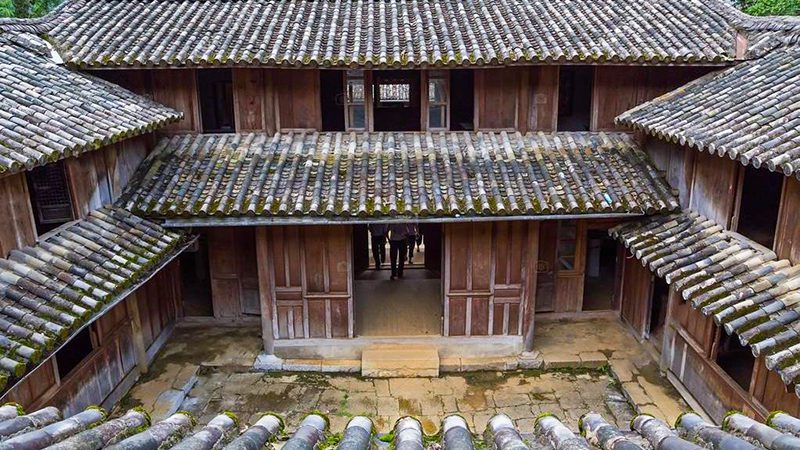
Hmong King’s Palace in Ha Giang
This is located on the plateaus of Dong Van and Meo Vac, around 12 miles from Dong Van. The palace mimics Chinese design. The palace is 1120m2 in size and was constructed by ethnic minorities. This palace, which forms the letter (which in English means “king”), was constructed around the start of the 20th century. You ought to be aware that the Vuong family ruled the entire Dong Van plateau before Vuong Chinh Duc declared himself king. The palace is recognized as a national treasure.
Lung Cu Flag tower
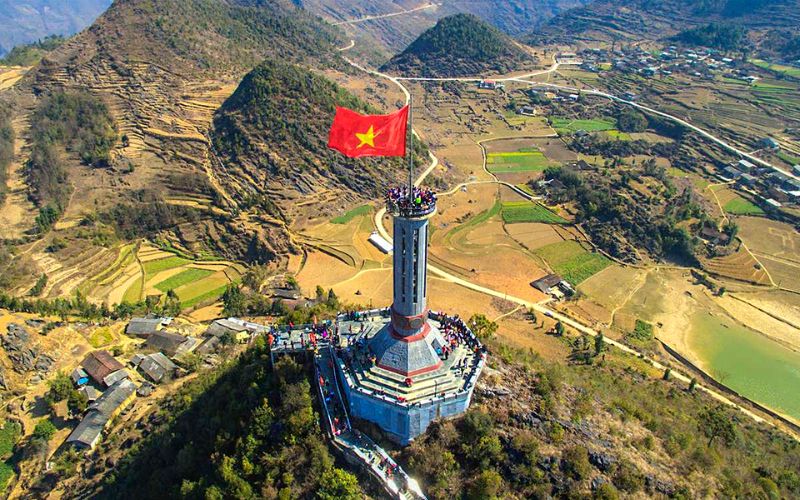
The massive Lung Cu Tower, a historical artifact and revered emblem of national sovereignty, is perched atop Rong or Long Son Mountain. A panoramic view of a stunning environment with mountains, rice fields, lakes, homes with dark gray roofs, and borders can be seen from this location, which is perched at a height of around 1700 meters above sea level.
The tower, which is almost 35 m tall, is draped with a 54 m2 flag that represents 54 members of the vast Vietnamese family. The octagonal pedestal displays reliefs modeled by bronze drums from the Dong Son culture of the nation’s founders, as well as cultural practices of the Ha Giang ethnic groups and historical references. Visitors will be able to get a glimpse of the cultural practices of the many Ha Giang ethnic groups through exhibits of artifacts, clothing, and tools in the exhibition hall at the base of the tower.
Hoang Su Phi and the rice terraces
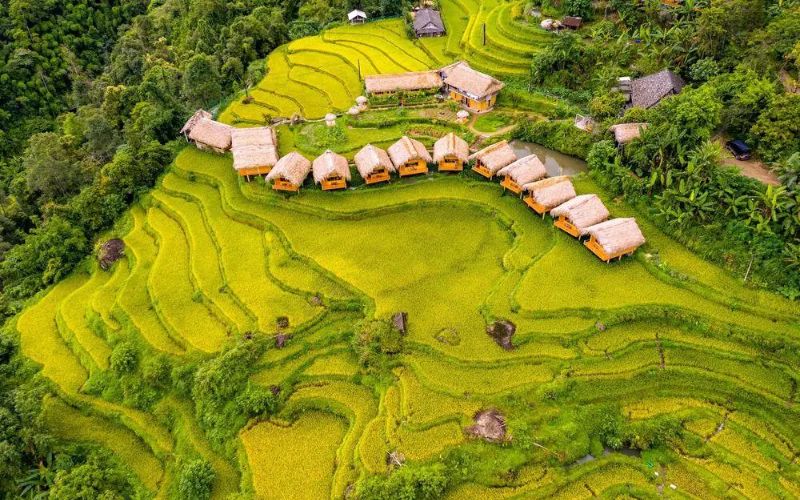
Hoang Su Phi
The magnificent Hoang Su Phi rice terraces, which were designated as national treasures in 2012, are an absolute must-see when visiting Ha Giang, Vietnam. When rice is being transplanted in May, the rice fields in Hoang Su Phi that spread as far as the eye can reach in the Xin Man Valley are very beautiful to watch. These murals on the mountainside change color as the rice plants mature: The enormous water mirrors are filled with rice plants, which pass through a light green cover in June and turn yellow in September before harvest.
Nho Que River Valley
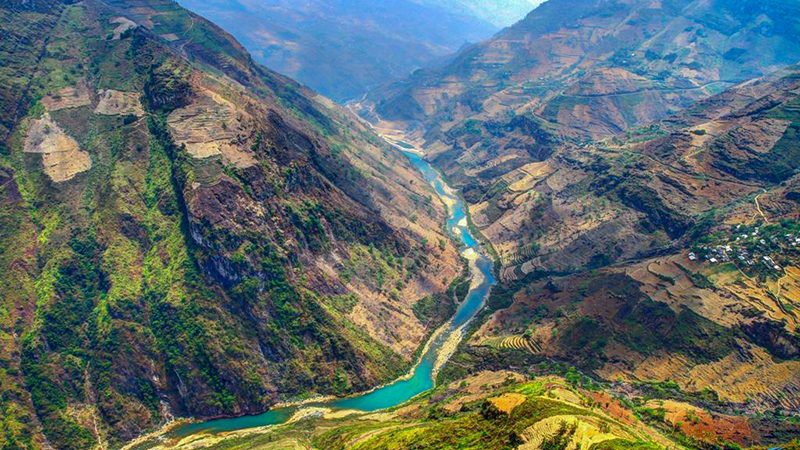
Nho Que River
The Nho Que River Valley is one of Vietnam’s most distinctive geological valleys and is regarded as one of Southeast Asia’s deepest canyons due to its exceptionally rough topography. The green Nho Que River can be seen meandering down the mountainside as we stand on top of Ma Pi Leng Pass and look into the distance. We can also experience the majesty of nature. The Nho Que River appears to be a pale blue silk stripe across the gorgeous mountain from a distance. You now only need to relax and take in this land’s breathtaking beauty.
Tourists love this 100-ha natural lake that is encircled by forest. It is a freshwater lake that is compared to El Dorado because of the forest of trees that float in the water there. In the lake, there is a wide variety of fish. You will be astounded by nature’s magnificent display.
Meo Vac Village
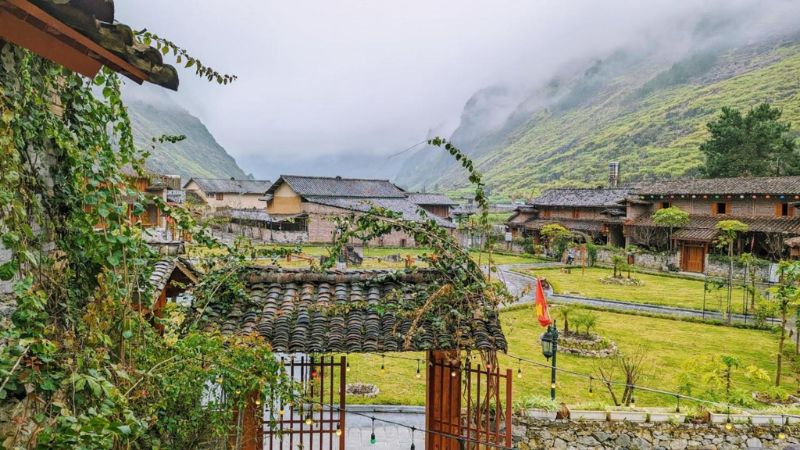
Meo Vac is a charming little town encircled by towering karst mountains, and like many other communities in the northwest, it frequently hosts ethnic minorities. The main draw is the journey across the breathtaking Mai Pi Leng Pass, which spirals 22 kilometers from Dong Van. Mountains made of limestone make up much of the landscape. The majority of visitors come to Meo Vac to do trekking, enjoy the rural setting, and observe local culture.
Things to do in Ha Giang
Trek in the mountains.
Hiking is especially ideal due to the hilly relief and stunning scenery. The province of Ha Giang boasts a variety of hiking opportunities, from short strolls to multi-day treks that include overnight stays. Trekking in Ha Giang offers a one-of-a-kind chance to see mountain communities and view breathtaking vistas from a different perspective.
Stay with the locals
It is a journey that will provide you with priceless memories of your time in Vietnam. Even though the living conditions may be subpar, staying with the locals offers a wonderful opportunity for camaraderie and sharing with the community. Locals, who are frequently members of ethnic minorities, will welcome you into their lovely traditional wooden homes. It is also a chance to support local businesses and promote ethical, cooperative travel.
Discover the markets
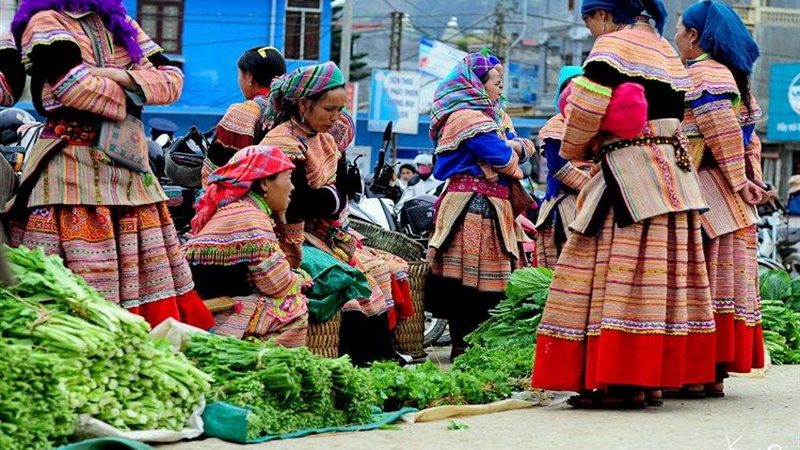
Meo Vac Market
Visit one of the many ethnic markets in the province of Ha Giang to encounter this amazing ethnic mosaic; you’ll definitely experience a change of scenery! The women are gorgeously attired in their traditional clothes in glistening colors, making the aisles of the market an even more vibrant festival of color. The most significant markets in the province that draw numerous members of ethnic minorities are those that are conducted on Sunday mornings in Hoang Su Phi, Dong Van, and Meo Vac. Be aware that the “love market” is conducted in the village of Khau Vai just once a year, according to the lunar calendar. Do not miss it!
Admire the rice terraces
As mentioned above, The Hoang Su Phi Rice Terraces are a true work of art created by one person. The sight of its rice terrace amphitheaters never dissatisfies a traveler. Only between May and October is when the rice is planted when it ripens, and then during the harvest, which occurs at the end of September and the beginning of October.
Food to eat in Ha Giang
Banh tam giac mach (buckwheat cake).
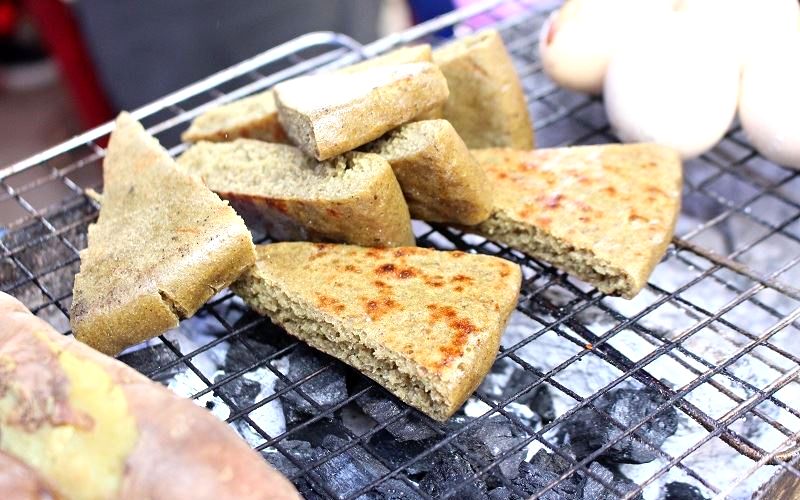
Buckwheat cake
The limestone plateau of Ha Giang dons its magnificent pink and purple mantle made of buckwheat blossoms in the middle of October. The ability of the locals to use this particular flower allows for the creation of a cake that is incredibly nutritious and wholesome. The cooks gather the plant’s seeds and grind them with water until the mixture is completely bonded. The dough is next placed into tiny molds before being heated. The outcome is cakes that can be consumed throughout the meal while they are still hot. For only 15,000 VND, you can readily find these recognizable cakes in any market in the area. They are a staple of Ha Giang cuisine. It’s a great idea to give it as a gift as a keepsake!
Thang co (beef, horse, or goat offal soup)
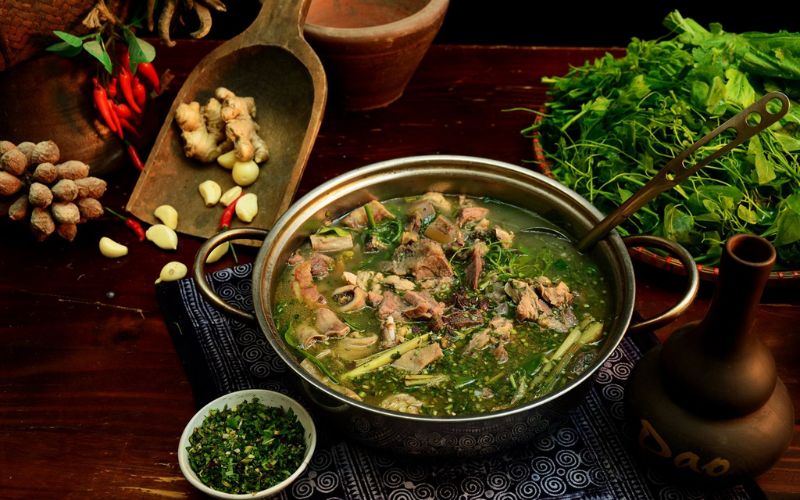
A rustic dish has a special allure; it is a specialty of mountainous areas’ cuisine and attracts a lot of tourists.
The time in between chilly spells is warmed by the perfume of spices like cardamom, star anise, cinnamon bark, walnuts, lemongrass, and even ginger blending with the fatty flavor of beef. This dish’s primary components include cleaned cattle or horse intestines, meats, bones, seasonings, and aromatic herbs.
Banh cuon trung (steamed rice roll with egg)
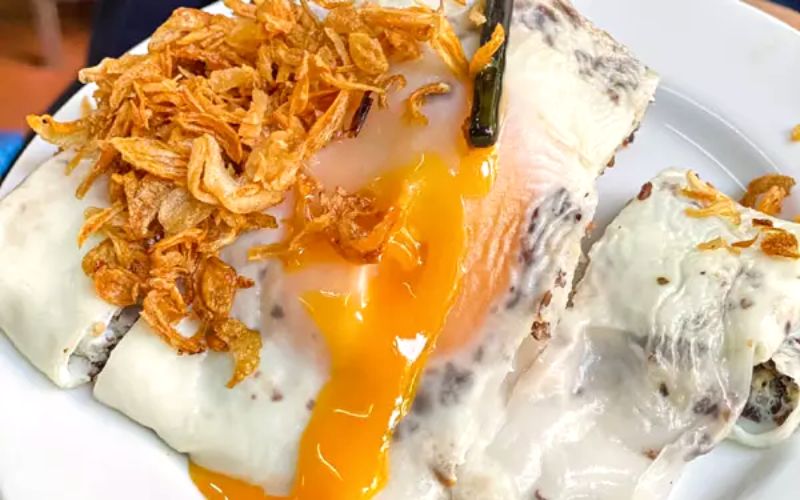
Both residents and visitors like eating banh cuon. This cake seems very similar to a simple dish at first, but when you eat it, it tastes fantastic and mouth-watering from the outside to the inside. The cake is thin, fragrant, moist, and silky. When the cake has barely begun to ripen, simply beat the eggs for the banh cuon trung, a type of egg pancake, and then cover the pan with the lid for a bit to cook it thoroughly while keeping it smooth, moist, and free of cracks. For an outstanding flavor, the banh cuon is served with a sauce spiced with a little pepper, chili, and vinegar.
Chao Au tau (Au tau congee)
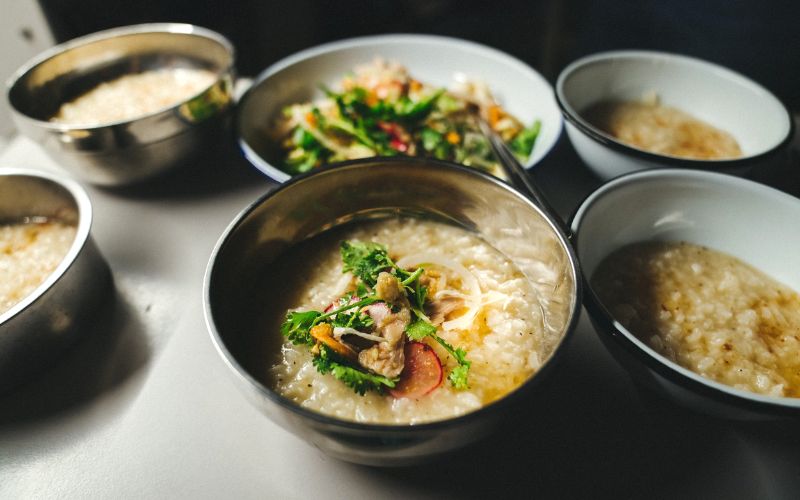
Au Tau congee
Wintertime in Ha Giang makes it simple to locate a modest eatery and eat Au tau soup. This dish is great because it combines the right ingredients, including minced beef, somewhat oily chestnuts, ham broth, large-grain sticky rice, and traditional field rice. You’ll want more soup after tasting this one!
Xoi ngu sac ( 5-color steamed sticky rice)
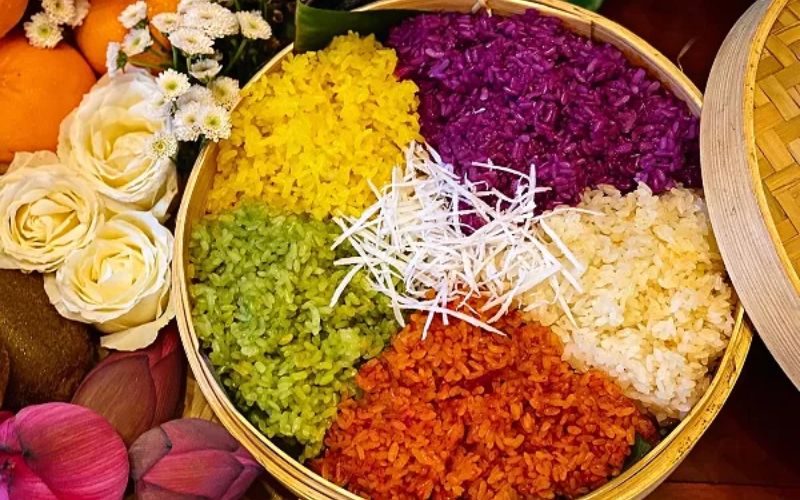
Xoi ngu sac
The five hues of this dish—white, red, green, purple, and yellow—represent the fundamental elements of the cosmos. It is made with sticky rice that the locals grow. Xoi ngu sac has developed into an essential dish in ethnic gatherings and festivals all year long due to its appealing shape and fragility.
Ha Giang festivals
Khau vai love market festival.
If you’re fortunate enough to visit Meo Vac, Ha Giang in April, Khau Vai Love Market, also known as Phong Luu Market, is a must-see location. Taking place once a year on a hill in the commune of Khau Vai, this remarkable market is where people come together to discover love in a unique setting.
Spring Festival
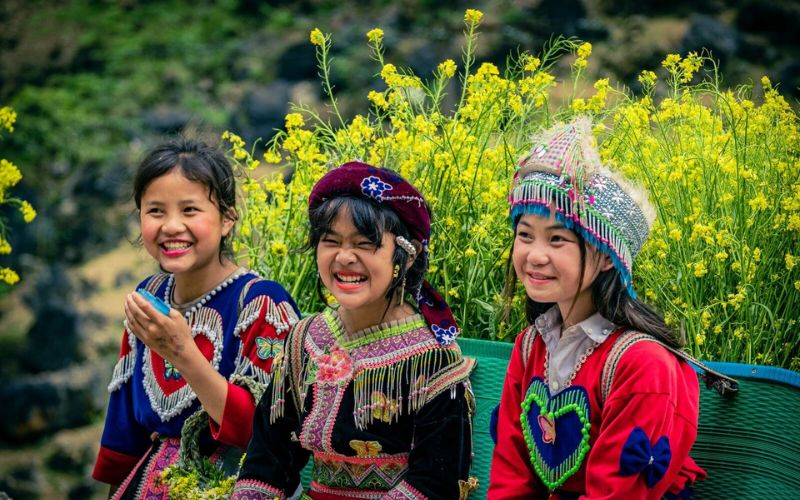
Children in Ha Giang, on a spring day
The Dao ethnic community prays for favorable weather and bountiful harvests as they commemorate the start of spring. The ethnic group then shows its acceptance of and adherence to the deity. In fact, the commencement of the harvest marks the start of the new year. On the day of the Lunar New Year, the festivity is held. This is a chance to dance, laugh, and take part in a variety of fun games.
Rain Festival
Every year, the Lo Lo ethnic community honors the rain and offers their livers to their gods in the hopes that they may fall on the Meo Vac fields for a better harvest. The dates of this festival are March 17–19. This provides a chance for people to interact while participating in the festival’s numerous ceremonies. Offerings are delivered to the home of a sorcerer or the local leader, including chickens, dogs, and rice. After that, a ceremony needs to be planned. All of the villagers congregate after the service has concluded to drink, eat, and dance.
All of your senses will be satisfied if you travel to this unique charming place. Do not hesitate to contact us and plan your first visit to Ha Giang!
Best Ha Giang Tours for 2024/2025
All the following tours are private and can be customized. Don’t like the Dong Van Old Quarter? Want to spend one more night in Ma Pi Leng Pass? Let’s change it. We are here to tailor-make your unique experience.
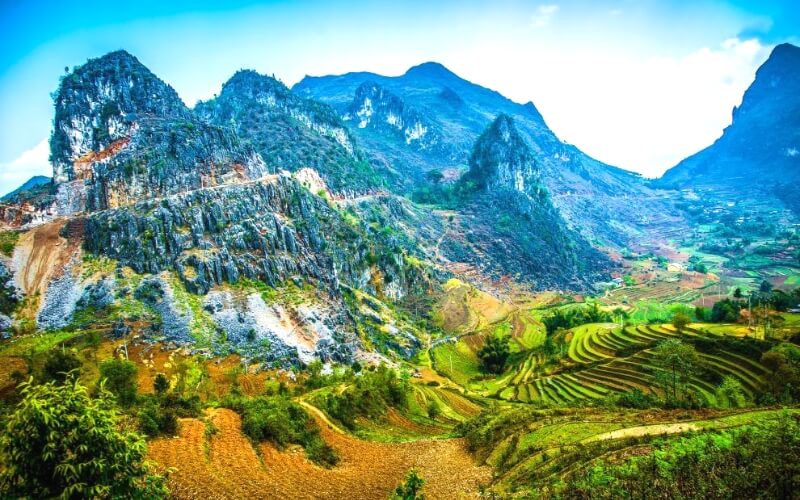
Explore the Culture and Nature of Ha Giang in 3 Days
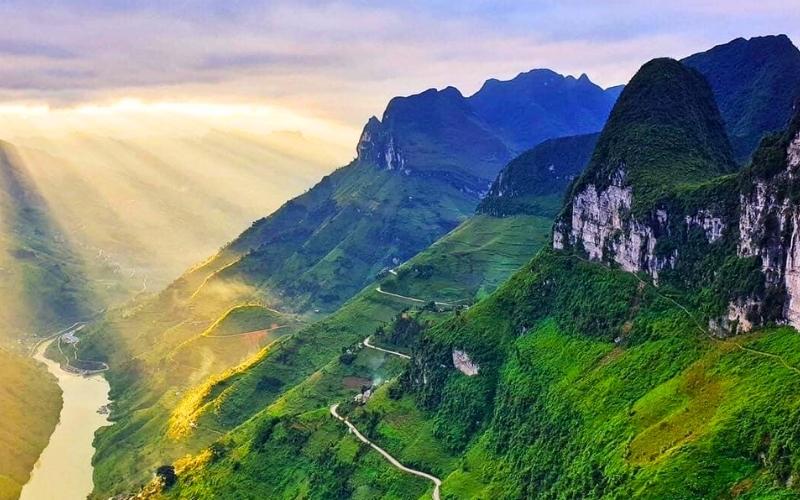
Experience the Culture and Beauty of Ha Giang in 3 Days
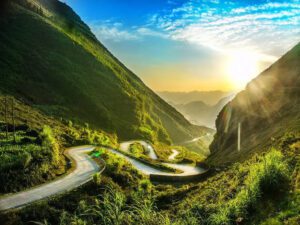
Adventure tour to Ha Giang, Cao Bang, Lang Son in 6 days
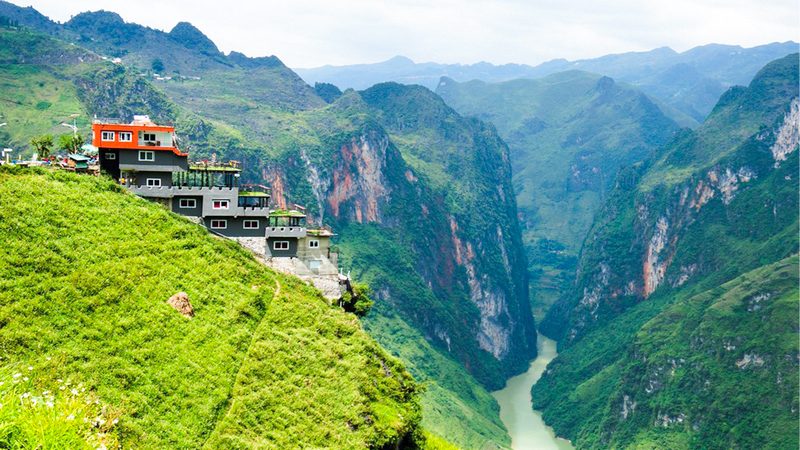
Ha Giang Adventure Tour 3 Days 2 Nights
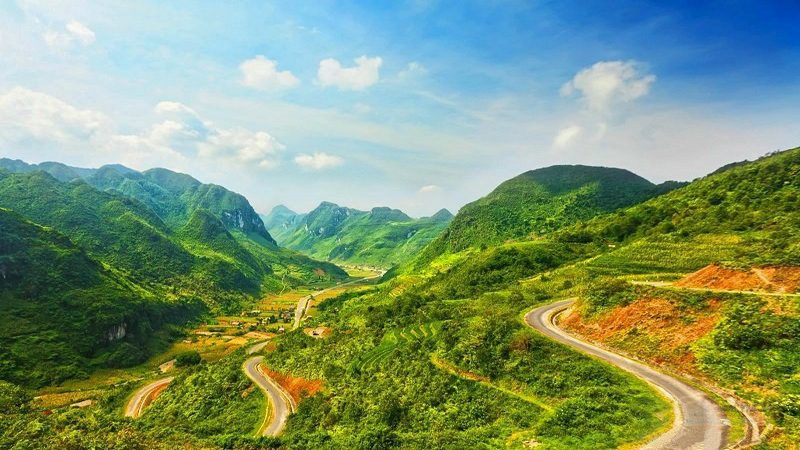
10 Days Trekking Viet Nam Tour Bac Ha – Ha Giang
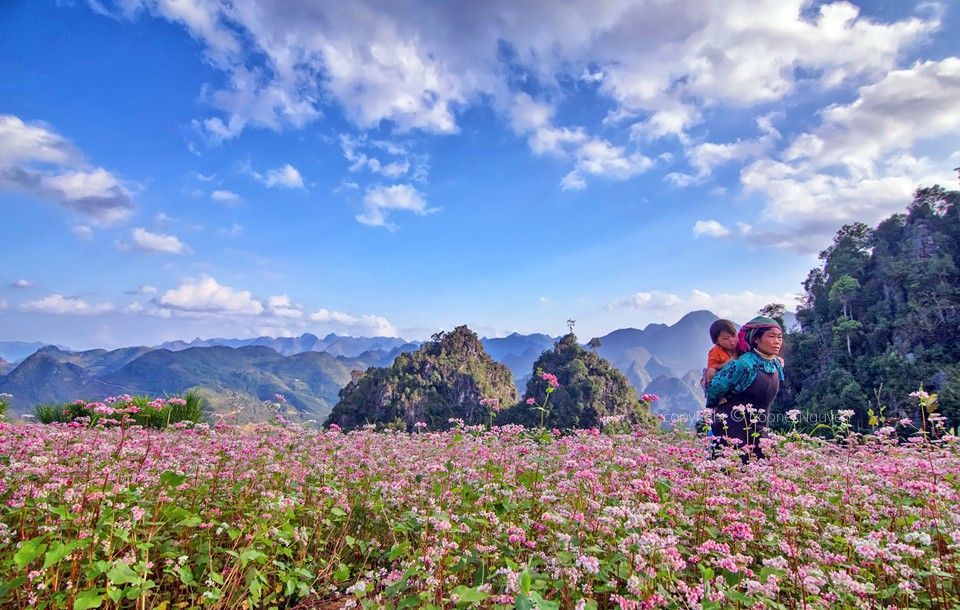
Incredible Panorama of Ha Giang 4 Days 3 Nights
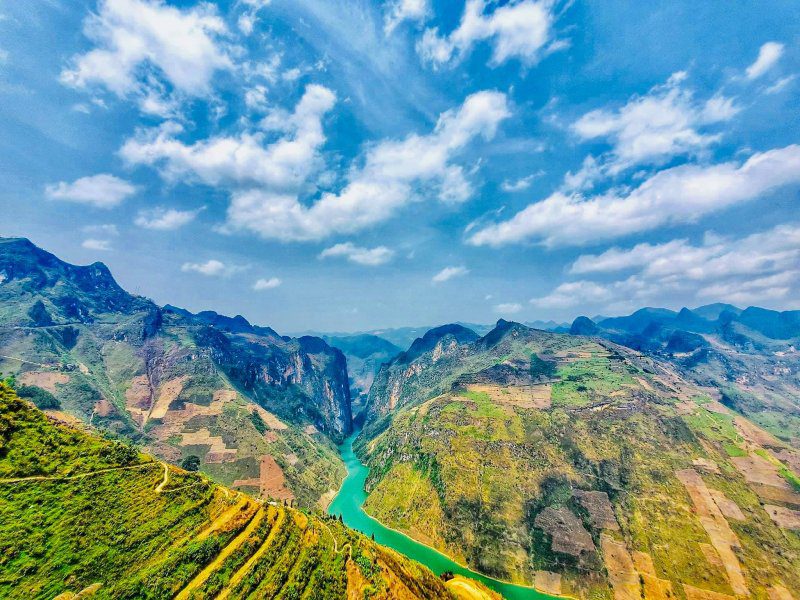
Viet Nam Northeast 6 Days From Ha Giang To Lang Son
Start planning your tailor-made tour with 1-1 help from our travel advisors..
- Plan your tailor - made trip with a local expert
- security Book securely with money-back guarantee
- Travel stress-free with local 24/7 support
Enrich Your Ha Giang Tour with the Spotlight Experiences
Would like some memorable stories to tell about your Ha Giang tour ? Enrich your days with our handpicked and exclusive experiences.
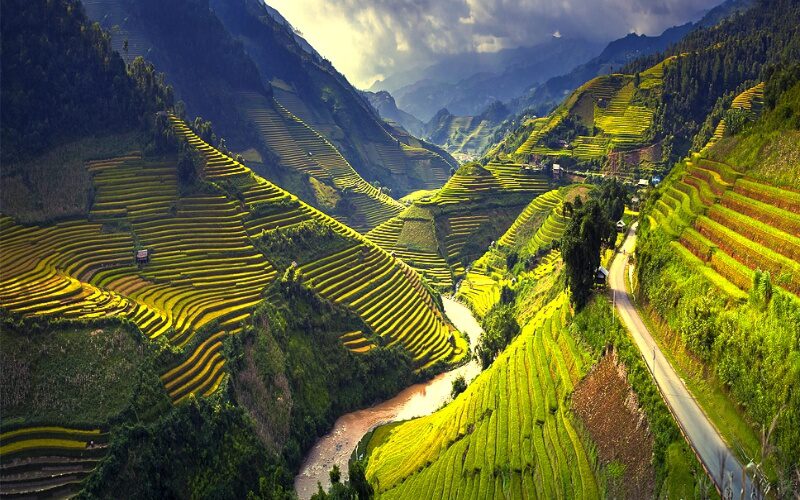
How to Spend 3 days in Ha Giang? Suggested Itineraries
Destinations.
- Tuyen Quang
Center Vietnam
Vietnam Coracle
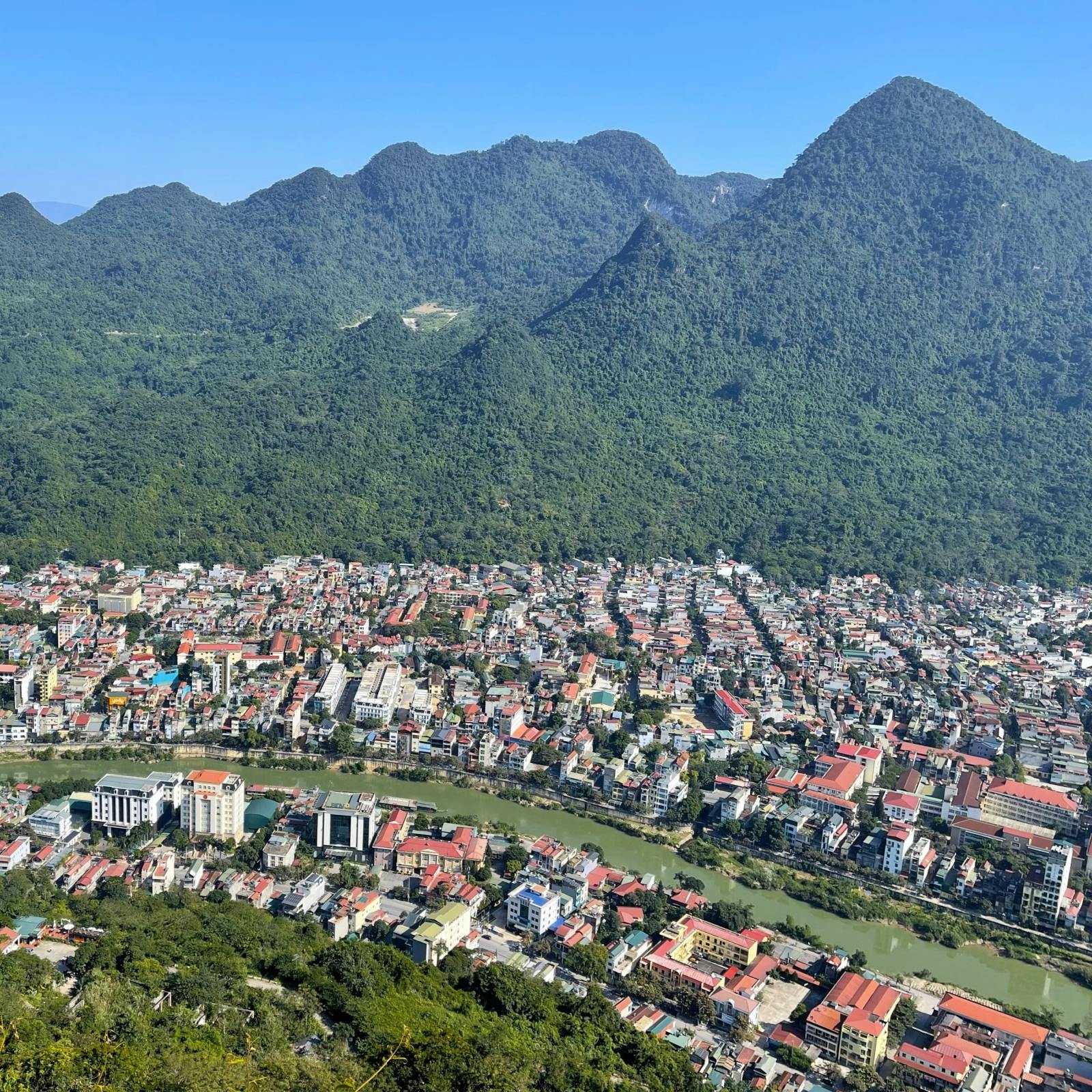
Ha Giang City Guide
First published March 2024 | Words and photos by Joshua Zukas

Joshua is a contributing writer for Vietnam Coracle. A freelancer whose body of work focuses primarily on travel & architecture, Joshua covers Vietnam regularly for Lonely Planet, Michelin Guide, Insider, Ink Global & many of Asia’s top inflight magazines. He also writes intermittently for publications such as The Economist, Wallpaper & Interior Design Magazine. He holds an MSc in sustainable tourism…. read more about Joshua
Like many modest provincial capitals in Vietnam, Hà Giang City is an enjoyable place to while away a day or two. Traffic is light, the residents are friendly and there are a handful of things to see and do. While the architecture is nothing to write home about, the city’s setting – ringed by jungled mountains and sliced in two by a river – is undeniably appealing. The Sông Lô (Blue River) is brown and full of tangled reeds for much of the year, but reinforced and largely traffic-free waterside roads make for pleasant strolling. Most travellers see the city as a mere jumping-off point for the Hà Giang Loop with nothing to do. However, Hà Giang City has some interesting sights, good food and decent accommodation. The aim of this this guide is to help travellers make the most of those pre- and post-road trip periods.
Please Support This Website Make a donation or become a patron if you enjoy Vietnam Coracle. This website is totally free & independent. I do not receive payment for anything I write. Thank you, Tom

[ Back Top ]
HA GIANG: CITY GUIDE
Vietnam’s Most Northerly Capital & Gateway to ‘The Loop’
This succinct city guide is based on many trips I’ve made to the city over the past 10 years. During that time, I’ve watched Hà Giang grow from a sleepy city into one of the province’s more lively spots, with a sprightly weekend walking street and an ever-increasing number of bars, cafes and restaurants. All the information in this guide is categorised, which should make it easy to find what you’re looking for. (See Related Guides for more Hà Giang content):
See & Do
Eat & Drink
Transport, Bike Rental & Tours
Related Guides

Get the Offline Guide & Map $15
- Custom-designed PDF version of the Ha Giang Loop guide
- Instructions to load the map to your phone & use it offline with navigation
- Full use of guide, map & navigation anywhere, anytime
Hà Giang City
[ Back to Contents ]
Weather :
Hà Giang City is at its most amicable in spring, from March to May, and autumn, from September to November. November is particularly pleasant, with sunny and bright days that rarely get too warm and cool mornings and evenings. The city can be very cold from late December to February and very hot from June to August. Note that Hà Giang City also sees bursts of heavy rainfall during the summer months. If you’re heading for the mountains, it’s worth keeping in mind that Hà Giang City can be warmer and drier than the provincial districts to the north and east. Even if the days are comfortable in Hà Giang City, you should still prepare for colder and wetter weather when motorbiking in the more far-flung corners of the province, such as the Hà Giang Loop and the Borders & Back-Roads route.

See & Do :
Central Square ( Quảng Trường Thành Phố Hà Giang ) [ MAP ] makes for brief but pleasant ambling, but bear in mind that it’s almost completely without shade so it’s best visited in the early morning or late afternoon. The statue in the middle depicts Hồ Chí Minh flanked by smaller figures representing the different ethnolinguistic groups in the province. The prosaic text beneath reads: ‘Uncle Hồ with the ethnic groups’. The square comes into its own on weekend evenings when traffic is banned from the surrounding streets and a few dozen kiosks move in and sell cheap drinks and snacks. It can get very noisy, but the atmosphere is jovial and family friendly, usually with entertainment taking place on a makeshift stage near the river.
Provincial Museum (8.00-11am & 1.30-5pm) [ MAP ] was renovated in 2020 and is worth at least a couple of hours. If possible, it’s best to visit the museum before any road trips as it will help explain and contextualise the province’s rich diversity. Along with information on the geological and cultural history of the province, exhibits devote a lot of attention to exploring and celebrating Hà Giang’s 19 ethnolinguistic groups (more than a third of Vietnam’s ethnolinguistic groups are represented in this small corner of the country). Don’t let the first room’s lack of English signage deter you; the rest of the museum is much more friendly to non-Vietnamese speakers. A timeline illustrates when the different groups arrived in the province and there’s a useful map showing where they live. The short but dramatic climax of the exhibits on the first floor is a sound and light show that briefly chronicles the geological and ethnic history of the province. The visual highlight of the museum, however, is the footage shown projected onto a concave screen on the second floor. This video is 15 minutes or so, with some rather moving drone footage of rural life in the province. The second floor also has a map illustrating the days and locations of the different markets in the province, which is worth studying as it may impact your itinerary. The remainder of this floor details the three different ecotypes in Hà Giang – low mountains, karst plateau and Hoàng Su Phi range – and some brief information on the culture and customs of the different ethnolinguistic groups.
Núi Cấm (Forbidden Mountain) City Viewpoint [ MAP ] is a fun, sweaty climb (45-60 mins up and down, including time spent at the top), especially if you want to make sure that your legs are still working after a few days on a motorbike. To get here, drive up the steep road to Café Núi Cấm where you can park for free. From here the path is mostly stone steps, though there are also some muddy sections. On your way to the top, you’ll pass Chùa Hộ Quốc , a dusty pagoda that appears to be dedicated to Guanyin, the Goddess of Compassion. Once you reach the top, you’ll find an old French fort that is slowly being reclaimed by the jungle, giving it a somewhat Angkorian atmosphere. Unfortunately there’s no information, but presumably the fort was built around the same time as the Đồn Cao Fortress in Đồng Văn, so turn of the 19 th century. Unlike the other forts in the province, here you’ll find several small shrines dotted around, possibly dedicated to those that lost their lives in the fort, only adding to the atmosphere of lost antiquity. There are also impressive views of the city and the encircling mountains.
The villages just a few kilometres west and south of the city are fun to ride around, though there’s nothing of specific interest that I could find. The best activity here is to drive around, get lost and perhaps you’ll chance upon an appealing homestay for a juice or a waterfall like this one . Some readers may be interested to know that some scenes from Neflix film, A Tourist Guide’s to Love , were shot in the area’s more picturesque corners.

After some difficult years during the Covid pandemic, Hà Giang City’s accommodation scene is growing once again. This helps keep midrange prices down – a good room today seems to be the same price today as it was 10 years ago – but the dirt-cheap options have all but disappeared. Note that there is no luxury accommodation in the city, but there are some very comfortable options that, for the purposes of this guide, I’ve designated ‘high-end’. There are also some options just outside the city that are worth considering. (Other than the ones listed below, you can browse many more Hà Giang accommodation options on this page .)
HIGH-END HOTELS:
Phoenix Hotel $50-$60 [ MAP ]: The best hotel in the city, at least according to Hollywood (this is where the production team from Neflix’s A Tourist’s Guide to Love stayed in 2022). The building is garish and characterless, the kind of rip-off Vinpearl-type hotel that you now find all over Vietnam, but the service isn’t bad and there’s a pool. Ask for a room overlooking the river for the best views. Downsides are the location – a 25-minute walk from the centre – and that they allow smoking in the rooms. Some rooms are smellier than others, so you can request to see a few rooms at check-in until you find the right one.
Hà Giang Historic House $50-$60 [ MAP ]: Another pricier option in the city run by a helpful and friendly family that can help arrange tours and motorbike rental. The rooms feel a little dark, but views over the garden and jungled mountains make up for it. From here it’s a 20-minute walk into town.
MID-RANGE HOTELS:
Luxury Hostel $20 [ MAP ]: It’s far from luxury, but this hotel is located in one of the more appealing residential neighbourhoods in town, and just a few blocks from the central square. The hotel is well-run, and the rooms are basic but clean and comfortable. You may have trouble convincing them to let you leave your motorbike inside overnight (like I did).
Nhật Bảo Hotel $20 [ MAP ]: This dated but adequate hotel overlooks the main square, which is nice in theory, but in reality means it can be very noisy, especially during the weekend. If you plan on staying here then pack earplugs.
BUDGET HOTELS:
Tiamo $15 [ MAP ]: Offering some of the cheapest private rooms in the centre of town, Tiamo is walking distance to the museum, central square and most of the city’s restaurants. The rooms are dated but clean enough.
Sky Building $10 [ MAP ]: This multipurpose building has a café-cum-hostel overlooking the river on the ground floor. It’s difficult to book the beds in advance, but they seem to always be available. You can also negotiate a half-day if you want some downtime before catching your bus.
OUTSIDE THE CITY:
Homestay Field $15 [ MAP ]: Highly recommended for the two bungalow rooms that overlook a pond. The charismatic owner speaks very little English, but that won’t stop her from throwing together a delicious dinner, even at the last minute.
NoMadders $25 [ MAP ]: With thatched bungalows and a quiet pool, this is one of the best places to stay, though the 10-minute drive in and out of town will deter some travellers. Still, this is an excellent place to relax for a night before or after a road trip.

Eat & Drink :
Hà Giang City has a decent food scene, with enough variety to keep you satisfied for at least a few days. Other than the places listed below, a good place to go hunting for food is the small grided neighbourhood north of the central square . Nguyễn Trãi and Nguyễn Thái Học streets also have varied restaurant and street food options.
STREET FOOD:
Bánh Cuốn Quảng Trường Hà Giang [ MAP ]: This bánh cuốn (wet savoury rice flour pancakes) street kitchen probably offers the best breakfast in town. The bánh cuốn here is served the same way as in Cao Bằng Province with a side of hot soup. The serving matriarch can be a little brusque, but don’t let her scare you off.
Bánh Cuốn Bà Làn [ MAP ]: Another reliable bánh cuốn option but considerably more friendly. Ms. Làn, who serves in the evening as well as the morning, also dishes up the Cao Bằng version of the dish.
Quán Phở Nghĩa [ MAP ]: This decent enough chicken phở joint is one of a cluster on Nguyễn Trãi Street. Quán Nghĩa is busy in the mornings and then serves throughout the day until the broth runs out. You can usually order a lemon juice from the café next door.
DT Quán [ MAP ]: A little gem of a place that seems to be more popular with foreigners than locals, DT is open throughout the day and serves a variety of Vietnamese favourites, like nem lụi (pork skewers) and bánh xeo (fried savoury pancakes), popular dishes in Vietnam’s central and southern regions.
RESTAURANTS:
Bếp Việt [ MAP ]: One of the city’s more upmarket restaurants, prices here are similar to what you might find in equivalent establishments elsewhere in the country. While the a la carte menu is extensive, most locals come for the lẩu (hot pot).
Hương Sen Vegetarian [ MAP ]: Hà Giang’s obligatory vegan restaurant, Hương Sen serves meatless versions of Vietnamese favourites, including dumplings and hot pot. This is a small business and they may not have everything on the menu, so prepare back-ups when selecting dishes.
Pizza Here [ MAP ]: If you’re craving western food, this might be the best place in the city. There’s a good selection of pizza here, including tempting vegan and seafood options. The space is cosy and welcoming, and the back bar overlooks the river.
Mr. Hung Bar & Restaurant [ MAP ]: Standard backpacker fare that will satisfy a certain type of craving. The main draws are the pool table and rooftop bar with views over the river.
CAFES & BARS:
Trung Nguyên [ MAP ]: The best Vietnamese coffee that I managed to find served on a quiet street on the riverside. The juice menu is limited but fresh, and there’s also yoghurt drinks and iced tea.
Lofita [ MAP ]: Probably Hà Giang’s cutest café, Lofita serves a decent coconut coffee ( cà phê cốt dừa ), bubble tea and a handful of cakes and snacks.
Cafe Núi Cấm [ MAP ]: Perfectly positioned for a post-hike juice after walking up to the viewpoint ( see above ), part of the café is in – and on – a cramped and gutted bus. Best stick to the decked terrace, which also has a covered section. The drinks are average but this is the best view in the city.
Nhà Hàng Phố Beer [ MAP ]: This rowdy but friendly local bar serves cheap fresh beer when they have it and bottles when they don’t. Like all bia hơi bars worth their salt, there’s a good menu of snacks that can constitute a full meal.
Hà Giang Mama’s Homestay [ MAP ]: Offering familiar rowdy backpacker vibes on the outskirts of town.

Transport , Bike Rental & Tours :
Annoyingly, the bus station is 3km south of the centre, and thus a little too far to walk from most hotels. Fortunately, most buses going to and from Hanoi leave from their offices, which are more central, or they’ll pick you up and drop you off at your hotel. I’ve used Quang Nghị several times and had no issues, but I’ve also heard horror stories! As of early 2024, it seems there are no reputable and reliable bus companies serving Hà Giang, so you may just have to take your chances.
There are many motorbike rental outlets in Hà Giang City, including Ngân Hà Travel , Kiki’s House , Style Motorbikes , and QT Motorbikes . There’s no need to book your bike in advance; if the rental place doesn’t have the bike you want, simply move on to the next one. Prices range from 150,000vnd to 500,000vnd per day depending on the bike.
In terms of tours, Flipside Adventures runs bespoke self-driving experiences that specialise in off-road adventures. Cheap and cheerful tour agencies include Jasmine and Mama’s , though I can’t personally vouch for their quality and safety standards. With these cheap cookie cutter agencies you’re likely to be in groups of 30 people or more, which might dilute the sense of adventure offered by the province.

* Disclosure: Vietnam Coracle content is always free and independent. Joshua has written this guide because he wants to: he likes Hà Giang City and he wants readers to know about it. For more details, see the Disclosure & Disclaimer statements and my About Page
RELATED POSTS
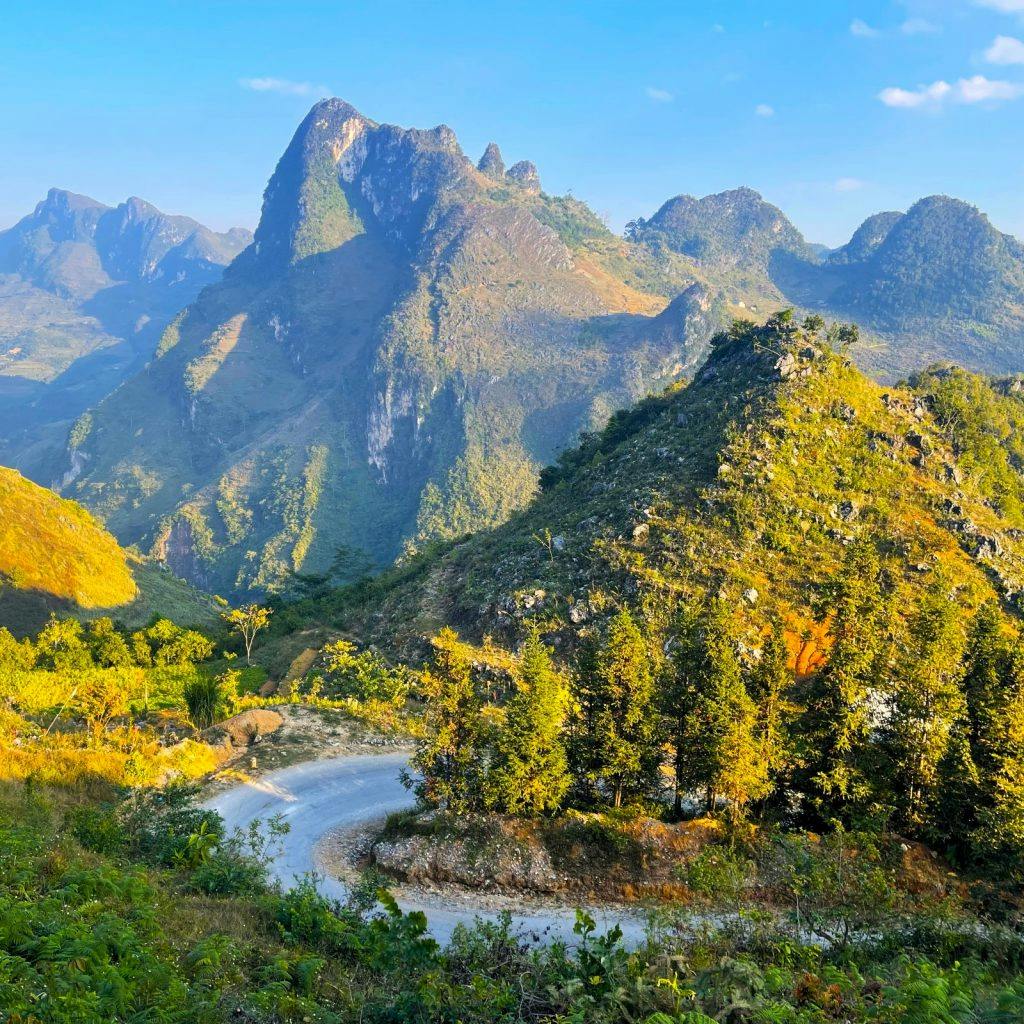
Ha Giang Loop: Extreme North Motorbike Guide
Hà Giang is a mystical borderland that’s home to a legendary motorbike loop through otherworldly landscapes…
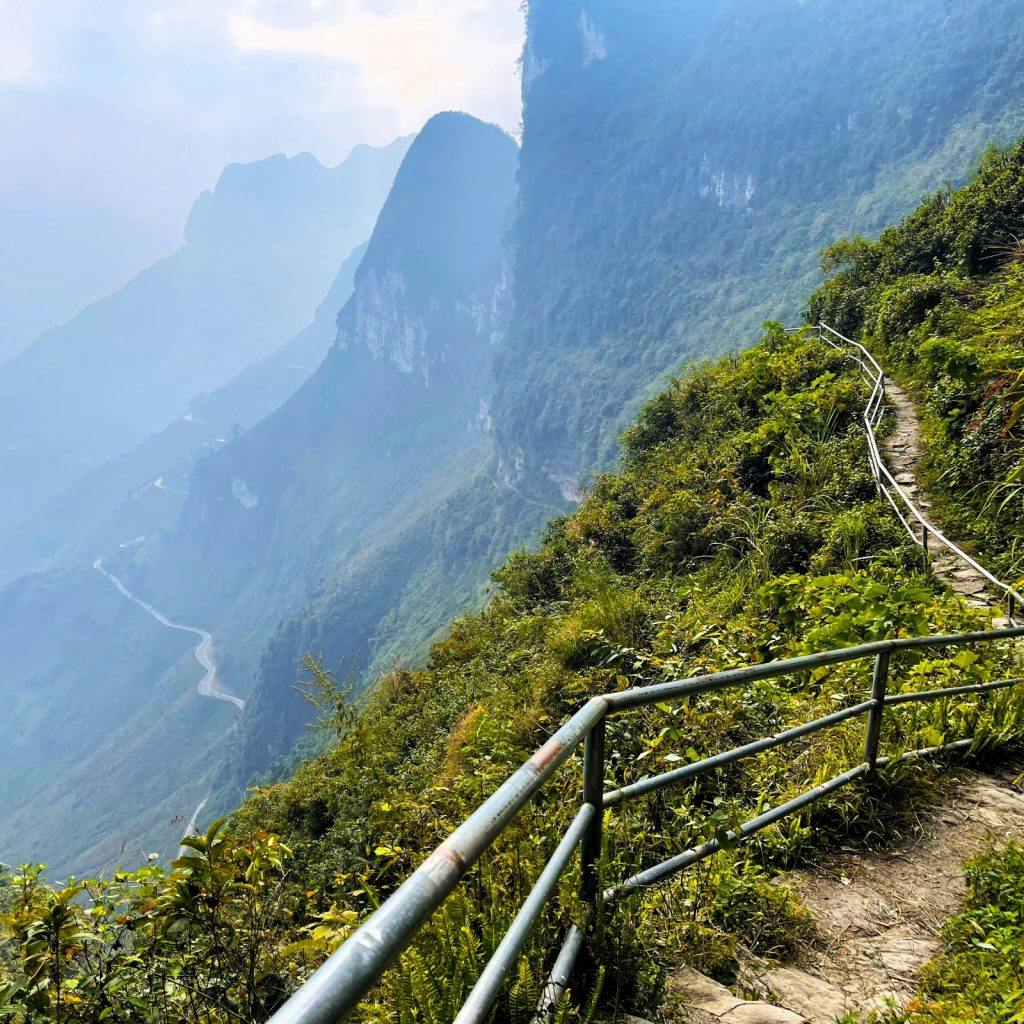
Sky Path Hike | Ha Giang
A soaring walkway clinging to the cliffs hundreds of metres above the legendary Mã Pí Lèng Pass in Hà Giang…
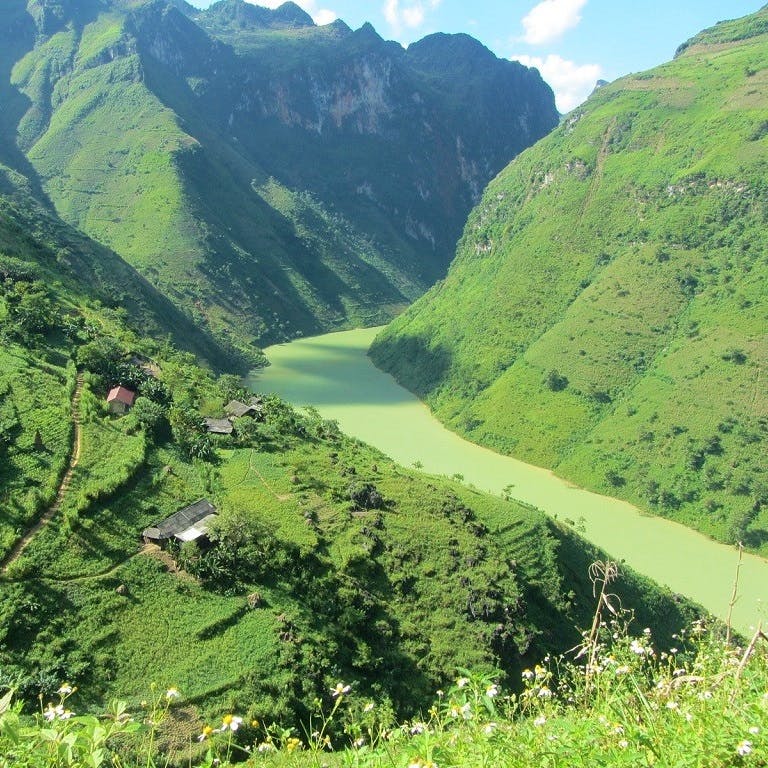
Ha Giang Province | Picture Book
One of the most visually arresting regions in the nation, Ha Giang is Vietnam’s northern-most province. This gallery features 50 images showcasing the beauty of Ha Giang in order to inspire wanderlust…
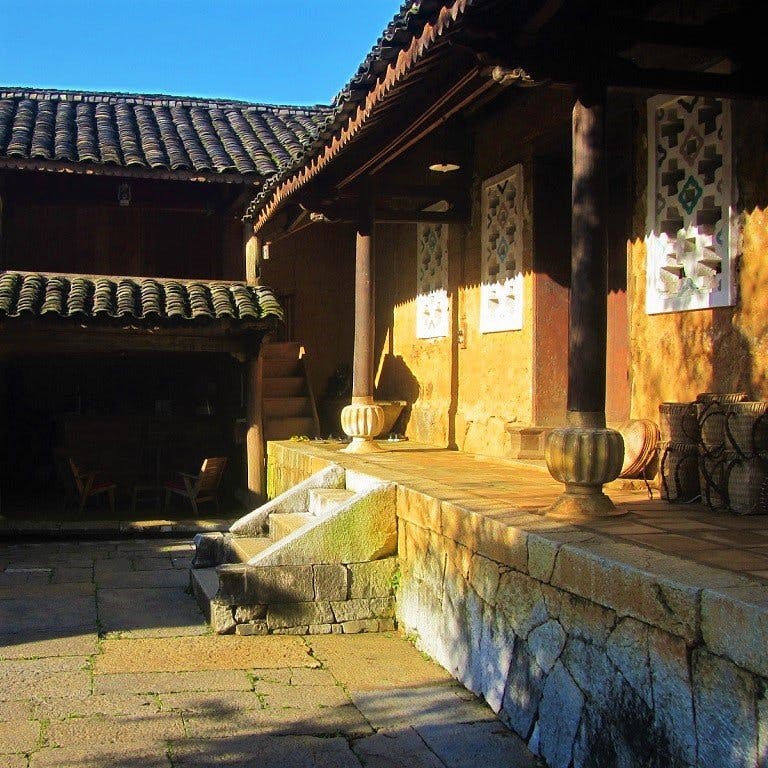
Auberge de Meo Vac Mountain Lodge, Ha Giang
A timber, tile & rammed-earth structure encircling a stone courtyard surrounded by a stone wall with haunting limestone peaks looming all around, the Auberge de Meo Vac is a remarkably atmospheric place to stay in Vietnam’s northernmost province, Ha Giang….
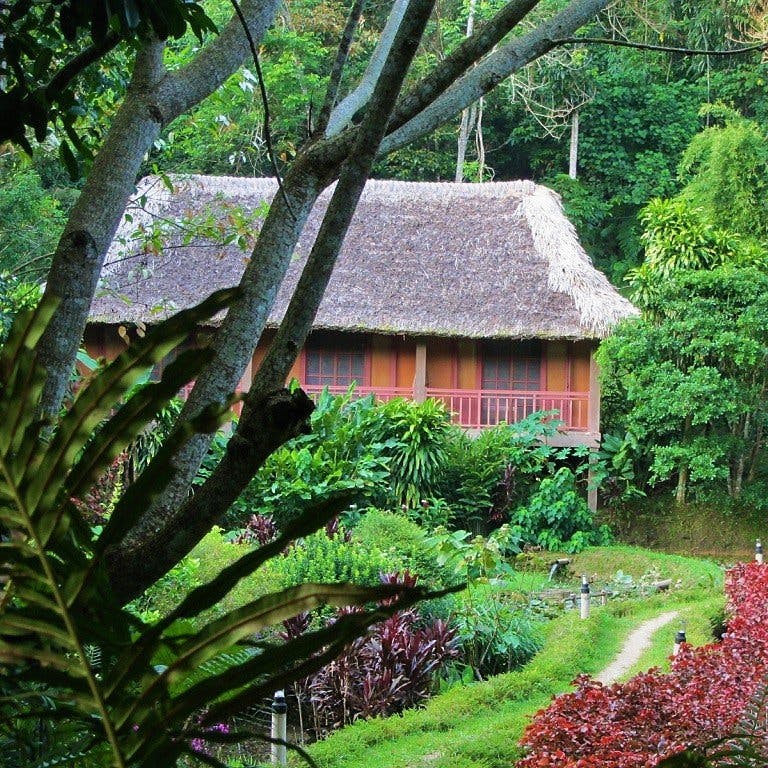
Panhou Village Ecolodge, Ha Giang
Deep within the folds of steep mountains & plunging valleys, Panhou Village Ecolodge is set in the middle of a remote & seldom-visited part of Ha Giang, Vietnam’s northernmost province….
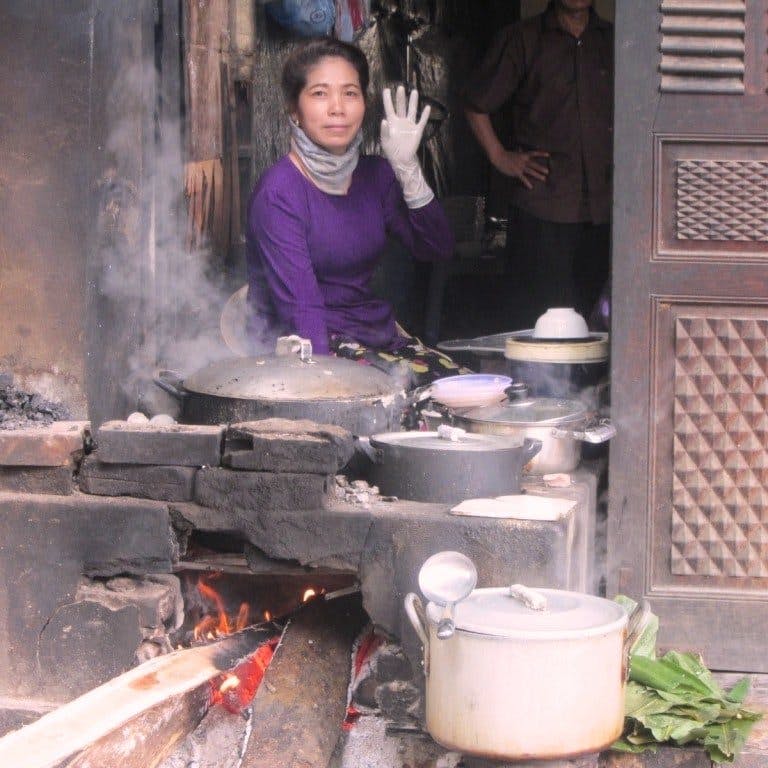
Breakfast in Ha Giang
When I had breakfast at a noodle house in Ha Giang, Vietnam’s northernmost frontier, it was one of those occasions when food, people and place come together perfectly…
Questions, updates and trip reports are all welcome. However, please keep comments polite and on-topic. See commenting etiquette for details.
This is a very well written guide. It seems a bit light on the food recommendations, so I’ll add some that I really enjoyed when I was there (all on the west bank – the ones we ate at in the main part of town weren’t as good): On the road south out of town, Phở Chua Lý Dính, 90C đường Nguyễn Trãi In the center below the lookout mountain, 2 Cô Lùn – Quán Ăn Vặt, 403 Nguyễn Trãi (bun dau, bun cha, etc) On a side road south lookout mountainT, Cơm rang giòn Vũ Béo, 25, 19 Tháng 5 street (nhau food including fried rice)
Thanks for the additional food suggestions – sounds good.
Once again, amazing content on Vietnamcoracle! Thanks a whole lot.
And “With these cheap cookie cutter agencies you’re likely to be in groups of 30 people or more, which might dilute the sense of adventure offered by the province.” that’s a given… Those huge tour group following a little flag is killing the area.
I just don’t understand how backpackers went from adventure seekers, following bad maps on LP, finding your own ways, getting lost to just paying people to be told where to eat, sleep, drink, where to stop.
Might just be me becoming an old cranky ‘back in my days’ type of guy, which could be even worse.
Hi Nicolas,
Thanks, I’m glad you enjoyed this guide.
Yes, Ha Giang is now receiving a much higher number of visitors than ever before and it remains to be seen how the province will deal with this. Some areas of Vietnam, such as Phong Nha, have managed to expand their tourism sector successfully without ruining the natural environment and the experience, so we’ll see.
__hanoi-water-puppets.jpg)
- Grand Tours Vietnam
- Halong bay and Cat Ba island
- Hanoi & Around
- Sapa & Northern Highland
- Central Coastline
- Saigon & Around
- Mekong Delta
__angkor-wat-blue-reflections.jpg)
- Grand Tours Cambodia
- Around Angkor & Siem Reap
- Around Phnom Penh & the Coast
__vientiane-buddha-park-monks.jpg)
- Grand Tours Laos
- Luang Prabang & the North
- Vientiane & the South
__bagan-dhammayazika-dusk.jpg)
- Grand Tours Myanmar
- Myanmar beach holiday
- Tour finder
- Local Pioneers
- Why Responsible Travel matters
- Making all tourism more sustainable
- Our role as a DMO
- Certification
- Our projects
- Mindful Travel Tips
- Refill Hanoi Info
- Refill Hanoi Map
- Trip Report
Ha Giang travel guide: Things you should know before you travel to Ha Giang
- Sapa and Bac Ha
- Cat Ba Island
- North East Vietnam
- Ninh Binh and Tam Coc
- Hoian and Da Nang
- Quy Nhon and Nha Trang
- Mui Ne - Ho Tram- Vung Tau
- Ho Chi Minh City
- Phu Quoc and Con Dao island
- Dalat and Centre Highlands
- National Parks
- Wellness retreat
- Ly Son Island
- Family Travel
Do you want to get away from the hustle and bustle of the city? Do you want to relax and be immersed in nature? Do you want to challenge yourself with trekking and other adventurous activities? Undoubtedly, Ha Giang, located in the far northeast of Vietnam, is ideal for your trip. Let’s find things to know before you travel to Ha Giang with Handspan Travel Indochina !
Through this article, you will learn these pieces of information below.
General information about Ha Giang
The ideal time to travel to ha giang, how to get to ha giang from hanoi, attractions to visit in ha giang, specialties in ha giang, accommodations in ha giang, some tips before you travel to ha giang.
- Ha Giang sample tours
Ha Giang, about 280 kilometers from Hanoi, is one of the most attractive destinations in the North of Vietnam. It borders Cao Bang Province in the East, Yen Bai and Lao Cai Provinces in the West, Tuyen Quang Province in the South, and China in the North.

Traveling to Ha Giang
With a total area of nearly 8000 square kilometres, Ha Giang is famous for its stunning landscapes of mountains, rivers, forests, and terraced rice fields. Thanks to these natural conditions, this destination is exceptionally ideal for trekking, rock climbing, and scenic driving.
Besides natural beauty and adventurous activities, Ha Giang is also well-known for its rich cultural and ethnic identities. It is home to diverse ethnic groups, including the Dao, Hmong, and Tay, with their own unique customs and traditions. When you travel to Ha Giang, you will have a chance to learn about the ethnic minority people’s culture and daily life by visiting local markets, talking with locals, joining their festivals, etc. The Love Market and New Rice festivals are outstanding festivals in Ha Giang.
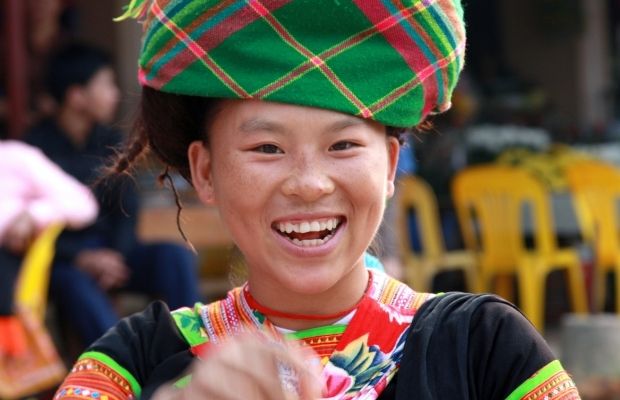
Hmong girl in Ha Giang
In general, Ha Giang will surely exceed your expectations, whether you come here to relax, soak in nature, or learn more about ethnic minorities here. Let’s continue reading for more information!
Ha Giang has its unique beauty in every season. Therefore, you can travel to Ha Giang at any time of the year, depending on your time and itinerary. Let’s see Ha Giang each season to decide your ideal time to come here.
Ha Giang in January, February, and March
If you want to admire blooming flowers, the first three months of the year are the ideal time to travel to Ha Giang. During this period, Ha Giang is filled with peach, plum blossoms, and yellow mustard flowers, which creates impressive scenery. Besides, visiting Ha Giang this time, you will have a chance to join featured festivals of the local people, such as the Hmong people’s Gau Tao festival, Tay people’s Long Tong festival, Dao people’s Lap Tinh festival, etc.
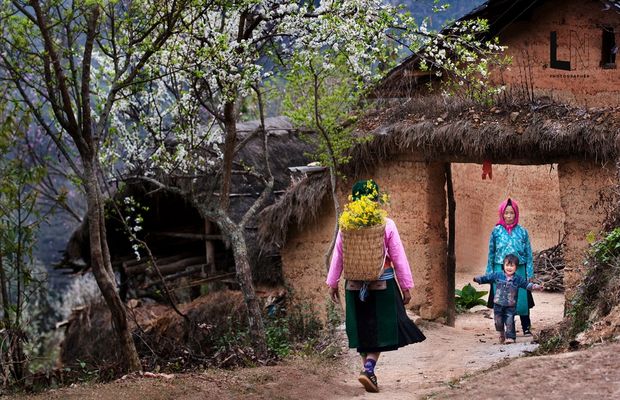
Ha Giang in spring
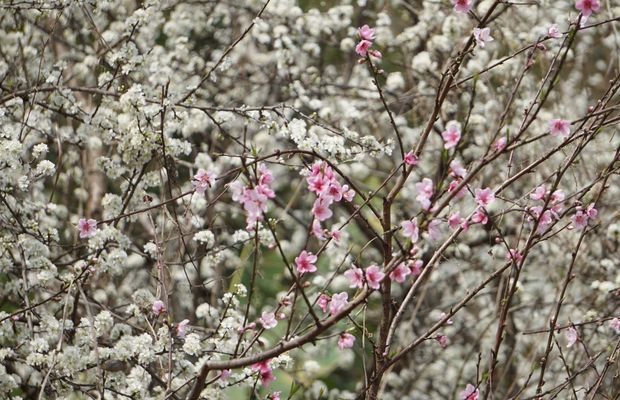
Plum and peach blossoms in Ha Giang
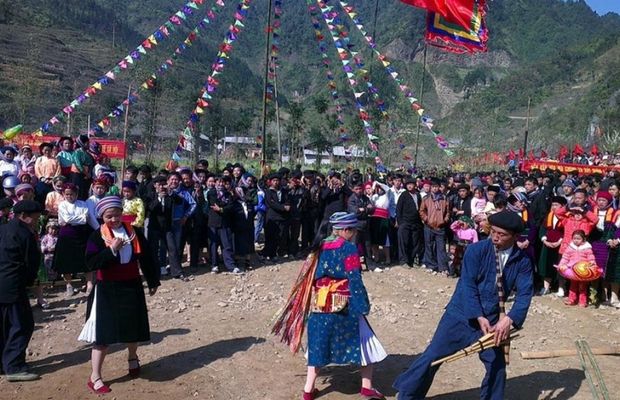
Gau Tao Festival in Ha Giang
Ha Giang from April to June
If you cannot arrange your time to join spring festivals, don’t worry, you can travel to Ha Giang in April when you can enjoy the crowded atmosphere of the Khau Vai Love Market festival. At the festival, you will catch up with local people wearing traditional clothes, dancing, singing, buying goods, etc.
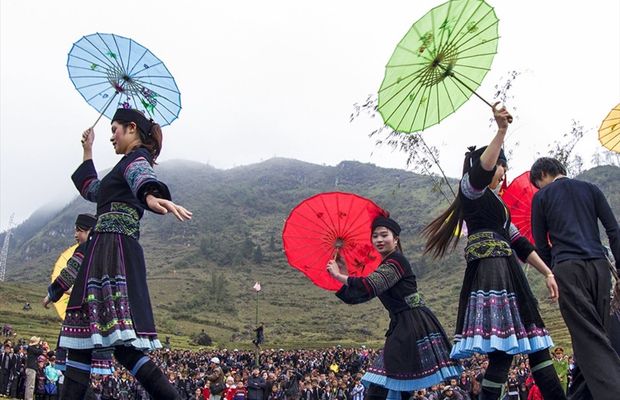
Khau Vai Love Market Festival
Ha Giang comes to the pouring water season in May and June when the terraced rice fields look like a giant mirror. Walking around the villages, you will catch up with local farmers busy preparing for the new crop.
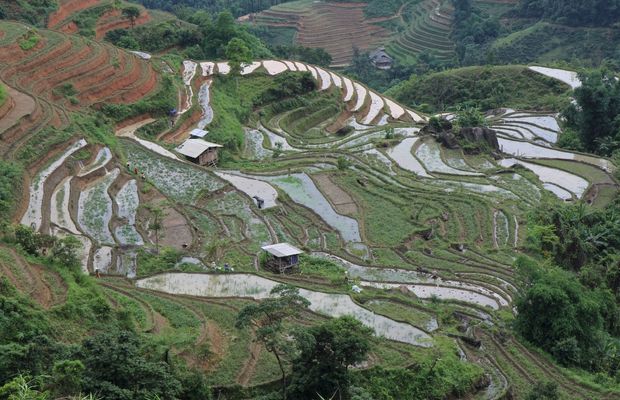
Ha Giang in water pouring season
Visiting Ha Giang from July to October
July to October is the best time to travel to Ha Giang. Trekking around the villages or driving your motorbike on winding roads, you can catch up with the glistening scenery of the golden terraced rice fields along the way.

Yellow terraced rice fields in Ha Giang
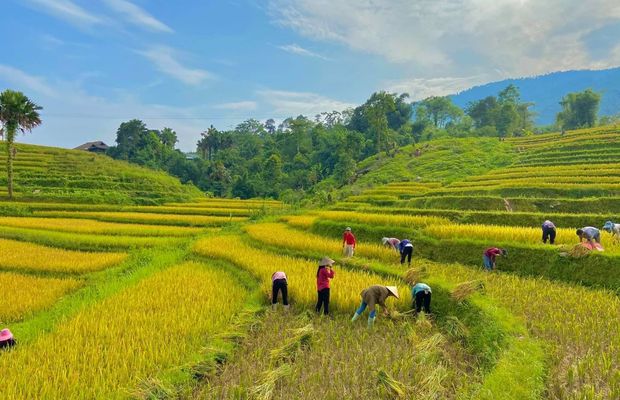
Ha Giang in harvesting season
Ha Giang from October to December
You can admire blooming buckwheat and yellow mustard flowers at this time. Lung Cu Flagpole, Lung Cam - Sung La cultural village, Ma Pi Leng Pass, and Quan Ba are some ideal places to have the best view of bucket flowers.
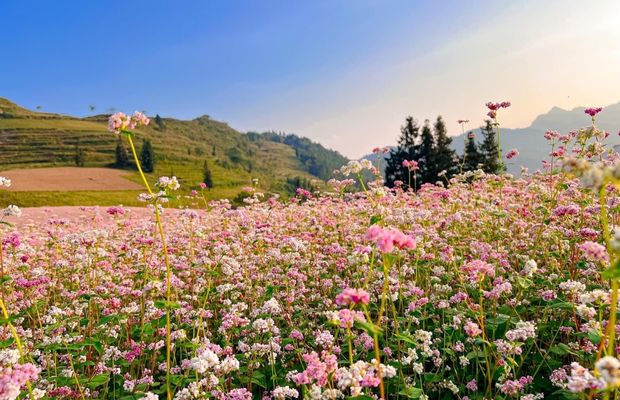
Buckwheat flower season in Ha Giang
Principally, Ha Giang is beautiful in any season of the year. However, you may want to check the weather before traveling to Ha Giang for the best experience here. For more detailed information, please refer to our blog post: What is the ideal time to visit Ha Giang ?
From Hanoi, you can drive a motorbike or travel by bus or limousine. Let’s see each way in detail.
Driving a motorbike to Ha Giang
If you are an adventurous lover, driving a motorbike to get to Ha Giang from Hanoi is an ideal choice. By driving a motorbike, you can admire the stunning scenery and stop at any spot on the way. It takes about 7 hours to reach Ha Giang by following one of the two routes below.
- The first route: Hanoi - Vinh Phuc - Viet Tri - Phu Tho - Tuyen Quang - Ha Giang
- The second route: Hanoi - Son Tay- Trung Ha Bridge - Co Tiet - Phong Chau Bridge - Phu Tho - Doan Hung - Tuyen Quang - Ha Giang
Although driving a motorbike is ideal for admiring the landscape, you should be careful if you are unfamiliar with the Vietnamese transportation system. If you are not confident with your driving skill, traveling to Ha Giang by bus or a limousine will be better.
Getting from Hanoi to Ha Giang by bus
Using a coach is the most common way to reach Ha Giang. There are several bus companies operating the route from Hanoi to Ha Giang, offering both regular and sleeper bus options. The buses run from My Dinh, Luong Yen, Yen Nghia, and Gia Lam bus stations, with the price from VND 200,000/ person/ turn. Quang Tuyen, Quang Dao, and Quang Nghi are some bus companies you can choose from.
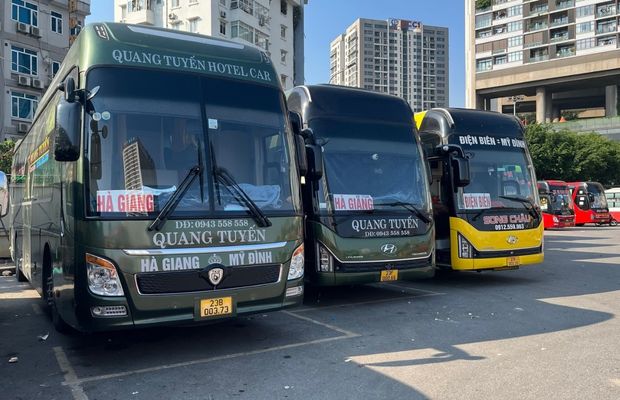
Quang Tuyen bus
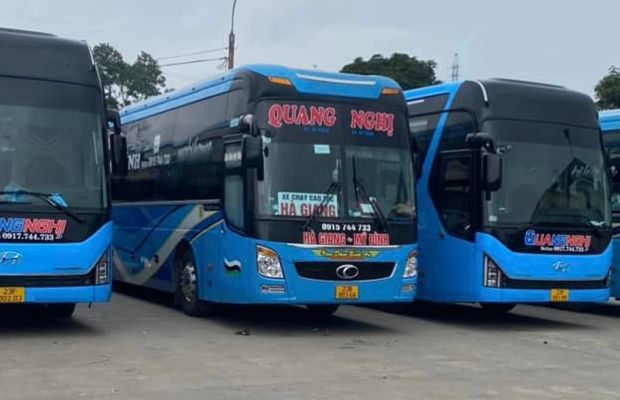
Quang Nghi Bus
Getting to Ha Giang from Hanoi by limousine
Compared to the bus, using a limousine with fewer seats is more comfortable for getting to Ha Giang. It takes you from VND 250,000 per seat per turn, depending on the position of the seat you choose. There are many limousine companies that you can choose from, such as Ngoc Cuong Limousine, Luxury Van Limousine, Ha Giang Epic Limousine, etc.

Ha Giang Epic Limousine
Besides these above means of transportation, you can hire a private car if you want to travel to Ha Giang in your own group. Please do not hesitate to contact us if needed. Otherwise, you can refer to our blog post: How to get from Hanoi to Ha Giang?
Ha Giang has stunning landscapes, diverse ethnic minority cultures, and unique geological formations. Here are some main tourist attractions you should not miss when you travel to Ha Giang.
Quan Ba Heaven’s Gate
Quan Ba Heaven’s Gate, 43 kilometers from Ha Giang City’s center, is 1500 above sea level, between two mountain peaks. It is a scenic mountain pass that provides views of Ha Giang's stunning valleys and peaks.
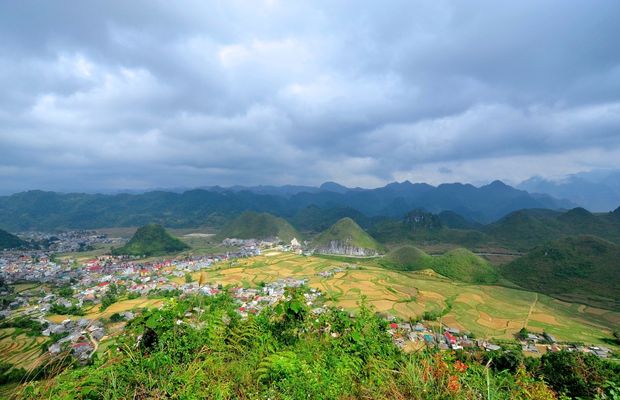
View from the Quan Ba Heaven's Gate
Quan Ba Twin Mountain
Quan Ba Twin Mountain, or Co Tien Twin Mountain, is about 40 kilometers from Ha Giang city’s center, located on National Highway 4C, Tam Son Town, Quan Ba, Ha Giang. Depending on the time you come here, you can see it blended with different colors, like the pink of buckwheat flowers, the yellow color of ripe rice fields, and the blue sky.
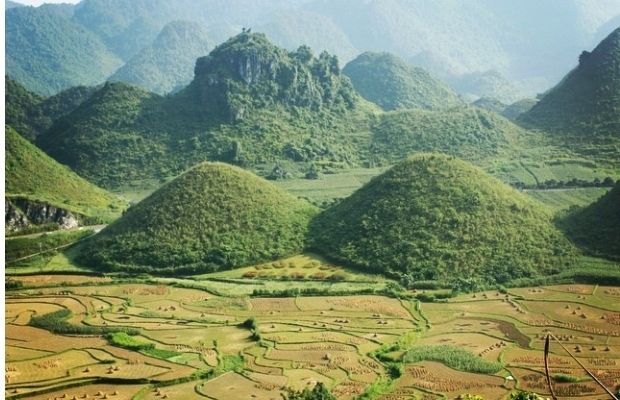
Dong Van Old Quarter
Dong Van Old Quater, 150 kilometers from Ha Giang city’s center, is one of the attractions you should not miss when you travel to Ha Giang. It is home to the Tay, Hoa, Mong, Nung, and Dao ethnic minorities people. Until now, this spot still retains its ancient beauty and nostalgic atmosphere with typical house architecture.
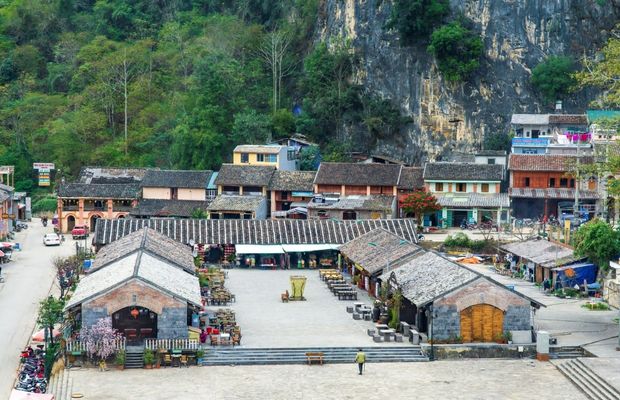
Dong Van Old Town
Dong Van Karst Plateau
The Dong Van Karst Plateau is a UNESCO Global Geopark located in Ha Giang. This unique and breathtaking landscape is characterized by towering limestone cliffs, deep valleys, and unique rock formations.
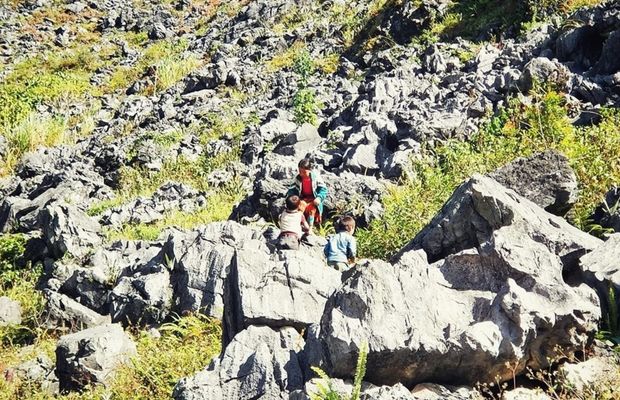
Lung Cu Flag Tower
Located at the northernmost point of Vietnam, this tower offers views of the stunning landscapes of Ha Giang and is a symbol of Vietnamese sovereignty over the northern border region. To reach the flagpole, you will have to climb more than 1000 steps; however, it’s worth it.
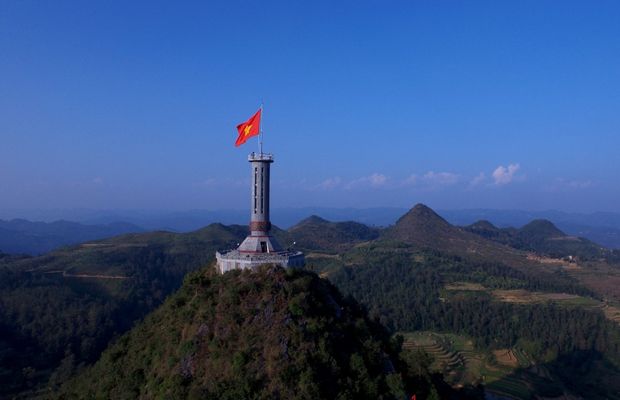
Ma Pi Leng Pass
Ma Pi Leng Pass is one of the most majestic passes in Vietnam, connecting Dong Van and Meo Vac. You can admire a panoramic view of the Nho Que River under and surrounding mountains and forests from the pass.

Tu San Alley
Tu San Alley is among the best spots you may want to come to when you travel to Ha Giang. With a cliff height of nearly 800m, a depth of almost 1km, and a length of 1.7km, Tu San Alley makes an unforgettable impression on every tourist who comes here for its majesty.
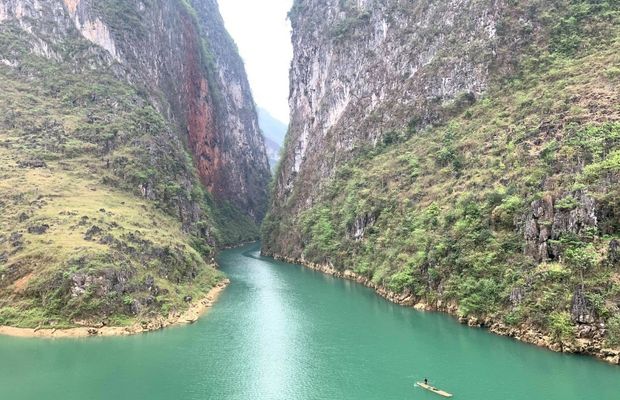
The Palace of the Hmong King - Dinh Vua Meo
The Palace of the Hmong King was built in the early 20th century, located in the Xa Phin Commune, Dong Van District, Ha Giang. Besides the unique ancient architecture, you will know more about the history and patriotic stories.
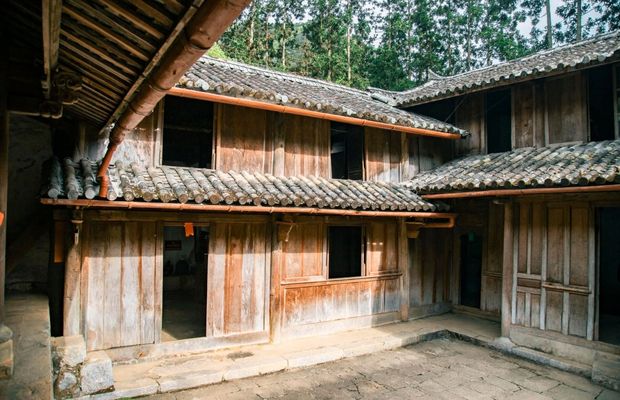
Besides these above attractions, don’t forget to visit Hoang Su Phi in the ripe rice season to adore a magnificent landscape.
Refer to our blog post here for more information about the amazing attractions in Ha Giang.
Another major draw for visitors to Ha Giang is its unique and varied cuisine. The region is home to many specialty dishes, such as bamboo shoot soup and corn wine, which are rarely found in other parts of Vietnam. These local foods are often made using traditional cooking methods and ingredients, offering Ha Giang's unique and authentic taste. Below are some specialties you should try when you travel to Ha Giang.
This dish includes horse, beef, pork, and buffalo meat. Besides the meat's tasty flavor, the broth is a particular characteristic of this food. It is mixed from 12 different spices, such as pepper, cinnamon, cardamom, etc. You may find this dish strange; however, if you want to know more about the locals, it is really worth trying.
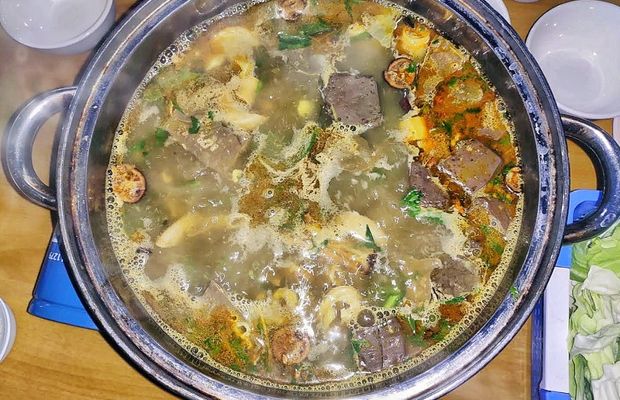
Thang Co Ha Giang
Buckwheat flower cake
Buckwheat flower cake is a typical cake of the Mong people in Ha Giang. The cake has a fragrant, slightly sweet taste.
Au tau porridge
Au tau porridge is made from upland glutinous rice, grilled pork, and Au tau tubers. This dish is extremely good for health and helps against joint pain. The bitter taste of Au tau tuber, combined with the aroma of pork and spices, creates an unforgettable flavor.
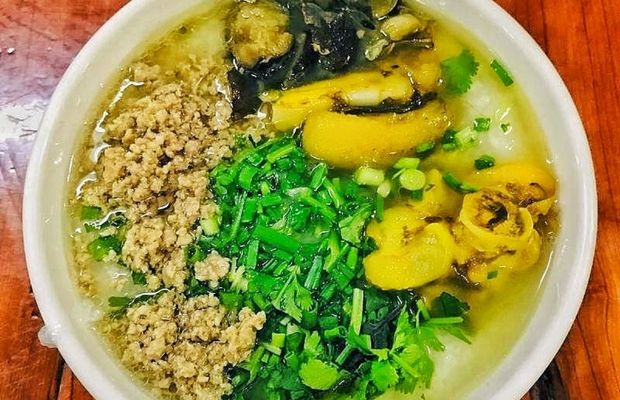
Let’s travel to Ha Giang and try unique specialties here! Besides those above dishes, there are many other tasty foods you should not miss. Refer to our blog post: The top 09 must-try foods in Ha Giang .
Ha Giang has various accommodation options to suit different budgets and preferences. Here are some of the most common options.
Homestays are a popular and affordable option in Ha Giang, allowing you to experience local life and culture. Staying in the homestays, you will have a chance to learn the unique customs and traditions of the area. Below are some homestays you should refer to when you travel to Ha Giang.
- Address: Lo Lo, Dong Van, Ha Giang
Homie homestay Ha Giang impresses tourists with the Lo Lo people’s beautiful and harmonious wall house architecture. Staying here, you will have a chance to learn to cook local dishes, embroidery, sew basic patterns, and dye.
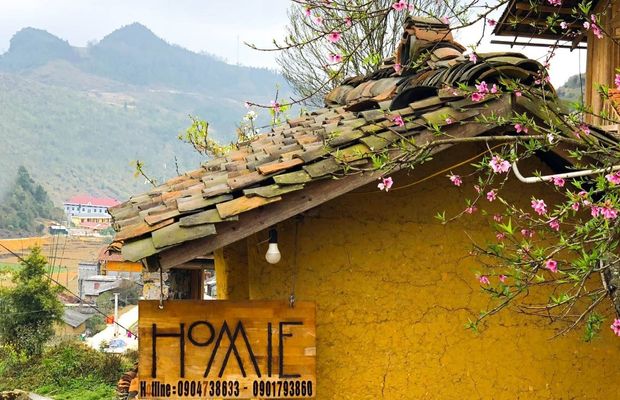
Homie Homestay Ha Giang
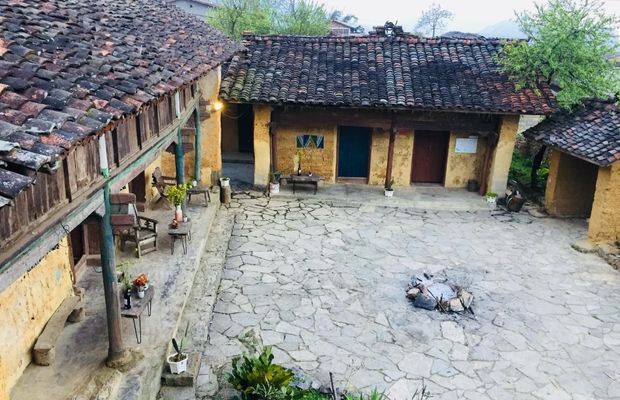
- Address: Chung Pa A, Meo Vac, Ha Giang
Auberge de Meo Vac is imbued with the style of the Hmong people with plain decoration. You will have a chance to enjoy the majestic atmosphere and nature and experience: massage, restaurant, bar serving drinks, etc.
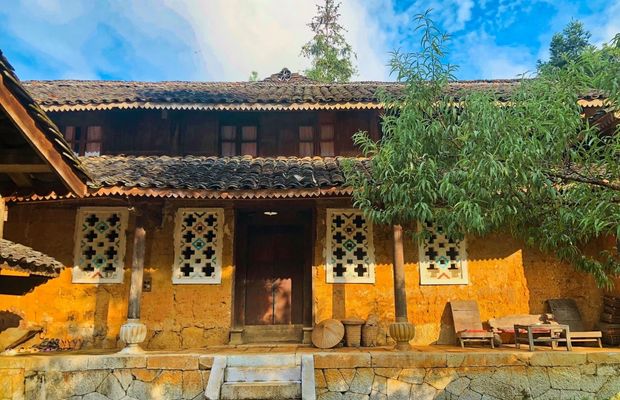
Auberge de Meo Vac
- Address: Nam Dam, Quan Ba, Ha Giang
Dao Lodge Homestay Ha Giang is an ideal place to learn about the Dao people’s daily life. The homestay has a unique space designed from bamboo and soil, creating a warm and close feeling.
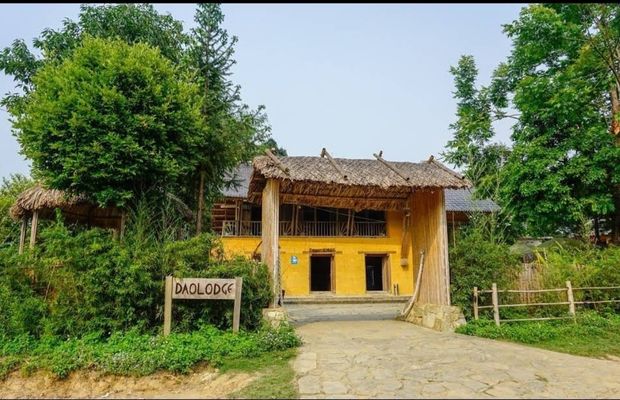
More homestays in Ha Giang here: The top 07 amazing homestays in Ha Giang you should not miss .
Ha Giang has a range of hotels, from budget options to more luxurious accommodations. These can range from basic guesthouses to larger, more modern hotels and are a good option for those who prefer a more traditional type of accommodation. Below are some hotels you can refer to.
- Address: 70 Le Quy Don Street, Nguyen Trai Ward, Ha Giang City, Ha Giang Province
Hoa Cuong Hotel Ha Giang is located in the center of Ha Giang City, with a quiet and airy landscape. The hotel has five floors and 34 rooms divided into three room types: rooms with one bed, two beds, and three beds. All rooms are equipped with modern equipment, such as a TV with an Internet connection, wifi, etc.
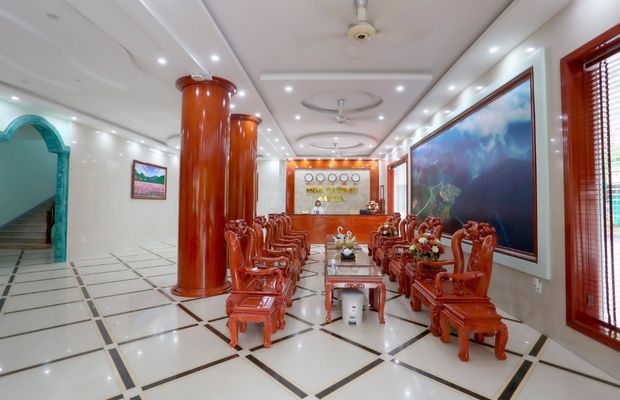
Hoa Cuong Hotel Ha Giang
- Address: Dong Van Town, Dong Van District, Ha Giang Province
Hoa Cuong Dong Van Hotel, located in the center of Dong Van Town, is another hotel in the Hoa Cuong Hotel Group. Staying in the hotel, you can enjoy a panoramic view of Dong Van Town and easily reach the Dong Van Karst Plateau. The hotel has nine floors and 81 bedrooms, including 58 Twin rooms, seven 3-bed rooms, 14 1-bed rooms, and 2 VIP rooms.
- Address: Meo Vac Town, Meo Vac District, Ha Giang Province
Hoa Cuong Meo Vac Hotel is smaller than Hoa Cuong Ha Giang Hotel and Hoa Cuong Dong Van Hotel, with only 28 rooms. However, it is also equipped with modern facilities which bring you the comfortability.
- Address: 92T Nguyen Trai Street, Ha Giang City, Ha Giang Province
Phoenix Hotel is an ideal choice of accommodation when you travel to Ha Giang. Besides the ideal location and space, the hotel also provides tourists with luxurious and comfortable rooms, advanced facilities, and services from cuisine to health and beauty care.
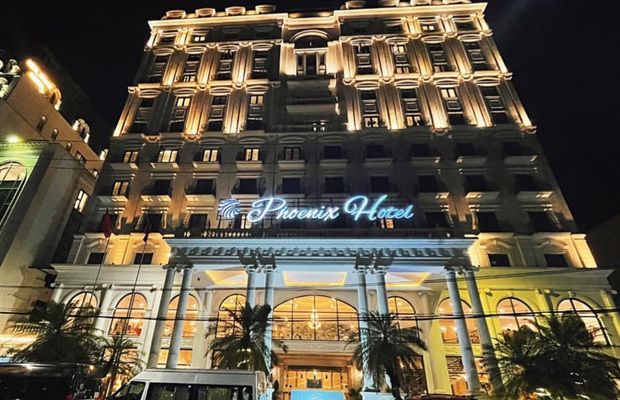
Phoenix Hotel Ha Giang
Most rooms in the hotel have a panoramic view of the city and beautiful natural scenery. There are 140 rooms divided into three room types: Superior, Deluxe, and Suite Room.
For those looking for a more luxurious experience, there are several resorts in Ha Giang that offer high-end facilities and services. These resorts are typically located in more remote areas, surrounded by stunning natural scenery. Here are some resorts you may not want to miss when you travel to Ha Giang.
- Address: Yen Dinh Commune, Bac Me District, Ha Giang Province
P’apiu Resort is one of the most luxurious resorts in Ha Giang, nestled in the dense forest. This resort is exceptionally suitable for couples, with only three rooms: The Mellow, Layla Qays, and The Fluffy. Each room has a different design and decoration style and is fully equipped with modern facilities. Besides the unique space, you will also have a chance to enjoy many services in P’apiu resort, such as outdoor jacuzzi, foot massage, zipline, outdoor movie, etc.
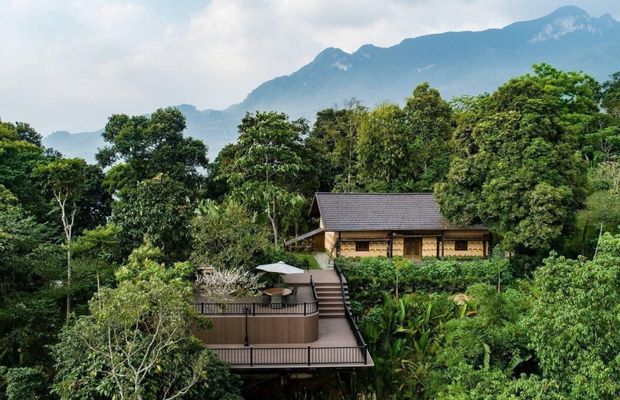
P'apiu Resort in Ha Giang
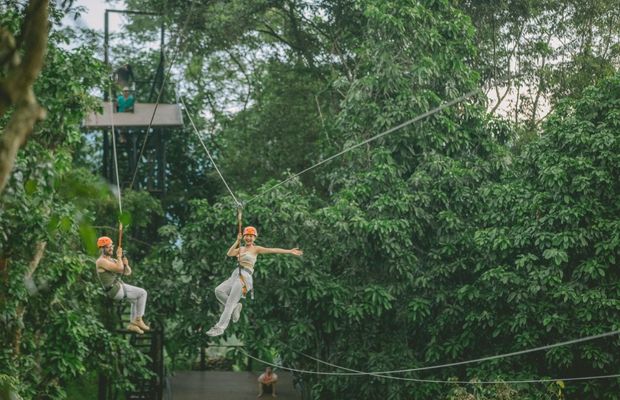
Zipline in P'apiu Resort
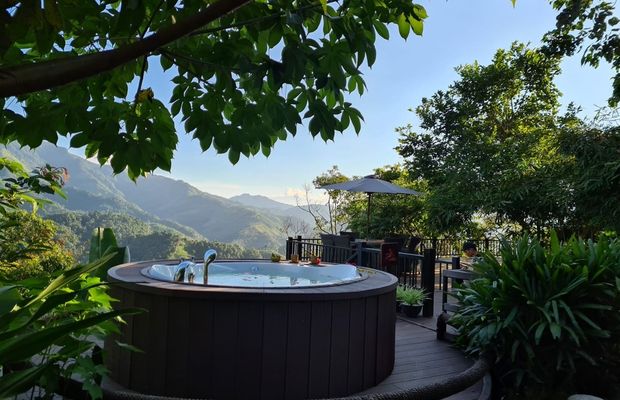
Outdoor jacuzzi in P'apiu Resort
- Address: Giang Village, Thong Nguyen, Hoang Su Phi, Ha Giang
Ecolodge Pan Hou Village is an environmentally-friendly resort in Ha Giang with a Solar hot water system and fan. Staying here, you can admire and immerse yourself in the stunning scenery of Hoang Su Phi and learn about the culture of nearby ethnic minority people.
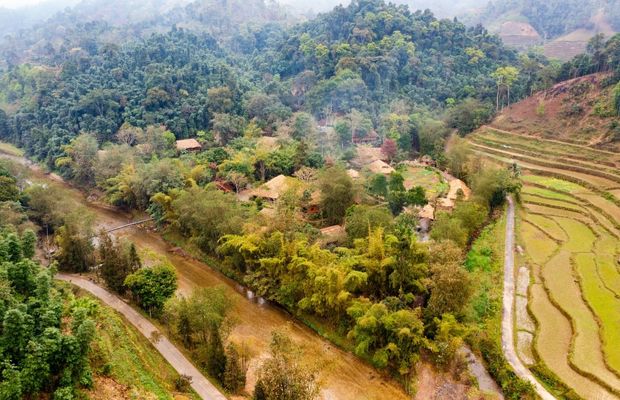
Ecolodge Pan Hou Village
The resort has 30 rooms divided into four room types: Superior Window, Deluxe Balcony, Suite, and Dormitory room (16 single beds). All rooms are provided with full amenities with warm decorations.
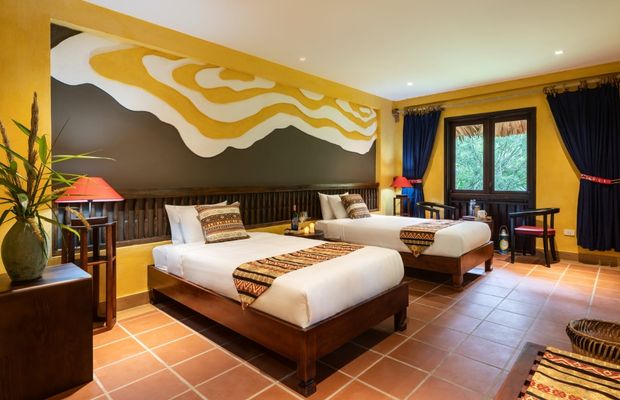
Superior room at Ecolodge Pan Hou Village
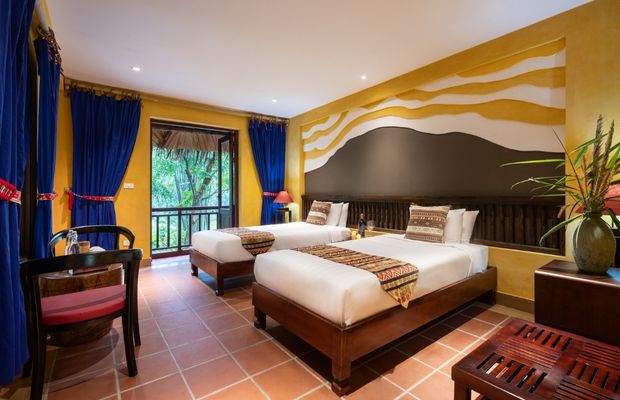
Deluxe Balcony room at Ecolodge Pan Hou Village
- Address: Trang Kim, Dong Ha Commune, Quan Ba District, Ha Giang Province
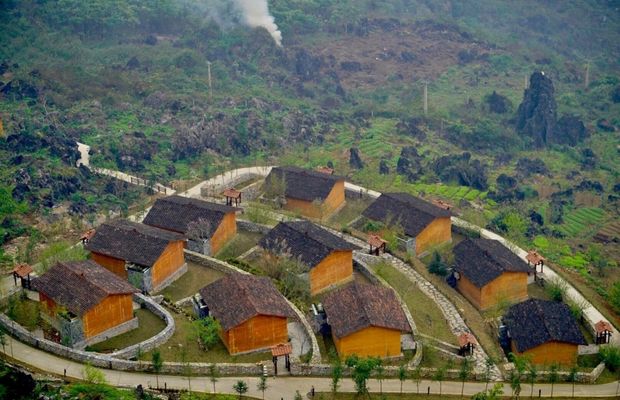
Hmong Village Resort
H’mong Village Resort attracts tourists through its unique architecture and designs imbued with the typical cultural identity of the locals. The resort has a total area of 20 ha, including two areas: 25 bungalows and a community stilt house with a capacity of 50 people. Staying in the resort, you will have an opportunity to experience a trekking tour to explore the Lung Khuy Cave, one of the most beautiful caves in Ha Giang. Besides, you can also take a local tour to traditional craft villages such as the traditional flax weaving village of the Mong people in Lung Tam, the traditional corn wine-making village of the Mong people in Thanh Van, etc.
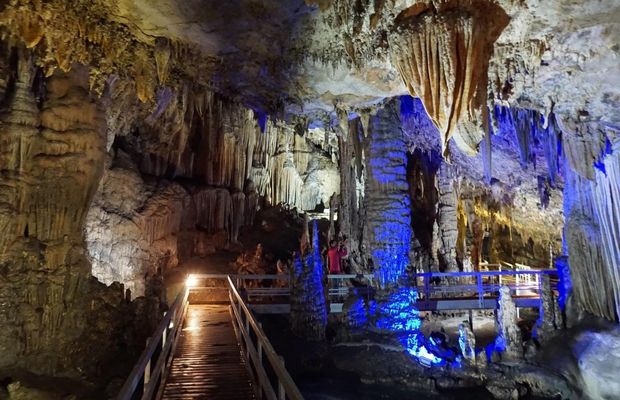
Lung Khuy Cave
For more detailed information or to book any accommodation above, please do not hesitate to contact our Handspan team.
Before traveling to Ha Giang, it will be better to check everything beforehand. Here are some tips you may want to refer to before you travel to Ha Giang.
Plan your itinerary
Ha Giang is a large province; therefore, it's essential to plan your itinerary to make the most of your time there. Let’s decide the sites you want to visit and learn how to reach these sites.
Pack appropriately
Ha Giang may be pretty cold in the evenings or early mornings, even in the summer. Accordingly, you should pack warm items of clothing. Besides, bringing essential items such as toiletries, medicine, and a first aid kit is a good idea.
Get travel insurance
Traveling to Ha Giang is quite adventurous; therefore, travel insurance may be needed. It can provide peace of mind in case of unexpected events such as illness, injury, or lost or stolen belongings.
Respect local customs
Ha Giang is home to many minority ethnic groups, each with their own unique culture and customs. It's essential to be respectful and learn about these cultures before visiting.
Be aware of the road conditions.
The roads in Ha Giang are exceptionally winding and steep, and conditions can be challenging, especially during the rainy season. So, ensure that you have a reliable mode of transportation and a skilled driver. If you are unfamiliar with Vietnam’s transportation system, please do not drive a motorbike yourself, as this is quite dangerous.
Ha Giang sample tour packages
Ha Giang is relatively large. Therefore, it will be better if you take a tour package to Ha Giang instead of traveling on your own. Here are two Ha Giang tour packages that Handspan Travel Indochina offers.
Terraced Beauty: Exploring Hoang Su Phi and Sapa
Embark on an unforgettable journey through Northern Vietnam's cultural and natural treasures. Explore the captivating landscapes of Hoang Su Phi and Bac Ha's legendary Rice Terraces, witnessing the living heritage of the region. Here is the general itinerary.
- Day 1: Hanoi - Lao Cai
- Day 2: Lao Cai - Hoang Su Phi
- Day 3: Hoang Su Phi - Bac Ha
- Day 4: Bac Ha - Sapa
- Day 5: Sapa - Hanoi
For detailed information, please refer here: Terraced Beauty: Exploring Hoang Su Phi and Sapa .

Epic Expedition Ha Giang to Ba Be
This epic expedition Ha Giang to Ba Be has been handcrafted to bring you an array of colorful ethnic minority communities, stay in local villages, and visit lively tribal markets while traveling through dramatic mountain and forest landscapes. Let's have a look at the itinerary!
- Day 1: Hanoi - Xuan Giang
- Day 2: Xuan Giang - Quan Ba
- Day 3: Quan Ba - Dong Van - Meo Vac
- Day 4: Meo Vac Hiking
- Day 5: Meo Vac - Ba Be National Park
- Day 6: Ba Be National Park
- Day 7: Ba Be - Hanoi
For more information, here is the tour package you can refer to: Epic Expedition Ha Giang to Ba Be .
In conclusion, you have just learned some detailed information before you travel to Ha Giang. Should you need any assistance with hotel/ tours, please feel free to contact us anytime.
- Handspan Travel Indochina
- travel to Ha Giang
- Ha Giang travel guide
The most viewed videos
- Traditions & Customs in Vietnam
- Low season .Vs. High season. Everything you need to know
- Sapa through each season - What is the best time to visit Sapa?
- 10 things to do in Vietnam before Têt, the Lunar New Year
- New luxury train between Hanoi and Ho Chi Minh City
You might also enjoy
- Practicing sustainable tourism in Vietnam: Tips for responsible travelers - Handspan Travel Indochina
- Chol Chnam Thmay Festival in Cambodia - A unique festival of the Khmer People
- Celebrating culture and community: Bunpimay Festival in Laos - Handspan Travel Indochina
- Exploring the top 09 amazing ecotourism sites in Vietnam - Handspan Travel Indochina
- Exploring the unique culture in the Mekong Delta region of Vietnam - Handspan Travel Indochina
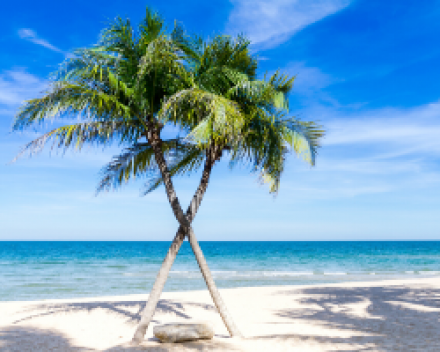
Relevant tours
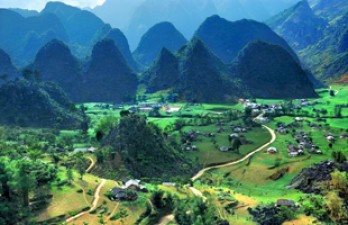
- Hanoi Head Office - 78 Ma May, Hanoi
- Phone: +84 24 3926 2828
- Fax: +84 24 3926 2792
- Email: [email protected]
- [Hot Line in English & Vietnamese only]
Skype Live Chat
- Annie, Nguyen (Mrs.)
- Huong, Nguyen (Mrs.)
Indochina highlights
- Cruise Halong bay
- Explore Angkor temples
- Experience Luang Prabang
- Discover Myanmar
- Booking terms and conditions
Location map
- Tour Package
- Responsible travel
- Tour catalog
- Customize a tour
HaGiang Travel
- Tailor made tour
- Visa service
- Customer Feedback
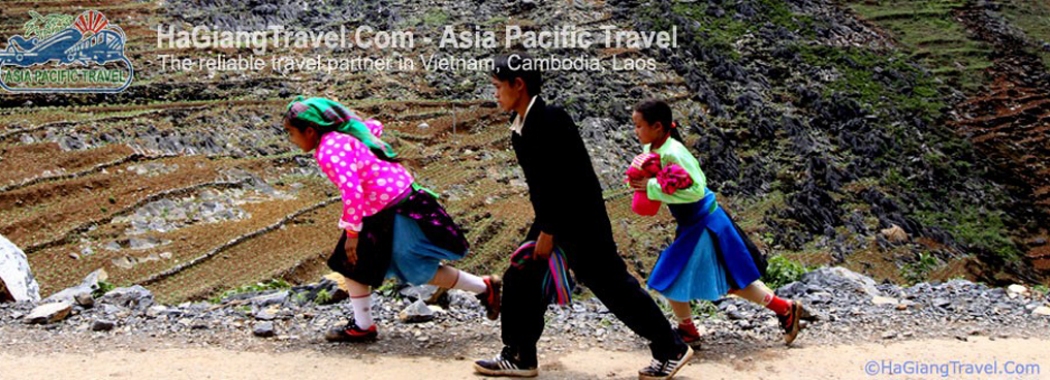
Hanoi - HaGiang - Dong Van - Yen Minh - MeoVac 5 days
Hanoi hagiang meovac caobang bangioc water fall 6 days.
- Ha Giang Town
- Hoang Su Phi
- TOURIST ATTRACTIONS
- 4WD Expeditions
- Bicycle Tours
- Ha Giang Motorbike Tour
- Off-the-beaten path tours
- Trekking Tours
- Cheap Hostels
- Homestay in tribal village
- Ha Giang Resort
- Architecture/Culture/Traditions
- Ethnic Groups
- Restaurants
- Travel Blogs
- Tribal Markets
- Vietnam News
- Vietnam Weather
- Travel Articles
- Ha Giang Video Clips
- Ha Giang Vietnam Map
HaGiangTravel.com is a Hanoi, Vietnam based tour operator for those with a yearning for discovery, adventure, and fun. We specialize in small group cultural travel and wilderness adventures in north Vietnam and especially in HaGiang province area. Our standard or tailored programs will allow you to meet the local people of these exotic lands. With an excellent staff and our personal service, you will have lots of fun on a quality holiday that you will never forget. We have served thousands of tourists from all over the world to visit Vietnam and neighboring countries for more than 10 years . Most of them are individual - small group tourists.Somes are student groups from German, Uk and France ...on cross cultural trips to hill tribe villages in HaGiang. We look forward to welcoming you to Vietnam !

4WD Expeditions (10)
Visit remote hilltribe villages in north-vietnam travel hanoi ha giang yen minh dong van meo vac.

North-East Vietnam 4WD Adventure Tour Travel Ha Giang Meo Vac Bac Me Cao Bang Lang Son

Trekking BacHa - HaGiang Visit KhauLan - LangTan Hill tribe villages
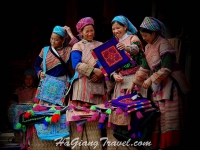
Hiking Adventure Tour in Northern Vietnam Travel through Ba Be lakes Na Bang Bac Me Ha Giang Quang Binh Bac Ha Lung Khau Nhin

Hiking Adventure Tour in Northern Vietnam Travel through Ba Be lakes Bac Me Ha Giang Quang Binh Bac Ha Lung Khau Nhin

North-Vietnam 4WD Overland Expedition Travel Hanoi Quang Binh Ha Giang Bac Ha Sapa
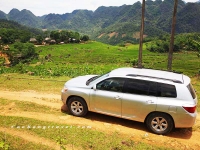
Ha Giang Vietnam Tour Travel Quang Binh Bac Me Meo Vac Dong Van Quan Ba Yen Minh
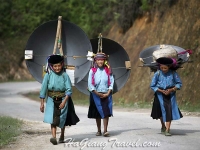
North-West and East Vietnam Holiday Touring Mai Chau Tam Duong Sapa Ha Giang Ba Be
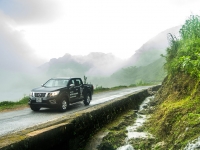
Ha Giang Karst Plateau 4WD Expedition Trip

Traveller Feedback
Dear Mrs. Hai, we wanted to give you some feedback after having accomplished our fantastic trip to the Ha Giang province... >> Read more
Ha Giang is one of the less traveled place in Northern Vietnam. This area is still untouched to many...
This is a historical vestige situating in Ban Sap, Yen Phu at the end of the national road No.34...
Standing on Ma Pi leng mount, tourists can see a river like a silky fillet looming in fog which brings...
Locating close to the Natioanl Road No. 4D, this is an ideal destination for visitors travelling from Bac Ha...
Hanoi Head Office Add:87 Hoang Quoc Viet Str, Cau Giay, Hanoi City , Vietnam Tell : (+84.24) 37568868 Fax : (+84.24) 37567862 Email: [email protected]
DaNang City Office Add: Floor 5th, 35 Cao Thắng, Hai Chau District, Da Nang, Vietnam Tell : (+84.236) 6286088 Fax : (+84.236) 3531897 Email : [email protected]
Ho Chi Minh City Office Add: Suite 403, Floor 4th, 134 Cao Thắng, District 3, Hochiminh city, Vietnam Tell : (+84.28) 38333388 Fax : (+84.28) 38334083 Email : [email protected]
- Travel Insurance
The journalists on the editorial team at Forbes Advisor Australia base their research and opinions on objective, independent information-gathering.
When covering investment and personal finance stories, we aim to inform our readers rather than recommend specific financial product or asset classes. While we may highlight certain positives of a financial product or asset class, there is no guarantee that readers will benefit from the product or investment approach and may, in fact, make a loss if they acquire the product or adopt the approach.
To the extent any recommendations or statements of opinion or fact made in a story may constitute financial advice, they constitute general information and not personal financial advice in any form. As such, any recommendations or statements do not take into account the financial circumstances, investment objectives, tax implications, or any specific requirements of readers.
Readers of our stories should not act on any recommendation without first taking appropriate steps to verify the information in the stories consulting their independent financial adviser in order to ascertain whether the recommendation (if any) is appropriate, having regard to their investment objectives, financial situation and particular needs. Providing access to our stories should not be construed as investment advice or a solicitation to buy or sell any security or product, or to engage in or refrain from engaging in any transaction by Forbes Advisor Australia. In comparing various financial products and services, we are unable to compare every provider in the market so our rankings do not constitute a comprehensive review of a particular sector. While we do go to great lengths to ensure our ranking criteria matches the concerns of consumers, we cannot guarantee that every relevant feature of a financial product will be reviewed. We make every effort to provide accurate and up-to-date information. However, Forbes Advisor Australia cannot guarantee the accuracy, completeness or timeliness of this website. Forbes Advisor Australia accepts no responsibility to update any person regarding any inaccuracy, omission or change in information in our stories or any other information made available to a person, nor any obligation to furnish the person with any further information.
Travel Insurance For Vietnam: Everything You Need To Know
Updated: Apr 26, 2024, 11:14am
Table of Contents
Do australians need travel insurance for vietnam, what does travel insurance for vietnam cover, frequently asked questions (faqs).
Vietnam is an increasingly popular travel destination for Australians, with the country even hoping to encourage more Aussies to visit by potentially waiving visa requirements in due time.
The Southeast Asian country is set to be high on the list for Aussies going overseas in 2024. The number of Australian tourists in Vietnam now exceeds pre-pandemic levels: more than 317,000 Australians visited Vietnam in 2019 , while there were 390,000 Aussie visitors in 2023.
Plus, as more and more flights become available, such as low-cost carrier Vietjet Air launching a direct service between Hanoi and Melbourne earlier this year, getting to Vietnam is becoming easier for Australians.
If the direct flights, fascinating history, vast scenery and delicious food aren’t enough to convince Australian travellers, the cost may be. Vietnam is considered one of the cheapest travel destinations in the world for Australian tourists due to our strong conversion rate against the Vietnamese Dong and the nation’s low cost of living in comparison to our own.
And while cheap thrills may be what you’re after on your vacation, it’s important not to skimp on the necessities that may cost that little bit extra—such as travel insurance. This guide outlines what you need to know regarding travel insurance in Vietnam.
Featured Partners
Fast Cover Travel Insurance
On Fast Cover’s Secure Website
Medical cover
Unlimited, 24/7 Emergency Assistance
Cancellations
Unlimited, (Trip Disruption $50,000)
Key Features
25-Day Cooling Off Period, Australian Based Call Centre, 4.6 Star Product Review Rating
Cover-More Travel Insurance

On Cover-more’s secure website
Unlimited, with a $2000 limit to dental
Yes, amount chosen by customer
Southern Cross Travel Insurance

Medical Cover
Including medical treatment, doctors’ visits, prescribed medication, specialist treatment & medical transport costs
$2,500 with option to increase to unlimited
Investing in travel insurance is a good idea for any overseas trip. Travel insurance policies can help protect you from having to dive deep into your pockets, with many offering unlimited medical treatment while abroad and cancellation cover for your trip should the unexpected occur.
Travel insurance is not just handy for medical purposes or travel changes, either. Your personal items can be covered, should any baggage go missing or an important item be stolen—which, unfortunately, often occurs in Vietnam.
Smarttraveller warns Australians to be alert at all times in Vietnam, considering petty theft–including bag slashing–is common in tourist areas and crowded places, especially during holiday times. Snatch-and-grab theft by thieves on motorcycles is also common, the website states.
Like most international travel insurance policies, you will be able to find basic coverage for your trip to Vietnam, or choose to opt for a more comprehensive, albeit more expensive, policy.
While a basic policy will often cover medical expenses and lost luggage,a comprehensive policy includes a lot more. Most basic policies also likely won’t offer compensation for travel delays, stolen cash, accidental death and more.
Additionally, if you are going on a trip to multiple countries within the year, it may be worth opting for an ‘annual multi trip’ insurance instead—making sure that there are no exclusions to the regions you are wishing to visit.
Visa Requirements For Australians Travelling to Vietnam
You’ll still be allowed to travel to Vietnam if you don’t invest in travel insurance, but you do so at your own risk—and, as stated, it is highly advised to have a travel insurance policy for any overseas trip.
However, what you cannot do is enter Vietnam as an Australian tourist without a tourist visa. While Vietnam will grant Australian citizens visas on arrival, applying for one online is much easier.
A tourist visa costs under $100 AUD; however the exact price depends on your length of stay.
The Vietnamese government may consider waiving visas for Australian citizens, especially since many other SEA countries have done so such as Indonesia and Thailand .
However, at the time of writing, Forbes Advisor Australia has confirmed that Australian citizens must still obtain a visa to visit Vietnam for tourism purposes.
The exact inclusions of your travel insurance will be dependent on your personal policy and the provider.
However, generally speaking, you can expect a travel insurance policy for Vietnam to offer some level of cover for:
- Medical expenses;
- Lost, damaged or stolen luggage;
- Travel cancellations or delays ;
- Personal liability;
- Credit card fraud;
- Covid-19 expenses;
If you are partaking in certain sports and activities, you will need to make sure that you choose a policy that covers them. You’ll also need to make sure that your policy covers any pre-existing medical conditions as well.
Plus, if you are travelling with valuables, you may wish to opt for a policy that lets you increase the protection cover on your items.
Ultimately, you need to consider what your trip consists of, what you will be taking with you, and your physical health to establish what policies would be appropriate for you.
From there, you can compare quotes of different policies and providers to ensure you have the optimal—yet affordable—cover for your trip to Vietnam.
Does Travel Insurance Cover The Ha-Giang Loop?
Considered one of the most scenic motorcycle routes in the world, the Ha-Giang Loop is a popular tourist activity in Vietnam for adventurous travellers. If the Ha-Giang Loop is one of your goals, you’ll need to make sure you have travel insurance that covers motorcycling.
Occasionally a policy may include this as one of their included ‘sports and activities’, but it is more often the case that you will need to purchase an additional ‘adventure pack’ that is either specific to, or includes, motorsports.
Even so, when purchasing an additional pack to cover motorbikes, you need to be cautious of the conditions. For example, some policies will only cover motorcycle riding if the bike you are riding has an engine under a certain size.
Often, coverage will cease and claims won’t be accepted if you haven’t been wearing the correct safety equipment such as boots and a helmet, or have been under the influence of drugs and alcohol.
What Does Travel Insurance Exclude?
Your travel insurance policy may exclude some activities that you wish to partake in, unless you can opt-in to purchase an additional adventure pack as explained above in regards to motorbike riding.
Just like with the inclusions of a policy, the exclusions depend on what type of policy you choose, and what provider you go with.
Commonly, however, you won’t be covered for instances where you:
- Break the law;
- Are under the influence of alcohol or drugs;
- Partake in an excluded activity;
- Receive medical treatment for a pre-existing condition that was not disclosed;
- Travel to a ‘Do Not Travel’ destination as outlined by Smarttraveller.
As always, it is essential to read the product disclosure statement (PDS) of your travel insurance policy carefully to understand what you will and won’t be covered for while overseas.
Do I need a visa to travel to Vietnam?
Yes, as of April 2024, Australian tourists still need a visa to travel to Vietnam. This visa can be obtained on arrival, or purchased online prior to travel. The visa takes approximately three days to process online, and the cost depends on how long you intend to stay in the country.
Does international travel insurance cover Covid-19?
Many comprehensive travel insurance policies now cover Covid-19, including medical conditions related to Covid-19 or trip cancellations due to a Covid-19 diagnosis. However, it is not guaranteed that all policies will. It’s important to check your policy’s PDS carefully to understand what it will and will not cover in regards to Covid-19 for both you and your travelling companions.
Related: Travel Insurance And Covid: Are You Covered?
How much does travel insurance cost for Vietnam?
The cost of your travel insurance for a trip to Vietnam will depend on your age, your health, the activities you wish to partake in, and the length of your stay.
For example, for a 34 year old with no pre-existing medical conditions travelling to Vietnam for two weeks, a policy from some of our top choices for comprehensive travel insurance would cost around $130 (based on quotes from Cover-More , 1Cover , and Fast Cover ).
The prices of these quotes would change depending on a chosen excess, cancellation cover, and any additional coverage options you may choose to purchase such as adventure packs or cruise cover.
Related: How Much Does Travel Insurance Cost?
- Best Comprehensive Travel Insurance
- Best Seniors Travel Insurance
- Best Domestic Travel Insurance
- Best Cruise Travel Insurance
- Best Family Travel Insurance
- Travel Insurance Cost
- Pregnancy Travel Insurance Guide
- Travel Insurance Cancellation Cover
- Travel Insurance For Bali
- Travel Insurance For Fiji
- Travel Insurance For The USA
- Travel Insurance For Thailand
- Travel Insurance For New Zealand
- Travel Insurance For Japan
- Travel Insurance For Europe
- Travel Insurance For Singapore
- Travel Insurance For Indonesia
- Cover-More Travel Insurance Review
- Fast Cover Travel Insurance Review
- Travel Insurance Saver Review
- Allianz Comprehensive Travel Insurance Review
- 1Cover Comprehensive Travel Insurance Review
- Australia Post Comprehensive Travel Insurance Review
- Tick Travel Insurance Review
More from
Tick travel insurance top cover review: pros and cons, was discovery travel insurance review: features, pros and cons, fast cover comprehensive travel insurance review: pros and cons, our pick of the best domestic travel insurance for australians, travel insurance for indonesia: everything you need to know, travel insurance for singapore: the complete guide.
Sophie Venz is an experienced editor and features reporter, and has previously worked in the small business and start-up reporting space. Previously the Associate Editor of SmartCompany, Sophie has worked closely with finance experts and columnists around Australia and internationally.

IMAGES
VIDEO
COMMENTS
Traveling by motorbike. The road from Hanoi to Ha Giang by motorbike takes about 6-7 hours and has 2 routes: Route 1 via Vinh Phuc: From Hanoi, depart in the direction of Nhat Tan bridge, across Vo Chi Cong - Vinh Ngoc street. Drive 15km on Vo Nguyen Giap Street, then turn right onto National Highway 2A.
8. Lung Cu flag tower. The Lung Cu Flag Tower is the tallest flag tower in Vietnam, indicating the most northern point in the country. The tower is nice to visit, but the road to Lung Cu makes this one of the best things to do in Ha Giang. You will pass some of the most stunning mountain scenery in Ha Giang and even the country.
7. Sung La Valley. Sung La Valley is known as one of Ha Giang tourist destinations famous for its blooming flower gardens. This place attracts visitors by the rustic beauty and tranquillity of the small roofs, the green cornfields, the buckwheat flower fields. Sung La's scenery is a typical beauty of Ha Giang.
Ha Giang is a remote and rugged province in the far northern region of Vietnam, near the border with China. It offers scenic drives, trekking opportunities, and cultural attractions such as the H'Mong King Palace and the flagpole. Learn about the best time to visit, how to get there, and what to do in Ha Giang.
Ha Giang is an awe-inspiring travel destination in Northern Vietnam, calling adventurous travellers with it's natural beauty and cultural richness. Time seems to slow down surrounded by towering mountains, dramatic karst formations, and vibrant ethnic communities. Welcome to our comprehensive guide to the Ha Giang Loop.
Travel to Ha Giang from Sapa or Lao Cai. There are 2 daily coaches (6am and 11am) that depart from Lao Cai to Ha Giang City. The coach takes around 5-6 hours and costs VND 120 000 / ticket (around US$6). If you're in Sapa, this means you need to go back to Lao Cai the night before departure.
When to Visit Ha Giang Travel Guide. Ha Giang shares the humid subtropical climate in the northeast of Vietnam. Nevertheless, the montane weather patterns vary depending on the regions and altitudes. There are two seasons: the dry & cold season (November - March) and the rainy season (April - October), so naturally, the dry season is when ...
Ha Giang (also called Ha Giang Loop by international travelers) is a province located in the northernmost part of Vietnam - 300 kilometers (186 miles) from Hanoi. Ha Giang is famous for its breathtaking landscapes, including the UNESCO-designated Dong Van Karst Plateau Geopark, lush mountains, steep hills, and winding roads, making it a popular destination for adventure travel and cultural ...
The ideal times to visit Ha Giang are during spring (March to May) and autumn (September to November). These months feature less rainfall, clearer skies, and moderate temperatures, perfect for exploring Ha Giang's breathtaking landscapes. Autumn enchants with its golden rice terraces and the Buckwheat Flower Festival's vivid fields, while ...
Day 4: Back to Hà Giang City. Morning. Start the last day of your trip with a simple breakfast and stock up on provisions to make the journey back to Ha Giang. From Bảo Lâm, take QL34 southwest towards Hà Giang. The road follows the Gâm River most of the time, making for an enjoyable drive along the valley floor.
Ha Giang is a fascinating place where apart from an inspiring scenery, you have easy access to the most rural and authentic side Vietnam. This travel guide of Ha Giang is packed with the most up-to-date and reliable information (November 2017) to plan your trip and start making your itinerary.
Ha Giang City - travel guide & 7 things to do Nestled within the scenic landscapes of northern Vietnam, Ha Giang City marks the captivating starting point of the renowned Ha Giang Loop. As a vibrant urban hub and the capital of Ha Giang Province, it welcomes travelers embarking on this multi-day adventure from Hanoi to explore the province's ...
Ha giang travel guide: There are two ways to book a bus from Ha noi to Ha giang Vietnam: Book the ticket via your accommodation in Ha noi and they will organise for you to be picked up at the front door by the bus company. Remember to pay the ticket only in the ticket counter in the bus station or pay to the bus conductor when the bus already move.
4D5N Ha Giang Loop Mototbike Tour from Hanoi [Book Now] Day 1: Hanoi - Ha Giang - 0km Milestone - Quan Ba Twin Mountains - Pho Bang. It takes around 6 hours to travel from Hanoi to Ha Giang by bus. For time efficiency and to maximize enjoyment, consider catching an early morning bus and resting during the journey.
Ha Giang travel guide-enjoy Men Men. Men men, also known as corn cake, is a traditional steamed cornmeal dish of the Mong people. After each corn season, mature corn kernels are separated and ground into a fine powder before being steamed with water. To ensure it is delicious, Mèn mén should be steamed over low heat and with enough water to ...
Nestled in the far north of Vietnam, Ha Giang Province beckons to intrepid travelers with its untamed landscapes and vibrant ethnic cultures. This concise guide unveils the beauty and adventure that await you in Ha Giang, from its dramatic mountain passes and terraced fields to its rich tapestry of hill tribe traditions.
Ha Giang highlights and travel guide. Updated November 2023. Located in the northernmost region of Vietnam, Ha Giang Province is famous for its stunning natural beauty, which includes towering limestone cliffs, deep valleys, and traditional villages. Several ethnic minority groups live in the region, each with their own culture and traditions.
HOW TO GET THERE. Ha Giang Town is 300 kilometers from Hanoi and the most popular method of transportation is by overnight sleeper bus, for which tickets can be booked/bought at the My Dinh Bus Station. The journey of around six hours to reach Ha Giang Town costs VND200,000-350,000 ($8.54-15) per person.
Ha Giang is one of the provinces that has the oldest aged Shan tea of the Vietnam with a large leaf, bud and young leaf with snow-like white fur, good growth, high resistance of wetness, coldness, high productivity and good quality. ... This city travel guide to Ha Giang is an outline and needs more content. It has a template, but there is not ...
You can also travel to Ha Giang from several northern hilly regions. For illustration: Sapa-Ha Giang: 245km. Duration: 6h; Yen bai - Ha Giang: 310km. Duration: 7h30; Bac Kan - Ha Giang: 245km. Duration: 6h45; Cao Bang-Ha Giang: 240km. Duration: 7h45; By motorcycle. Rent a motorcycle to get to Ha Giang if you enjoy freedom and adventure.
Get the Offline Guide & Map $15. Includes: Custom-designed PDF version of the Ha Giang Loop guide. Instructions to load the map to your phone & use it offline with navigation. Full use of guide, map & navigation anywhere, anytime. Buy Now.
Visiting Ha Giang from July to October. July to October is the best time to travel to Ha Giang. Trekking around the villages or driving your motorbike on winding roads, you can catch up with the glistening scenery of the golden terraced rice fields along the way. Yellow terraced rice fields in Ha Giang.
Ha Giang Karst Plateau 4WD Expedition Trip. Day 1: Hanoi - Ha Giang (L,D). You will be met up by Asia Pacific Travel guide, driver and transferred to Ha Giang. Enjoy natural landscape and green fields, palm hill and villages. Passing Tuyen quang town, you can visit village of black Tay minority.
Does Travel Insurance Cover The Ha-Giang Loop? Considered one of the most scenic motorcycle routes in the world, the Ha-Giang Loop is a popular tourist activity in Vietnam for adventurous travellers.